Without Fear or Favour
 G. Lawrence
G. Lawrence

John·



SINE TIMORE AUT FAVORE



John G. Lawrence

ST. GEORGE'S SCHOOL VANCOUVER

Copyright © 2005 by John G. Lawrence and St. George's School
This book commemorates the 75th anniversary of St. George's, an independent day and boarding school for boys in Vancouver, British Columbia, Canada.
All rights reserved. No part of this book may be reproduced, stored in a retrieval system, or transmitted in any form without the prior permission of the publisher.
St. George's School 4175 West 29th Avenue Vancouver, British Columbia Canada v6s IVl
LIBRARY AND ARCHIVES CANADA CATALOGUING IN PUBLICATION DATA Lawrence, John Graeme, 1941Without fear or favour: a history of St. George's School, 1930-2005 / John Graeme Lawrence.
ISBN 0-9737757-0-X


1. St. George's School (Vancouver, B.C.)-History. I. St. George's School (Vancouver, B.C.) 11. Title.
Editing by Barbara Tomlin, West Coast Editorial Associates Copy editing by Ruth Wilson, West Coast Editorial Associates Design and production by Susan Mavor and Isabelle Swiderski, Metaform Communication Design Inc
Printed and bound in Canada by Rhino Print Solutions Typeset in Delicato 9.25/13 and FF DIN
The cover shows the Dragon Mural by Dean Lauze in the Dixon Gym.
The slipcover for the collectors' edition shows five rowers at Coal Harbour in the 1930S and two young readers in a window embrasure at the Junior School in the 1990S.
The pages overleaf show a ground plan of the old school by Nancy McDonnell, 1948.
To the St George's community, paSt and present the Students, parents, teachers, board members, andfriends whose labour, vision, energy, and commitment have allowed the school to prosper andflourish.

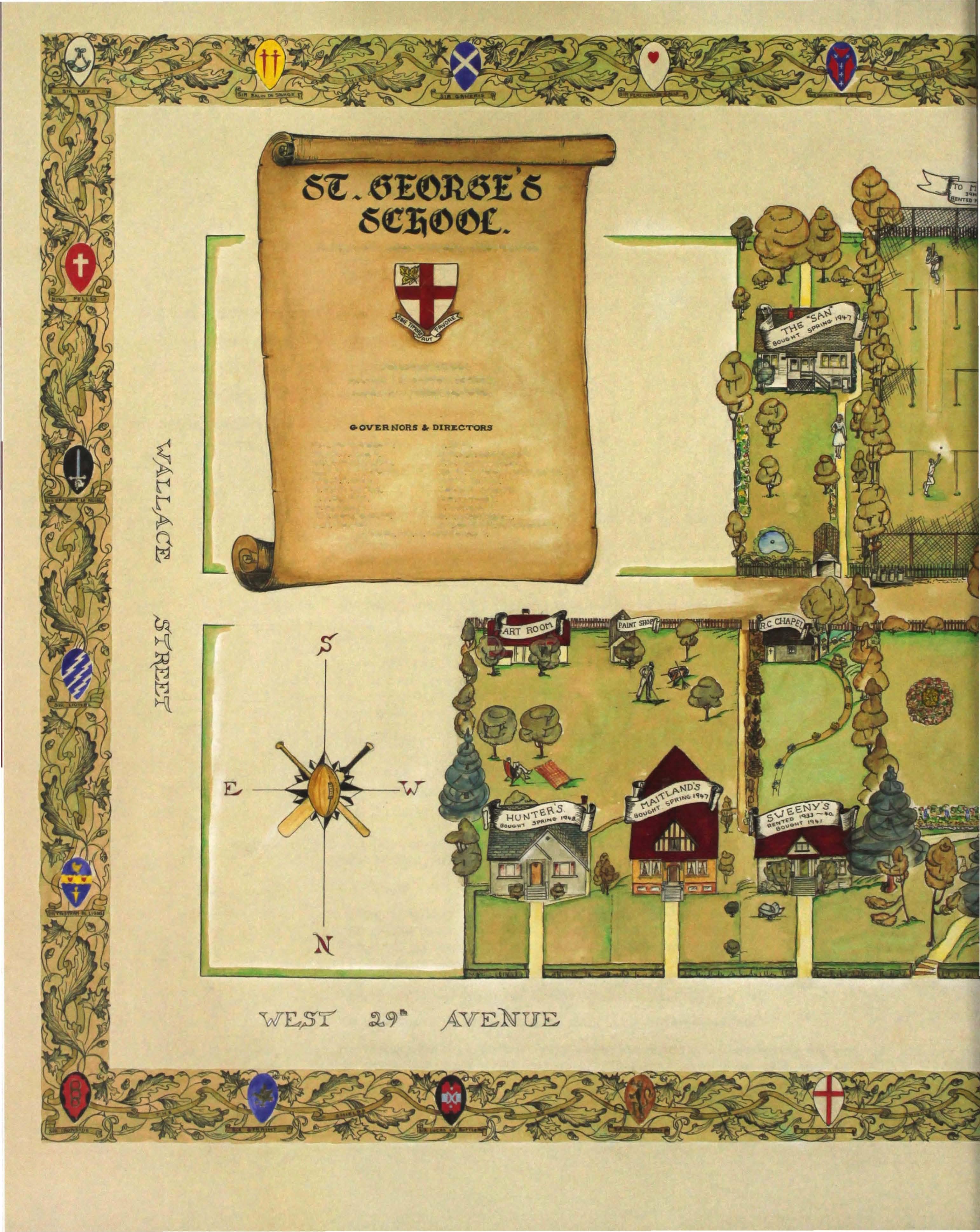
,....... 17 'MNW� OCTM....... HEADt1ASTERS Iq31 3� F DANBY HUNTER. IQ3l1.-l,.q-;TOHN HARKER C'I..J CHESTmTON <nN •A CLARK DRC.PCOVERNTON BISHOP DE PENClElI. COL iTPf'ELL G KIDD HONRLMAITLAND 'J"'-I MAODOll&ALL. CHIEF O"IJSTICE MORRISON DAVID SLOAN ;rl'YFE SMtTH AUSTIN TAYLOR. DE HARKER RHT1JPPER ;:rHARKER C VALLAC£ "'GPHUTCH£SON HV'-JHITTALL A e: iTVKES MR;J"USTtCIt ;TO\.IILSO>l HON 'WC VOOD'\.JARD

COLLECTORS' EDITION SUBSCRIBERS

Without Fear or Favour
John G. Lawrence
Helen Shim and Marc Boyle
Derek A.C. Simpkins
Patrick C. Simpkins
Brian A. Soregaroli
The R.G. Cruickshank Family
David F. Mullen
Cindy Teskey
Duncan Bayard Stothers
Bennett Thomas Stothers
Sean Patterson Stothers
William Harrison Stothers
Robert Junda Chen
Brenda and David McLean
Jason McLean
Sacha McLean
Andrew C.K. Wong
Mrs. Carolyn Maude
Bradley John Stephen Wilson
Peter Robert Beverley Armstrong
The C.S. McKeen Family
Andrew William Moffitt Lier
Daniel Wenhao Lin
Winston Hua Cheng Li
Peter Wong
Gordon R. Gilley
Connor Chiu
The Ingvaldson Family
Clive S.K. Austin
Michael (Punch) Kent
Andrew Grant
William H. Clarke
Jaymie, Steven, and Ben Ho
Angus M. Gunn, Jr.
George Jang Yen
R.H. MacKay-Dunn
Peter Bentley, OC, LLD
Johnson Chan
D. Md. (Don) Anderson
Gordon Chambers
Antony St. Vincent Parker-Jervis
Peter B. Irvine
Michael Cragg
St. George's School, Library
St. George's School, Headmaster's Office
Jason McLean
Hiroshi Dejaeghere
Kennic Tong
Temple M. Wright
Richard A. Kerr
Markus Franiek ('82) and Zachary Franiek ('12)
Timothy J. Douglas
Mark F.Y. Chan ('93)
John James McGraw
Frederick Lackmance
Dean Macdonald
Michael Tigges
w.F. Christensen
2
3
4
5
6
7
8
9
10
11
12
13
14
15
16
17
18
19
20
21
22
23
24
25
26
27
28
29
30
31
32
33
34
35
36
37
38
39
40
41
42
43
44
45
46
47
48
49
50
51
52
53
54
55
56
57
58
Christopher Peter Lawrence ('84)
Mark J. Harcourt ('82)
N.R.L Toy, Headmaster 1997-

Doreen Lam Lau and Philip Lau
Alan C. Brown
John G. Lenic
Saifudin Hussein Alnuweiri
Dickon R.H.C. Thompson
Palmer James McCutcheon
Huntly G. Chapman, MD, FRCSC
Phillip Do and David Do
Patricia and Wing Ting Leung
Shane David Evans Mullen
N.D. Parker
Robert Ross Hamilton
The Sibthorpe Family
Derek D. Fraser
Bennet Tadashi Adamson
James Gibbons ('14)
Peter Gibbons ('17)
Charles R. Armstrong
Larry Marieiro
St. George's School, Archive
Andrew John Bibby
Christopher Martin Harriman
Hussein B. Jetha ('91)
59
60
61
62
63
64
65
66
67
68
69
70
71
72
73
74
75
76
77
78
79
80
81
82
83
84
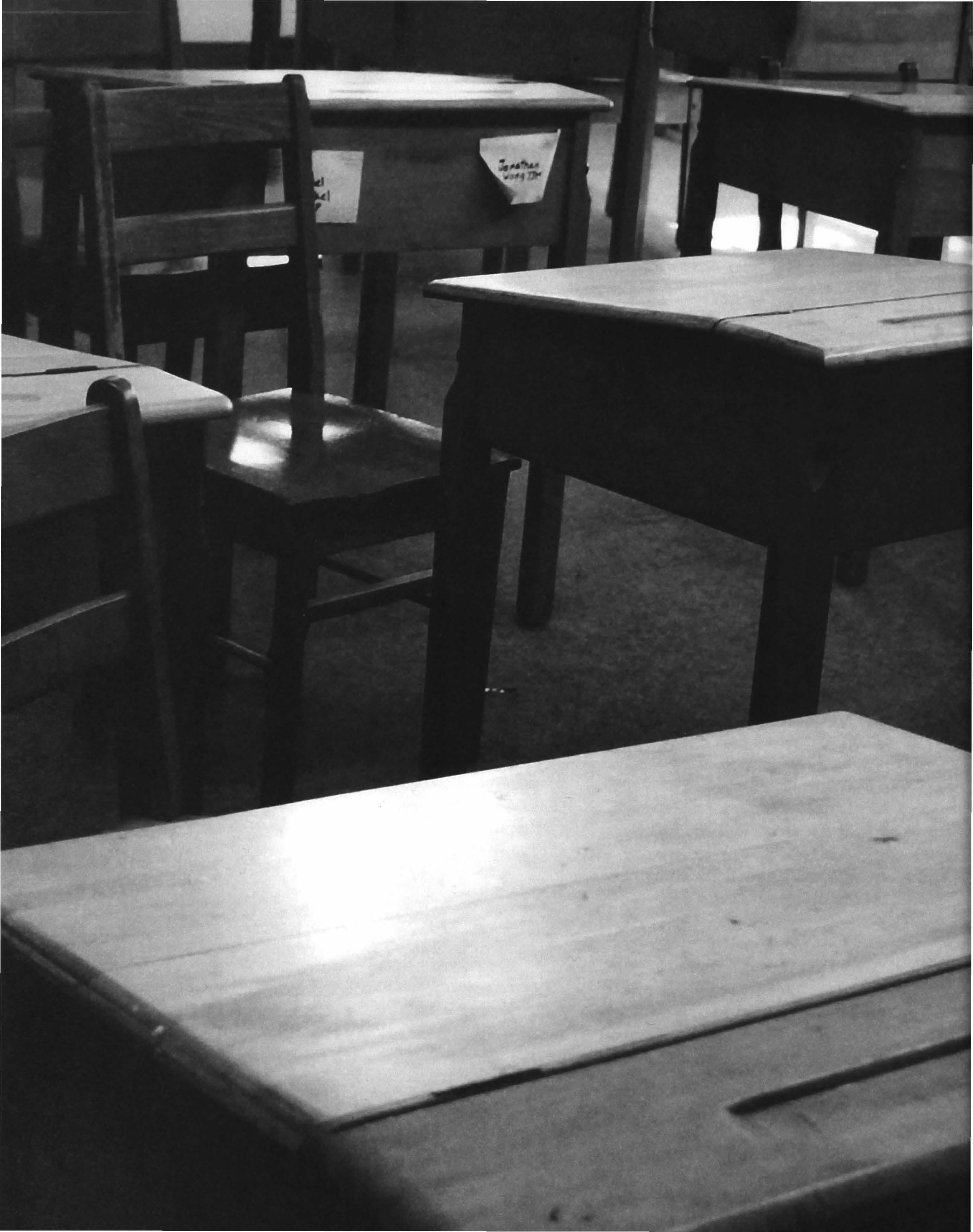
Contents
Preface
Acknowledgements

The 1930s: Early Struggles and Successes
The 1940s: War, Survival, and Recovery
The 1950S: Expansion, Enter the Ladies, Rugger Tours, and Dogs
The 1960s: A New School for a New Headmaster
1970s: A Dynasty Ends and the World Changes
1980s: Going Gothic with a New Junior School and Library
1990S: Decade of
21st Century: An Olympian
of the
of the
xii
xvi
3
29
53
75
99 The
127 The
159 The
Transformation 193 The
Age 216 Appendix 1: Headmasters, Heads
Junior School, Chairmen, Georgian Presidents, Presidents
Auxiliary, and School Captains 220 Appendix 2: Roll of Honour 222 Appendix 3: "Viva-La" for Robin Baker 223 About the Author xi
Preface

WHEN I WAS INVITED TO WRITE A HISTORY of St. George's for the school's 75th anniversary neither I nor the Anniversary Steering Committee knew what might come of the project. Initially I wondered if another history was needed, knowing that Douglas Harker's Saints has been available since 1979 and that it covers the early years with the authority provided by someone who was a principal actor. However, I soon realized that almost half the Saints story was still to be told. I also realized that the school's "second act" was rich in achievement. Since Douglas's retirement in 1971 the student population has doubled, the convent property has been acquired, and the Senior School, which Douglas nursed into being in the mid-1960s, has changed beyond all recognition in four massive and costly makeovers.
It was while digging through the many old Georgians and the mass of papers that constitutes the St. George's archive that I became excited about telling the school's rags-to-riches story through some of the yearbook's eloquent voices and the archive's wonderful photographs. After much thought I decided to tell the story chronologically, decade by decade, using a time line to place the activities of the school community in a wider context. This approach allowed me to concentrate on the significant events and the procession of visionary, energetic, and colourful characters who took the school forward and whose influence lingers on in the memories of the boys and their families.
This procession began with John and Douglas Harker, whose era extended from the 1930S to the 1970S. The Harkers created meaningful traditions, including the House Supper, the School Concert, the School Song, clubs, and sports. When their nearly 40-year dynasty ended the responsibility of leading the school fell to a new generation of men they had molded. Alan Brown was an Old Boy from the days of John Harker, and Gordon Atkinson and John Blackmore learned their trade under the watchful eye of Douglas.
In the 1980s the school community changed in ways the Harkers could never have imagined. Canada became a multicultural society, fully reflecting the Trudeau ideal of the cultural mosaic. In response, school sporting activities
xii
became more diverse and rugby ceased to be a mandated activity In the classroom we encouraged collaboration as well as competition.
In the 1990S and the 21st century the pace of change accelerated under Nigel Toy, a headmaster who had not trained under either Harker brother. Our graduates were no longer content to' stay at home for their university education and increasing numbers of students satisfied the rigorous entrance requirements of the US Ivy League establishments.

Within this historical framework I identified certain themes: the evolution of school traditions, the growth of various sporting empires, the cultivation of the performing and visual arts, the development of special programs and clubs, and the almost constant expansion of facilities. As the decades rolled on and the number of activities increased dramatically I had to become ever more selective. In the end, I chose to highlight those activities that enjoyed success at provincial or national competition, and to leave unmentioned many other worthy activities that did not earn this kind of distinction.
To some, rugby may seem to have received a disproportionately large share of attention, but it was the one sport on which the early fathers of the school chose to build a reputation, and for several generations of Georgians it was their only sport.
To others, the arts may seem to have garnered more than their fair share of attention, but I felt that in the post-Harker era the arts truly blossomed and now play a role in forming that cherished ideal-the all-round St. George's boy. When I started my career at Saints in 1973 it was rare to see a student carrying a musical instrument case in the halls. Student musicians were known to arrive early to avoid bustling hallways and the critical and ironic attention of their fellows. By the 1980s this had changed. On a trip to Bamfield ] remember a student pulling out his drawing pad and sketching his peers. It did not elicit anything but a warm and friendly reaction. In confidence afterwards the Bamfield leader confessed that she had never seen the like before in any of the many visiting school groups. She wondered what magic at St. George's had created this congenial support for the artistic imagination.
Few, I imagine, will quarrel with the attention I have paid to one inescapable fact of life at St. George's: the numerous construction projects needed to provide new facilities. We have been particularly adept at building and then, years later, knocking down our own creations in favour of something better. And even though I have made only passing references to the great work of the board
xiii
and its many committees, which have done so much to raise funds and support the school through these many metamorphoses, this in no way reflects the value placed on their contribution. As is commonly the case, the careful deliberations and fine detail of many construction projects and fundraising strategies were

edged out by the bigger and bolder personalities of the many teachers and headmasters who have passed through the halls.

E EVIL -BAy. 3397L

The school has been truly blessed in the quality of leadership provided by its teachers and headmasters. Its teaching staff has evolved from a small cadre of First World War veterans with little or no teacher training or experience to a body of professionals, each with one or more degrees and a teaching certificate. The school has become a multi-million-dollar business with specialized branches of the administration. There are offices responsible for admissions, advancement, finance and accounting, and student services; there are departments that in the time of the Harkers would have been one individual's responsibility-often undertaken in addition to a regular teaching load. At one time John Harker was the school dietician, headmaster, organist, Latin teacher, and bursar. While this sort of burden is no more, teachers still take on club and sports programs as a condition of employment. The overwhelming success that teams have enjoyed over the past five years is a testament to the continuing commitment of teachers to their extracurricular responsibilities.
In preparing this history I have happily engaged in a hundred conversations with Old Boys from around the world. Some of them are octogenarians, hard of hearing but still full of vim and vigour. All speak highly of the school and remember it with affection. In education I think we tend to be too much influenced by success in examinations, which can assess only the academic excellence referred to in college prospectuses. While the Old Boys I have spoken with acknowledge the superior grounding they
CHAUFFEU Driven Gove rnment Inspected Busses supply Transportation to St. George's School
xiv
received for their university studies, what they remember with an abiding affection are their teachers and the good times spent in various activities involving teamwork, serious effort, and the satisfaction of doing one's best in a field of one's own choosing. Perhaps as a community we have come a long way towards realizing the "success" described in a verse often attributed to Ralph Waldo Emerson:
To laugh iften and much,' to win the respect of intelligent people and the affection ofchildren,' to earn the appreciation ofhonest critics and endure the betrayal offalse friends,' to appreciate beauty; to find the best in others,' to leave the world a bit better, whether by a healthy child, a garden patch or a redeemed social condition,' to know even one life has breathed easier because you have lived. This is to have succeeded.
I hope you will enjoy this history of St. George's School. And I hope it will remind you, whether you are an Old Boy, a parent, or a friend of the school, that you are part of a vibrant community that helps young men learn to act with integrity-Sine timore autfavore without fear or favour.

].L. xv
Acknowledgements

I OWE A GREAT DEBT OF GRATITUDE to the long succession of Georgian editors and photographers whose words and images I have used for this book. I am also much indebted to all those headmasters, teachers, students, and members of the St. George's community whose words and voices I have used to tell this story. I am particularly grateful for the writings of Wally Pringle, the "Gunner," a shellshocked First World War veteran and survivor of the trenches, whose exquisite sense of irony captures for me those first two decades in the life of the school. After Johnny Harker, Wally is the man I would most like to meet from that formative period.
I owe a special thank you to my many friends and colleagues at the school who have responded to the call for yet another report with their customary thoroughness. In the headmaster's office, Nancy Kudryk has been a fount of knowledge, providing me with dates and chronologies, and coordinating the task of report-getting with unruffled good humour. In the advancement office, Elizabeth Knox has been an invaluable and enthusiastic assistant, digging through the collection of papers that constitute, at present, the St. George's archive. I wish her well in her new position as archivist, which begins in September 2005, sadly a year too late·for the purposes of this book.
I thank the St. George's School Auxiliary for providing financial support, and the members of the 75th Anniversary Steering Committee for providing guidance, particularly Helen Shim Boyle, who has offered unflagging encouragement and kept me on task with gentle reminders.
I would also like to thank Susan Mavor and Isabelle Swiderski, our designers, who have turned my dull prose into a wonderbook that truly brings history to life; and Barbara Tomlin, our editor, who has taken the rocks out of my prose and helped me satisfy Jonathan Swift's requirement for good writing: "proper words in proper places."
Last but not least, I would like to recognize my wife Katherine, who, with immense patience and good humour, has endured my long vigils at the computer and the clutter of papers, books, and photographs scattered throughout the house.
xvi
75TH ANNIVERSARY STEERING COMMITTEE
Mr. Derek Simpkins ('64), Chair
Mrs. Wendy Armstrong
Mrs. Susie Clinton
Mr. Derek Fraser
Dr. Stephan Grasmuck
Mr. Mark James
Mr. Brian Lecky ( ' 65)
Mrs. Timmy MacKay-Dunn
Mr. William McCracken
Mrs. Deborah McKeen
Mr. Neil Menzies ('82)
Mrs. Helen Shim Boyle
Mr. Brian Soregaroli ('84) Mr. Nigel Toy
75TH ANNIVERSARY BOOK COMMITTEE
Mrs. Helen Shim Boyle, Chair
Mr. John Lawrence
Mr. Derek Fraser
Mr. Derek Simpkins ('64)
A note on sources


This history of Sl. George's School has been compiled using information from interviews with school community members and excerpts from the following: EditIOns of the Georgian. a school yearbook, published from 1937 to 2005

· Issues of the Dragon, a biannual school magazine, published from 1975 to 2005
Saints by Douglas Harker, published by Mitchell Press in 1979
This Family Robinson by H Basil Rob,nson, published by the author in 1996
The records of the Sl. George's School Auxiliary Scrapbooks containing miscellaneous Items, Including clippings from the Vancouver Sun and the Province newspapers
ThiS history IS Illustrated with Images from the sources listed above and additional photographs taken at the request of the author by Gordon Allan, ASSOCiate Director of Admissions, Sl. George's School, and Al Harvey. the Slide Farm. The photograph on page x is by Susan Mavor. The collectors' edition sl,pcover photograph of two young boys IS by Daryl Kahn Cline.
xvii

1929-1939
The 1930S: Early Struggles and Successes
1929 October 29, Wall Street Crash
1930 Captain F.J. Danby-Hunter and colleagues purchase property in Vancouver and plan to open a new school
Cappie Robinson hired to teach "general subjects"
The first Old Boys versus the School rugby game
Axel Mortensen hired as school janitor
March 12, the Anschluss-Germany under Adolf Hitler annexes Austria
John Harker appointed school bursar
Douglas Harker begins his Saints career in January
John Harker becomes the second headmaster of St. George's
1931 January 8, St. George's School opens its doors under the headship of Captain Danby-Hunter 1932 1933 1934
Rugby becomes the official school sport for winter
October 3, Neville Chamberlain's ill-fated "Peace in our time" speech to the House of Commons
Peter McDonnell hired to teach French and Latin and look after the school's Roman Catholic community
Cadet corps formed during the summer

September 10, Canada joins the United Kingdom in declaring war on Germany
The front door of the old schoolhouse, 3954 West 29th Avenue,
September 10, Douglas Harker enlists and is soon followed by his colleague, Arthur Lungley
I
1936 1937 1938 1939


Early Struggles and Successes


THE HISTORY OF ST GEORGE'S BEGAN somewhat inauspiciously in Victoria's Union Club, some time in 1930. The Wall Street Crash had just occurred and Canada, like the rest of the western world, was moving into the Great Depression with its bankruptcies, soup kitchens, and ranks of the unemployed. Three men, all recently arrived in Victoria, were each seeking the freedoms and opportunities of the Dominion in their different ways. The new arrivals were Captain F]. Danby-Hunter from Burma (now known as Myanmar), Mr. Bingo Lyttle from Shanghai, and Mr. D.e. Saunders from Britain. Lyttle and Saunders had been hired to teach at Victoria's University School by the Reverend W.w. Bolton, headmaster at the time. Danby-Hunter, with previous experience as head of a girls' school in the East, had also applied for a teaching post with University School but had been unsuccessful-perhaps because his advanced educational views, expressed with considerable elan and enthusiasm, did not strike quite the right chord during his interview with Mr. Dick Westmacott, Bolton's assistant and later a teacher at Saints.
Saunders, engaged to teach science, soon proved ineffectual in the classroom and was inevitably involved in discipline problems with his students. However, his life changed dramatically for the better after he received an inheritance from England that allowed him to retire from University School and become a gentleman of leisure.
Bingo Lyttle, hired as a housemaster and given responsibility for the school's games program, initially enjoyed some success in his new employment, but subsequently suffered a downfall because of his unorthodox approach to diScipline. Lyttle was a skilled boxer and treated any problems by taking on the offending student in the ring. He met his Waterloo, however, when an older boy proved more capable in the ring; Lyttle suffered a humiliating defeat that led to a serious loss of credibility with his students. In addition, the jolly bachelor
1
I The old schoolhouse.
ABOVE, LEFT TO RIGHT


Captain Danby-Hunter, Dolly Lyttle, and Bingo Lyttle.
FACING PAGE

Looking west along West 29th Avenue, with the newly built Convent of the Sacred Heart on the right and the Mather farmhouse-the future home of St. George'son the left. circa 1911. From the Vancouver City Archives.
social life he had been enjoying in Victoria was upset by the unexpected arrival of his wife, Mrs. Dolly Lyttle, whose beauty and vivacity soon quite eclipsed her husband's rising star and made her the centre of considerable attention, especially from Danby-Hunter and Saunders. Indeed, Dolly Lyttle was almost certainly instrumental in bringing together Danby-Hunter, her husband, and his teaching associate Saunders.
It is easy to imagine the two younger men closeted with the worldly, charismatic Danby-Hunter, survivor of the slaughter of the First World War, a man distinguished by the rank of captain and experienced in the ways of the exotic East. The Captain would convince his young friends of the viability of a private school in the rapidly growing city of Vancouver, just across the Strait of Georgia. It would only require the right kind of curriculum and the wise leadership that he would provide. While Saunders had no need of a job, Danby-Hunter had need of Saunders's newly acquired wealth, which he managed to acquire when Lyttle joined in. Lyttle reSigned his post at University School, but not before obtaining a loan of $10,000 from Saunders towards the setting up of the new institution. The terms and conditions of the loan are shrouded in mystery, but the money ended up in the hands of Captain Danby-Hunter, who with remarkable prescience and a fine disregard for
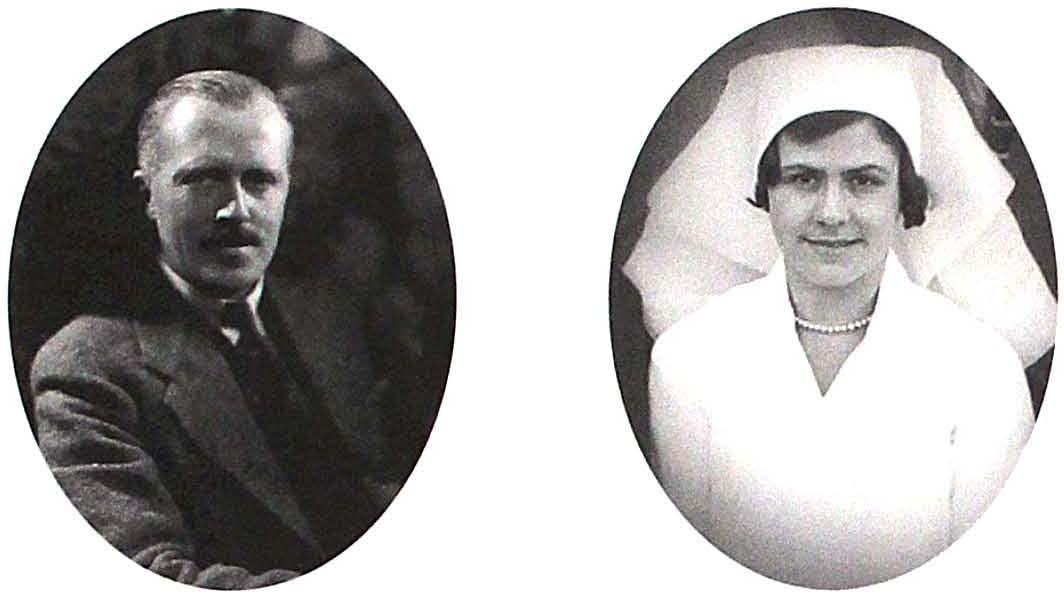

 ABOVE
ABOVE
Main entrance to the farmhouse that would become SI. George's School and remain more or less unchanged from October 1930 to its demolition 50 years later,
FACING PAGE


Students and staff, April 1,1931.
First row (left to rightl: Michael Fell ['41), Fred Flemillg ['411. Charles Woodward ['42), Edward Barker ['36), Allan Ainsworth ['41; first SI. George's Rhodes Scholar)' John Young ['40).
Second row (left to rightJGeorge Claydon ['36), Mr, Parker, Mr. and Mrs, Lyttle, Captain Danby-Hunter, Mrs, Jacobs, Mr, Walker, John Whalley ['34; first school captain]
Third row (left to rightl Alfred Young ['37), Cyril Grant ['371. Thomas Mylorie ['361. Henry Raikes ['381. Victor Pilcher ['37), Arthur Manlove ['40), Tony Parker-Jervis ['341. Robert Young ['37).
Fourth row (left to rightl: Gordon Skelhorne ['40), Robin Hurrell ['40), Richard Storer ['391. Russell Williams ['38), Ronald Raine ['38), Michael Jacobs ['38), Andrew Jukes ['38), Noel Parker-Jervis ['35).
Saunders, soon found an acceptable building for the new school in the Dunbar district of Vancouver, Lyttle's borrowed money was quickly consumed in the purchase of a building known as the Mather farmhouse and the four acres of land surrounding it.
In 1930 the scene at 3954 West 29th Avenue was much as it had been almost 20 years earlier, Adjoining the property were 10 miles of thickly wooded land, albeit more like a rejuvenating clear-cut than a mature forest, Adjacent to the house was a convent, built by the Society of the Sacred Heart in 1911-12. The newly printed prospectus for the school claimed <Ca southern aspect and uninterrupted views of the Coast Mountains and across the Gulf of Georgia, with most excellent sandy bathing beaches at an easy walking distance,"
No such views were to be seen on the night of October 30 when the Captain, Lyttle, and accomplices made an unofficial entry into the property. In, the words of Douglas Harker, the escapade was worthy of a Boys' Own adventure story:
It was an exceptionally dark night. None had considered that the house recently vacated by theMatherfomily might be locked, and no one had thought ofobtaining a key. So a burglarious entry was made by way oftwo soap boxes and the veranda. A window was dexterously pried open by Parker, who was accused by his colleagues ofbeing suspiciously experienced in making entries. TheHeadmaster climbed in first and soon made his arrival known to all when he barked his shin on a wooden box placed in the corridor and expressed his displeasureforcefully.
Despite this doubtful beginning to the school's long and successful history, in just a little over two months, on January 8, 1931, the Mather farmhouse opened its doors as one of Vancouver's early private schools and welcomed two dozen students and a half dozen staff.
Of the half dozen staff members that appear in a 1931 photograph, only the youthful Nip Parker was to establish a long and distinguished career at Saints. Dolly Lyttle had been taken onboard along with her husband to become the school's first matron. However, the alliance between the Lyttles and Danby-Hunter did not survive the love triangle that soon developed. Charles Frizell, a teacher at Saints in the 1950S, describes the aftermath of a grand falling out:
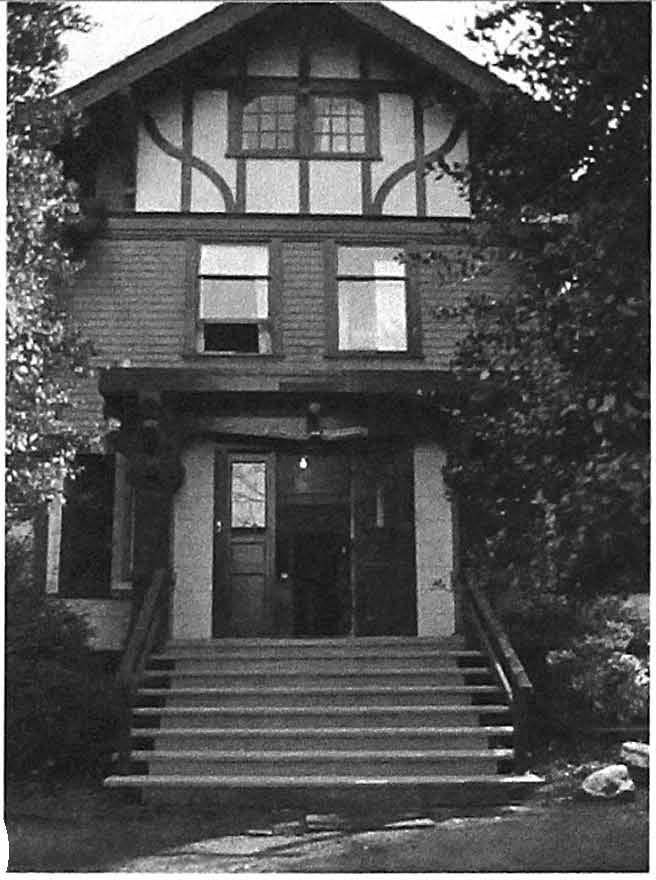
One morning the reasonsfor this breakdown in detente became obvious to all in the communal residence. Danby-Hunter appeared at breakfast with an ugly black eye and a swollen lip, both ofwhich he attributed to an encounter with a banister post following afall down stairs the previous night. Suffice it to say this explanation was not accepted by even the most gullible, because at the same time it was learned that Lyttle's wife had left hurriedly in the night, and [yttle himselfhad announced his resignation, effective within that week.

Nothing is known of the subsequent history of the Lyttles, though there were rumours of a divorce and a parting of the ways, with Bingo returning to hanghai to try his luck there.


 I
Tony ··pr Parker-Jervls and Noel ··Bachee·· Parker-Jervls are Circled In red.
ABOVE John Harker.
I
Tony ··pr Parker-Jervls and Noel ··Bachee·· Parker-Jervls are Circled In red.
ABOVE John Harker.
FACING PAGE


The cost of a one-hour appointment with your lawyer today would have paid for a year"s education at Saints in the 19305.
ENTER JOHN HARK ER
The Parker-Jervis brothers, Noel and Tony, had been enrolled at the school by their stepfather, John Harker. Harker had first met the boys' mother in Malaya (now Malaysia) while working in China and Southeast Asia for the BritishAmerican Tobacco Company. Marianita Parker-Jervis, known to all as "Naggers," returned to England after the death of her first husband and subsequently married John there in 1927- In 1928 the family immigrated to Canada to pursue an offer of work by a wealthy young Englishman, David Tennant, who intended to buy a business in British Columbia.
David Tennant, soon finding himself a fish out of water in British Columbia, decided to cut his losses and sell his business in the manufacture of steel containers. He returned to Britain, leaving John Harker as business manager of the reorganized company. However, as the Depression tightened its grip on the commercial life of the province, the company was soon in financial difficulties.
In the fall of 1931, one of the fledgling school's directors approached Harker with the offer of a job as school bursar. The directors had determined that the charismatic Captain Danby-Hunter was an inept manager of the school's financial resources; the books were in a state of chaos and a mountain of unpaid bills threatened the viability of the institution. Harker accepted the job, knowing that a bursar's pay would keep the wolf from the door, but it would not be enough to keep his two stepsons enrolled in a private school. Reporting for his first day's work, Harker informed his new boss that financial necessity required him to remove his stepsons from the school immediately. The Captain, with characteristic charm and urbanity, managed to convince Harker to keep the boys at the school by striking a deal that saw the new bursar, with no previous teaching experience, take on the duty of teaching Latin, a subject he had last studied 20 years earlier while at Rugby.
In the spring term of 1933, the cares of office were beginning to sap the Captain's energies and enthusiasms, and he felt control of the school passing out of his hands to parents, directors, and his bursar. With dignity and a notable absence of recriminations, he announced that at the conclusion of the spring term he would resign his headship and return to England. The school governors wrote to the parents to inform them of the situation and their intention to offer John Harker the position of headmaster:

vve have to announce to parents and guardians of the boys ofSt. George's School that CaptainDanby-Hunter has resigned his position as Headmaster, to return to England on private affoirs at the end ofthe present term Mr.John Harker, the present Bursar and Director, will become Headmaster, and with his brother, Mr. Douglas Harker, has purchased Captain Danby-Hunter's interest.vve believe Mr. Harker to have the capacity and qualifications necessary to thesuccessfuladministration ofthe School; whilst his brother is a Tancred scholar and has been teaching in one ofEngland's leading preparatory schoolsfor the lastfour years.
The signatories included prominent Vancouver citizens, all of whom eventually became school governors, giving the new administration the confidence to survive and succeed. Danby-Hunter returned to England by sea and, as rumour has it, met a wealthy heiress whom he subsequently married and lived with as a successful English country gentleman.
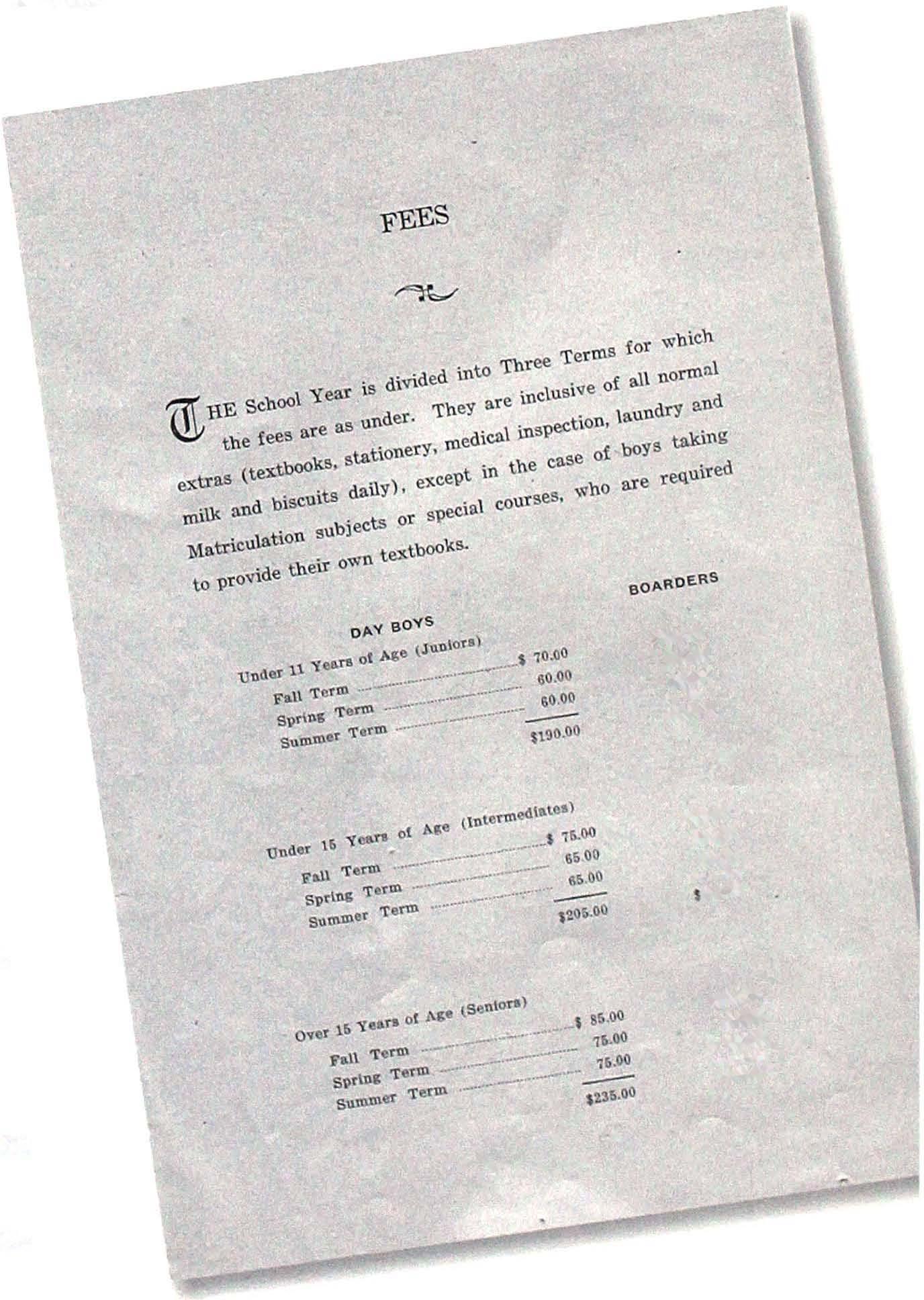
JOHN HARKER TAKES OVER


Under John Harker's leadership, a small group of men successfully took the school through to the end of its first decade. One of these men was Harker's brother, Douglas, who left England for Canada during the exceptionally cold winter of 1932-33. Douglas had a background in preparatory school education in England, and on staff was affectionately known as the "Daltonian" for his espousal of an educational philosophy called the "Dalton Plan." He and Nip Parker were so youthful in appearance that visitors often mistook them for senior boys. Another member of the group was Bob Dekking, a First World War veteran and engineer, who like many another during the Depression, had turned to teaching for want of other work. Known on staff as the "Sapper," his expertise in construction and maintenance was invaluable to the embryo school. Wally Pringle, another war veteran, known as the "Gunner," became the school's chronicler, playwright, and bard. His editorial writing in the Georgian, the chool yearbook, uniquely captured the humour and ambience of a staff room where all were making do under difficult circumstances. Major Ben Sweeny, another survivor of the First World

�t90.00 1$0.UO lS0.00$650.00 $Z10,00 19�·OO 196.00600.00 ,ZZo.OO Zl�.OO u6.00$650.00
RIGHT John Harker and his staff at the end of the summer term, June 1933.

First row (left to right/: Irene Laird, John Harker, Naggers Harker, Douglas Harker, Muriel Royston.

Second row (left to right!: Major Ben Sweeny, Bob Dekking, Wally Pringle, Frank Sparks, Nip Parker.
FACING PAGE Dining hall in the old schoolhouse, circa 1935.
War, had no previous teaching experience but brought with him a wealth of practical know-how and wisdom, and a "deep and abiding love for his fellow man." Frank Sparks was probablythe most experienced teacher of the group, having previously been principal of his own school, St. Aidan's, whichhad not survived the Depression.
THE OLD FARMHOUSE BECOMES A SCHOOL
The old schoolhouse initially provided classroom, boarding, and dining space for all students. Boarders lived in a dormitory attic with space for about 20 students on bunk beds, and a further 20 lived in two rooms below, bringing the boarding complement up to about 40. The accommodation was Spartan and space was limited. A student's worldly possessions were all required to fit into one small tin box-a far cry from the many luxuries afforded by the current residence, which include radios, computers, and full sound systems.
Bachee Parker-Jervis and his brother, the inimitable pJ, remember dormitory life in the early 1930S. Students were required to say their prayers on their knees at their bedsides before lights out. Pillow fights were a constant source of wild pleasure for the boys and an annoyance for the staff living below, and were invariably followed by swift retribution in the form of a swat across the backside with the cane. Bachee remembers that Bob Dekking hated caning boys under any circumstances but was required to recognize the school boy code that gave students the right to trade punishments: lines or an essay could be traded for a beating, and the boys knew that a mild beating from Bob was infinitely better than the wearisome slog of writing lines.
A student's worldly possessions were all required to fit into one small tin box-a far cry from the many luxuries afforded by the current
residence, which include radios, computers, and full sound systems. provided sanctuary for junior boys and boarders until 1980. Then as now, the staff knew that food is an essential element in the life of a healthy, happy young man. In the early days, John Harker (known to the boys as the "Beak") acted as dietician and determined what appeared on the table at meal times. An early riser, he was at his desk long before breakfast. Once the meal was served he would be the first to arrive, ready to deliver the grace, in Latin, over heads respectfully bowed.
The dining room in the old schoolhouse, with its rough benches, chairs for seniors and staff, and plastic tablecloths, was a warm and friendly place that


11



I 13
Dormitory in the old schoolhouse. November 1960.
ABOVE
A classroom in the new wing. September 1931.

FACING PAGE, FROM TOP DOWN

The school in the summer of 1931. after the addition of the west wing.
View to the south from the veranda of the new wing, summer 1931.
Hallway outside the second-floor classrooms on the north side of the new wing, September 1931.
Home to Axel Mortensen. Isaias Garcia. and Geoffrey Stancombe.
BUILDING FOR AN EXPANDING POPULATION
Captain Danby-Hunter had a reputation for entertaining parents, particularly mothers, at frequent and bibulous sherry parties. By this means he succeeded in winning support and, more importantly, hard cash for the school's very first building venture-the start of an almost continuous expansion. During the summer of 1931 a new wing was built to provide four new classrooms over a large and cavernous space that did duty as both a gymnasium and chapel. The whole blended harmoniously with the gracious old farmhouse, unlike the concrete classroom block that was built more than two decades later.
On the south side of the new wing the classrooms gave out onto a veranda with views across the playing fields and undeveloped lands to the south. The new classrooms were bright and spacious and provided more than adequate
14
breathing space for the 61 students registered in September for the academic year 1931-32.

The new gymnasium, with discrete modifications, also served as a chapel, a parade ground in wet weather, and a concert hall. Throughout the 1930S it became the focal point for many of the school's emerging traditions, particularly religious observances, which the prospectus made clear were to play an important role in the life of the new school: "Believing that the development of moral character depends upon the inspiration of religion, instruction will be in the Bible, prayers said daily, and on Sundays boarders will be expected to attend church in accordance with the wishes of their parents."
After the addition of the new wing, the school met daily in the chapel for both morning and evening religious services. In the early days, Danby-Hunter conducted the services and played the piano. He was succeeded for many years afterwards at the piano (which was eventually replaced by an organ) by Douglas Harker.
Other buildings were added before the end of the decade, often designed and engineered by Bob Dekking, and built with the help of staff, boys, and parents. In some cases buildings were added without a permit from the city, the staff knowing that a request was likely to be refused. Eventually the board, fearing the wrath of the city inspectors, stepped in with a stern warning that such cavalier practices must cease.
One small building served as a residence for Axel Mortensen, the school janitor hired in 1937, who lived there for much of his working life. Twenty years later a room was also found there for Isaias Garcia, who jOined Mortensen as assistant janitor. In the late 1960s Geoffrey Stancombe ('62) also found residence in this congenial place while paying his way through university and working part-time at the school.
These additions were not accomplished without considerable opposition from the neighbours. One, a Mr. Pierce, was always fomenting re entments-in much the same way certain neighbours of our own day have opposed developments on both campuses.

15
A VIBRANT SPORTS TRADITION BEGINS

Before the close of the decade the school established many of its enduring traditions in the sports arena. In a September 1934 meeting it was decided to make rugby (or rugger as it was known in those days) the winter school sport for all boys older than 12. John Harker, after passing the resolution, and in the spirit of an Old Rugbeian, declaimed in solemn tones the memorial to William Webb Ellis (see top of page 17).
Given the overwhelming British influence on the staff, there was no shortage of coaching talent available to put together a well-drilled side within the year. By 1937 there were enough rugby-playing graduates to stage a School versus Old Boys game. The same resources could not be mustered for North American games such as basketball, which the staff had little or no experience playing. Indeed, Douglas Harker had to

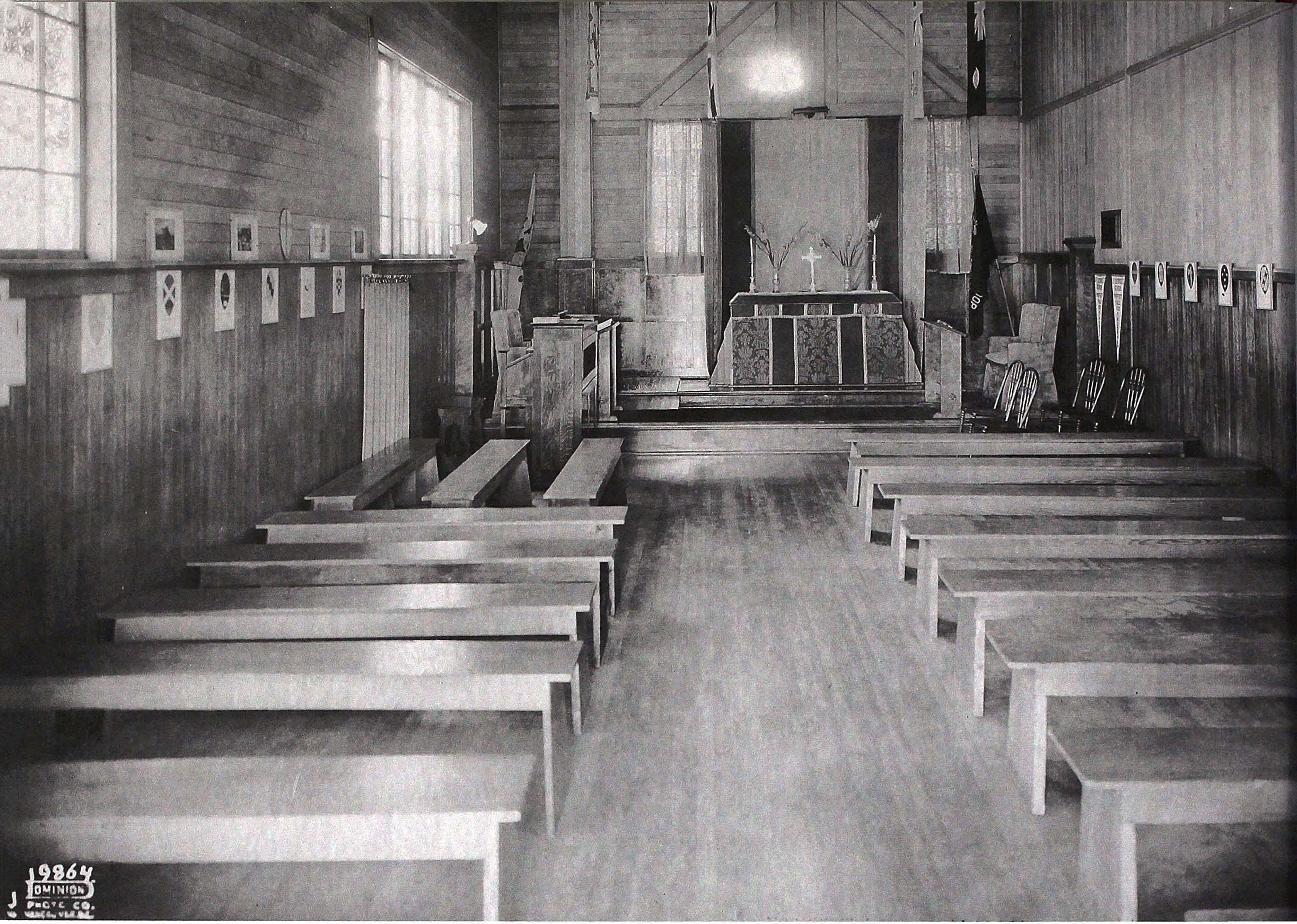
I BELOW ABOVE The chapel. circa 1931. The gym. circa 1931. 16
enroll in a course for basketball coaches in order to learn more about the game. To his deep chagrin he discovered that the program aimed at a level of expertise that was well beyond him.
As the boys assembled for the School versus Old Boys rugby game in 1937, the ominous signs of National Socialism were already appearing in Europe, although many chose not to recognize them. Five members of that year's team were to serve with the military, never to return: the Else brothers (Harry and Jim), Donald Hood, John Clothier, and Bill Maitland.
Other sports traditions also developed in the school's first decade. During the summer of 1934, the first Sports Day was organized by Frank Sparks. Along with the more traditional events, there were competitions for the "tiddlers and the toddlers," and activities for parents who showed up in great numbers to enjoy the day. In the words of Wally Pringle, "The toddlers toddled in a very spirited way, and the tiddlers showed promise of doughty achievements in future years. The fathers pirouetted, gyrated, and swayed most impressively on the greasy pole to the fervent acclaim of the multitude."
In addition to the sporting events, there were also displays by the Cubs and Scouts at Sports Day. For Sports Day in 1938 the Scouts built a five-section pole bridge, each patrol making a section and then lashing the sections together. Scouting was one of the very first activities to become enshrined in the Saints program of extracurriculars, with dynamic leadership over many years coming from Nip Parker and Cappie Robinson.
Rowing was also introduced in the very early days by Ben Sweeny, who had been active in the organization of the Vancouver Rowing Club. The crew trained at Coal Harbour, but a the school could not afford a bus or van, the students were transported down to the dock in an old and battered 1923 Dodge, owned by Sweeny and known affectionately as The Green Misery. At the time, the Sun's sportswriter suggested that "City High Schools" should follow St. George's lead and introduce "the rowing game at High School age."
ABOVE, LEFT

Inscription from a plaque at Rugby School, England.
ABOVE, RIGHT
The School rugby team assembled to play the Old Boys rugby team in 1937

First row lIeft to fight/: J. Else, D. Bell, E. Pidgeon. D. Walls, P. Street. J. Clothier. W. Maitland.
Second row (left to right!: Mr. A. Lungley, J. Brandon, H Else. D. Hood, M Sharp. E. Gudewlll, A. Hicks G. Nation. K. Shann.
THIS STONE COMMEMORATES THE EXPLOIT OF WILLlAM WEBB ELLlS WHO WITH A FINE DISREGARD FOR THE RULES OF FOOTBALL AS PLAYED IN HIS TIME FIRST TOOK THE BALL IN HIS ARMS AND RAN WITH IT THUS ORIGINATING THE DISTINCTIVE FEATURE OF THE RUGBY GAME A.D.1823
17
A quartet of proud rowers pose on the dock at Coal Harbour.

The sons and mothers wheelbarrow race.
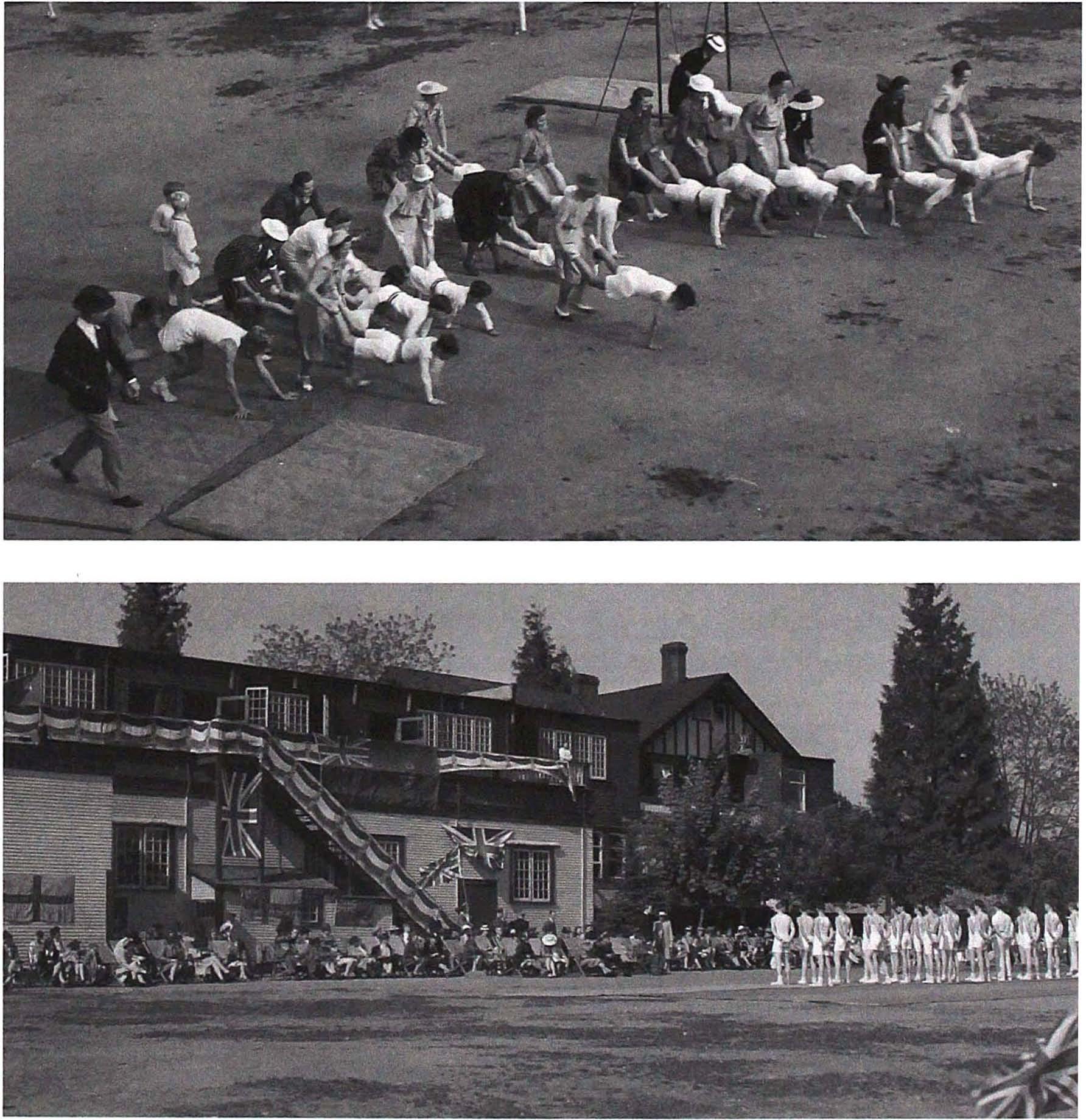
The athletes are presented to distinguished guests and parents.
A long-jumper gets plenty of air.

 CLOCKWISE, FROM TOP LEFT Scouts stand to attention on Sports Day, 1935.
CLOCKWISE, FROM TOP LEFT Scouts stand to attention on Sports Day, 1935.
18
SONGS, CLUBS, AND OTHER TRADITIONS BEGIN



Outside the sporting realm the school established an impressive list of traditions, including the School Song, composed in Latin. In public renderings of the song, John Harker's clear, tuneful baritone would lead the singing. The song did not long survive the demise of the Harker brothers, and certainly during the career of Headmaster Alan Brown it was never resurrected for public performance. However, the House Supper and School Concert instituted in these early days are still a lively part of the culture of the new millennium, despite minor changes.
Douglas Harker, fearing that the boarders had too much time on their hands, instituted the Clubs Program, which continues to thrive today but with a slew of activities unheard of in pre-war times. Who would then have imagined the existence of a Virtual Reality Club, or the ramifications of that empire established by Ralph Skinner, the Model United Nations Club? But then again, how many of today's students could have imagined the trials and tribulations of the Rifle Club back in the 1930S, as described on this page?
After five years in business, Saints saw the first of its classes graduate in the mid-1930S. Throughout this time the school continued to distinguish its students from their public school counterparts by having them wear a full school uniform. At some point in the 1930S striped red blazers were bought from England. These blazers were worn by prefects and often handed down to the next generation. Once the first batch had been sold or distributed, the blazers were never reordered. By the time more blazers were needed the war had started and financial exigencies forced the school to consider less-expensive options.
WALLY PRINGLE EXPLAINS HOW THE RIFLE CLUB "FELL UPON EVIL DAYS"
For several seasons It had been our pleasant practice to set up our targets on the janltor s tool-shed. and to riddle both target and shed with bullets. In this harm less pursUit we were allowed to continue until the occasion on which Axel [the school Janitor and engineer] happened to be In his shed at the time of our activities and narrowly escaped intercepting with hiS person a particularly JUIcy salvo. Since Axells strong and hardy. and the buLlets would have been [presumablyi fairly well spent by the time they had passed through the wall of the shed there seemed nothing to make a fuss about. The Range Master said something of the sort. and was promptly Invited by Axel to go InSide the shed and test the striking force of the bul lets for himself. Unfortunately the R M had at that moment to hurry Into class, and, one way or another the test was never subsequently made Eventually It was thought better to humour Axel In the matter and the Head suggested that so resourceful a person as the R M would find no difficulty In establishing the range elsewhere

The R-M , slightly embittered, entered upon a period of research work and Immediately found himself as unpopular as a trench-mortar officer In the trenches. Nobody wanted him and he was Virtually prohibited by the police An armed lunatiC running amok could not have caused more agitation The matter was eventually settled by a call to the CommisSioner of the PrOVinCial Police
In due course a skeptlcal constable arrived at the school, and In the middle of the afternoon period whisked the R M away In hiS side-car to Inspect a new alternative site As they left the premises In a magnificent sweep round the drive the R -M was fleetingly conscIous of half a hundred youthful faces pressed against the Window panes. under the Impres sion that he was being taken Into custody He regrets to record that the faces were not sorrowful but ecstatic. By the time the constable had outlined the various dispOSitions which would have to be taken to comply With the law the R M was dimly envisaging the construction of a second Maglnot Line
RIGHT
The first graduates: Junior Matriculation Class of 1936.
First row {left to rightl: Basil Alexander. Don Berry. Cooper Drabble. Robert Ker. David Sloan.
Second row {left to rightl: Unidentified. Fred Denistoun-Jones. John Randall. Ed Pidgeon.

OVERLEAF

Decked with holly. cypress boughs. and streamers. the gym was the setting for the annual Christmas partyan event remembered fondly by several generations of Georgians.
A UNIQUELY ENGLISH STAFF ROOM
The Englishness of the staff in those early days is beautifully captured by Wally Pringle in a Georgian article of the late 1930S:
Afortnightbefore the end ofterm, the Gunner[Pringlej, hastening to evening chapel, saw afomiliarfigure at the door of thegym, and realized that the Daltonian [Douglas Harkerj had returnedfrom his trip to Europe, looking extremely fresh and pepfol. The Gunner,fteling only pleasure in his candid soul, dashedforward.
"Hallo," said he, "had a good trip, and so on?"
"Splendid, thanks, excellent trip, " returned the Daltonian. The situation as between Englishmen having thus been met at all points, they relapsed into silence, and beamed at each other diffidently until thefigure of the Head, with jlying gown,jlashed between them at a rapid double, taking a dog or two in his stride, and indicating in thejoyous Georgian way that chapel was about to commence.
20
Another Georgian piece of Pringle's evokes the day-to-day humdrum quality that pervades most school staff rooms across the land. With an ironic touch and a deft feel for time and place, Pringle makes this staff room uniquely St. George's:

It is a comfortable andreassuringthing that we can apply to St. George's the somewhat cryptic French dictum, "Plus f"a change, plus c'est la meme chose. JJ we stiff falf over dogs and smalfboys in dark corridors, and coffide violently with each other round corners; the half clock is stiff in permanent disagreement with alf other time pieces, and belfs stiff ring ofwhich nobody knows the significance, andjail to ring when one would logically expect them to. There is stiff the delightful uncertainty regarding the exact location of the key ofthe games cupboard, and as to whether the store-cupboard in the basement is, at the moment, indeed a store-cupboard, or a locker room, a recreation room or a science laboratory.
The news of the day may stiff be gathered from the varying expressions on the faces of the Staff Ifthe Scout-Master [Cappie Robinson] looks pleased, he has been given a Scout-room; ifdepressed, the Scout-room has been requisitioned for storing potatoes or lecturing on aircraft. Ifthe Science-walfahs (with whom the place is over-run), smile and nod pleasantly, they have ordered about a hundred dolfars worth of science books, and got away with it; ifdespondent, the text-book expert has nipped their little game in the bud, and held them down to five dolfars. ifthe Sapper [Bob Dekkingj is offenSively cheery (in which case the corners of his coffar will curl upwards), the Canadian defence system is proceeding satisfactorily, or he has discovered a town in China of which nobody else knew, or cared, to add to his map; ifhe appears morose and distrait (in which case the corners of his coffar will droop dejectedly), the Empire will have gone to the dogs, or he will have failed to receive a telephone calf from Kamloops. Ifthe Kindergarten teacher bestows a happy smile on aff and sundry, her charges are behaving reasonably well and she has a good supply of crayons and drawing paper, scissors and paste; ifshe looks pathetic and appealing, there is something heavy to be carried up to her room, or she wants a set of new readers for the class.
21


22


2)
Seniors from the late 1930s pose in full school uniform.
 RIGHT
RIGHT
Stanley Burke ['401 models one of the prefect's blazers brought from England in the 1930s and originally worn by J. Holland Burne ["381.
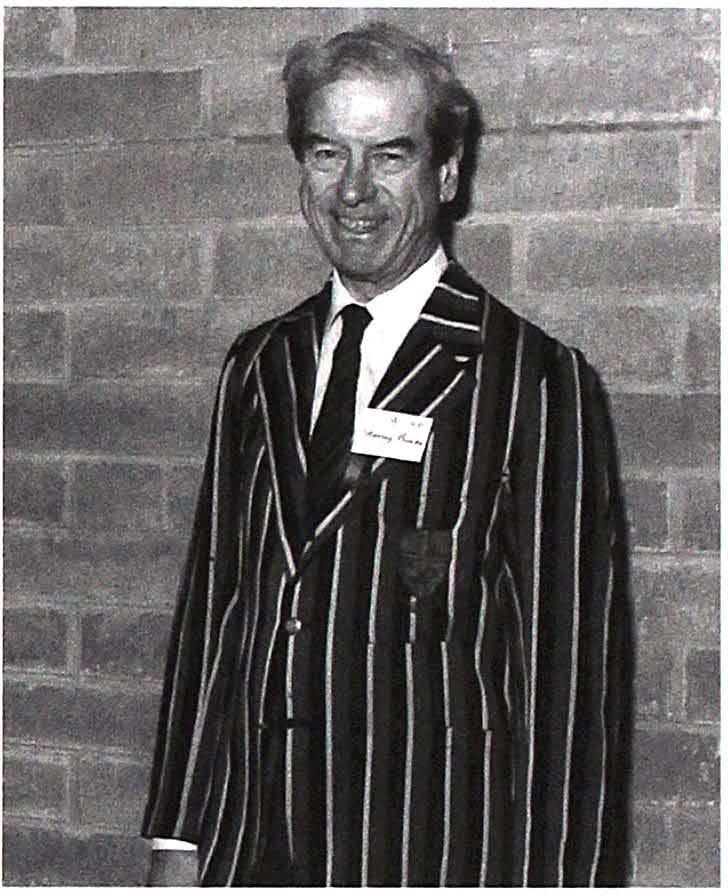
PREPARATIONS FOR WAR
December 1939 saw the outbreak of war. For the school this resulted in the immediate loss of two of the staff room's greatest stalwarts, namely Arthur Lungley, who had done yeoman work inestablishingrugby, and Douglas Harker, Headmaster John Harker's deputy head and right-hand man. Both would be sorely missed. Douglas, who had earlier supported the dove faction and been in favour of appeasing Hitler, signed up the day Canadajoined Britain in declaring war on Germany.
In the Georgian, Wally Pringle pondered the implications of the precipitate departure of his two honourable friends and colleagues for the 1940 winter term timetable:
TheDaltonian, on the eve oftaking up his military duties, waved a vague hand towards his desk. "You'llfind everything there, "he said easily. "The timetable was practically ready. Ofcourse, it willwant a certain amount ofadjustment now... "

"That '11 be allright, "said the Gunner, without conviction. It was six o'clock in the morning-an unearthly hour.
"Well, cheero, "said theDaltonian.
LEFT
24
"Gheero, }} said theGunner. "Good hunting See you in theMaginot Line later. }}
TheDaltonian, dapper, newlyshaved and ofmilitary age, turned abruptly, tripped over the mat, and vanished through the sliding door; theGunner, who was none ofthese things, remained staring at the timetable, and the years slipped back, twenty-five ofthem... A quarter of a century, byJove!
Three days later, about half-past two in the morning, theGunner, encircled by empty coffie cups and tobacco smoke, sat back in his chair, and removed his gaze from the timetable, in which the "certain amount ofadjustment" mentioned above had at last been made, all except two trifling snags, to wit:
1. ArthurLungley was seen to be leading a double life, being inGrade 12 andGrade 10 at the same time infourth period Thursday; and

2. Grades 3, 4 and 5, conveniently bracketed together, did singing and boxing simultaneously in thegym onFriday mornings.
The loss of two key members of staff, and the many more that followed, wasn't John Harker's only problem. There was also a marked drop in student enrollment as parents pulled their children from school and returned, for a variety of wartime reasons, to Britain. The consequent loss in revenues put the school's already strained finances in a parlous condition, but St. George's survived-a story that belongs to the next decade.
2S
Clorut...... r. Ct.uh D. Clal'l\.. R. ClotMn- J. .... R. D.F.e. c"ni«r A. C01>.6ld.l..... M. c-..uooll 1'. c.......", J. ".....lmg A. Crll.tlT 14._ Cp\,ibt.o.. '\\. D.af.... W. O'uSrU....J v. D...u.b4 c. £lk..l..j c.. EUwtt R. El. B. El#. :T. l-.u-Al1I.lUDn t. n.dl ./.. I).r.c. n...."-u K. t......l,6 R. 0:..1\........" A.
Go,...dt L. c.....nt L. �I...a:r. �v.I D. GTolg R. • H41yln R RQl1UQ. G. HO.'l"ltC'r" .D. tncut. H.,sl\"tt W. Hiuton. L... Hom'lT� :T. H""a R.. Ho.... P. H....!Jhtou B. �oa.:r. H�..t� S. Hurr.n R. ;r�R. Juu..� 1>.. 1<.... R. Kln9 h\. I«rllpal'r-Iel\ C. Ka £. �.C.
lOl.vrlc w. lu.n�t"!l .\\'De"otdr..H. ,\\'Do"",,1l P. .\\.Co "\\�\�ny.. G. _'-\.o..dknJIIZ \v. .\\""I..,,,,,, V. ..\\QlI\and W.DF.,VI.. �·>�""..tin C. l\\qrc(Jr � A\IU.r R. .\\00'"': D. llJ\ull.ro D. X....h U. t\ation. C. S..t"Dn \\1. N.woll :T. :i"'j46 :T. OHu"r E. Po.t'h8t" S. P,.)rl\or ....r"C"u16 A. PO,.k4r ..J'I5fruift ri. PC4llO- Lp

Pann,,'J c.. Sand... R. f'1�.o" c. Scatt n. l-'ldgcC1\. F. Shantl H. J'.n""ll A. Sharp :\<\. Pcttiusa-r f. ...51..,,11) E"..fralhJ C. 61cc R • Rauci.,.11 3". Sloo.1\. D. RCUlnlUS.1t1n <J.. SLDOU.J. .Ra.ttr4� M. �·t::� �.nic]t"t.sCT\ u. Hidd�1t c.. S"'ltl�H. ",,-u R<>l><rt.-oon R. Sp<>-rlL:J 3". Iloltiluon �. Spencer D. Robhuon W. Spr!j Jt. 1l",\:.itl6on G. Stoincr" ;r. Ilojl! :1.3". St""d C. Rc",,,, :1.0. stO:1r-.!tUf V\'. R"'3� n. 5t.1.oul8 A.. i. HD�'" s. -nunt. StoN'T' O. Jt.«'t'burgl, T. sr..",ot P. n,,�dlto'\\ <J.. Sh"""9 �. Sa!)cr A. D.F.C. Stu R.C. So.nd.c....".," .:T. *Stuart ft.V. *S\.Ve4Q� &:n


S...."""!! C� s..."""1I s. T4ijtor:T n...a...t.: G. Tu.1h.oJ>cW. Tupp.n-I). �;r. 1Vol1ClC4 1>. ,U.Il...... 1'. w..!u,..,., ft.. W,,11.. ». \\htfon P, �ho.-lwod G. \�,.....,.,ttR. Wuhl\a.wtt l. Whlttoll P. Wbtlt..n R. Whllto.\l W. WICK$ob ;r. Wi1l1..'.... t.. *,vn"on _"\. �UtGt'a. Cl' """'nlU R. o.B.f. You,,", It.

1939 1945
3B£1llb£r.$ of St.. .6'.At:or,g£'s 5chool who 's.At:rl?Jtb l.vith th.e A-rm£� For-cAt.$' illthe 5�con� Worllt
The 1940S: War, Survival, and Recovery
1940 May 10, Germany invades Belgium 47 evacuees from the UK arrive to board at the school
1941 Ensign from the battleship King George V is presented to St. George's
August, the ill-fated Dieppe Raid involving 5,000 Canadian troops
School financial picture improves as invasion threat from Japan recedes
Five acres of land bought from the Jesuit Fathers for $6,500
May 7, Germany surrenders
August 14, Japan surrenders
1946

Finances improve and a dividend is paid St. George's buys more houses on 29th Avenue and 30th Avenue
Reverend Geoffrey Parrott hired (and stays on for 20 years)
Edmund and Garry Colchester hired (and stay on for 23 years)
Fraser Valley floods-school Cadets man the dykes
Partition of Palestine Partition of India

Stalin closes land access to BerlinBerlin Airlift begins
The school becomes a non-profit benevolent society
1949 P.H.B. Lyon, formerly headmaster of Rugby School, visits St. George's
1942 1943 1944 1945
I Roll of honour inscribed by Nancy McDonnellln 1947 [see Appendix 21
1947 1948


28
2

War, Survival, and Recovery

DURING THE 1930S STAFF MEMBERS WERE DEEPLY DIVIDED, with the younger pacifists on one side and the older veterans of the Great War, who were deeply suspicious of Hitler's motives, on the other.This piece by Wally Pringle communicates the angst of the older staff:
We abandoned ourselves, and, far worse, our children, tofeverish, neurasthenic excitement, unbalanced emotionalism, and relaxed morality, reckless and hysterical pleasures. In a sweepingreaction society lost control ofitselj and, like an automobile with powerless brakes on a steep down-grade, rushed with ever-increasing momentum towards the inevitable crash. When the swashbucklers of Europe made a quick recovery and laid their hands to their sword-hilts, we huddled round a table at Geneva and waggled a reprovingfinger at them. When, now and again, a voice was raised among us in warning, it was drowned by the bleating of the pacifists and the scandalized reproach ofthe godly.
For the students, things were more straightforward. According to a student rag of the time, the Spear (an appropriate name given the wartime footing of the school), the ambition of every student was "to enlist and go over there after the Fuehrer's scalp. Some will go just for the adventure, some for King and country, and others to ensure a peaceful democracy for future youth ...We wait for word, and stand on guard for Canada." Some students also contemplated "Hanging out the washing on the Siegfried Line" along with erstwhile teacher, mentor, and deputy head Douglas Harker. A cartoon to this effect-with Douglas shown snatching off-duty time to make toast-appeared in an issue of the Spear (see page 30).
IThe front cover of the Georgian for 1945 celebrates an end to the struggles of the war years.
Douglas Harker " on the Siegfried Line," as portrayed in a student newspaper

WARTIME REFUGEES
Coping with the unexpected was to become the rule in handling the exigencies of wartime. In 1940 a group of 47 young refugees from the UK, of both sexes, arrived to be boarded temporarily at the school. Naggers Harker coordinated much of the work, but this did not stop the staff from expressing apprehension:
"U{> have nothing to do with them during the day," said the Head. "The U{>lfare people look after them. They do everything U{> take over at 19-50 hours until breakfost. There '11 be a night nurse ofcourse, but somebody ought to be here as well..."
"You mean one ofthe staff?" queried the Gunner, having no doubt at allas to what was meant.
"U{>ll-virtually-yes," said the Head, shuffling his papers on his desk with earnest concentration "There'll be aboutforty ofthem, halfboys and halfgirls."

"I know nothing whatsoever about girls," said the Gunner firmly.
"I know you don't," said the Head, and his tone sounded a little peculiar, "but you won't have to worry about them-there's the night nurse, you know."
"Oh yes, ofcourse. U{>ll, that's allright," said the Gunner, reassured.
The arriving evacuees were accompanied by curious neighbours, the police, the press, and a mass of volunteer helpers who far outnumbered the 47 bewildered children. The children stayed a fortnight, long enough to win the hearts of everybody. In Pringle's words, "We loved it all, that scant, hectic fortnight which these small people spent, in a mixture of humour and pathos, under our roof. We think of them sometimes, and wonder how they are faring in the safety and comfort of their new homes, and we wish them Bonne Chance and good fortune while they are among us, and after."
Quite apart from this short-term contingent of young people, there were refugees who enrolled at the school for the duration. They brought with them tales of the Blitz, blackouts, and the transatlantic convoys that brought them to safety. Their stories were soon to be enhanced by those of some St. George's students, now returned to England, who had adventures of their own to share. Peter Greaves, who had been at school in Petersfield on the south coast of England, recalls experiencing a raid:
I
6ometlmo nort year D.i3 H recehee hiB oopy ot tho SPaAR while hanging up hili "o.ahlog on tho S1>rlod Line 30
This particular raid was very long It started about 11."]0 p.m. and the all-clear sounded at 5:30 a.m. Once down in the air raid shelter we began to sing songs together. After about an hour our headmaster, Colonel Stevens, told us that we should get some sleep. Hardly anybody did because thefloor was so hard, despite the carpet and blankets. The dust down there was so thick many of the boys coughed and sneezed most ofthe night. One retched violently in a corner, and the smell of vomit filled the tomb-like interior ofthe place. Sometime later, it seemed an eternity, we were given biscuits and water, and were dismissed to our beds, even though the all-clear had not been sounded. In the distance we could still hear the thud of bombs falling on Newhaven, a cross-channel port about 12 miles away. The night sky was sporadically lit up byflares from German planes groping in the dark in search of their targets.
ENCOURAGING THE DOMESTIC ARTS

The war caused a dearth of domestic help at St. George's. Pay in essential war work was too good at more than $90 a month, and the school could not compete. The result was that the boys were enlisted to take on domestic chores. Students became responsible for cleaning the dorms, classrooms, and common rooms, for waiting on tables, and even for helping out in the kitchen. The new social contract had some surprising outcomes:
These innovations have caused some alteration in the standard ofbehaviour and achievement among the boys.
"Matron, what sort ofboy is Gubbins (i)?"
"Oh, a splendid boy, the best sweeper I've got; he really dusts a beautiful dormitory. "
Or, "Blitheroe seems a nice chap, and he's quite a classical scholar. "
"Oh, no, he's a terrible boy; he's broken several glasses this week, and last night heflung thefood infront ofthe Masters, as ifhe were throwing bones to one ofthe dogs. "
Thearrivingevacuees wereaccompaniedby curiousneighbours,the police,thepress,anda massofvolunteerhelpers whofaroutnumberedthe 47bewilderedchildren. Thechildrenstayeda fortnight,longenough towinthehearts 0 f everybody.
)1
Thesearrangementsare neitherparticularly satisfactorynorefficient; nevertheless, theyeasetheload, andapartfrom that, itisnodoubtagood preparation forthings tocome. It should be no smallconsolation tothosewhofailMatriculation toknowthattheirexperienceintheDomesticArtsatSt. George'smayhelp them to find positions with someofthebestfamiliesinthecity.

The reference to "Gubbins (it illustrates how students with the same surname were distinguished by the use of bracketed lowercase roman numerals after their names. The system worked well, provided that the bracketed numbers referred only to members of the same family, where (i) denoted the oldest. Things became hopelessly confusing when there were several families with the same surname. The bracketed numbers gave no clue as to which boys were of the same family, only that Gubbins (iii) was older than Gubbins (iv), though they might well be of different families. A further wrinkle in this system is described by Derek Simpkins ('64), who explains how he started his career as Simpkins (iii) and rose to plain Simpkins when his two older brothers graduated. (A sort of "graduation by numbers" was Derek's wry comment on the process.) But whatever the difficulties of the system, the use of Christian names was not an option in the early years, as this was considered an invitation to familiarity that would erode respect for the faculty and lead to unimaginable chaos!
CULTIVATING THE PERFORMING ARTS
The annual School Concert was an event inherited from the days of Captain Danby-Hunter. His production of St.joan had, quite apart from putting him in bed, placed the rest of the curriculum on hold. In the years following, the productions continued. Although not quite so ambitious, these always involved a number of staff in writing scripts and producing one-act plays, to the delight of all. But in 1940 the patience and resources of the school were so severely tried and tested that the cancellation of the event was seriously considered:
"This yearatleast,"saidtheHead, "wehaveadefiniteexcuseforwashingoutthe concert. Thewarandso on.Whatto youthink?"
"Absolutely," said the Gunnerfervently. "Wouldn't do at all,"he lied. "Not the thing"
The Scout-Master cleared his throat. TheHead andthe Gunner swung
32
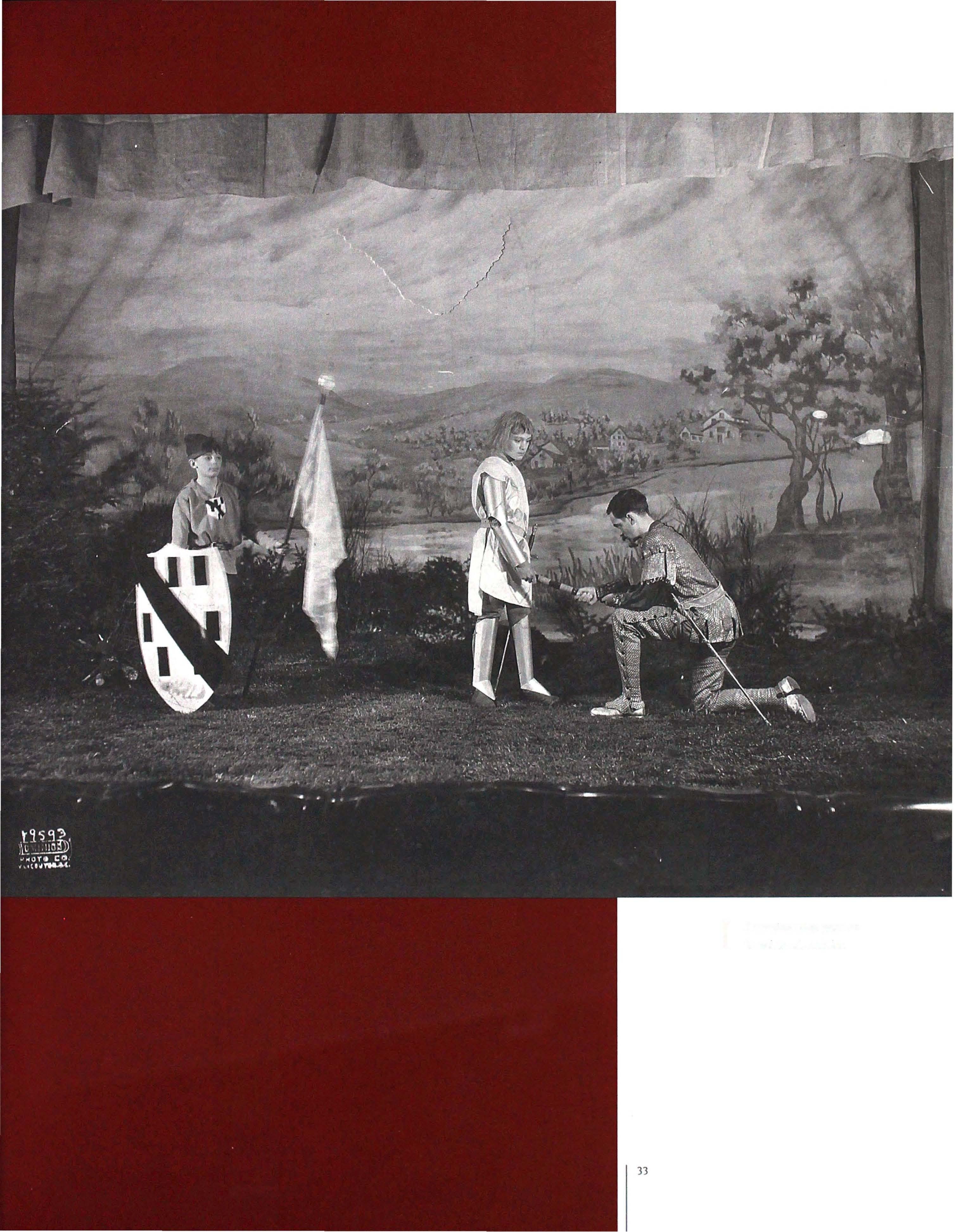
I A wartime play goes on to universal acclaim.
A historic wartime celebration of the staff, most likely in honour of W.H. Hudson. Huddy sits in the centre between Douglas Harker's first wife (rightJ and Muriel Jacobs (left!. John Harker stands on the left of a trio at the back of the room, with his brother Douglas sitting in front of him. As is appropriate for any St. George's occasion, a school dog, PSmith, takes up centre stage.

around upon him, blitzfully, /1.s a matter of fact, "stammered the S. -M, "I was just thinking about writing another play, " " "That settles it, "said the Gunner finnly, and ifthere was ambiguity in the words, there was none in the tone, TheHead preserved a tactful silence, TheHead, whenever he has led or goaded someone else into stating an awkward decision on his behalf, alwayspreserves a tactful silence,

It is a curious thing that, not withstanding the above conversation, theHead and the Gunner both knew in their hearts that there wouldbe a concert There willalways be a School Concert,just as there willalways be anEngland. The shameless volte-face in which they virtually indulged about halftenn, which might have made evenHerrHitlerblush, leftthem without a quiver ofconscience,
The School Concert of 1940 was notable for the condition of one of the performers, Stevens, who had been stung by a bee the day before:
The next two items, a recitation and a song were to be presentedby Stevens, whose foce hadundergone a devastating transfonnation as a resultofa bee sting With the kindly thought ofsparing the lad embarrassment, the Gunner, whose knowledge ofstage management was fragmentary, arranged that only thefootlights should go on during theperfonnance, and having so arranged, went out to smoke a cigarette.
During hisabsence, the operator ofthe lighting efficts appeared to decide on his own initiative that even thefootlights weresuperfluous. The resultwas that "Kubla Khan"and "Through the Years"were admirably rendered in acompleteblackout, while perspiring personsbehindthe scenes spoke softly to themselves and cruised about in fruitless searchfor the switches.
34
SURVIVAL

Surviving the war years with an intact reputation for good teaching was to be the greatest challenge for St. George's. It wasn't until 1942 that John Harker could breathe a sigh of relief and emphatically state that his staff was now 100 percent ineligible for war service. Over the two-year period he had lost ten staff members. In the Georgian of 1940, only one year into the war, he wrote of these challenges:
The momentous school yearjust ended has not unnaturally proved one that rang many changes among our staff, and during the course ofits ten months there have been many inevitable replacements. It is the record of a school year in war time, with enlistments in the fightingforces to supplement the usualston'esof births, marriages, and sad to say, a death.
Taking things more or less in chronological order Mr. Douglas Harker enlisted before the term actually began, andjoined a gal/ant company of first-day volunteers. Three weeks later he was gazetted a Second-Lieutenant together withMr. Arthur Lungley. Shortly after, Mr. Beatty, a new master, was offered and accepted a Fel/owship at Toronto University. After a month's respite, at Christmas, Ben Sweeny, who had been very restive, left us tojoin the Gunnersjust before the term's end. The Christmas holidaysprovideda blessedrespitefor Staffreorganization, and whenterm commencedit was with two newmembers. InFebruary, ChristopherJohn Harkerjoined ourJunior Staff, and after duecelebration we actually imaginedthat there would be nofurther Staffincidentsfor the balance ofthe year. but we were mistaken. In earlyMarch, Captain Robinsonjelfand broke his ankle, scouting in the gym. By the time the school reassembledfor the Summer Term everyone seemedfully recovered. Even so, there were further changes with the loss ofMr. Costel/o inMay and two weeks later, Nip Parker, despite thefoct that he was now the proudfother of a six-week-old son.
Harker was successful in replacing his young staff volunteers and conscripts with three older men then in retirement-a "Mr. Chips" contingent of sorts. He was particularly fortunate in finding W.H. "Huddy" Hudson, who served throughout the war years and taught almost every subject offered, including trumpet lessons, the latter providing a ready excuse for missing staff meetings. Huddy retired in 1945 but continued to teach part-time until his death in 1948
35
In 1941 Reverend William Theodore Keeling became the school chaplain and full-time master. The triumvirate of veterans was completed with the addition of cr. Connor, who jOined the staff in the same year and did prodigious work equipping and running the laboratory, as well as teaching all the sciences, until his retirement in 1952.

The special contribution of these three at Saints was celebrated at a House Supper in 1944 to the tune of "Willow, Tit-Willow," from The Mikado, with the refrain cunningly rephrased as "Keeling, and Connor, and Huddy."

At the time, John Harker reflected on the trio's not inconsiderable efforts to keep the school going during five years of war:
As J deliberated this morning on what to say in this year's staff notes, J wondered ifthere were many other schools in and around Vancouver, either public or private, who could boast three teachers of such knowledge and so much experience. J thought ofthem bustling about the daily round and common tasks at St. George's with seldom afree moment or afree period, and J mused upon the example set to
 I
The Cadet corps prepares for an annual inspection.
I
The Cadet corps prepares for an annual inspection.
the rest of us by these three Venerable Invincibles, who muster between them 125 years of teaching experience and whose effortsfor the boys they teach never flag and never end.
When war broke out five years ago theyfelt it their duty to stand by the profession to which they had already given so much on a full-time basis, and it is largely due to them that academic standards at St. George's have not only been preserved but improved.
FOUNDING OF THE CADET CORPS
The first Cadet force was organized in 1939. Under the stre ses of war, the force quickly became an integral part of school life. Having an effective Cadet corps was close to the hearts of the governors of the time, who provided generous support in the way of uniforms, equipment, and advice. In the final tally no fewer than four lieutenant colonels were consulted for their military advice! It was Nip Parker who took command, his first, before going overseas. Although small of tature and youthful in appearance, he had a formidable parade-ground bellow, which he used to good effect to muster the Cadets on parade and drill them remorsele Iy in the name of an unforgiving military diScipline.
THE CADET CORPS: STUDENT APPOINTMENTS, 1939 Rank Captain Lieutenants Quartermaster sergeant Sergeants Corporals Lance corporal

Name Maltland Strong Rose [d Slee


Pottlnger. Clothier Burke Sharp. Rose [11!. Tupper Whlllall [d Bellerldge

37
CLOCKWISE, FROM TOP LEFT Members of staff who survived World War 11: Tommy Roxburgh. John Blackmore. Arthur Lungley. Peter McDonnell. Tony Parker-Jervis. Douglas Harker.

Courses in musketry at the Beatty Street Armouries were organized and before long Morse code, signalling, St. John Ambulance first aid, telephony, and radio courses were added. By the end of the year Cadet ranks had been assigned from captain down to lance corporal. Sadly, of the dozen Cadets so honoured, five were not to return from wartime service.
It eventually became government policy that all boys 12 and older should become Cadets, and with this decree the school put its time-honoured Scout program on indefinite suspension.

With the departure to Europe of Nip Parker, the Cadets were organized by a number of staffers, including First World War veterans Wally Pringle and Cappie Robinson. They were assisted in their endeavours by Sergeant Major Clapshaw, who remained a constant throughout the war years, despite the fact that Georgian editors were never sure that his name was not "Clapshew."
Annual inspections by visiting military dignitaries were affairs of careful preparation and honour. Full regimental uniform, with boots made mirror-like by diligent spit and polish, was the name of the game. Parade-ground drills carried out with military precision were the hallmark of the well-trained force. In the BC annual inspections of 1941, 80 schools took part. The St. George's contingent received praise for the high standard of its turnout and placed 14th.
In 1945, the year Captain Nip Parker returned, the corps won the lODE trophy for the best Cadet force in BC. It was the crowning achievement of the force's short history, for the following year Corps #1605 became a regimental Cadet unit affiliated with the BC Regiment and the program moved off-campus. Despite the shift from St. George's, the Cadets were still able to serve the province during the spectacular flooding of the Fraser River in 1948:
Our cadets were called out en masse to fight the floods and to assist the farmers with their marooned and stranded stock and homes. From all accounts they did a finejob, proceeding to the van·ous distressed areas by lorry, and also school bus in groups of40 to50. While this was originallyintended as only a daytime occupation, some ofour boys were inevitably sent far afield, and it goes without saying that three of those who missed nearly a week's school by being transported to distant points-no doubtagainst their will-wereBurdick, Minty, and MacInnes.
39
Students and staff who died in World War 11. No photographs are available for Gordon Bolin, Jack Greathed, Carson Proby, George Rasmussen, or Mariott Wilson.
COUNTING THE COSTS OF WAR

The school was justly proud of the contribution of its staff and students to the war effort, as summed up by John Harker: we have another boast which,for the size ofthe school, may take some beating, and that is based on the number of younger some-time Masters here who joined up immediately without hesitation or question ... two ofthem have given theirlives;five ofthemhave been wounded. 1 should like them to believe when they read these lines that the memory ofsome happy times we spent together is kept alive by those ofus who stayed home, and that wefollow their careers and achievements with affection and pride.
In all, 165 Georgians and members of staff served in one of the three services or the merchant navy and 27 Georgians and staff did not return. The stories of two students from this time, Bachee Parker-Jervis and Bill Maitland, encapsulate the careers of many brave young men. Today Parker-Jervis is an energetic octogenarian, but his contemporary Maitland has been lost to us for more than 60 years, after he failed to return from a bombing raid over Germany.

I
40
George F. "Jack" Strong, RCAF
Sedley F.C. "Ben" Sweeny, RCE
John George Clothier, RCAF
Gordon Hanes Hanna, RCN

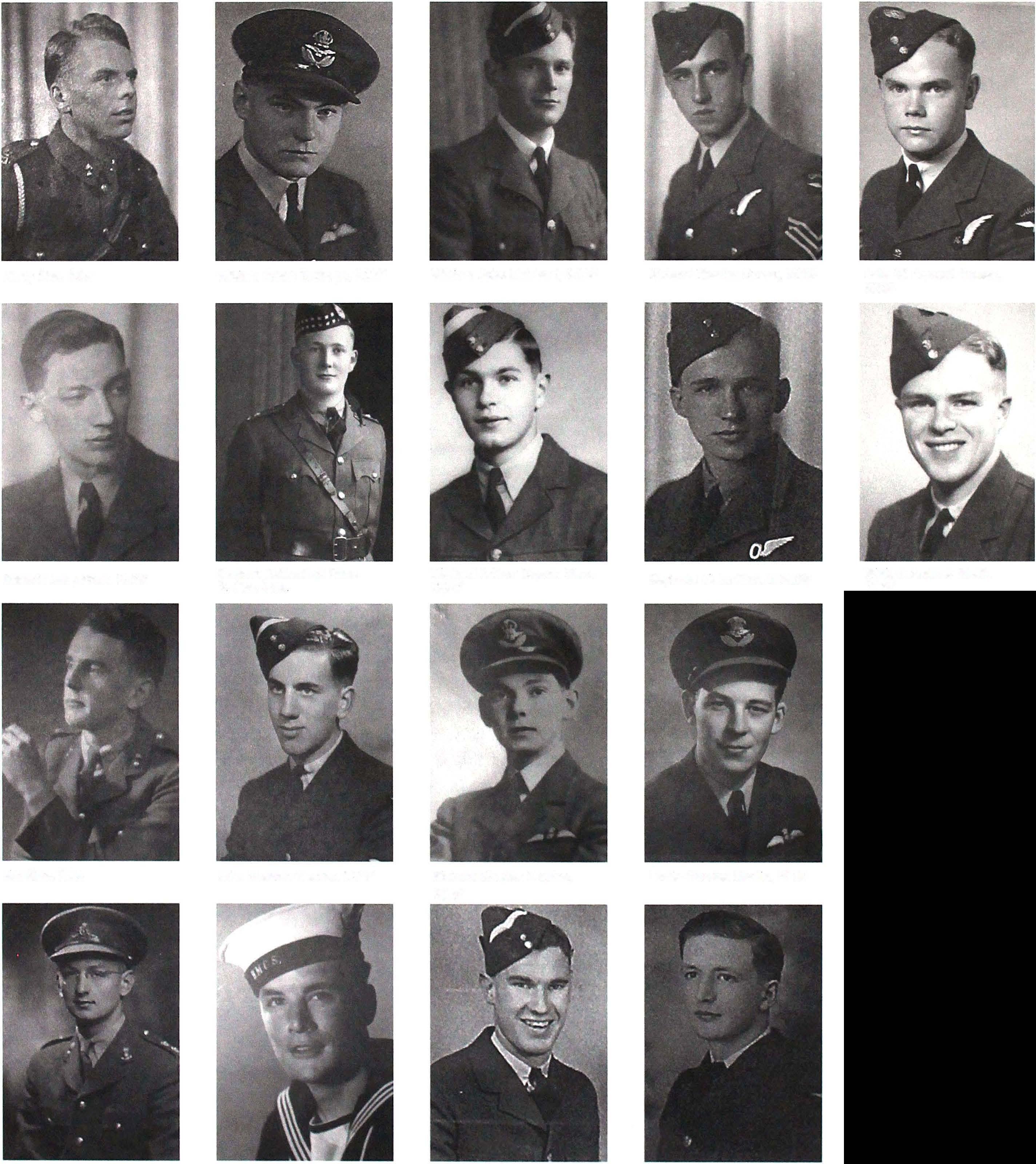 Harry Else, RCA
Roberl Henry Rose, RCAF
Jlm Else, RCA
Sanford Gall Smllh, RCA
Willlam Frank Tudhope, RCAF
Slewarl Rulherford Ross, R Can, Scol
John Duncan Mercer, RCAF
Gordon Monlgomery Des Bnsay. RCN
Willlam John Mailland. RCAF
Richard Arlhur Bayson Slee. RCAF
Richard Charles Sandes. RCAF
Herberl Lawrence Anderson. RCAF
Richard Charles Sluart. RCAF
Reginald Vlclor Sluarl, RCAF
Leslle Charles Marlin. RCAF
Donald Francls "Robin" Hood. RCAF
Harry Else, RCA
Roberl Henry Rose, RCAF
Jlm Else, RCA
Sanford Gall Smllh, RCA
Willlam Frank Tudhope, RCAF
Slewarl Rulherford Ross, R Can, Scol
John Duncan Mercer, RCAF
Gordon Monlgomery Des Bnsay. RCN
Willlam John Mailland. RCAF
Richard Arlhur Bayson Slee. RCAF
Richard Charles Sandes. RCAF
Herberl Lawrence Anderson. RCAF
Richard Charles Sluart. RCAF
Reginald Vlclor Sluarl, RCAF
Leslle Charles Marlin. RCAF
Donald Francls "Robin" Hood. RCAF
41
John W Connell Cowan. RCAF
Wllllam Andrew Black. RCAF
BACHEE PARKER-JERVIS

Bachee was one of the original 24 students who opened the school in 1931. His nickname, which has survived the passage of time, derives from his childhood in Malaya (now Malaysia). His Malay name was baba ketchi, meaning "little baby," which in the mouth of his brother Tony became Bachee; and that is the way it has been ever since.
His photograph shows a boy in "pint bottom" glasses, indicative of serious eye problems. Bachee enlisted during the first week of the war but was assured, almost immediately, that his poor eyesight would exclude him from all possibility of active service overseas. He was assigned to BC Coastal Defences, doing duty in the gun towers on Wreck Beach and on remote York Island in Johnstone Strait. After enduring the most inexpressible boredom, and with no prospect of action of any kind, he determined on getting to Europe. Going absent without leave, he bought a rail ticket for Halifax, where he signed on a merchant navy ship as a trimmer, responsible for shovelling coal into hungry boilers. On arrival in England he gave himself up to the Canadian military authorities to be court martialled and received seven days of detention. It was a mild reprimand, one that recognized a true and determined spirit.

At this point in the war the former stringent requirements for service at the front were being scrapped, so desperate was the shortage of troops. Despite the problems with his eyesight, Bachee was drafted into the crew of an armoured antitank vehicle, where he was to see action in Italy and Holland. He was trained as a wireless operator and driver. Other members of the crew, such as the gun loader who had been a baker in civvy street, received little or no training at all. Bachee remembers that the former baker was encouraged, as he loaded shells, to think he was back in the bakery shovelling loaves into his brick oven.
Bachee returned to Canada, all limbs intact, but with the scars of war left on his bottom further trophies to add to those collected as a youngster in the boarding establishment at Saints!
I RIGHT
Bachee Parker-Jervis on his first day at SI. George's in 1931,
42
BILL MAITLAND

Bill graduated in 1940. In that year he was school captain, captain of the rugby team, and the only student designated captain (the highest rank) in the Cadet corps. His rugby coaches said of him that "throughout the two Rugger Terms, [he] did a consistently excellent job, both as Captain and as the most inspired player on the side. A good kick, with a nice turn of speed, good hands and sound judgment. Proved himself equally reliable in attack and defence and showed every promise of developing into a first-class player."
The "Get-Fit" Club was an initiative of Bill's designed to keep the team in excellent condition and in anticipation of the fact that the team members would soon all be in uniform. That last season they spent together was particularly successful, with only two losses in 23 games.
Bill was also a stalwart of the "/\' cricket team, where his coaches described him as "a good fielder. Not very safe with the bat, but a vigorous, if unorthodox hitter, capable of adding a few useful runs in an emergency."
On joining the military, Bill Signed up with the RCAF. In 1941 he had achieved the rank of sergeant pilot, and in one letter to the school communicated that he was just going on fatigue duty to clean the barrack room out. The remark elicited the pungent observation from the Georgian editor that he hoped Bill "would do a better job of it than he ever did of the Prefects' Common Room."

A year later Bill reported that "being on operations is just about the same as going to school, the only difference with me is that now when there's something to learn, I make sure of learning it, for some day it might mean a lot-perhaps life or death."
In the same year he received the Distinguished Flying Medal after being wounded in the chest during a bombing raid over Stuttgart and bringing his machine and crew back home safely. Shortly afterwards he was promoted to the rank of flight lieutenant. However, in December 1943 his luck ran out and he did not return after his machine was shot down in a raid over Germany.
Bill was a great inspiration to his friends and colleagues. To contemporary students he is remembered for the Maitland Cup, presented to the school by his parents the year after his death. The citation reads, "The Maitland Cup is presented to the student who in the opinion of his fellows is the best player and sportsman of the first XV rugby team."
I BELOW Bill Maltland In uniform.
43
Ensign of HMS King George V. gift of W.C. Woodward.
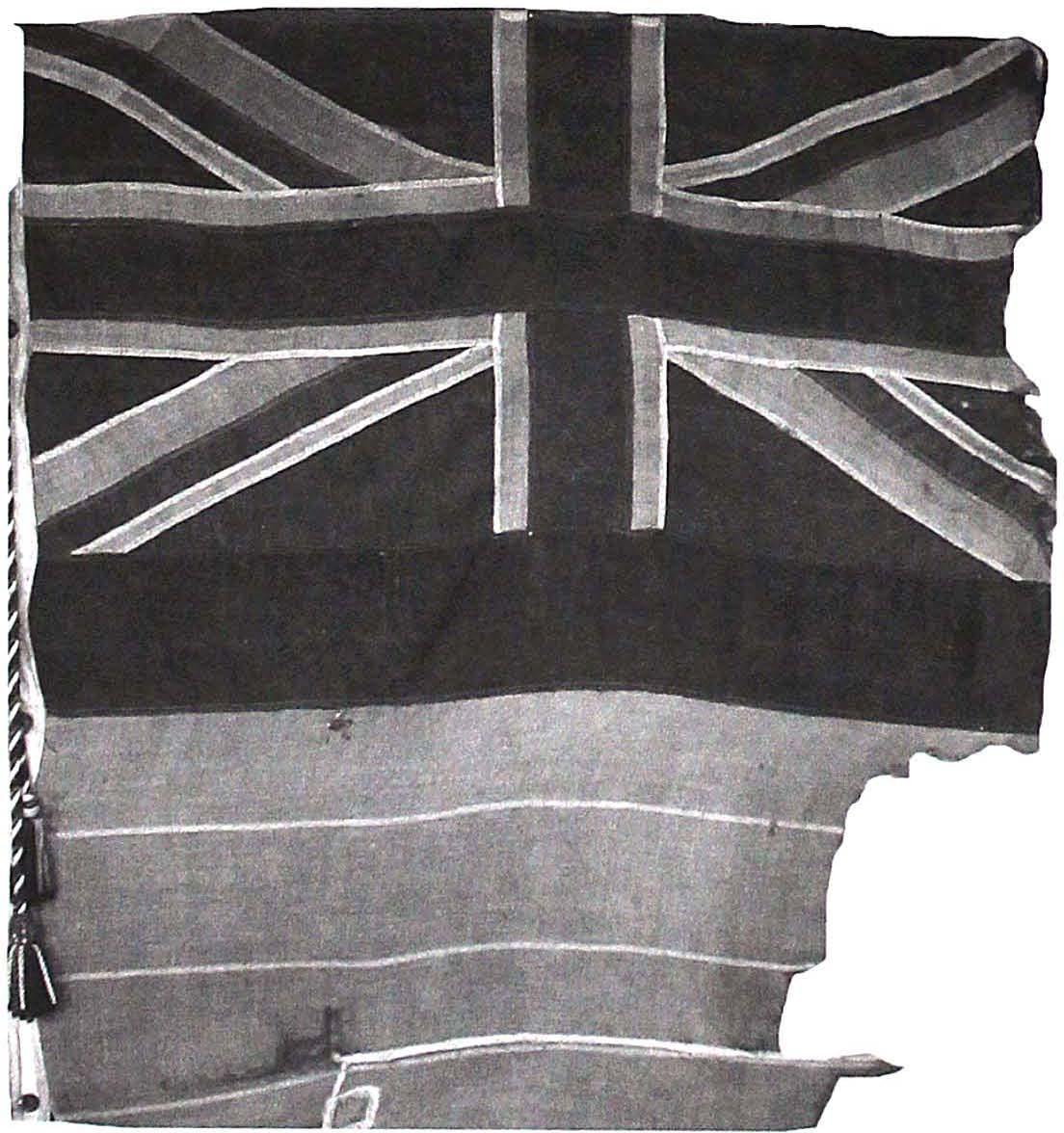
RECOVERY

After the war there was a veritable flood of contributions to raise fitting memorials to those who served and those who died in the conflict. These were added to the already considerable number of tributes that had arrived during the early 1940S, when the chapel was the beneficiary of gifts connected with the wartime experiences of members of the St. George's community.
William Cuiham Woodward, who was Lieutenant-Governor of BC from 1941 to 1946, was also one of the school's first governors in the 1930S. He and his wife remained firm supporters of the school, attending chapel services and providing flowers for the altar through the 1940s. In 1941 Colonel Woodward presented the school with the ensign of the King George V, the battleship on which he had returned to Canada from the United Kingdom after being torpedoed in an earlier attempt to come home. The ensign was a gift of the captain and crew, and to this day it hangs in the Senior School library.
In the first meeting of the St. George's Old Boys Association (the Georgians) after the war, the chief item of business was to decide on a fitting memorial for the 165 Georgians who had served in the war, and for the 27 Georgians and staff who had given their lives. A generous outpouring of support for the project led to the dedication of a stained glass window in the chapel flanked by a plaque of the names of the fallen and the roll of honour listing all who had served. Further gifts were to follow. Mrs. Parker, mother of Nip, presented an oak cross; Friends of the School presented a carved oak altar; and Mr. and Mrs. J.S. Burtt presented candlesticks.
Before the end of the decade a subscription led to the purchase and presentation of the first four of ten stained glass windows. They were dedicated at the 1949 Remembrance Day service. The Ontario Window, in memory of Sanford GaIt Smith, was presented by his family; the Quebec Window was presented by an anonymous donor; the Manitoba Window was presented by the Old Boys; and the Saskatchewan Window was a gift of the 1949 staff and students.
I BELOW
44
CATHOLIC CONNECTIONS

Back in the 1930S, Naggers Harker had established a good working relationship with Father Keenan, the parish priest at the Church of the Immaculate Conception, just next door to the old convent. Naggers consulted Father Keenan for his recommendation of a teacher and mentor for the St. George's Catholic students. In was in this way that Peter McDonnell came into the Saints fold and served the school for many years as a teacher and, after his return from the war, the bursar, in addition to his religious duties as mentor to the school's Catholic community.
In the early 1940S the school built a small Catholic oratory behind the thensanatorium with the generous help of parents and friends. Much of the credit for the actual building and decorating of the oratory went to the boys-one W. Giles Mackenzie in particular:
After working patiently and energetically at the head ofa band ofless-experienced R.Cs, [Mackenzie}found himselfone day without his usual assistants; he therefore enlisted the help ofhis classmates in the Private Study class and, leading them across thefield to the little bUilding behind the San, set them to workfor the remainder ofthe period. This admirable method ofgetting thejob done might have been repeated had it not beenfirmly discouraged by one ofthe masters, who decided that one couldn't study silently to good advantage in an atmosphere ofhammers, saws, nails and lumber.
It was through the school's Catholic connections that John Harker learned of the 37 acres of University Endowment Lands owned by the Jesuit Fathers of Upper Canada in the early 1930S. The land had been initially designated for a Catholic seminary, but plans changed and the land remained unused and undeveloped. The school arranged to lease some of this large parcel and by 1936 five acres had been cleared and developed with the aid of parents and friends to

45
I
ABOVE Colonel W.C Woodward. a great friend to St. George·s.
create playing fields. It was here, on "Topside" as it was called, that the fourth annual Sports Day was held.

In late 1944 John Harker announced that the school had bought five acres of land leased from the Jesuit Fathers and taken out an option to buy an additional five acres. It was a tough decision that stretched the resources of the school after five years spent struggling to stay afloat during the war. Nonetheless, Harker was already dreaming of building a new school and a memorial chapel on this new property.

He reluctantly put his development plans on the back burner in the late 1940S when the projected price tag for the construction came in at $200,ooo-well beyond the resources of the school-and the arduous task of winning planning approval for development had not even been contemplated, let alone initiated.
Without the option of a second campus on Topside, St. George's needed to look at alternatives to accommodate the growing school. In 1946 the school purchased more homes on 29th Avenue and 30th Avenue as they became available, providing valuable space for boarders, who lived in the basements and attics of the houses, and providing staff with much-needed accommodation. By the end of the decade the school owned five such houses. This would have been a completely happy solution were it not for the concerns of the city, which increasingly looked aghast at the makeshift character of residences that in their eyes defied more than just city fire bylaws and regulations.

ABOVE Altar of carved oak presented by Friends of the School.

LEFT Altar cross presented by Nip Parker"s mother.

FACING PAGE
Memorial window for the fallen staff and Georgians who gave their lives In World War 11. Presented by the Georgians and Installed In the chapel In 1947.

47

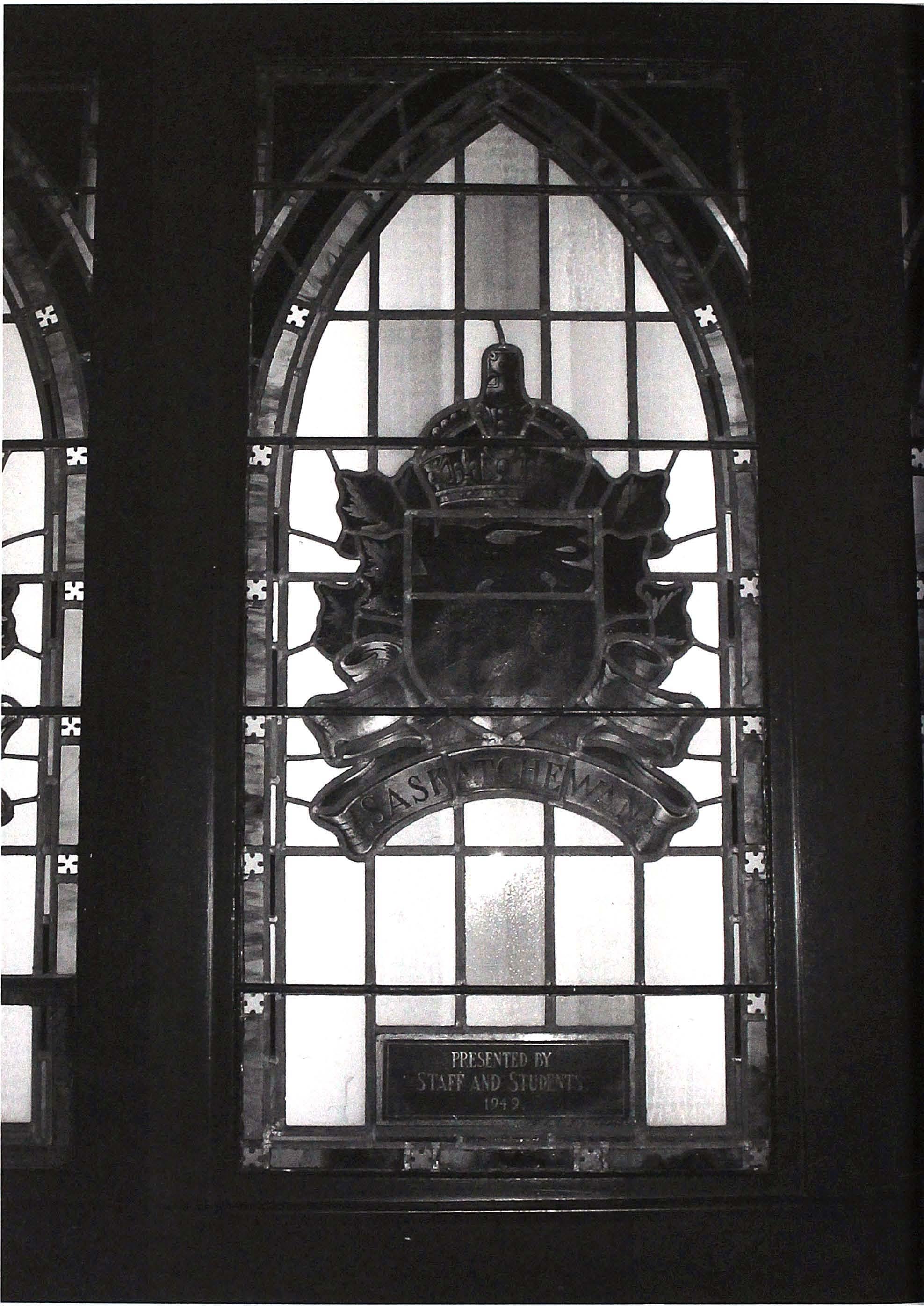

I RIGHT
The Saskatchewan Window presented by the staff and students of 1949.
FINANCIAL MATTERS
During the early years of the war the school suffered a considerable loss of revenue, a consequence of a declining enrollment and fees forfeited when students moved to England with their families. Douglas Harker summed up the situation:
It was a struggle to survive. No bonuses or salary increases could be given. The payment ofdividends to the shareholders was deferred. However, school governor A.E.JohnnyJukes generouslyreturned to the company his capital of1O preference shares and 220 common shares. By 1943John was able to report to the board that the school was once againfilled to capacity, the balance sheet once more in the black, as the perception grew that it was only a matter oftime before a Second Front would be opened in Europe.
Even during the lean war years, John Harker gave places to a number of evacuees in straightened circumstances and put them under no obligation to pay fees. It was some time after the war that he received a large cheque from the parent of one evacuee. This man approached parents who had enjoyed a wartime

fee dispensation, collected the fees, and wrote one cheque on their behalf.



As wartime hardships became memories and the decade continued, the board decided to wind up the company started by Danby-Hunter in 1931, with a view to creating a non-profit benevolent society. The difficult legal implications were skillfully managed by governor Austin Taylor. Thanks to the generosity of all the shareholders, who agreed to surrender their shares without compensation, the new School Society officially came into being in 1948, just in time for the expansive 1950s.
I LEFTThe school is officially registered under the Societies Act.
I
"SO<!lI8TlllS
c:r;."
Qrtrtifitttlr uf 3Jmnrpnrattnn
J 11l'f.bymllfg.w ..st. 0B0R0I•8BCBOOL'-�---'---------Brit'"ColvMbw.. �-Ul ,, A� .... ......,,.,,
49
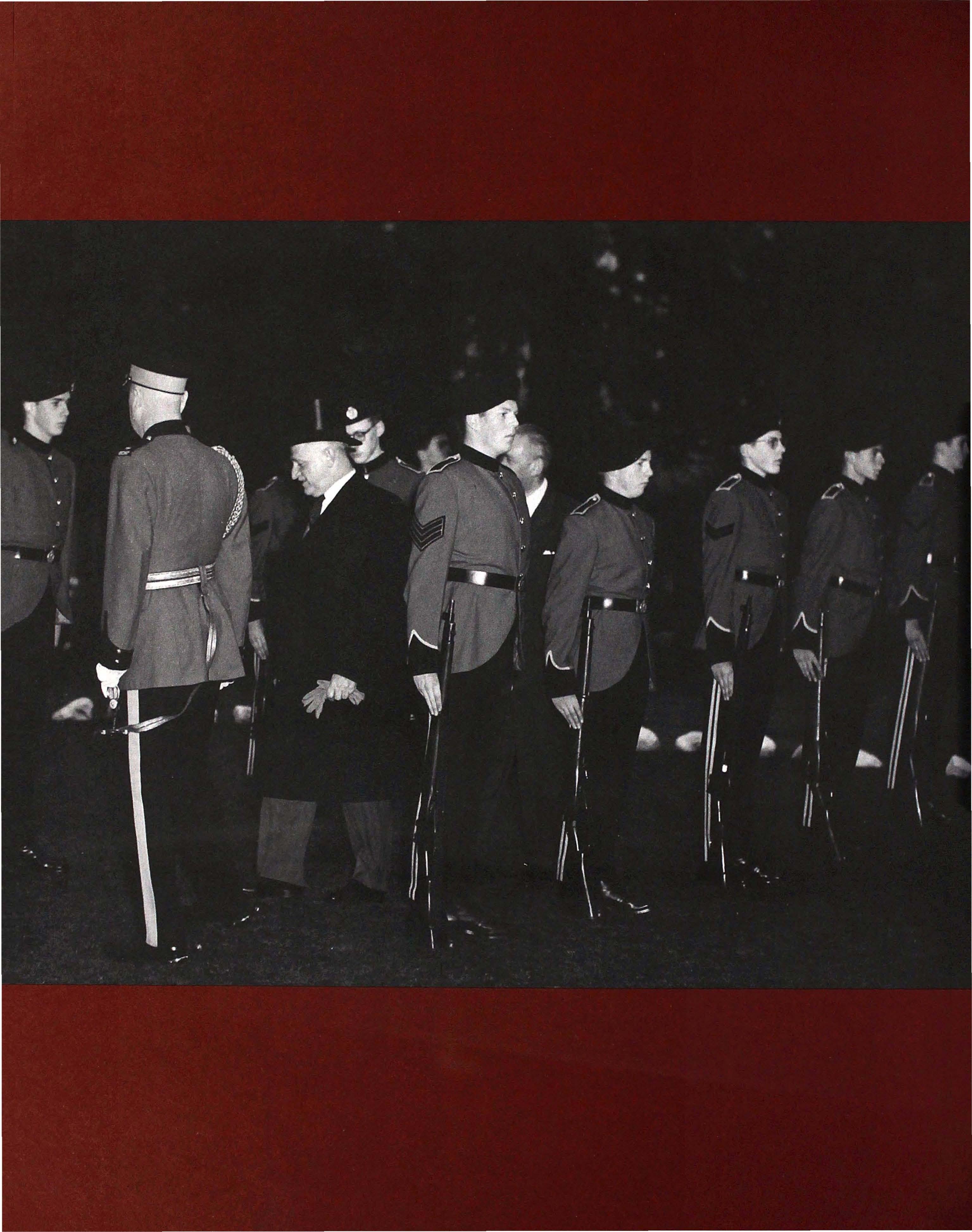
1950-1959
The 1950S: Expansion, Enter the Ladies, Rugger Tours, and Dogs
1950 School Auxiliary formedMrs. W.G. Stephens elected first president

1952 Hilary and Tensing climb Mount Everest
1953 Coronation of Elizabeth I1
Auxiliary registered as a society The first St. George's Country Fair
1954 May, Roger Bannister breaks the four-minute mile August, Bannister and John Landy run the "miracle mile" at the Empire and Commonwealth Games, Vancouver
1955 RCSCC Dragon formed under Edmund Colchester
1956 Rugby tour to Australia October, Hungarian Uprising in Budapest
1957 Sputnik 11 launched
1958 1959
BC's Centennial Year
New Classroom Block dedicated by Sir Denis Truscott, Lord Mayor of London UK rugby tour by a BC independent schools team
New Classroom Block opened by Dr. Norman McKenzie Retirement of Cappie Robinson announced
An honour guard is inspected in 1954 by the Honourable Clarence Wallace, Li utenant-Governor of BC.
I


52
3Expansion, Enter the Ladies, Rugger Tours, and Dogs

THE 1950S WERE MARKED BY THE BLOODY REPRESSION of the Hungarian Uprising in Budapest and a worsening Cold War. With the successful launch of Sputnik 11 there was a scramble in the West to rethink the education of scientists and engineers in an effort to keep up with the Soviet steamroller. Happily, we were distracted from the Cold War by Roger Bannister's sub-four-minute mile in 1954, followed by the drama of the "miracle mile," featuring Bannister and John Landy, in Vancouver's very own Empire Stadium.
Meanwhile, at St. Ceorge's a growing reputation for success in the classroom and.on the sports field meant the school had a waiting list of deserving students but nowhere to place them. In a comment about enrollment in the early 1950S, John Harker confidently asserted that "with over 70 new boys and a waiting list, we are up on balance, and start with what may well be the best school we have ever had, certainly the largest." In consequence, the decade was spent searching for new living space. There were two strong but elusive options: the school could develop the current site with permission from the city or develop Topside with the agreement of the provincial government.
In mid-decade the ever-optimistic Harker bought two more acres to add to those already owned on Topside and continued to wait patiently for permission to build the Senior School of his dreams on this land, cleared and seeded by the industrious and generous Cordon Horie. He stopped waiting when the city agreed in 1957 to the alternative: the development of a substantial new building on the old school site. Harker jumped at the opportunity and had the essential preparatory work done with funds generated four years earlier when permission to build had seemed imminent.
The project received its official blessing from Sir Denis Truscott, Lord Mayor of London. In 1957 John Harker had met Sir Denis at a reception in
53
IGeoffrey Stancombe (left] and Chris Palfreyman (right] take a break between classes.
The Board 01 GovemOJS and the Headmaster of

London for an Independent Schools Rugby Team with 10 representatives from St. George's. The two men discovered that they had much in common, both having graduated from Rugby School. So when Sir 6enis visited Vancouver for the British Columbia centennial year celebrations in August 1958, he also unveiled the cornerstone of the new St. George's School.
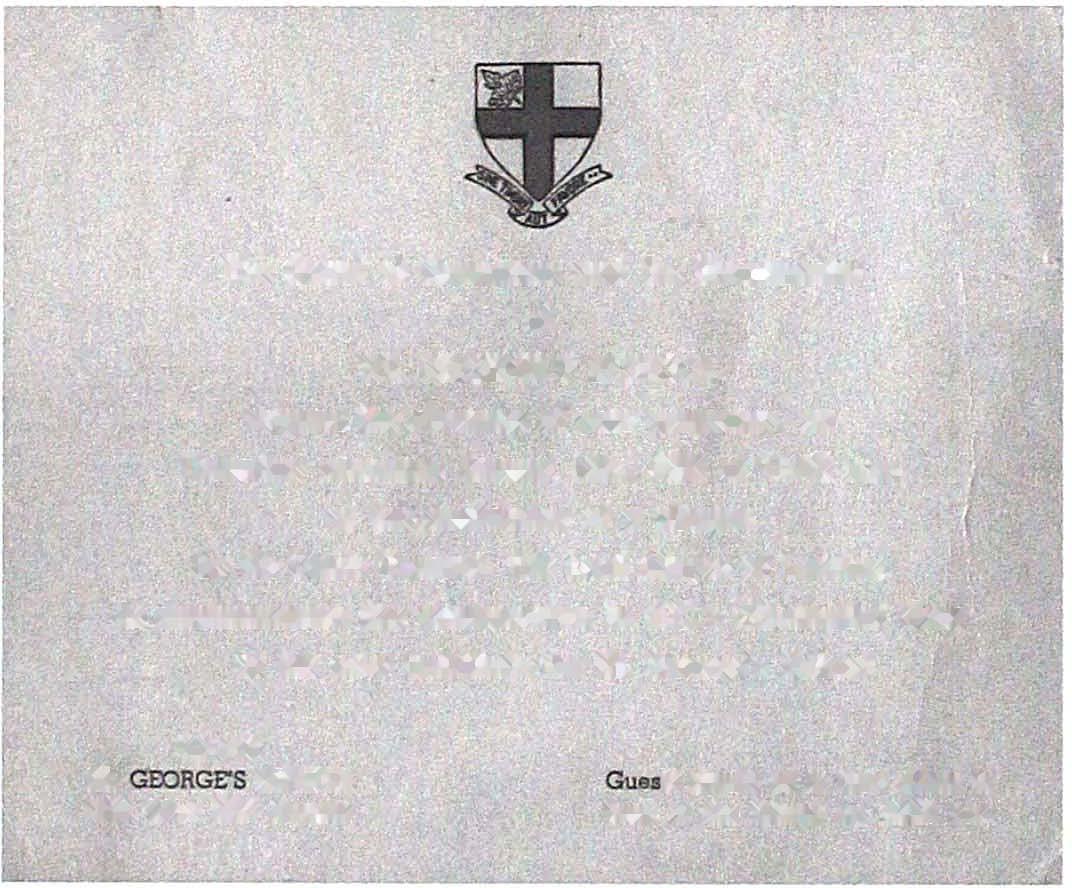
With his characteristic self-deprecating sense of humour, John Harker apologized that insufficient funds had been raised to stage the ceremony in the actual foundations of the new building, and therefore the stone and plaque would have to rest in his office in the

1a .hould be In their plaoeo In front of the School by 10,40 a.m. interim. Despite the absence of the student body, away on vacation at the time, a sizable and enthusiastic crowd representing

sections of the community attended the ceremony.
Four months later, in a flurry of early January snow, a large crowd of boys muffled themselves against the weather and watched with unconcealed delight as Cappie Robinson, Nip Parker, and John Harker turned over the first sod to start the new venture. In the crowd behind them stood a youthful Tony Parker-Jervis, on staff since 1956, a witness for the 24 boys who had bravely committed themselves to that first St. George's class almost exactly 28 years earlier.
Nine months later the "New Classroom Block," as it was officially called, was declared open by the president of UBC, Dr. Norman McKenzie. Purpose-built with no frills, the building was never going to win awards for elegance and beauty. The boys quickly dubbed it the "Cell Block," a name that stuck until its eventual demolition in 1980. Nevertheless, it was with considerable relief that
ST. GEORGE'S SCHOO� request the pleasure of your company on Thursday morning, August 14th., 1958 at 10:45 a.m. at the dedication of a plaque
by Sir Denls Truscott. The Lord Mayor of London. to commemorate the Inauquration in B.C:s Centennlal Year of the new buildings for SI. Georqe's School
as.V.P. sr. GmRGE'S SCHOOL 3954 Weet 29th Avenue 54
all
the administration took over its 11 classrooms. These quickly became a home for all the senior boys and their teachers, and a Senior School effectively came into being. The top floor provided dormitory accommodation for the boarders, releasing valuable space in the old building for the ever-expanding Junior School population.
FACING PAGE, ABOVE
Sir Denis Truscott. Mr. John Harker. and Mayor Hume of Vancouver survey the foundation stone. The plaque reads: This Block was dedicated by Sir oenis Truscott. the Lord Mayor of London. on the Fourteenth Day of August. Nineteen Hundred and Fifty-Eight. and commemorates the inauguration of the new buildings for St. George:S School.

FACING PAGE, BELOW

Invitation to the dedication ceremony.
BELOW
Cappie Robinson breaks the first sod. watched by Nip Parker. John Harker. and Tony Parker-Jervis.
55
A POWER BASE EMERGES

The growth of St. Ceorge's was undoubtedly aided by the formation of the School Auxiliary in 1950. This organization of mothers dedicated to the service of the school chose Mrs.W.C. Stephens as its first president.Membership was soon extended to include mothers of past students and the wives of Old Boys.

A year later, John Harker, always anxious that he may have played midwife at the birth of a monster, breathed an almost audible sigh of relief: "The Auxiliary ... [is] proving itself as good as its word, and being non-critical and non-interfering, and faithfully living up to the original conception of its purpose which was to be [of] service and assistance to the school."
In 1953 the Auxiliary organized its first Country Fair under the convenorship of Mrs. Russell Palfreyman. It was agreed by all that the event was "quite one of the most successful affairs ever":
In addition to a giant raffle, with some splendid prizes, there was a vast number of stalls selling needlework, arts and crafts, silks and satins, home-cooking, superjluities, and a great variety ofjlowers and garden plants. There were also games of
I The new building-definitely an example of function over form. 56
chance, a conjurer, who put on three perfonnances during the afternoon, and pony rides on the School Field and a free tea for everyone.
It was at this latter that Mrs. Campbell, the School Housekeeper, appeared, appropriately disguised as thegypsy Calypso, and told fortunes behind a screen in the dining room, for the good ofthe cause. Unfortunately, a lack of liaison between thegypsy and the ladies of the Tea Room failed to disclose thefoct that she proposed to read the future from the teacups, and that tea leaves, therefore, were a sine qua non. Not unnaturally, she was somewhat daunted to discover on the point ofcontact, as it were, that tea bags had been used and that she, consequently, would have to operatefrom a very clear cup. Lady Pourers were hastily summoned to redress this wrong by pouring neat tea leaves for Calypso's would-be clients, but alas they were too little and it was too late.
The Country Fair was soon well established, with local newspaper coverage no doubt contributing to the event's popularity (see Province article on this page). It was not long before a steady stream of gifts financed from the profits of the Country Fair would fill library bookshelves to overflowing, ironically helping to fuel demand for a bigger library! In 1954 the sanatorium received the gift of a fridge and linoleum; the chapel received a blue carpet and gothic lights; and the boarders' common room was awarded a much-disputed TV:
This last gift we were at first inclined to regard with some reservation but now we have all grown used to it, we agree we have never had anything more welcome or more useful. For the harassed evening duty master, for the wet weekend afternoons, and for the other numerous occasions when there are afew odd boys with no place to go, we warmly recommend television under control, as the solution to many former disciplinary problems-and the relief of boredom. we are grateful indeed' the ladies, Cod bless them.
As the decade advanced the generosity of the Auxiliary was extended to include every facet of the school's operation. Gifts of the incontrovertibly mundane variety included an engine for the school bus, 50 new classroom desks, a mower and, for the kitchen, a vegetable slicer. These contributions were much appreciated.
COME TO THE FAIR"THEME OF ST. GEORGE'S EVENT
The gaiety and colour of a counlry fair appeals to all ages and with thiS In mind the AUXiliary to St. George's School IS planning ItS second country fair theme Wife of the Lieutenant-Governor of BC. Mrs Clarence Wallace whose sons are "old boys" of St. George s school Will open the event. Mrs Russell Palfreyman IS busy With arrangements as general convener With Mrs. Ralph Brown as her assistant. The school colours of red. black and white will lend an attractive decor to the booths For the second year Mrs. w.G Stephens. President of the AUXiliary. IS looking after the raffle ticket sales. In the spring plants are always popular and Mrs lo. Coldlcutt IS gathering a good selection for sale Home cooking IS being convened by Mrs W H oeCew. while delicacies With a foreign flavour Will again be the charge of Mrs CV Corbet and Mrs F.B Stanford Mrs C B K Van Norman Will have "treasures" for sale at her booth. and Alan Brown Will be In charge of the book stall.
The young fry Will be able to enJoy horseback riding under the supervision of Mrs Llonel Kent and her family. and a fish pond and games Will be run by Mr Perrott Mrs E. Colchester IS arranging movie cartoons and there Will be a candy booth, With Mrs. O B Ammundson In charge. The babyslttlng department Will be under the superviSion of MISS Sherry Grauer while Mrs. Montague Caple Will be In charge of the tearoom Wives of the board of governors inVited to preSide at the tea tables Include Mrs. Godrey P Gower and Mrs Victor Whlttall

-ProVince, April 5, 1954


57
FACING PAGE

David Abbott leads the Dragon corps band along 29th Avenue. circa 1959.

BELOW
Cadets of RCSCC Dragon prepare for inspection.
BOYS IN UNIFORM
By the 1950S most of the boys enrolled in the various service organizations affiliated with the school had been born after the war. Nevertheless, large numbers of students were members of ''1\.' squadron of the BC regimental Cadet corps, the Seaforth Highlanders, the Fogarty and Fegan Cub packs, and the 34th Vancouver Scout troop. Until September 1955, students interested in Sea Cadets joined RCSCC Captain Vancouver. After September of that year they had the option of joining the school's own Sea Cadet corps, RCSCC Dragon, under the enthusiastic leadership of Edmund Colchester. A taste of their activities is provided in the program for the first annual inspection of the corps in 1956 (see page 59).
58
A glimpse into the private world of our Cadets on parade is also provided by Derek Simpkins ('64) and Geoffrey Stancombe (,62), Old Boys who look back on their seafaring pasts with fondness.
Every Wednesday evening thegymnasium at the oldschool became "our ship" and we would practise our drill up and down West 29thAvenue toDunbar. We marched withLeeEnfield. 303 rifles, accompanied by a bugler and sometimes a drummer. What a sight we must have been with our fixed bayonets, unifonns, and gleaming boots. Little did the neighbours then know that the Colchesters' garage was infact our armoury, stuffid with rifles and ammunition. One can only imagine this group marchingthroughtheDunbarneighbourhoodtoday. It would surely bring out the SU'llT team.
-DEREK SIMPKINS
Parents, masters, students, and evenNaval Officers fromHMCS Discovery in StanleyPark wouldassemble to watch the Cadets infull uniform go through marching drills,formations, and inspections. However, the true highlight was the demonstration ofthe cadets' prowess with semaphore and signalflags. From a masthead, erected on the balcony overlooking the parade ground, various strings of signal flags would be hoisted up and then quickly removed, to which Cadets, wearing step-in cardboard boats, supported from their shoulders with straps, wouldrespond. The little flotillawould move up, down, and acrossthe playground in the designated formations, signalling their understanding of the commands with semaphore flags.
-GEOFFREY STANCOMBE
AN INSPECTION OF RCSCC DRAGON,1956 Programmme Division and Colours Prayers

Arrival of Inspecting Party
General salute
Inspection of Guard and Ship's Company March past Evolutions
1, Signals: a message will be supplied by the Inspecting Officer which will be transmitted by four stations by Morse and semaphore.

2, First Aid: A casualty will be attended to by the First Aid Party. placed in a Robinson Stretcher and hoisted by Sheer Legs
3, Rigging a Sailing Dinghy This dinghy recently built by the C,O, and Ship's Company for sailing instruction,
4, Rigging Sheer Legs: These are a kind of temporary derrick or crane, The casualty will be hoisted by them when they have been rigged
Ship's Company to muster for Evening Quarters
Presentation of Corps Charter by R.J Blcknell. PreSident. BC Mainland DIvision, Navy League of Canada Sunset
59
ABOVE,LEFT

Cardboard convoy responds to signals from the masthead.
ABOVE,RIGHT Trafalgar Day Program. October 21.1950.
Stancombe's amazing story of the cardboard convoy has been confirmed thanks to some super-8 movie footage provided by Richard Boyce-Sargent ('62).
Throughout the 1950S the school "remained heavily committed to all of these organizations, providing leaders from its own staff and parents, filing annual reports on their activities in the pages of the Georgian, and hosting parades and chapel services in full uniform on historic days in the calendar such as Remembrance Day and Trafalgar Day.

The school in this era also proudly celebrated its connection with Britain, which for many staff and students was still regarded with affection as the Mother Country. A handsome poster produced for Trafalgar Day in 1950 gives some idea of the importance of these occasions to the St George's community. A letter to Sir Winston Churchill on the occasion of his birthday in 1954 further conveys a sense of the connection between the school and England and shows that memories of the dark days of the war had not yet faded:
Honoured Sir,
Ui' thought you might care to know that the masters and boys ofthis independent school some two hundred andfifty strong met this morning in our chapel to prayfor you and to bless you on your birthday. At this service extractsfrom your speeches, to which we had listenedfourteen years ago, were read again and we
I
60 JlllllmnJrr...... TRAFALGAR DAY "MAYnil!GRJ!ATGOD. WHOM,IWQIISI:IIP.OIU\NTTO MYCOUNTRY,��Tf!EllI!NI!PITOPrullOPl!IN.G!!NJ!I{AL, ACRBATAND'GLOIUOI!JSVlCTORY;fiNI)MAYNOMISOON· DUCTINAN�T.·.RlnSli.rr;JlNDMAYB:I.JMi'iNITYAfl1!II. VlCJOIlYB :oil!PREDOMINANTPl!ATI.IBl!INnil!lII.lITISH l'IJ!ET' PORM'iiiI!ll'.INDNIDUAlLY,ICOMMIT.MYL.lJ1I!ID tnMIl!HOMADE�'ANDMAYHISII\JlS5INGL¥11;1T1..IPC!NJ.Mt 1!NDEAVOURSFI!)RSl!lW�G'MY�Y fAll'HFlJllY_"'TQ HIM I RESIGNMYSI!E' hliD THI!JUSTCAUSEWHICtf 15 ENTRusTED ME;TQ.J:!!!FEND. A>wo.A>wo.ha•.
IABOVE

The assembled Mighty Atoms in all their glory. with Miss Spencer on the far left and Mrs. Hall on the far right.
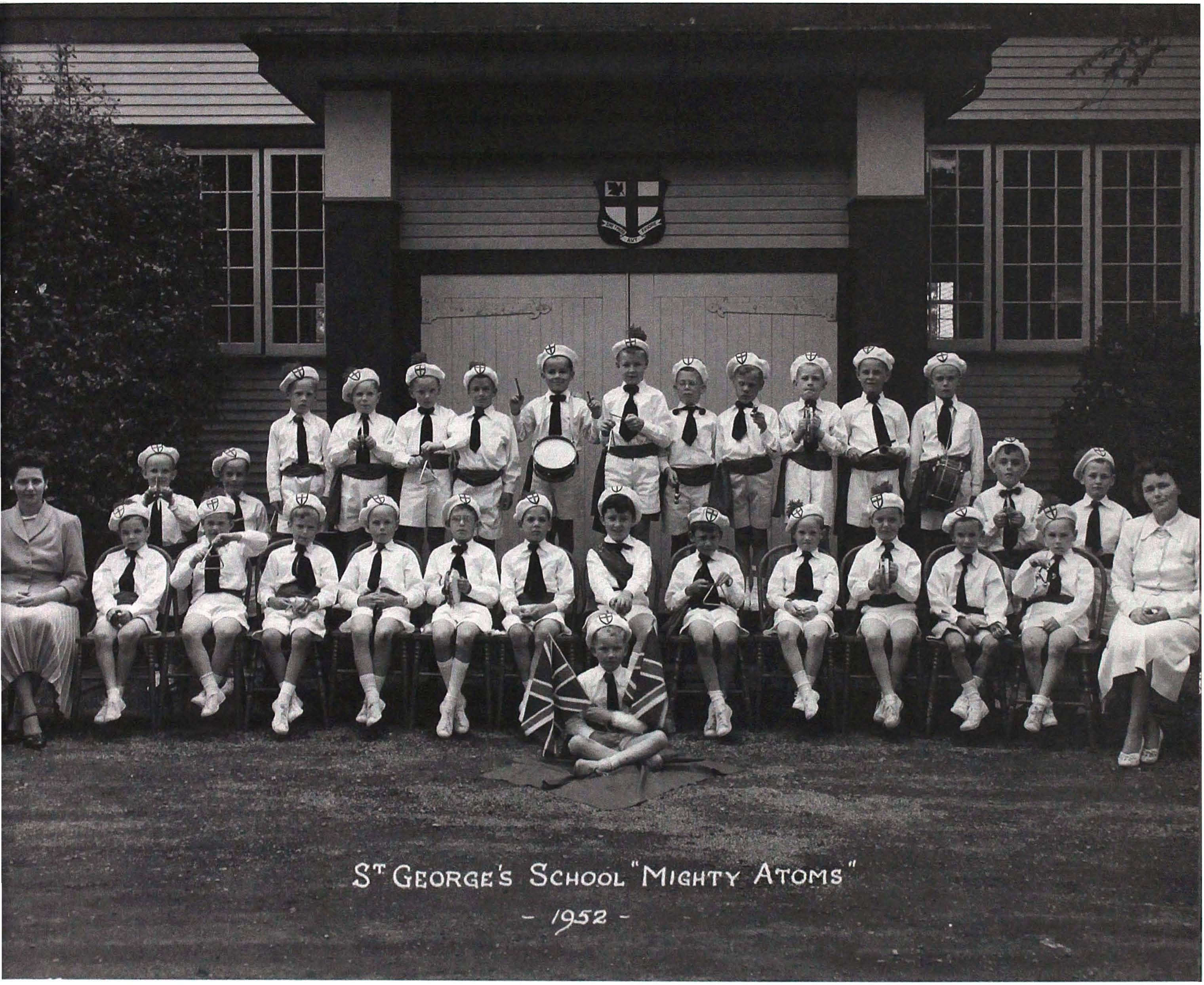
61
rememberedwiththankfulnessyourinspiringleadershipinthecauseoffreedom andyournoble contributiontothe betterment ofmankind.

Sir Winston replied, saying that he was "deeply touched by the kind thoughts and prayers of the masters and boys of St. George's School on my birthday."
BOYS IN GREASEPAINT
Along with the service activities, theatricals of a homespun variety continued to provide enjoyment throughout the 1950S. Both junior and senior boys, and sometimes staff, joined in to present eclectic evenings of entertainment, much of which was written by the staff. These performances were the beginning of a grand Junior School tradition. A description of the St. George's Cavalcade of 1952 gives some idea of what was on offer:
TheRhythmandSongprovidedbyMrs.Hall'sMightyAtomsofgrades 1 and 2, in verysmartwhiteunifonns, Gratsos 2 conducting, gotusofftoaverygoodstart, andthepacethereafterneverslackened. 'Jim,"from The Cautionary Tales of HilaireBelloc, inwhichMalkin, asnarrator, qualifiedfortheearlyconsiderationof theHollywoodtalentscouts, and "Wi:LltzingMatilda, JJ anAustralianfantasy, in whichCroilwasrevealedasadevastatingghost, werefollowedbythelargestand bestchoirweeverhad, trainedandproducedbyMrs. Whitcutt andMr.jenkins.As anamusingfinale, "TheCake, JJ aplaywrittenandproducedbyMr.Pringle,forand atSt. George'ssome 15 yearsago, wasadaptedtopresentdayneedsandcircumstances, andperfonnedbyjunior, Intennediate, andSeniorBoarders, andthe Masters, withconsiderablesuccess.

It was with a performance of Murder inthe Cathedral, under the direction of Jon Wheatley in 1959, that the Senior School returned to serious theatre, reminiscent of the days when St.joan, under the direction of Headmaster Danby-Hunter, would commandeer the resources of the whole school for days on end.
MurderintheCathedral was staged in the chapel, appropriately, and featured one of the school's Hungarian refugees, Nick Basovsky, as Henry. Nick had spoken no English at all when he had joined the school only a year previously but managed to give a gritty and memorable performance in his adopted language.
THE RUGBY TRADITION CONTINUES
In the 1950S the school offered a wide variety of sports, but the premier athletic event remained rugby. In the 1952-53 season the Ferrie Cup became the focus of competition between Saints and Shawnigan Lake School. It complemented the long-standing competition for the Harker-Privett Trophy, instituted earlier for contests between Saints and University School. Sadly, neither of these trophies is presented any more, even though competition between the three schools remains as fierce as ever.
Over the two seasons from 1953 to 1955, the first XV maintained an almost unbeaten record. The 1954-55 season featured three pairs of brothers, the Tynans, the Youngs, and the Chambers, and became known subsequently as the "Year of the Brothers."



On the strength of the good open rugby played by these teams, two parents (and board members), Russell Palfreyman and Lionel Kent, arranged for a tour of Australia during the summer of 1956, even though their rugby-playing sons were too young to qualify for the team. Because the expedition was to take place during summer vacation, the team could be made up of both current students and recently graduated Old Boys. This was the first team of Canadian schoolboy rugby football players ever to tour Australia. With great generosity, the Australian Rugby Union paid for the team's board, lodging, and much of its travel.
From lefl 10 right: Nip Parker, Peter Tynan, John Tynan, Gordon Chambers, Michael Chambers, Thor Young, Einar Young, John Harker.
The rugby-playing Tynan. Young. and Chambers brothers.
In celebration of the tour, Russell Palfreyman wrote an I8-verse piece of doggerel (it certainly would not qualify as poetry) called "St. George's Southern Cross." Two verses celebrate the team's arrival in Australia:
There the welcome was terrific, on the shores ofthePacific, with the Cameras, Press andRadio all clustered round the Team.
All our hosts were there to greet us, pumping hands and glad to meet us; U-0 knew that day, that come what may, our tour would gofull steam.
Sure to you it may soundfunny, but we couldn't spend our money,for Our Union hosts paid everything; it all was "on theHouse. "

And the souvenirs they gave us!Embarrassed? Why, Lord save us, we LeftAustraliafeeling we were next thing to a louse.
An ancient bus was provided to transport the team between the widely spaced cities of the eastern seaboard, and the driver, Bert Mills, qUickly won the affection of all: "In spite of some peculiar rumblings, evil smells, and sundry smoke-belching, the old bus brought us safely to every destination under Bert's expert gUidance and caught the attention of the local populace with an exploSive snort as we made an occasional halt enroute for the pause that refreshes."
Within the host cities, the team travelled more comfortably in a fleet of Fords or Australian HoIdens, provided through the generosity of the future board chairman, Clarke Simpkins, whose son Michael was a member of the squad. It was in a Holden that our illustrious headmaster almost came to grief:
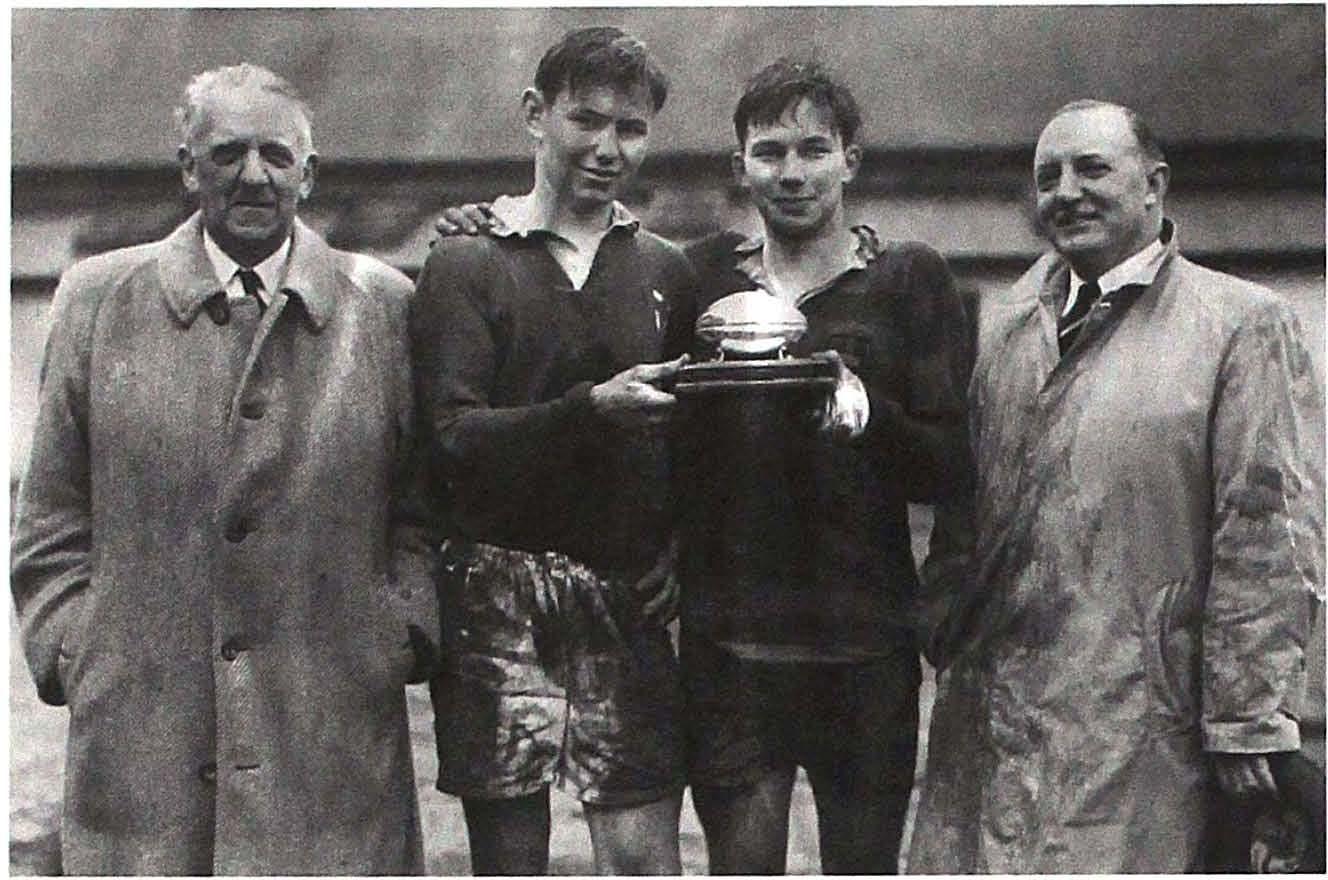
AHolden was the first left-hand car J met with on my travels; its owner was taking me to my billet after our initial reception and it was when he suddenly swung to the left to avoid an oncoming lorry that Jforgot the rules ofthe road (and polite society) and attempted to swing the car back to the right, bygrasping the steering wheel.
Luckilyfor us both, my driver was one ofthe local strong men who had playedfor the Wallabies, and my effort passed him by; so did the lorry.

I
ABOVE Presentation of the HarkerPrivett Trophy in 1957.
IBELOW



"Seldom has it been our good fortune to meet a finer body of sportsmen."


66
The team played six games in New South Wales and Queensland, losing four, drawing one, and winning one. It was not an impressive record and excuses were offered:
Six of our boys were injured, so we hadn't enough reserves; official receptions, dances, and travel by bus are not the best meansfor keepingfit on a rugger tour; we came from the soft mid-summer Canadian season to play rugger, after a week's practice on some very hard grounds, against some very fit blokes. There is one fundamental reason: the teams we played, selected, literally from hundreds ofboys, were too goodfor us in every department.
Russell Palfreyman took a humorous view of the team's losses in this noteworthy verse:


The rugger that we showed them, I'd like to say it throwed them, but I must confess they played too well-we'd met our waterloo! Stillit really didn't matter,for they liked our this and thatter, The games were good, and played with fun, as Sportsmen oughter do.
Despite the playing record, it was a very successful tour. The team members were wonderful ambassadors for their school, province, and country. In an editorial in the New South Wales Rugby News, the St. George's team received high praise: "Seldom has it been our good fortune to meet a finer body of sportsmen, using that word in its highest sense. They have been co-operative, friendly, interested and worthy upholders of the great traditions of our game, both on and off the field."
This first international tour in the history of the school began a tradition that continues to flourish today in sports other than rugby and in many other disciplines, including music, the arts, and the sciences.
With much fanfare and good spirits a reunion was staged in 2004 at the home of retired headmaster Alan Brown. It was an event during which the great plays of the six games were remembered, re-enacted, and celebrated, most probably with good Australian wine, something not available in 1956. Alan in particular would remember the try he scored against Queensland Agricultural College. It may well have been, as some wags would have it, the only try of his rugby career; it was certainly the only
Players from the 1956 rugby tour of Australia at their recent reunion.
First row {left to right}: Phil Ramage, Mike Simpkins, Peter Tynan, Barrie Stubbs, George Hay, Derek Hopkins
Second row (left to right): Alan Brown, Richard Freer, Horace Harrison, Ken Mitchell. Malcolm Turnbull, Gordon Thorlaksson.
score made by the team that day, in which they went down, 29 to 3. It should be noted for the record, though, that two members of that first touring team, Barrie Stubbs and Mike Chambers, went on to play for Canada.
After the success of the Australian tour, St. George's jOined forces with Shawnigan Lake School and University School to send a combined touring side to the UK in 1958. They played against teams from Harrow, Eton, Epsom College, and three representative Scottish sides, drawn from a number of different schools. The BC XV had a tough time of it, though it must be said in their favour that they were up against some of the best sides in England and Scotland. They lost all but the last game against Eton, which they won 19 to 11.

Rugby was not the only sport at St. George's, of course. After the war rowing was resurrected and continued through the 1950S with a small group of devotees. Skip McCarthy, always a great mover and shaker, succeeded in getting a four together for the Kelowna regatta in 1951. He fell sick before the great day but successfully badgered his coaches and parents to fly him to Kelowna so he could take his place in the crew. His junior four became champions after beating Kelowna and Penticton rowing club crews. McCarthy's sickness proved to be a mild form of polio from which he recovered to be an outstanding school captain in the following year. He continued his association with the school for many years as a teacher, a rugby coach, a rowing coach, and ultimately as a much respected rugby referee.
FAREWELLS
Muriel Royston, matron from 1932 to 1955, was the first of the original support staff to announce her retirement. At that time she was commended for running a department that "prospered under her wise direction. Her quick eye, which can immediately identify a lost towel, her excellent sense of humour, which can perceive a joke, even on herself, and her kind heart, which can recognize a lonely boy, have established the Matron's room as a popular place with the staff as well as the boys."

68
Another long-serving member of the support staff was Violet Arnott. She j Oined the school in 1934 and retired in 1959 after serving as school secretary and, throughout the war years, as bursar. She was commended for having "feared neither master nor boy" in her career. "Her extraordinary energy, her remarkable memory and attention to detail have meant efficiency in the office upon which we have all relied. In fact, 'Ask Mrs. A.,' has been a kind of sub-title on all school topics ... We will all remember this small, indomitable lady, with her love for adventure, of travel, and her sturdy independence, and zest for life as carried on at St. George's."
The "Old Contemptibles," 1959.

First row {left 10 righll Violet Arnott IsecretaryJ. Nip Parker, John Harker, Muriel Royston Imatronl.

Second row {left 10 rightl: Peter McDonnelllbursarJ. Cappie Robinson, Axel Mortensen IJanitor and engineerl.

But the biggest shock to the school was the announcement of the "partial retirement" of Cappie Robinson in 1959. Indestructible in the trenches of World War I, he returned to Canada to become a member of Captain Danby-Hunter's staff in 1931. A man of huge determination and love for the school, he continued on as a part-timer into the 1960s.
Although only three of the seven "Old Contemptibles" would retire in the 1950S, the rest were soon to follow in the next decade. The exception was Peter McDonnell, who continued to serve as school bursar until well into the 1970s. By 1959 these seven people had contributed 170 years of service to the school.
CANINE CHARACTERS



No account of St. George's would be complete without some reference to the many school dogs. In 1953 one of the quintessential canine characters said his goodbyes before passing on to his doggy reward. He was the gallant old "Colonel," a spaniel who was eulogized by John Harker as follows:
A senior member ofthe masters' common room for years, he attended, right to the end, occasionaljunctions, most parades, and all meals, and now at last, at the ripe old age offourteen plus, he has gone on to the happy hunting ground. Though latterly no ladies man, Colonel stood for the good things oflife, for he had loyalty and courage and common sense, and he could also see ajoke. � cherish happy memories ofhim, and we shall miss the Colonel at St. George's.
Colonel was only one of many dogs to patrol the school campus. John Harker was an inveterate dog-lover and assumed that everyone shared his devotion. Thus the animals had free rein of the halls, assemblies, parades, and playing fields. Many a lonely boy found a sympathetic friend in one of the school dogs.

I
The "Beak" and Shaughnessy mull over the finer points of the game from the sidelines,
70
This devotion to dogs extended to establishing a cemetery on campus to ensure that the "dear departed" would not be forgotten. And according to an article in the Province, the boys of St. George's were more than willing to help less fortunate animals in the greater world beyond the walls of the school: "About 100 boys from St.George's Boys' School are aiding the SPCA drive for funds to build the proposed new shelter. The boys will wear SPCA arm bands and carry Shelter Fund drive pamphlets. The proposed shelter, estimated to cost $29,500, will provide housing for cats and dogs, [a] clinic and humane disposal centre."
It was in 1955 that John Harker was to meet the canine love of his life, Shaughnessy. Generations of students will remember the "Beak" sitting on his shooting stick on the touchline with the noble Shaughnessy at his side. John Harker fondly introduced his new friend to the world thus:

VVt.> should like to take this opportunity ofintroducing to your attention the new school dog, who has been named Shaughnessy (because he is so distinguished) ... Shaughnessy, in spite ofbeing very small and young and ofrather nondescript appearance, has been classified "School Pooch, 1st Class, " and has already enjoyed the unique distinction ofbeing awarded his rugger coloursfor being heeled out ofa scrum that he had inadvertently got into in an Old Boys' match. Though he is rather conceited about this incident, he seems otherwiselittle or no worsefor it, and continues to attend here as a day boy, having all his meals (and often the eat's as well), at the school.
But even with the support of his beloved Shaughnessy, John Harker was beginning to feel the weight of his school responsibilities; he had been at the helm for 25 years. It was during the tour of Australia that he complained of the cold at night and got up to take long walks to restore his circulation, and it was perhaps then that his thoughts first turned to retirement. In any event, it was early in the next decade that he announced his retirement and a new chapter in the life of the school began.
BACHEE PARKER-JERVIS DESCRIBES "A SUPERB PACK"
St. George's Dogs I Have Known
The eccentrics of St. G's are not confined to what we may call, though sometimes with not much confidence, its human population The school has always had a quota of dogs and some of them were odd
When John Harker came to the school he brought with him two big police dogs, Lobo and Sheba Sheba soon produced a fine and unusual litter-four pups, all dogs. She chose her own place of accouchement which was underneath what is now Axel's house The Head's younger son [Christopher Harkerl was sent in after her and handed out a miscellany of pups who later assumed identity as the famous PSoloman, PSmith, PSampson, and Dook. [The School paper boy got Dook and trained him into a magnificent specimen, but would not accept his fancy litter name, which was for all I know, PSitticus ) By gosh, Lobo and Sheba and the p's made a superb pack the pride of the School, the terror of strangers-we didn't have much of a rugger team then, and as for scholarshipwell! But we did have the finest mob of Alsatians in the country.
71
1960-1969
The 1960s: A New School for a New Headmaster
1961 April 17, Bay of Pigs landings in Cuba
1962 The Auxiliary organizes the first Dog Show
October 12, Hurricane Freda strikes
October, Cuban Missile Crisis 1963 1964 1965
December, John Harker retires
January, Douglas Harker assumes headship
November 22, President Kennedy assassinated
Permission granted to build on Topside

Simon Fraser University opens-students occupy administration buildings
Senior School on Topside officially openedby the HonourableClarenceWallace
January 21, Sir Winston Churchill dies
1966 UBC Math Contest-St. George's ranks first in province
Endowment fund started with a gift of $15,000 from Mrs. Garfield Smith
1967 Japan rugby tour 1968
Canada's Centennial Year
The Beatles release Sgt. Pepper's Lonely Hearts Club Band
Martin Luther King, Jr., and Robert Kennedy assassinated Pierre Elliot Trudeau elected prime minister of Canada
1969 July, moon landing-Neil Armstrong takes "one giant leap for mankind"
Swimming pool is built
Duke of Edinburgh visits St. George's

 I
The Senior School, 1965.
I
The Senior School, 1965.


74
,

A New School for a New Headmaster
WHILE THE DECADE'S MOST SIGNIFICANT EVENT was the building of the new Senior School on Topside, the end of Headmaster John Harker's 30-year reign was of almost equal importance. In quick succession some of the school's most colourful and enduring characters were to follow him into retirement. However, if the last of the First World War veterans would cease to have an influence on affairs, there were many Second World War veterans, including Douglas Harker, to put their stamp on the school's subsequent history.
John Harker's retirement was announced by the chairman of the board, Russell Palfreyman, in a "Memorandum to All Parents" on March 15, 1962:
As you have no doubt heard, theHeadmaster is retiring at his own request on December 31st ofthe current year. I amhappyto announce as his successor, his brother, Mr. DouglasHarker, a scholar of Cheltenham College, England, and a school master often years' experience.
While the termination ofMr.JohnHarker's long service to the School is much to be regretted, his brother is, in the opinion of myfellow Governors and myself, a most suitable successor. He was an assistant master at Port Regis, Broadstairs, England, and Vice Principal ofSt. George's from the year 1932 to 1939. He resigned this appointment on the outbreak ofwar, in which he served with the British ColumbiaRegiment (D.CO) with the rank ofMajor, was wounded and mentioned in dispatches. Mr. DouglasHarker is aged50 and a widower with three grown-up daughters. He will resign from his present position asEducationalDirector and PersonnelManager ofthe WoodwardDepartment Store organization, and will assume his new duties nextJanuary.
wefeel confident that under his guidance the School willretain, to the greatest possible extent, the spirit and character that have been engendered by the present Headmaster during his nearly 30 years ofleadership.
7S
IThe Harker brothers unveil the plaque to the John Harker Quadrangle.
ABOVE, LEFT
John and Naggers take a stroll in downtown Vancouver in the early 1950s.

ABOVE, RIGHT
Naggers and her son Chris. Despite her many commitments around the school, Naggers signed up for war work with the Red Cross in 1943. Chris remembers his mother's absence on Thursdays for many years afterwards as she visited the veterans at St. Vincent's, where she chatted and handed out free cigarettes. Chris also remembers being frightened almost to death on the first occasion that she donned her regulation-issue gasmask.
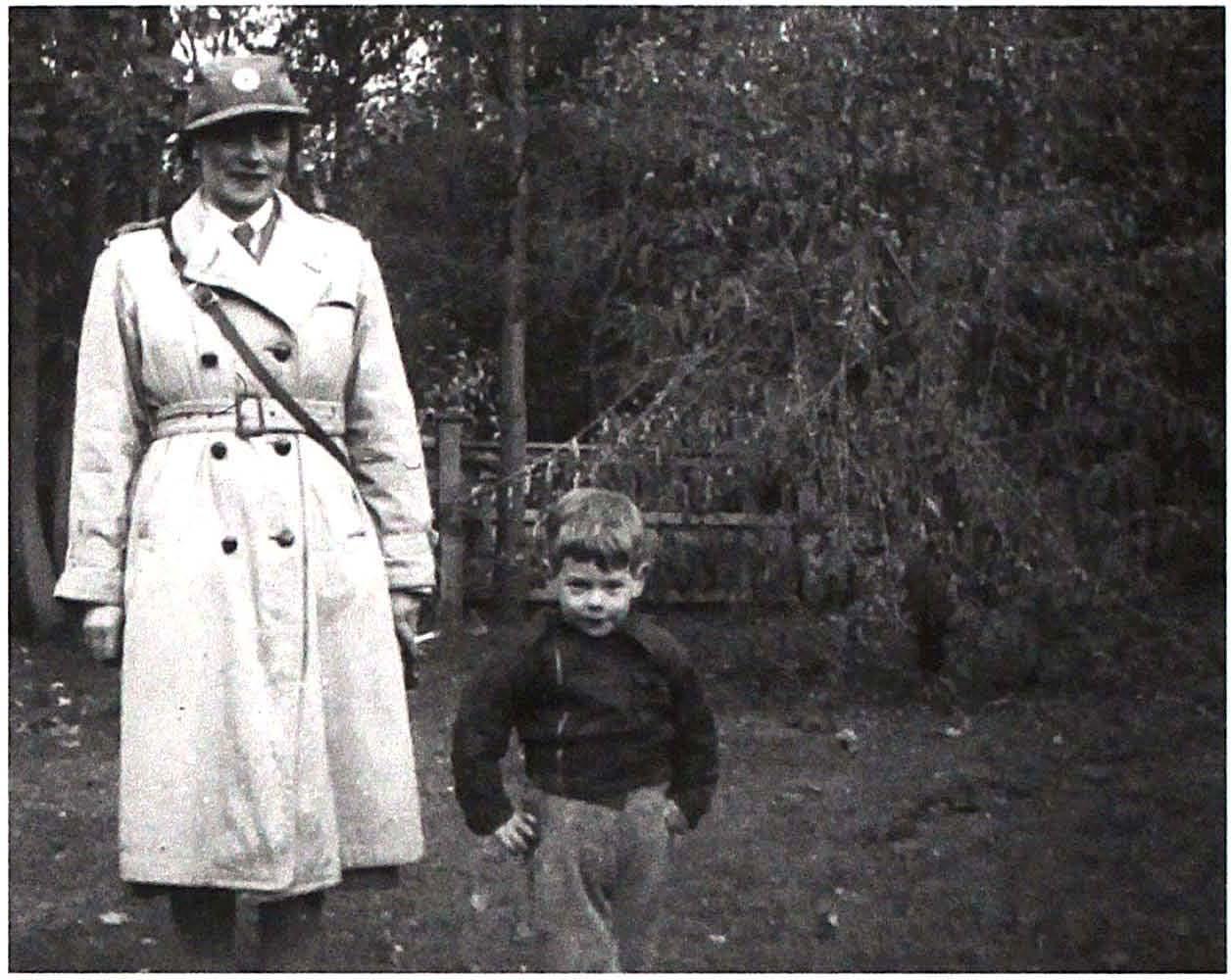
John Harker's immense contribution to the school cannot be easily measured, He is remembered by students, staff, friends, and board members for his great sense of humour, which always rescued him from the many situations he would
unintentionally create through an inveterate forgetfulness. His wife, Naggers, is remembered as well for "taking on duties whenever the necessity arose or substituting wherever she was needed-from Matron to Cub Mistress, from helping in the library to scoring for the Father and Sons Cricket Match, or producing and where necessary taking part in plays and concerts." Despite the demands of serving the school, the Harkers still managed to enjoy a happy family life (see page 77). The Honourable JV Clyne recalls "the gaiety of the Harker Household":
Besides}ohnny andNaggers, and the children, there were ofcourse the dogs: Smith and}ones, the two German shepherds, always slept solidly throughout our anxious financial meetings and later they were to bejoined byLobo and Shaughnessy. There were the evenings around thefireside when}ohnny would play his ukulele and sing from his large repertoire ofpopular songs, or keep us all spellbound with stories from his days in China and theFarEast, or as a cipher expert with the British Legation in Washington.
And while Clyne conjures an image of the family man at home, Archie Shafonsky ('53) depicts a more formidable headmaster at school:
It was during breakfost that announcements were read out. These would include directives to report to the head's office. Those poor individuals, hearing their names read out, knew what was in storefor them. Fear ofthe "Beak" was instilled into the


THE HARKER FAMILY

John and Naggers watched their family grow along with St. George's, as shown in these family photographs.
CLOCKWISE, FROM TOP Chris Harker sits in the sidecar of John's motor bike in 1943 Gas rationing had motivated the purchase, but ownership was short-lived, One day John was approaching the main gates of the school and he twisted the accelerator the wrong way, lost control of the machine, and crashed into the hedge. The force of the colli sion catapulted him over the hedge and landed him ignominiously at the feet of a group of boarders lined up for breakfast.

A newborn Chris Harker in 1940 John Harker was known to smoke 60 cigarettes a day at the time, although Chris hastens to say that hiS father never really Inhaled
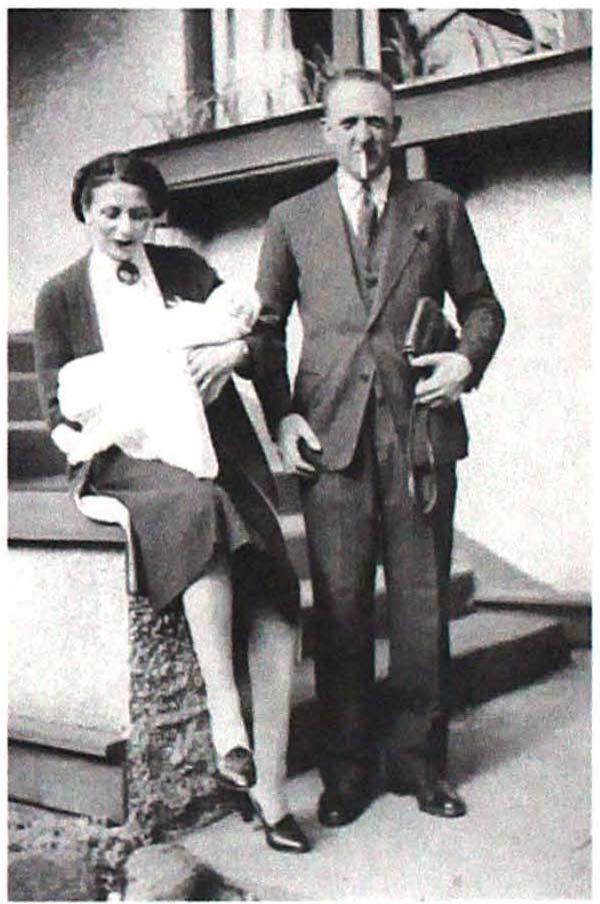
A Harker Christmas, 1969
First row Children of Tony PJ.
Second row (left to right!: Belly Parker-Jervls IBachee's Wife!' Naggers, Johnny, Doris Parker-Jervls ITony PJ's wlfel.
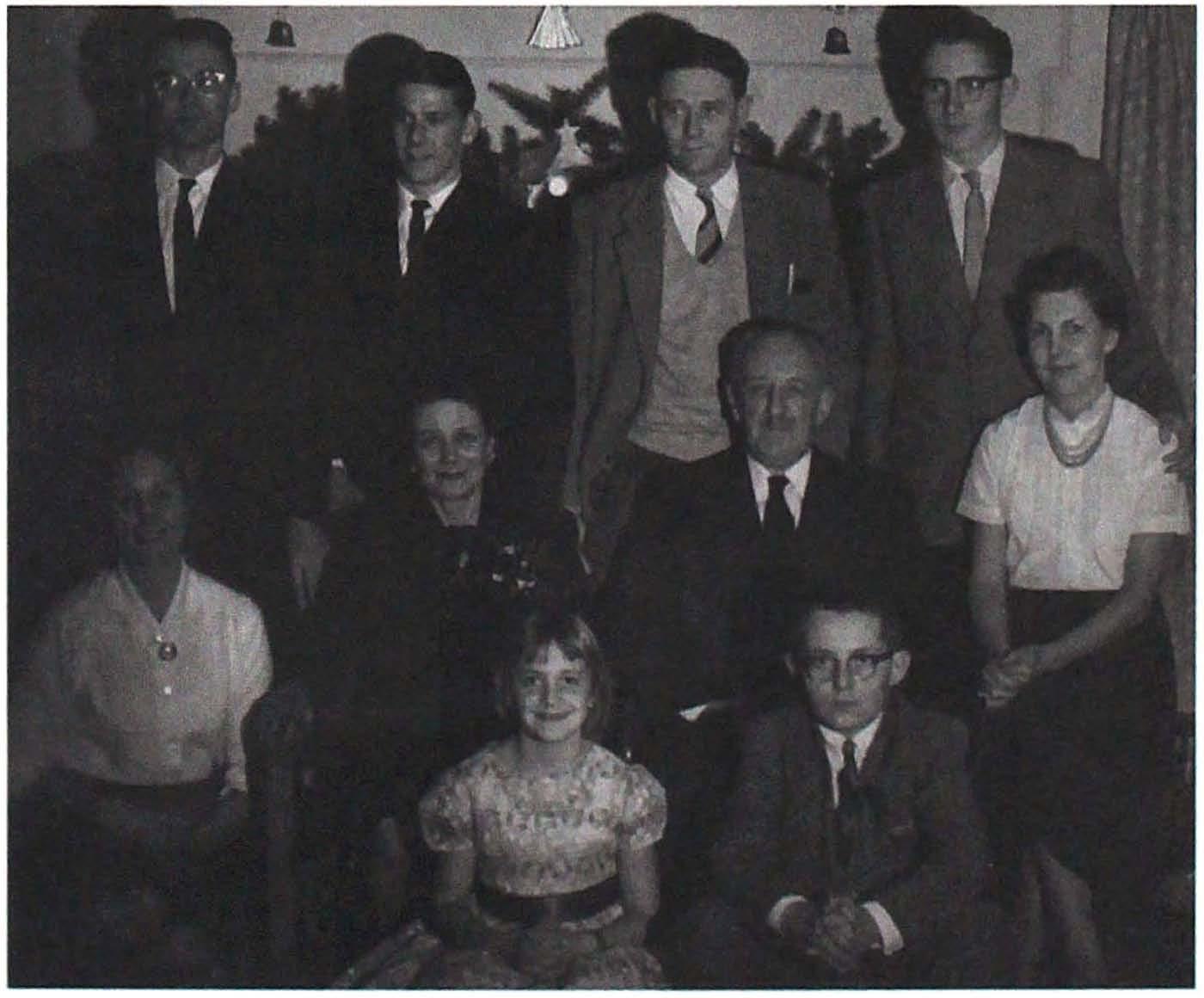
Third row fleft to right!:
Bachee Parker-Jervls, Chris Harker Tony PJ. Nick Parker-Jervis ITony PJ's son!
77
St. George's offers visitors a doggy welcome, Here the dogs are accompanied by John Harker. standing. and John Blackmore. sitting.

littlecreatures.Standingbeforetheheadmasterandchargedwithinfractions,and advisedofthepunishment,thepoorsoulwouldbeinstructedtobendoverthechair. Hiseyeswouldfollowthe"Beak"tothebasketofcanes.Flexingafewcanesand settlingononetohisliking,theHMwouldtakeaposition...Thesoundofacane inflightandtheimpendingpaintobeexperiencedleftonedancingalittlejigafter itwasallover.Thebathroomwasthenextmostimmediatedestination.Weltswere counted,checkedforsizeandobservedforcolour.Droppingthepantsandsurveyingthecarnagebecameinstinctive.


I
"There was the usual crowd of dogs-a spaniel on the front steps, two Labradors in the hall, a beagle and

a mutt of indeterminate origin in the head's St. George's over to his brother Douglas, he did so knowing that the school had become a Vancouver institution, and that the longawaited permission to develop the Topside property was imminent.
John Harker brought the school successfully through the Depression, the Second World War, and the Cold War. Throughout hard times he kept a firm hand on the purse strings, steering the institution forward through adroit land and property purchases, and preserving his shaky boarding establishment with concessions and compromises hammered out with the city. When he handed
office. They gave me an enthusiastic greeting, putting black paw-marks on my clean white shirt and hairs on my dark suit."
When Douglas Harker took over the school in January 1963, he was returning after an absence of 15 years. However, in his own words, "nothing had changed":
There was the usual crowd ofdogs-a spaniel on thefront steps, two Labradors in the hall, a beagle and a mutt ofindeterminate origin in the head's office.They gave me an enthusiastic greeting, putting black paw-marks on my clean white shirt and hairs on my dark suit ...

I looked through the comments in the masters' book- "I find this boy incorrigibly idle and impenetrably stupid. " "Who has removed the key of the games lockers?" "MayI suggest, with thefull knowledge that the idea will meet with the most violent and prejudiced opposition, that dogs be restricted to the outdoors?"
NervouslyI took my first chapel I did not notice that the prayerI had chosen had been written by Robert Louis Stevenson when he was in Samoa andfound myselfinviting the boys to prayfor "our friendly helpers in theseforeign isles." BrickNo.1 ...
Stillmore nervouslyI went out to the playground. Balls, boys, shouts, grins. An extremely small boy-grade 1, I would guess-confidently presented me with his yo-yo to untangle.There were some cheery good-mornings and an indefinable air of vigour and Vitality, ofwarmth and friendship, ofhumour and good-humour ...
It was good to be back.
True to the St. George's tradition, Douglas looked after his brother's dog, Shaughnessy, during John's trip to the UK-a leaving gift from the school. The boys were soon to welcome Douglas's corgi and, when Douglas remarried in 1966, yet another two dogs belonging to his bride, bringing the grand total on campus to 14.
79
ABOVE
The student centre is the flat-roofed building on the lower left-hand side of the building complex. Immediately above is the swimming pool.

FACING PAGE


Dining room and Wallace gym in the new Senior School. 1965.
TWO SCHOOLS-TWO CAMPUSES
Douglas Harker received the long-awaited permission from the provincial government to build on Topside in 1964. It was a minor miracle that funds were raised, an architect hired (Mark Sharp, '40), and the building completed to receive its first Senior School students in September 1965. The opening months, however, were not without their difficulties. Douglas Harker admitted to experiencing "all sorts of doubts and worries":
When September dawned-thegym unfinished, the lights not working, the cafeteria not ready, the telephone disconnected, and only one toilet in operation-Ifound that the bland and confident look, which other headmasters wear so becomingly, had become a bit twisted.
Of equal concern to the headmaster was that the move to a new purpose-built school, with none of the character and traditions of the old, might seriously damage school spirit. Douglas worried that the school "might become formal or fancy; that brand new drapes and furniture might bring a new formality. This has not happened. 'The same old St. George's in bright new quarters' wrote a visiting newspaper reporter, as he tripped over a trio of dogs." And so it has been ever since with the innumerable additions over the years.
80

Soon a spirit of optimism and confidence was palpable on both campuses:
When the boys surged in during early September there was an air ofpride and happiness in theenvironment which we had not known before. Everythingseemedpossible. The settling in, the general goodhumour, the new ideas, influenced every member ofthis community. With winter the new school struggled with mud on the floors, heat on and off, fluctuating tempers, and the reaction of expecting too much too soon. Spring brought thesweepinginfluenza which laid Iow a quarter ofthe school at one time. The momentum began to pick up asEaster neared, rugger sides began to win and the plays were good. Easter holidays were a respite, and suddenly it was summer.
Theschool began to lookforward again, shookitselflike a spanielclimbing out of water, and looked around to estimate what it had achieved andwhere it might go on from there. The move to the new quarters had given back the Senior School the breathing space, the open fields, the sun and rain, which are synonymous with a school in the country, which yet enjoys the advantages ofproximity to agreat dty.

The sense of spaciousness and newness was not confined to the Senior School. The "Cell Block" was now filled with the chirping of little boys spreading themselves out in delight, enjoying a space refurbished with "pastel paint, tiled floors, and art nouveau curtains. An era had ended and other times and spaces superseded them. Even the actual proportions of the smaller boys gave to the building a spaciousness hitherto unsuspected."
On October 27 the new school was formally opened in the Wallace Gym by the Honourable Clarence Wallace, CBE, before an audience of over a thousand students and parents. After the ceremony, Mr. R.H. Tupper, QC, a long-time friend and former school governor, unveiled three plaques celebrating the contributions to the school of the Auxiliary, the Wallace family, and former headmaster John Harker.

I RIGHT
The Honourable Clarence Wallace, a former LieutenantGovernor of BC, cuts a red, white, and blue ribbon and declares the new building open.
82
MORE SPACE FOR BOOKS, ATHLETICS, AND THE ARTS
The new school brought many improvements, not the least being space for all library holdings. For the last time in a long career, Carry Colchester moved her two libraries. The senior library moved out of the Colchester basement into its luxurious quarters in the new Senior School and the junior library quickly recolonized the empty basement. The physical work of moving 10,000 books up the road was cheerfully executed by a team of labourers and a fleet of cars.
The addition of a gym and much specialized equipment greatly improved the school's athletic facilities. The new gym provided a full-sized basketball court and three badminton courts. The open gallery above provided a location for supporters to cheer on their teams and , more importantly, a dining room.
Students and faculty of this era will remember their lunches punctuated by the violent bouncing of basketballs and the not-too-muffled shouts of ball players and their supporters in the gymnasium below.
It was in a Prize Day speech of 1968 that Douglas Harker, almost jokingly, referred to a wish list that included a swimming pool on the Senior School campus.
IABOVE


After 18 years. Garry Colchester gets a custombuilt library.

TOP RIGHT

PJandteamdiscussthe finerpointsofcalculus.


ABOVE
DavidOvertonpuzzlesover anaspectofthepool project,whileinthephotographbelow,FredJones looksonatallhisworks.
A referendum held in September after the boys had returned to school showed 87 percent of voters were in favour of raising the necessary funds. The board had already made it clear that with a $500,000 debt to pay off for the construction of the new Senior School in 1965, it would not be able to support any further capital projects, so the project was taken up by David Overton, the classics teacher and, for much of his long career at Saints, the director of games. Through a variety of imaginative fundraising efforts involving students and the community, nearly $60,000 was raised in less than two years.

Fundraising initiatives included raffles, organ recitals (with Gordon Atkinson at the treadles), student walkathons, raffles (with John Blackmore a very successful auctioneer), a dance, and last but not least, doughnuts sold by the kitchen ladies, which netted $2,500.
As if constructing a pool and an entire school had not been enough, the Saints community also financed the construction of a student centre in 1969 to provide accommodation for the graduating class and a place of refuge for bag-Iunchers. It was built by Fred Jones, an amiable geographer with a penchant for joinery. He was ably assisted in this project by Clive Austin, Junior School deputy, and various students. The building's life as a student centre was rather short-lived, however, after a lusty graduatingstudent attempted to "throw the hammer" within the centre's confining walls. Soon the building metamorphosed into an arts centre, which over time saw the flowering of the graphic arts program known and loved today.
MATH AND MR. PJ
Tony Parker-Jervis accepted a full-time appointment to teach math at Saints in 1956 and in the 1960s started to regularly field teams in provincial, and later national, math competitions. In 1965-66 his team of John Kwei, Tom Stevens, and Arne Woolsey Fliflet came first in the UBC Math Contest.
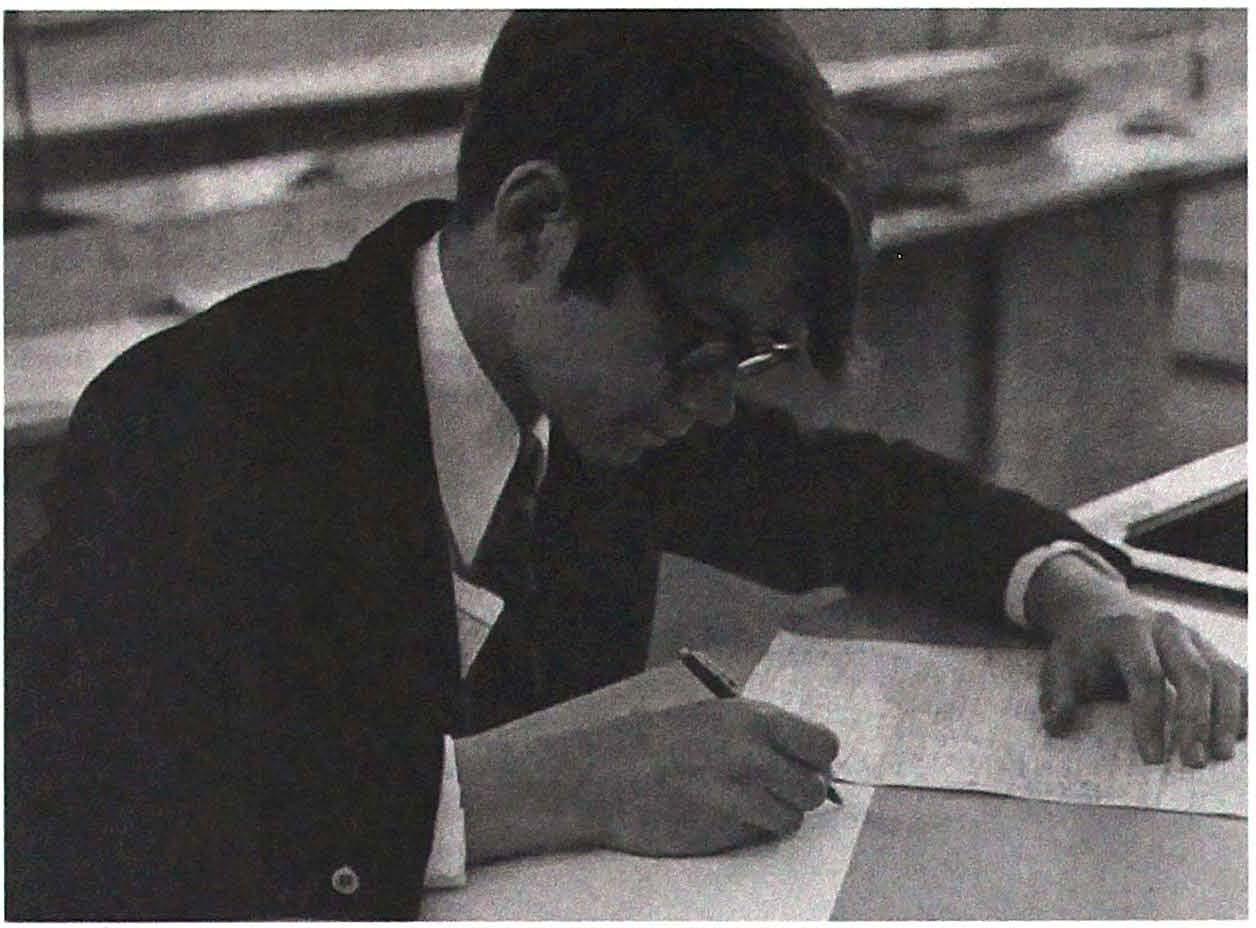
With characteristic modesty, PJ talks about the achievement of the team: "Whilst naturally, at some time or another, I had gone over most of the general mathematical principles involved, all the detailed work, the research, the planning of individual strategies, were done by the boys themselves with only the merest help either asked of or given by me." Today, nearly 40 years after proving themselves the best student mathematicians in the province, Stevens and Fliflet now work in the world of theoretical physics. They both completed their PhOs in sciences, and both are concerned indirectly with the atom-either breaking it or fusing it. Kwei earned two degrees in math and after a short career as a math teacher-he spent a year or two at Saintshe decided on a business career andjoined forces with his wife. Together they now run a successful fashion house in Vancouver.
PJ's teams were to become even more successful by the end of the decade. In 1969-70 the team placed first in the Ontario Junior Math Contest (for students up to and including grade 11). John Spouge, a grade 11 team member, went on to win a first in Canada award in the prestigious Math Olympiad (by invitation to the very best senior high school students). He also received a $6,000 scholarship.
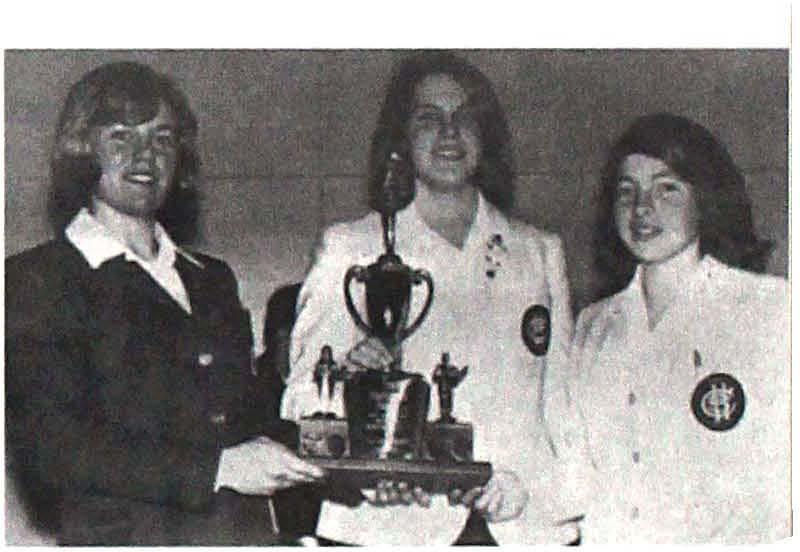
TRACK AND FIELD SUCCESS
It was through the early 1960S that St. George's put together one of its finest track teams. Their coach was a handsome Irishman, David Abbott, with a previous distinguished career as a hurdler and pole-vaulter in the Irish National Athletics team. In 1963 one of David's proteges, Geoffrey Stancombe (,62), just turned 18, recorded the fastest time in the province for the 440 yards (50A seconds) and was considered to be one of the finest athletes in the country.
I LEFT

DEBATING: THE LADIES WIN
The Palfreyman Debating Cup became the prize for a competition instituted in 1964-65 to foster an annual debate between Crofton House School and SI. George·s In their first encounter. the teams debated the merits of ··a woman·s place is in the home · The following year the motion was ··coeducational schools should be abolished··-a debate that presaged the next decade·s stormy attempt to make St. George·s coeducational. On both occasions the tadies won the day. Although the cup was the object of heated competition throughout the decade. the Saints team did not take the prIZe until 197I-after eight consecutive defeatsl
85
John Spouge crafts solutions for the Math Olympiad.
THE AFFAIR OF BOTTERELL'S BUNG

Early during Douglas Harker's term in office. an Air Cadet squadron replaced the school's Sea and Army Cadet corps, but not before the Dragon Sea Cadets managed to distinguish themselves at a Burrard Inlet regatta, as described in a local newspaper report:
There's a thumb that will forever be known as Botterelt's Bung in the annals of St. George's School. The thumb and youthful determination kept the schoot's chances from going down the drain in a sail· boat regatta Sunday in Burrard Inlet. Jammed into a hole to replace a drain-plug that dropped out. the thumb enabled the St. George's Sea Cadets corps boat to keep afloat and wallow home in the first race. It could mean the school corps is the winner of the Navy League of Canada's 1963 Sea Cadet Sailing Regatta. But it definitely assures the young yachtsmen of at least a second-place finish.
The hero who acted like the little Dutch boy who stuck his finger in the dike leak is 17-year-old John Botterell, of 3964 West Eleventh, cox of the schoot's entry The school's 13.6-foot boat Dragon participated with 17 other boats from various parts of Canada and one from the US. Dragon was lying second in the first of the series of five races when the drain-plug incident threatened disaster. With the boat rapidly filling with water and the bailing of Botterell and crewmen Anson Frost of 1537 West Fortieth losing pace, the cox stuck his thumb in. The thumb and continued frantic bailing kept Dragon afloat and she finished eighth, picking up 11 valuable points.
Sadly, John Botterell, the hero of this story, died in 1972 in a sailing accident.
LEFT
The 1964 track and field team, the Dragons.
First row (left to right!:
Bill McLeary, Barry Nielsen, David Goff icaptainl. David Abbott icoachl. Rick McDermott, Brian Lecky, Pat Gray.
Second row (left to right!:
Doug Eacrett, Tom Williams, lan MacLean, Bruce Allan, Jim Smiley, Hugh Lockhead.
Third row (left to right!:
Pat Thomison, Arne Fliflet. Stuart Layfield Imanagerl. John Botterell, Hamish Malkin.
The team reached its apogee in the 1964 season with two Canadian champions, three Canadian records, undefeated status in six straight track meets, and 18 new school marks in various events. There were contributions from many, but the undoubted stars were David Goff, a sprinter and captain of athletics; Barry "Muscles" Nielsen, a decathlon champion; and Brian Lecky, a hurdler and recently retired and much respected Junior School teacher. All three held Canadian and provincial records in their events, and were described by coach David Abbott as follows:

David GoJf-Led the way in most ofthe meets we took part in, recording times like 10.1 secsfor the 100 yards In many ways he has been responsiblefor the excellent team spirit which has spurred many to extend themselves in their events to acquire points.
MusclesNielsen-Highjumping 6feet, Pole Vaulting 12feet, Triplejumping 40feet, Broadjumping in excess of20feet, Putting the Shot more than 40feet and a very capable sprinter and High Hurdler, etc., etc., he is nearly a One Man Team.
BrianLecky-Ifthere was an award to be madefor "The Most ImprovedPlayer" it would surely go to Brian Leeky. Standing a modest 6'4" and weighing 175Ibs., he is a picture ofgrace and ease when he hurdles, which is endorsed by thefact that within 12 months he has broken two Canadian records, two BC records along with his six school records.
86
David Abbott also made major contributions to gymnastics and is remembered for starting the first St. George's band in the Dragon Sea Cadet corps. In addition, he achieved notoriety in the community when he left the school with a Saints teaching colleague, David Price, to start a school of their own on the Mediterranean island of Ibiza. Unfortunately, the school never materialized. David Abbott arrived in Ibiza with a small but enthusiastic group of youngsters only to find that the villa planned for their use as a school was still full of guests. After an unsuccessful search for alternative accommodation, disheartened and disappointed, he and the students returned to Vancouver.
RUGBY TOUR TO JAPAN
A decade after the first international rugby tour to Australia, the school sent a team to Japan, this time with Douglas Harker. It was a remarkable experience for all concerned, and one that Douglas wrote about in some interesting detail:


! see the team waving gaily to a large crowd ofwell-wishers, who have come to see them off, then marching onto two wrong planes, andfinally being hauled back to wait another hour. ! see the mammoth reception at Fukuoka, two lines ofclapping students, a vast hall with another 1,500 ofthem, immaculately unifonned, the cheerleading section with total precision ofmovement, total unanimity ofresponse, the Fukuoka school song splendidly sung, inexorably martial-and then their request, would we sing our school song?But we doubt our ability to handle "Cantate Sanctae Georgiae," and, after a whispered consultation, we respond with, "I've Been Working on the Railroad. " No one is the wiser and we are extravagantly applauded. ! see Butterfield nonchalantly scrubbing the back ofthe President ofthe;apan Rugby Football Unionwho, poor man, had gone to seek privacy in his own bathroom. ! see the pretty little;apanese girls, seeing them offat the TokyoAirport, round-eyed with admiration and wonder, and not a little tearful. If only you knew these boys as well as ! do, ! think!
OUR SCANDINAVIAN G1ANT
Bjorn Bjornson was a giant of a man from Scandinavia, the Land of Giants. In his short career as a St. George's teacher before going on to become a successful businessman, he made important contributions to track and field, rugby, and

I 87
ABOVE
The first Japan rugby tour. 1967.
"In winter the little rebels found me a wonderful target for their snowballing, and it took a little rigorous training for me to be able to get out of their firing area."

gymnastics. He stood somewhere around six foot six inches, with shoulders as wide as a barn door. He came honestly by his titanic strength through weightlifting and gymnastics. He towered over the little boys in grades 1 and 2 during playground duty, his first assignment at Saints. After one year he learned a lot about little boys, and they about him:
It was not too long after my shakycommencement as a playground policeman thatI saw a somewhat heated quarrel between two ofthe littlefollows, but it wasn't untilI decided to interfere that myjudging experience was shattered by the diversity ofthe accounts given by the young outlaws. I decided that the only possible way out would be to believe all, and therefore proceeded to acquit the disturbers ofthe peace by demanding they give a solemn oath not tofight again, and shake hands in the hope of staunchjriendship. That was some hope, I came to realize, because, within minutes of the signing ofpeace, my littlejriends hadforgotten all about our talk and had begun a new quarrel, this time including stones as more effictive weapons. Probablyfor the first time in my lift, I realized that despite my size and my strength, words did not cause the least amount ofalarm on these rebels, andfor the coming weeks my leisure time was spent in trying tofind a way ofcutting down this subversive aggression.
In winter the little rebelsfound me a wonderful targetfor their snowballing, and it took a little rigorous trainingfor me to be able to get out oftheirfiring area, whichfor some reason, always lay very close to my stand. Then came the spring and with it the corridors ofthe schoolwerefilledwith a melodious twinkling and rattling ofpockets. TheMarbles Season had begun and thereforeI decided to take up the exhausting sport ofthe ground crawlers. It wasn't too long after this that Ifound myselfin inevitablefights over how many marblesI had won.
Later on in the season, yo-yo became the sport and once againI was eager to becomea master in various trickeries whichI performedinfront ofthe vast delighted group. During this period my means ofappeasing the outlaws became more efficient with the daily distribution ofcobs and yo-yos to the best sports. To my surprise, the worst troublemakers soon became the guardian angels and the best abiding citizens ofthe citadel.
Bjornson was known to all as Bj Bj and was much beloved by all small people, who took particular delight in any of his playground appearances, which immediately became a romp with Bjorn at the centre of a maelstrom of activity.
88
DOG SHOWS


It's not surprising that a school so much in love with canines would hold a Dog Show. The first was organized by the Auxiliary in 1962 and the dog shows continued on through much of the 1970S under the direction of John Blackmore, with more than a little help from the ladies. These were very happy occasions when it was always difficult to decide who had more fun, the dogs or their owners. There were contests for the shaggiest dog, the dog most like its owner, the most disobedient dog, and the dog with the best pedicure or the most becoming tail. There was also a barking contest and much more.
Towards the end of the 1960s Jack Wasserman, Vancouver's legendary newspaperman, hinted to the wider community that dogs were sometimes more important than people at St. George's. Wasserman related what happened when a young man by the name of John Clerides reported to Mrs. Westmacott's grade 3 class, where the teacher's much-loved short-haired mutt Jo Jo was a fixture:
A Vancouver womanenrolled her two sons in a well-known private school. One of the boys is allergic to cats, dogs, and dust. Within afew days ofthe start ofschool the boy's allergy was really acting up. His motherfinally elicited the infonnation that the teacher in his class brought her dog to school with her. The dog sat in the class all day. The mother made a trip to the school and explained her son's situation to the nurse who had a cat in her office. There were some high level consultations and it was decided that the mother would be asked to remove the childfrom the school. "Dogs are a very important part oflife at this school, " the headmaster told me when I called to check. "It is a very small dog and it is all this teacher has. I would not wish to leave the impression that we consider dogs more important than children. But we do like dogs. "
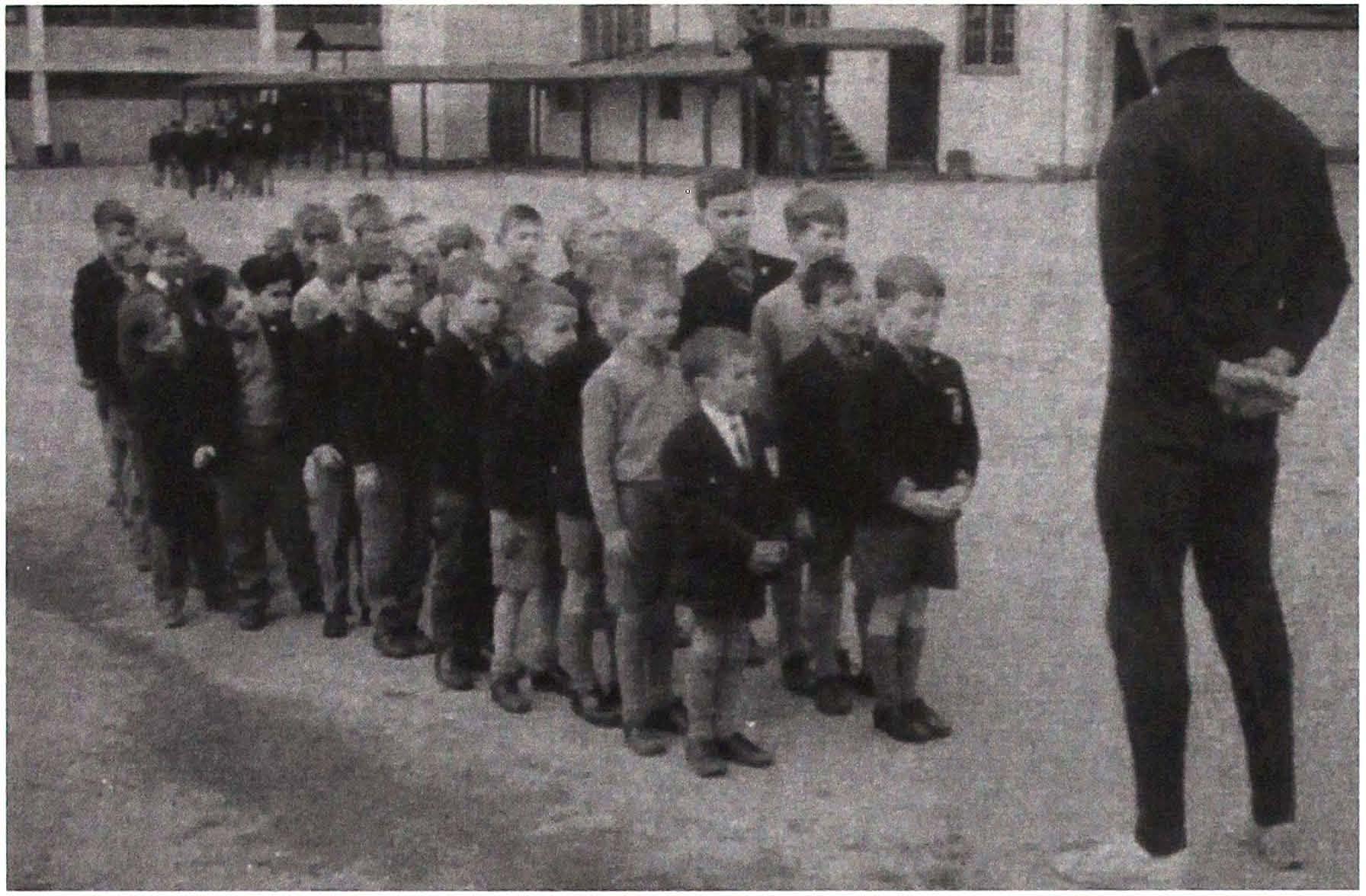
Phyllis Westmacott retired in 1978 after teaching the grade 3 class for 28 years. It is not known how long }o Jo remained her constant companion.
 IABOVE
BJ Bj towers over Parade.
BELOW
Mrs. Westmacott and Jo Jo
IABOVE
BJ Bj towers over Parade.
BELOW
Mrs. Westmacott and Jo Jo
I

Cappie Robinson with his sons, Geoffrey and Basil, 1929.
FAREWELLS
The decade saw the departure of Cappie Robinson, Nip Parker, the Reverend Geoffrey Parrott, and Axel Mortensen.
In the annals of St. George's, Captain Basil O. Robinson-known as Cappie to his familiars-remains one of the most colourful teachers. Before the Great War he worked for the Pacific Cable Board, enduring eight months of solitude at Bamfield on the West Coast before returning to the city to find work. In Vancouver he discovered the Crusaders' Rugby Club before leaving again to work as camp chief on the construction of the Kettle Valley Railroad. When war broke out he enlisted and was wounded on Flanders Field at the third battle of Ypres in 1917, losing an eye and sustaining head injuries that required the installation of a steel plate. Cappie's tales about his head wound led the boys to call him "Chrome Dome."
In 1937 he was hired by John Harker to teach anything except science, which he did until his retirement in 1962. He was a dedicated Cub and Scout master, and played many sports. However, his grand passion was cricket. Jim Mason ('56) tells of a visit he made to Cappie's home 15 years after his graduation from Saints:
I ran him down in a small cottage, much overgrown with vines and vegetation, to receive a wann welcome fromMrs. Robinson, who exclaimed thatI must be "one of Robbie's boys. " The oldguy ambled out andfixed me with that look ofhis, and began to run through a long list of names until he settled onJim Mason. It took a little timefor me to realize that Cappie was going through the names of all the redheads that he had ever taught at Saints. After a cup oftea, he proposed calling on a Mr. Smith down the road who intended on a visit to Brockton Ovalfor cricket. Thus I spent an afternoon watching a game that I never really enjoyed at Saints but in whichI had participated largely through the enthusiasm ofCappieRobinson who was a lifelong addict.
Cappie's first-born son, Basil, was a Rhodes Scholar. His second-born son, Geoff ('38), graduated from St. George's as school captain. In turn, Geoff's son Michael ('69) was to become a school captain like his father and a Rhodes Scholar like his Uncle Basil.
Nip Parker was one of Danby-Hunter's "originals," hired for the opening of the school in 1931. He had returned to England in 1935 to acquire a university
90


91
RIGHT
BELOW

Axel stands at ease with his beloved tool box, about to walk off the property for the last time,
degree, enlisted in 1940 with the rank of captain, and fought with the Seaforth Highlanders in the capture of the heavily fortified town of Ortona in Italy. It was in the savage struggle for the town that he lost his leg and was subsequently invalided home. Tommy Roxburgh, a close friend and colleague, and himself a redoubtable survivor of the war, gives this account of Nip's career with St. George's:

In thefield ofactive sports his love was polo which he continued to play with his metal leg ...When playing against VGncouveriteMarty Griffin there was a crashing encounter between their two horses and a cry ofanguish fromMarty. After the gameNip's artificial leg wasfound to be a crushed mass ofsteel, so it can be imagined whatMarty's leg looked andfelt like.
With typical tenacityNip continued to ride a bicycle.When riding a horse he used his bicycle pant clips to hold his artificial leg to the stirrup and strap.One day having mislaid his cycle clips he wired the metal leg, boot, and leg ofhis riding breeches together. During the game he was knockedfrom his horse which proceeded to gallop round thefield with what looked like a man's leg and part of his breeches tornfrom his body. MeanwhileNip struggled to hisfeet sans left leg, sans breeches.
 Michael Robinson and his St. George's friends meet Prime Minister Trudeau, 1968.
Michael Robinson and his St. George's friends meet Prime Minister Trudeau, 1968.
92
Whetheronthefieldorinthechapel, hisstentorianvoiceroseabove allrivals. Whenahymnwasannouncedinchapel,Nipwouldbellowitout inthetimeandtunehethoughtwasappropriate, soonthecongregation followed, andfinallytheorganistgaveuptheunequalstruggle, andwas convertedtoo-enthusiastic, tonedeafwhoknows, itwasoneofthemany partsofNipParker.

Nip retired from St. George's shortly before John Harker but continued to teach part-time at Glenlyon School on Vancouver Island until 1969. In his last year at Glenlyon he organized the cross-country race, which was subsequently named the Basil Parker Cross-Country Run in his memory.
Through the years the school has been remarkably fortunate in the long service of its chief janitors and engineers, whose knowledge and expertise in handling the many electrical, heating, and plumbing challenges created by endless construction have been invaluable. Axel Mortensen's career began in 1935 and ended 32 years later, but not before he found and groomed a worthy successor in the shape of Isaias Garcia, who jOined the school in 1957. Upon Axel's retirement, John Harker summarized the man's invaluable contribution to the school with characteristic wry humour:
Axelwasknownas "Mort"totheboys. Hecouldbetoughwhentheoccasion demandedbutdeepdownhelovedthemall. Healwayshadawordforthesmall lonelyboyinacornerofthequadrangle, andbonesforthedogs.Itistypicalof thispreciseandmeticulousmanthatheshoulddecidetoretireontheexact anniversaryofhisarrivalhere, thirty-twoyearsago. . UIe shallmisshim, this characterwiththesharptongue, thekindheartandthemagichands, andthe twinkle ofhumourinhiseyes. Whowillrepairourtestypre-warmowing machines, placeanunerringfingerontheshortcircuitinourmainswitchboard, orproducefromthedepthsofhiship-pockettheverytoolrequiredtoreleasesome smallboy'sleg, trappedasonceitwas, betweenthefencepoststhatoriginally skirtedtheoldschoolbalcony.
ABOVE
Nip Parker as a perfect illustration of the following lines: A Book of Verses underneath the Bough.
A Jug of Wine. a Well-filled Pipeand Thou Beside me singing in the WildernessOh. Wilderness were Paradise enowl (With apologies to Omar Khayyam)

93

THE DECADE ENDS WITH A ROYAL VISIT
By some extraordinary piece of magic, Douglas Harker managed to close a particularly eventful decade by orchestrating a visit to the school by the Duke of Edinburgh. The chief purpose of the Duke's visit was to present the Duke of Edinburgh's Award to recipients. The awards program had been in operation in Canada since the beginning of the decade and on this royal occasion 28 medals were presented to St. George's boys. There is no record of the Duke visiting any other school in British Columbia that year. The event was described in the Georgian as one marking the growth of St. George's "from a small unknown school to one of the greater educational establishments in Canada."
Despite the fine end to the decade for St. George's, there were troubled times ahead in education. During the 1960s students everywhere had begun to challenge the status quo, campus violence had become endemic, hair length had gone from crewcut to cavalier, and the drug culture had begun to make its insidious presence felt. In the next decade Douglas Harker was to hand over his responsibilities to a younger man with the energy and ambition to take on these challenges.
His Royal Highness Prince Philip. Duke of Edinburgh, visits St. George's in October 1969. Douglas Harker is seen on the far right and Clarke Simpkins, Chairman of the Board, on the far left.

95


IThe first winning team in a long and illustrious line of provincial Reach for the Top winners.
1970-1979
The 1970S: A Dynasty Ends and the world Changes
1970 National Guard members fire on Kent State University demonstrators
Emergency War Measures Act invoked by Trudeau in response to FLQ kidnappings
1971
Douglas Harker retires
Jim Morrison, age 27, dies in Paris Stanley Kubrick's Clockwork Orange opens
Alan Brown becomes headmaster of St. George's Watergate burglary
Pink Floyd releases Dark Side of the Moon
Rugby first XV wins the BC High School championships for the first time
1974
Reach for the Top team wins provincial championship
Rugby first XV wins the BC High School championships for second time
Mathematics team wins first prize in the Ontario Junior Math Contest Performing Arts Centre opened
Angus Stewart ('69) captains Cambridge in a decisive victory over Oxford University Saigon falls to the Viet Cong
Elvis Presley, age 42, dies in Memphis
Bill 33 provides funding for independent schools

1979 June, St. George's formally acquires the convent property
September, refurbishment of the convent begins
1972 1973
1975 1977 1978



5

A Dynasty Ends and the World Changes
IN 1971 THE 40-YEAR HARKER DYNASTY CAME TO AN END with the retirement of Douglas Harker. Alan Brown, an Old Boy from the class of 1954, took on the mantle of leadership during a particularly difficult time. Students in universities and high schools across North America were challenging the traditional relationship between teacher and pupil, and on many campuses there was anger and frustration at escalating US involvement in the Vietnam War.
At St. George's, corporal punishment was slowly being phased out as the administration sought to establish a different relationship between teacher and student. The prefect's role was redefined and prefects began the long evolutionary journey that would take them from policemen to student leaders.
The Georgians of the decade reported on a wealth of new activities, with students at every level becoming more involved in organization and leadership. It was the decade in which badminton, swimming, debating, outdoor programs, music, and the graphic arts became integral parts of the St. George's curriculum.
Late in the decade Alan Brown returned from a visit to a number of leading coeducational private schools in the US and put the idea of a coeducational St. George's to the community at an open forum. The issue was not resolved and would not be seriously reconsidered for more than a decade. This verse from a House Supper skit by Messrs. Hill and McLaren considers the ramifications of a coed Saints:
At St. George's Schoolfor Boys, The question on thefloor's... coeducation:
At St. George's Schoolfor persons, This thought provokes intriguing speculation; Will rowdy boys make much less noise? TM? can but hope and guess,
I
99
Douglas Harker [left) and his successor Alan Brown (right)
I RIGHTThe Georgian crew of 1973 carry their literary burdens with some sartorial flare.
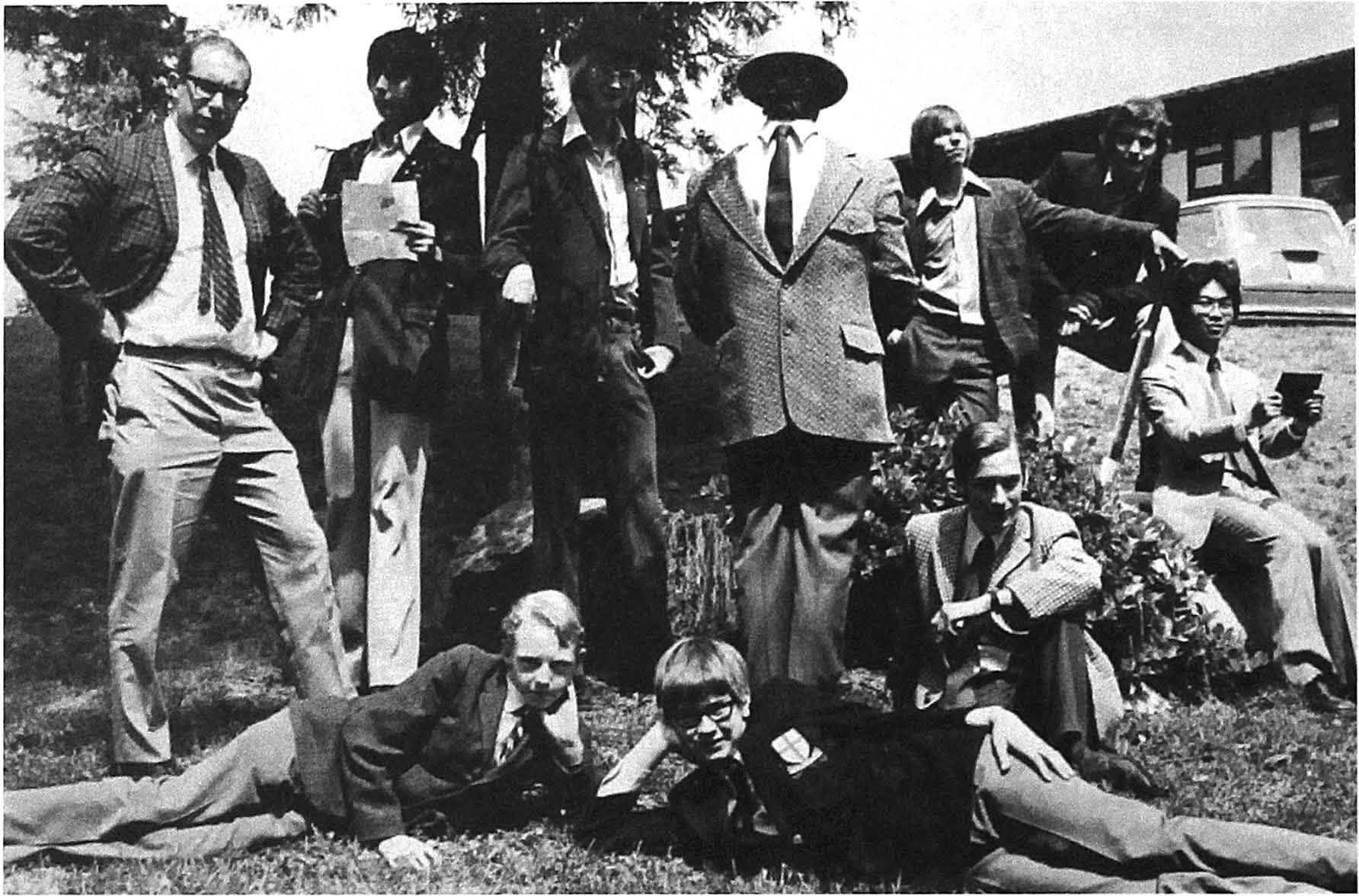
WillSimms take care he does not swear in moments ofdistress?
WillPJ yell at somepoor gel, "rou wretched baboon-ess "
At St. George's Schoolfor Boys.
And as in every other decade at St. George's, the planning and construction of new facilities continued, beginning with the building of the Woodward Auditorium complex and finishing with the purchase of the convent and first steps towards its restoration.
Alistair Fyfe, school captain in 1976, gives a student's perspective on the changes brought about in the half decade of his senior years:
When J arrived in grade 8 there was apool but no auditorium, no tennis courts, no newphysics lab: the list of"no's" is endless.And how did they suddenly materialize?Mr. Brown came in 1971 andforfive years J have watched him struggle to make St.George's what it is today.Even though we have had our minor disagreements. (':A. gentleman shaves in the morning, Alistair'').
The decade closed with the passing of Bill 33, which for the first time provided public funding to qualifying independent schools. At first this was regarded as a double-edged sword, with the schools worried that they might lose some of their traditional freedoms in return for the cash, but the price eventually proved small compared with the immense benefit.

100


I 101
ABOVE Fred Gass and the Stage Band In the second year of Its eXistence, 1978.
REACH FOR THE TOP


SI. George's began competing in Reach for the Top, CBC's televised trivia quiz for high school students, in the 1960s In 1973 74 the Saints team was pitted against Carson Graham in the final, Isee page961. coming from behind to win by a score of 305 to 285. In 1977-78 Saints collected a second provincial championship with Alan Patola Gordon Kruberg, Andrew Benkovitch, and Rene Cremonese
The photograph here shows one of the first teams in 1964. Team members are Ifrom left to rightJ Chris Wood, Peter Heap, Crispin Elsted, and Kent Steele,
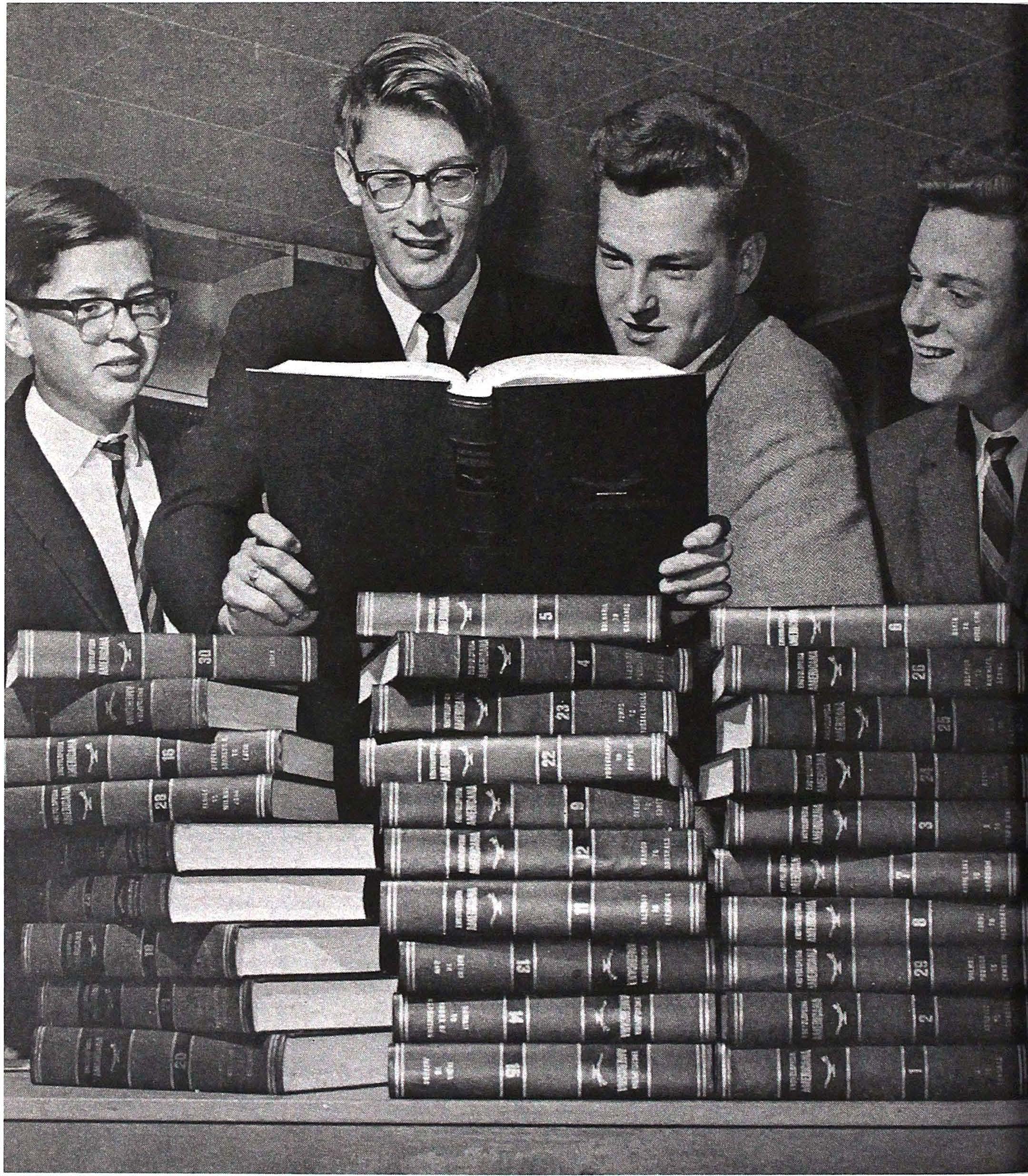
102
THE ARTS
The pages of the Georgian in the 1970S reveal an explosion of creativity in the graphic arts. Ted Cale, head of the art department, and Wayne Price, his deputy, made full use of the fabled north light afforded them and their students in the arts centre. The creation of an art centre ultimately helped the graphic arts become part of the soul and lifeblood of the school. The Georgian faithfully mirrored this development with a progressively expanding arts section that devoted equal space to the visual arts and writing-the latter also finding a platform in the various student newspapers of the time (see below).
With the end of Carry Colchester's long reign as Georgian editor in 1971, a succession of inspirational editors-including John Field, David Reid, and Robin Baker-helped the yearbook rise to new heights of imagination and creativity.
SCHOOL NEWSPAPERS

There have always been school newspapers at st. George's. The first one, the Spear, surfaced in the 1930s. Many others have appeared and disappeared since. As the satirical voice of a small group of renegades, they tend to end up on the scrap heap of history once their authors have graduated. There are some recurring themes: veiled and not so veiled threats against the administration; complaints about the catering department and the school uniform; lampoons of the institution's sacred cows; attacks on anything that smacks of arbitrary authority. One student newspaper from 1975 mocked the head of the music department Oenis Whyte ('51!. charged by Alan Brown with making something of the school's music program-a task he appears to have taken seriously.
The Rime of the Ancient Musician [with apologies to Sam ColeridgeJ
It's Mr Whyte the choir man, And he's spotted one of three.
"By the short red hair and glinting eye, Why have you picked on me?"
"The hockey team IS on the board, And I am down as one; You can't take me, my vOice is hoarse, I'd sing like Atkinson "
He holds him with his pudgy hand; "There IS the band," he said. "Oh no," he cried. "My earplugs pleasel" He quaked with mortal dread.
And now he is down on the list There can be no release, He blubbers like a three year old; HIs eardrums rest in peace
Then Mr. Whyte begins his tale Which all new boys must hear; He tells them how the music kids Were pansies till this year-
"We all had fled to Harker's shed. To play an instrumentThey all thought music was a thing For fairies to frequent
"But things are different now I'm back, You all must sing for me. I have more sway than old PJ, Just go and ask AB "
Now Mr. Whyte, he prowls the halls, And stops all those he sees There IS the band. the choir, and PASS To be filled with draftees
-R. Armstrong
\03
Ian Bray was a particularly talented student writer and wit, whose editorials had a distinctive bite:

This is it! We of the graduating grade 12 class are about to step into the quicksand of time.We are being weaned from the sheltered existence that has surrounded us at St. George's.(Weaned nothing! We're being thrown to the wolves with a handbook which says on the cover, "Never cry wolf!',)
In other words, we don't know where we're headed, or what lies in storefor us, or when the whatever or wherever turns up,just how we are going to handle it (or them).Some ofus willbecome lawyers with two cars, a wife, a pool, and numerous children-the males obviously attending the oldAlmaMater. Some of us willwalk away from St.George's and you won't hear a peep from us again.
And that's the way it is

It is in this decade that the mighty St. George's band program came into being. The catalyst was a trumpeter from the Rhythm and Blues All Stars, one Freddy Gass. He had been called in at the last minute to lead the department, even though he had no previous teaching experience. Fortunately for Fred, his adrenaline was flowing as never before during that first speech to a gathering of dejected musicians, and he proceeded to reach previously unknown heights of eloquence as he went about creating his new program on the spot and selling it to the boys. It certainly helped that Fred could really play the trumpet and that he could talk about the nether world of Vancouver's nightlife, always of interest to worldly young men. He proved to be a talented and inspirational mentor and under his guidance the concert bands and jazz bands came into being.
Along with musical achievements, debating successes piled up through the decade, with teams defeating Crofton to win the Palfreyman Cup, the Hammarskjold Cup at the provincial debating championships, and the Newman-FISA Cup at the independent schools championships.
 I
George Gregory represents BC in national debate in Halifax, 1973.
I
George Gregory represents BC in national debate in Halifax, 1973.
104
HOUSE SUPPERS
In the 1970S students began to have a voice in the annual House Supper. Up until then, the entertainment following the communal meal had involved only the student body in the singing of the "Viva-La" (see Appendix 3), and the staff then presenting the rest of the program, usually after hasty and somewhat amateurish preparation.
John Field, the Georgian editor of 1973-74 had this to say about the inclusion of a skit by the senior class written by lan Bray: "The whole thing was very well put together, a subtle blend of words and music. As such, it couldn't help but show up the infantile and ludicrous mayhem put on by the staff, which-nonethelessseemed to amuse the school." lan Bray's skit was based on the tune to Paul McCartney's "Yesterday," and each verse parodied a member of staff. Mr. PJ is easily recognized in the following:

Yesterday, All my hours seemed sofor away, / keep putting offthe evil day, Oh, how / hate this Saturday.
Suddenly, Math is not the game it used to be, There is a chalk brush hanging over me, Oh Mand-Sat came so suddenly.
You could do a quadratic, Almost totally automatic, Ifyou only had a brain.
YOll could pass my class in Math, And not incur my wrath, Ifyou only had a brain.
House Suppers in the 1970S also benefited from one particularly polished and witty staff duo-Garath Hill, a lyrical Welshman, and Cameron McLaren, the
105
A particularly gruesome crowd from Grub Day 1974-75.

French teacher. In the history of St. George's, Cameron is the only teacher who could vie with Tommy Roxburgh as a wordsmith. The duo regularly summed up a year at Saints to the tune of "Much Binding in the Marsh," a BBC comedy from the 1960s. They wrote the following for the House Supper of 1977:
GRADE 12 LUNCHTIME PRIVILEGE

I
106
At St.George's SchoolforBoys,
According to our much reveredHeadmaster

At St. George's SchoolforBoys
The classes this week were a disaster, He wandered round from room to room, His coffee cup in hand
"Why are they halfattended please?
I do not understand."

Then someone brightly answered, "Sir They're all at choir or band ..."
In the long history of the House Supper there was a grudging tolerance of smoking by senior boys after the meal. Before the supper of 1974, Alan Brown announced that this privilege had been withdrawn. In this story related by Peter Hilton, Headmaster Brown was put to the test:
As school captain during academic year 1974-7.5. I had to inform myfellow classmates ofthis new ruling Although a non-smoker myself, I knew that this unilateral decree would not be taken well by the smokers among myfellow grade 12S. TtVe quicklyformed a committee and a group ofus, including both smokers and non-smokers, met with the administrationto talk things over But they were immovable.TtVe did, however, win the concession that the illegal, though condoned, Smoke Hole in theforest on the other side of29thAvenue would now be considered legalfor grade 12S.
Back in the PringleHouseResidence, we came up with an idea ...we bought 400 candy cigars and on the night of the House Supper arranged to have them distributed to the student body At a givensignal, thecigarswerepassedout to allboys, including boarders as young asgrade 3. WithinsecondsMr. Atkinson, the deputy head, had left his table and was at Mr. Brown's side: "I think, sir, that we have ...have a rebellion on our hands!"
It was then that the head's calm and charming wift, Alix, said, "My dear, you know they're not real!"With that, the colour returnedto the headmaster'sface, his eyes re-opened, and a relieved smile crossed his face.
GRUB DAYS
Grub Day was an occasion when students were given permission to attend school in their ciwies in return for a small donation to charity At some pOint It became a fancy dress day with a parade and contest in assembly. There were always outfits that explored the kinky underworld
In this photograph, David Overton looks surprisingly relaxed with Rick Abramson dressed as one of the Clockwork Orange thugs.

107
ABOVE

The woodwork shop-a one-time laboratory for hovercraft construction.
BRIAN DWYER'S CLUBS
Clubs continued to be popular at the school throughout the 1970s, with the noteworthy addition of a rocketry club and a hovercraft club. Both were sponsored by Brian Dwyer, who taught physics in the latter half of the decade. With his technological background, Brian had something different to offer students with a penchant for the hands-on approach. On one occasion a rocket that took a horizontal
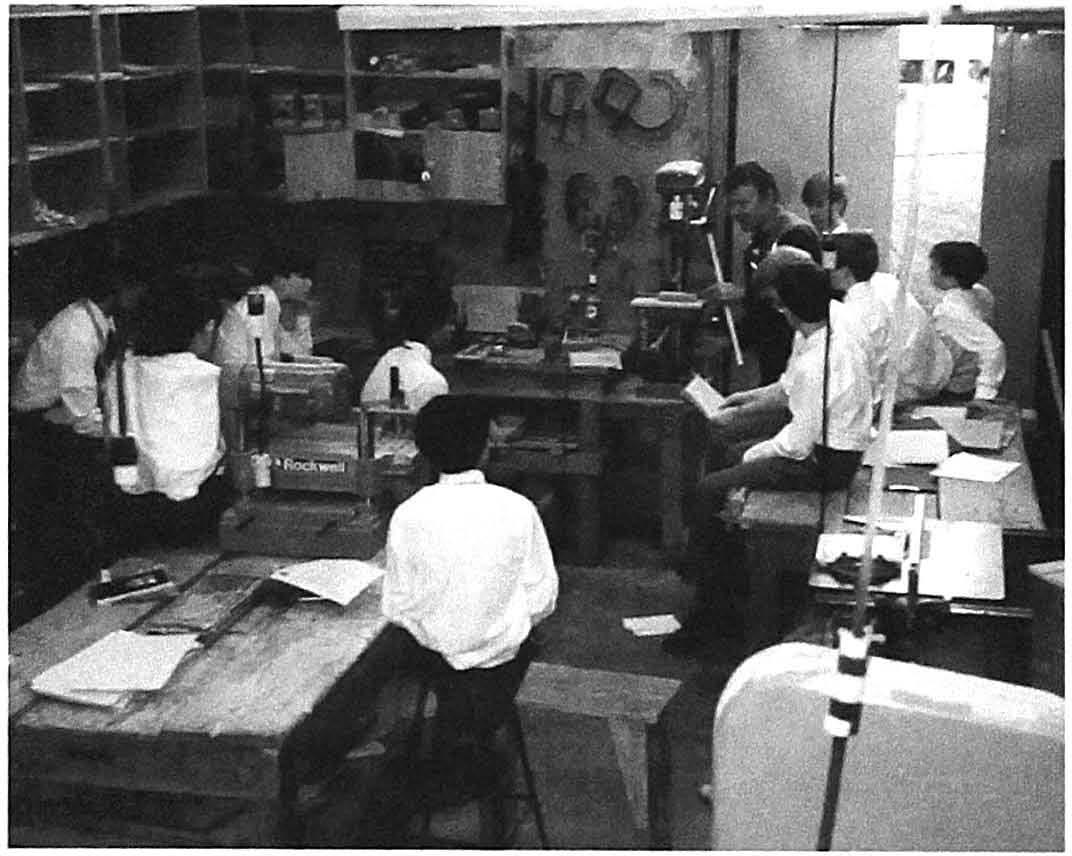
rather than a vertical trajectory almost carried the headmaster to that "undiscovered country, from whose bourne no traveller returns." This "harmless but fortunate incident concerning the LIFE of Mr. Brown," as the Georgian described it, led to rescheduling the launches from noon hour to "after games."
Naturally enough, students with a penchant for this sort of messing about were also drawn to the hovercraft club. On one occasion Robbie Falconer, Karl Springer, and Mike Spissinger were involved in the construction of an ill-fated hovercraft. The site chosen for the construction of the machine was the woodwork shop, a small room loaded with Geoffrey Stancombe's tools and student projects in process. There wasn't room to swing the proverbial cat!
The motive power for the "lift" was provided by a small petrol engine that powered two turbine blades inside an aluminum cowling, the whole built by our ingenious young engineers. The day came when a test run was in order. Would the machine levitate?
The turbine blades whirred smoothly into life once the engine was started, but shortly afterwards a knocking was heard from inside the body of the machine, which grew in ferocity and pitch. Suddenly and without warning, the aluminum body started to fly apart into vicious shards of metal that pinged from walls and ceiling. The astonished team cowered on the floor, hands over heads. With increasing velocity of rotation the turbine blades had ripped away from the turbine shaft and torn through the cowling, shredding all in the process.
Amazingly, no one was hurt.
I
108
The turbine blades whirred smoothly into life once the engine was started, but sh0 rtly afterwards a knocking was heard from inside the body of the machine, which grew in ferocity and pitch.
ILEFT Rocketeers hope for a vertical take-off. Brian Owyer can be seen on the right with his back to the camera.


109
A ST, GEORGE'S HERO IS BORN
Geoffrey Stancombe's career as student, teacher, and outdoorsman involved many stories of almost Shakespearean grandeur: "most disastrous chances, of moving accidents by flood and field, of hairbreadth 'scapes [in] deserts idle, rough quarries, rocks, and hills whose heads touch heaven" IDthello, I, iii)
In 1971 Stancombe pictured on page 113, standing on the far right) received a medal for bravery from Governor General Roland Michener after rescuing two canoeists from the Similkameen River. His heroic act was described in a newspaper account of the time:
Geoffrey Stancombe, 26, rescued two of five Lower Mainland canoeists who capsized in the Similkameen River between Princeton and Hedley on Sunday He had previously warned them not to tackle the river. Stancombe had just landed his own canoe above the Bromley rapids when the other craft came shooting down the river. One overturned before it got into the white water and all three occupants reached shore. When the other canoe went down the rapids, Stancombe stripped and swam into the cold water to pull out Barry Robinson of Richmond Stancombe then jumped into his car and sped for a mile and a half along the highway He dived into the river again and knocked the second paddler, Kim Young of Richmond, into the back eddy where the current pushed him ashore. '" was left in the middle of the river riding the overturned canoe which aimed for land as it was being swept downstream As the canoe neared the shore, it smashed against a large rock, and from there Stancombe struggled to land with two broken fingers. On Monday night he was still mad. "The Bromley rapids are all white water, " he said, "and before even an experienced canoeist tackles them the river should be navigated. Those guys are lucky to be alive "
In another newspaper article, Alan Brown, then headmaster-elect was mistakenly credited with the rescue. In school the following day the standing joke was "Geoffrey Stancombe-hero one day, headmaster the next."
As well as rescuing canoeists in the 1970s, Stancombe was busy taking over the Duke of Edinburgh's Awards Program at Saints. He has directed it ever since and over that time has seen it become the largest in Canada. Every year at Saints he encourages boys in grade 8 to take the first steps towards the bronze medal. Almost all of them make it, with a significant number going on to achieve silver and the coveted gold awards. The program's public service and outdoor components have always complemented Stancombe's own outdoor and service interests, making for a natural marriage of aims and objectives.
AN END TO CORPORAL PUNISHMENT
One of Alan Brown's first announcements to the student body was his intention to end corporal punishment. The announcement proved to be a little premature, and corporal punishment didn't actually end until later in the decade. Certainly corporal punishment was in the nature of things in the early days. In an interview with BC Business, Rafe Mair, an Old Boy from the early 1940S and a former Social Credit cabinet minister, remembered the public caning of five boys who had been caught stealing cars:
we were kids ofnine or ten and were alltaken into the gymnasium and allhad to stand at attention as these guyswere brought up one by one and put over agymnasium horse andflogged with a cane. I can remember the number ofstrokes too. They werefifteen, twelve, twelve, ten and eight-fifteenfor the worstguy and then twelve for the next two and then tenfor the next one, and eight.
The one who was going to get eight oddly enough, he fointed So they had torevivehim, and they couldn't revive him in time to sort ofput him up on the thing, so he came back after Christmas holidays and he took his flogging.And they did that publicly too.
It was stories like this that gave the school a reputation as a reformatory institution. When all else had failed there was always the expensive solution: send the boy to St. George's and have the Harkers sort him out. This notion was prevalent in the city even in the early 1970S and only ceased to be part of the folklore about Saints when a reputation for scholarship and academic excellence began to seep into the universal consciousness and replace the misconceptions of earlier decades.

110
However, in the days of the Harker brothers, canings did sometimes take place in a theatre-of-the-absurd atmosphere. One example involved the grandson of Mrs. Garfield Smith, who had provided $15,000 to start a Saints endowment fund. In his book about Saints, Douglas Harker describes what happened:
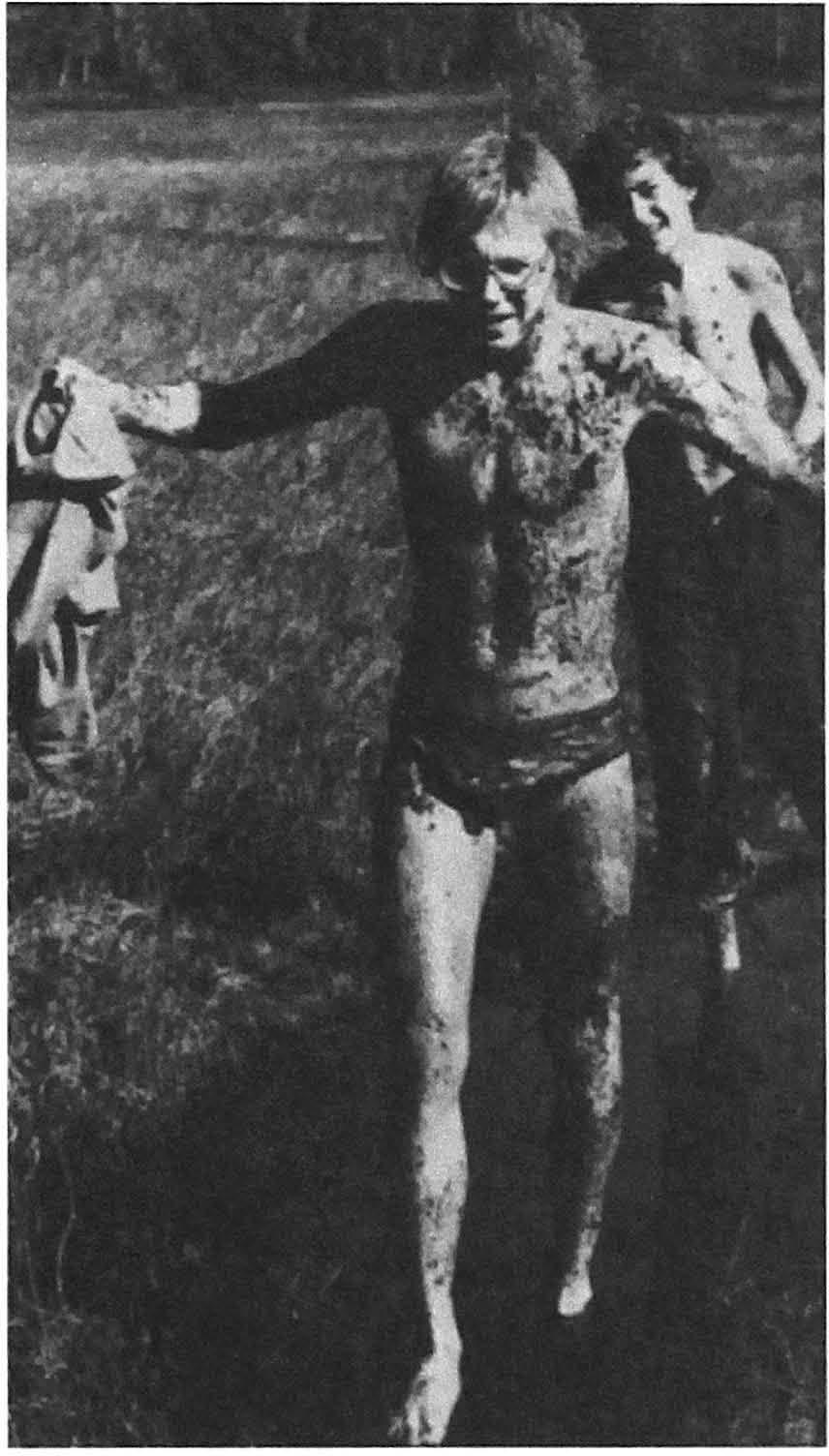

At thetimeo/the donation, Mrs. Smith's grandson, BobRidley, was caned in mistake for a boy named Riley. I discovered this mistake in the staffroom book which recorded such matters.
"Did you know what you were being canedfor?"
"No, sir."
"Why didn't youpoint this out to the master before he caned you?"
"Well, I thought it wasfor something that I hadforgotten about, sir."
"Consider yourselfto have a caning in hand. "
THE GREAT OUTDOORS
Of course it had to be that dynamo Geoffrey "Daddy" Stancombe ('62) who brought the outdoors to St. George's. As if track and field, basketball, and rugby were not enough, Stancombe was soon involved in Scouts and Rovers. In the early 1970S he ran both a Rover and a Venturer troop. Often there was a public service component to the groups' activities, with the boys working together to lend a hand in the neighbourhood whenever a particularly dirty job needed to be done. At Christmas time they collected food for needy seniors in the community, an activity that over the decade came to involve the whole school and grew into the Hamper Drive.

III
LEFT
The Strathcona 10 experience. 1979.
RIGHT
A muddy challenge for city dwellers.

Both the Rovers and the Venturers especially looked forward to their year-end wilderness expeditions. These took place after the academic year and involved heading off to the mountains, sagebrush country, or the remotest coasts of the province using a variety of different and colourful transports in the process. Most of the group would be graduates; exams were finished; high school was over and done with; and Geoffrey Stancombe, the Pied Piper, was going to take them adventuring.

The great outdoors eventually worked its way into the curriculum in the early 1970S when the grade lOS began making an annual week-long trip to Strathcona Park Lodge on Vancouver Island. The emphasis was on survival skills and working cooperatively. The boys were kept busy with rope courses, rock climbing, kayaking, canoeing and, in later years, a three-day out trip. The program was always scheduled for March or early April to accommodate the lodge'S schedule. The weather was often cold and wet, and in the mountains heavy snowfalls could be expected. Warm sunny weather was a comparative rarity.
I One more mountain peak. then time for a story from "Daddy'"

113
The 1974 badminton team that won the first of eight BC High School championships for St. George's in the 19705 and 19805.
First row (left to right): S. McCall. O. Bibby. L. Unrau. A. Bibby. B. Johnston, O. Long, O. Anderson.
Second row (left to right): P. Christopher, M. Molnar, C. Yue, S. Baker, J. Weston, T. Ankenman, B. Oowney, J. Nicolls, Mr. Ray Stevenson.
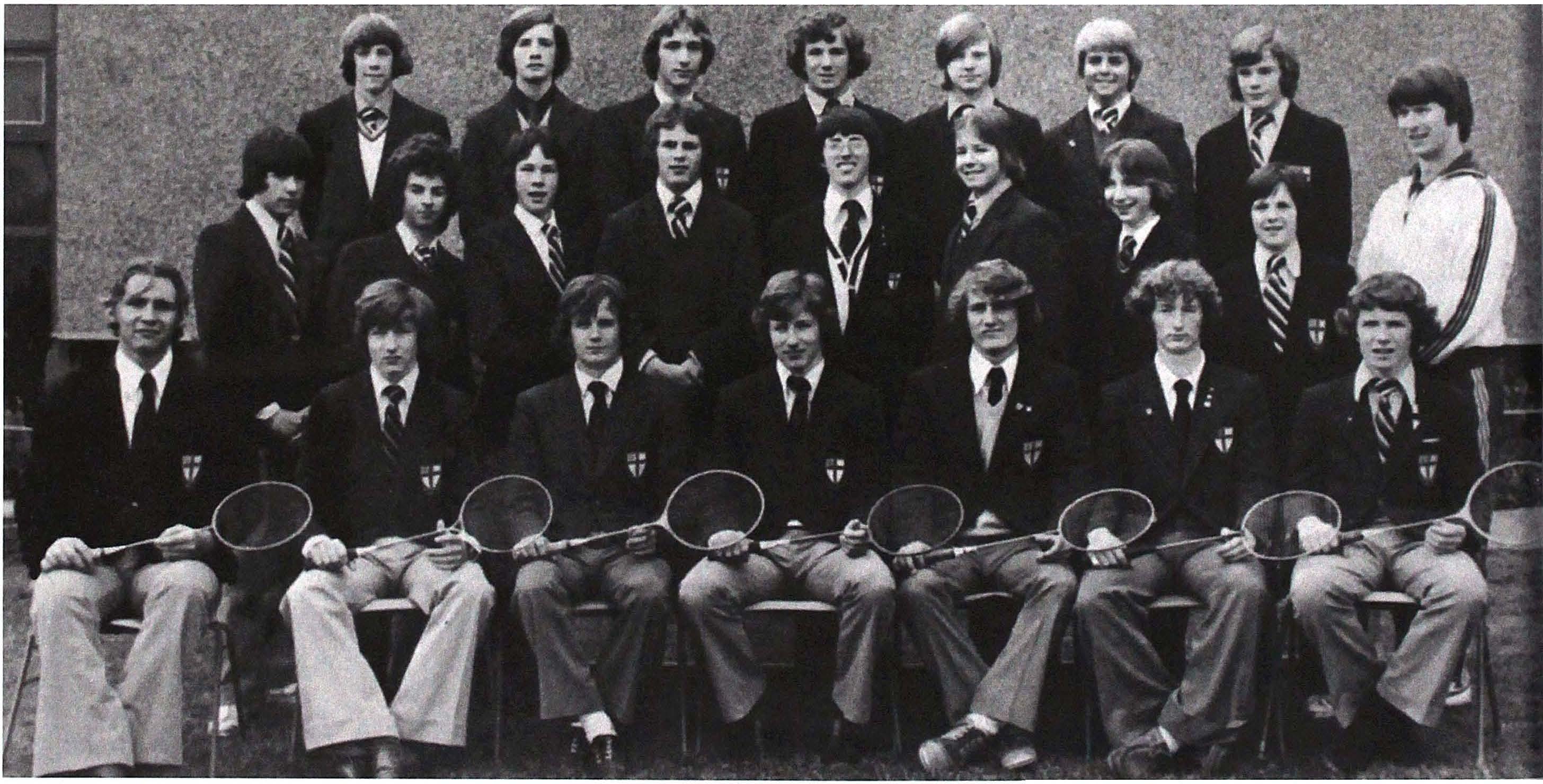
Third row (left to right): B. Rolfe, T. Wallace, H. Oundas, P. Rigg, T. Baker, P. Knickerbocker, A. Rigg.
BADMINTON'S GOLDEN AGE
Ray Stevenson was a young teacher in his early twenties when he joined the school in 1968. He remembers "just how ancient and British the staff were in those days." As the only "natural born Canadian," Ray says he often felt out of place:
There were Welshmen, Irishmen, Englishmen and Commonwealth connections via NewZealand andAustralia. The staffdrank tea at break time, sipping, asI remember it,from teacups held decorously with twofingers, pinkie reaching out into space. In theirfavourite corners ColonelReginaldBurton andJohn Coxwell, both magnificently moustached, would twiddle their whiskers into points. Not knowing what to do with myselfI would go down to the gymnasium to play badminton or coachgymnastics with the boys.

BELOW
114
Under Stevenson's direction, badminton became a major school sport with a golden age lasting two decades. The school team won the BC High School (BCHS) championships in 1974, 1975, 1977, and 1978. John Nicolls became the U16 Canadian champion in 1978, and Brad Johnston, Andrew Bibby, David Long, and Don Anderson were all top-ranked in BC at one time.

With the growth of badminton came a parallel growth in tennis. Indeed, many of the players simply changed one racquet for another as the balmy days of spring were replaced by the hot days of summer. Joining forces with Crofton House, the team soon established itself as a force to be reckoned with. In both 1976 and 1977 the team took the bronze medal in the recently organized BCHS championships.
John Weston had this comment to offer his coaches after the end of the season in 1976: "Congratulations on the improved play of our coaches-Mr. Reid (El Tappo), Mr. Ujimoto (Mr. Extra Tappo), and Mr. Stevenson, who would like to take this opportunity to offer you a bargain from his new company, 'Ray's Racquets.'"


llS
ABOVE Line-out activity in the 1973-74 season.
BELOW
Coach Hill and Headmaster Brown share an anxious moment
RUGBY
Garath Hill was hired in the early 1970S and was successful in producing many formidable sides throughout the 1970S and 1980s. The 1973-74 season saw the team capture the newly instituted BCHS championship.
The same team later toured England and Wales, then hopped across to France to play against Maison Laffitte, a club in a busy Parisian suburb. This proved to be the beginning of a particularly long-lasting and happy association, which in later years saw the Maison Laffitte team, with family and friends, tour BC in a fleet of motorhomes filled to the gunnels with the best of French wines and cheeses.
The team took the BCHS trophy again in the 1974-75 season under Captain Peter Hilton. Garath Hill, always a thoughtful, unemotional coach, objectively reported on the road to victory:

When they came together they produced a mixture ofaggressive and sparkling running. Throughout the BC tournament they did not cede a try and when one considers that this wasfive games in threedays, it was quite an achievement. To win a closelyfought final they had to produce the very best, and the try that won it was a beauty. DougHamilton broke through their centres, handed on toPeter Hilton, and the ball went throughfive pairs ofhands toMike Collins, who crashed overfor a glorious support try. Throughout the tournament the vitalfactors were Hamilton's marvelous aggressive defence, IanJones' domination at thefront of the line-out, Bibby's control and capable kicking atfly half, andBill walker's ability to set up triesfrom the centre.
An exciting event in 1975 happened off campus when Georgian Angus Stewart (,69), older brother of 1974 captain, Billy Stewart, captained Cambridge in the annual game against Oxford. In their defeat of Oxford's "Dark Blues," the Cambridge "Light Blues" ran up their highest score in the game's 97-year history. The crowd of 40,000 spectators included a fair smattering of Georgians, come to see their hero in action.

I Scrimmage. 1973-74 season. 116
THE RISE OF OTHER SPORTING EMPIRES
Although rugby remained the school's principal sport, there was a quiet but determined growth in almost every other sporting endeavour.
Basketball in the 1970S had its ardent followers who liked nothing better than to slam-dunk with Geoffrey Stancombe for an hour or two whenever the regular school program allowed. While the school would have to wait for the present decade before successfully assaulting the citadels of basketball power in the public school system, the beginnings of greatness can be seen in one of Geoffrey's reports:
It could be said that ifduring the course ofthe year we had scored 25 percent ofall shots, we might have been rated as the high scoring team ofall time, but the truth is, infoct, that someone kept moving the basket every time we had a breakaway.

Nevertheless with such "AllStars, " as "Brute" Clark, "Hankey" Homer, "Leadshorts" Goodman, "Undernourished" Unrau, "Bumbling"Busfield, and our big man, /1ngry" Ashforth, the team couldn't help but shock any team untilthe opening tip off
Swimming became an all-seasons activity with the advent of the school pool in 1969 and the bubble in 1971. As well as encouraging the growth of a competitive swimming community, the pool generated unanticipated income when it was used for a community summer school program. This also did much to improve goodwill among at least some of the neighbours. The experience thus gained probably helped Ray Stevenson shape his plans for the more ambitious project of Summer at
Hockey director Eric Stewart recalls that there St. George's in the 1990S.
Ice hockey, a relative newcomer on the athletic scene at Saints, was firmly established under English teacher and Georgian editor David Reid. Hockey director Eric Stewart recalls that there was always a lot of testosterone
was always a lot of testosterone around in those days when students and staff played, and that he found himself hospitalized on two occasions, once with a broken leg, and once with a sliced ear.
around in those days when students and staff played, and that he found himself hospitalized on two occasions, once with a broken leg, and once with a sliced ear.
117
Unfortunately, the accumulated silt in the line covered the bottom of the pool with two feet of mud, which of course had to be shovelled out and the filling process started over again.
Here he describes one product of the 1970S, the ''Ankle Cup":
Staff,manyofwhomhadrarelyskatedbefore, being mostlyofBritish origin, woulddon skates and play against thegrade 12S, those who were not a part ofthe regular team. On oneoccasion, NHL player and coachPat Quinn, our celebrity reftree for the game, gave a penalty against a staffplayer. His if.ftnce: "impersonating ahockey player. " The unfortunateEnglishman had been skating onhis ankles for much ofthe game!
Cricket prospered under the devoted care and attention of Chris Goodwin throughout the late 1960s and into the 1970s, culminating with a tour to the UK in the summer of 1971. The steadily shrinking interest in cricket in the public school system jeopardized the school's traditional commitment to the game because of the lack of competition. Garath Hill took on the team through much of the 1970S and had this to say about one member of his undefeated team in 1974:
Larry Unrau dominated city cricket this year, and in scoring 183 unbeaten runs in just three knocks has set a style and a standard unlikely to be matched in thefuture. In taking four catches and 19 wickets he made a massive contribution to his side's successful season. He was the mainspring and motivator behind both the VJ-a-side andXI-a-side city championships won by this year'sfirst Xl
FURTHER ADDITIONS AND IMPROVEMENTS

The bubble for the pool was installed in 1971 when the indefatigable Oavid Overton, known simply by his initials, ORO, once again spearheaded a drive to raise the $26,000 needed. The Auxiliary donated $4,500 and the balance came from fundraising bridge nights, a New Year's ball for parents and friends, and an auction with John Blackmore once again wielding the hammer.
The challenge of filling the completed pool fell to Ray Stevenson, who in a moment of brilliance decided to bring the nearest fire hydrant into service. Unfortunately, the accumulated silt in the line covered the bottom of the pool with two feet of mud, which of course had to be shovelled out and the filling process started over again.
Maintaining pressure in the bubble also had its challenges. Heavy snowfalls would collapse the bubble, power failures would shut down the blowers, and acts
118
of vandalism with a sharp knife or razor blade would release the air needed to maintain the bubble. After a collapse, Geoffrey Stancombe's Rovers and Venturers would come to the rescue, donning bathing suits and diving under the bubble in order to raise the heavy fabric and shed the mass of water now on the wrong side of it.

It was in the late evening one Friday, after the last wandering souls had disappeared from the campus, that teacher Stevenson and student David Bibby, with characteristic joie de vivre, climbed onto the top of the bubble and completed several classical gymnastic routines from end to end!

Such performances were soon to have an even better stage. With the school's insatiable need for new facilities it was only a matter of time before the new administration set in motion a grand plan for the construction of an auditorium. Three short years after Alan Brown became headmaster, the performing arts complex was formally opened. In addition to a 4oo-seat auditorium, the complex also included a small workshop that became the province of Geoffrey Stancombe's woodworking 8 and 9 program. The popularity of the two courses soon outstripped the size of the facility, with the result that almost as soon as the workshop's doors opened Geoffrey began his long, largely unheard lament for a bigger facility.
Beneath the auditorium a suite of small subterranean rooms provided space for backstage operations and offices. The complex also included a music room and a concrete bunker that has served as a physics lab, a math classroom, a makeup area for theatrical productions, and much else besides.
The opening of the performing arts centre was celebrated with St. George's first venture into the world of musicals-an acclaimed performance of the rock opera joseph andthe Amazing Technicolor Dreamcoat. The director was Bruce Pullan, who gave the school one year of a whirlwind career before departing to do other things. He was a charismatic head of the musicdepartment with a rich background in both English literature and choral work. In addition to staging a magicaljoseph, he also produced Peter Shaffer's RoyalHunt ofthe Sun and welded together an amazingly good barbershop quartet from some of the student body's rougher and wilder elements.
The Woodward Auditorium, the jewel in the crown of the complex, was soon to become a multi-purpose facility: a venue for assemblies, debating, theatre, band rehearsal, visiting speakers, and performers of every stripe, even a lunrhroom and a table tennis practice area.
I
119
Ray Stevenson coaches swimming under the bubble in days of yore.

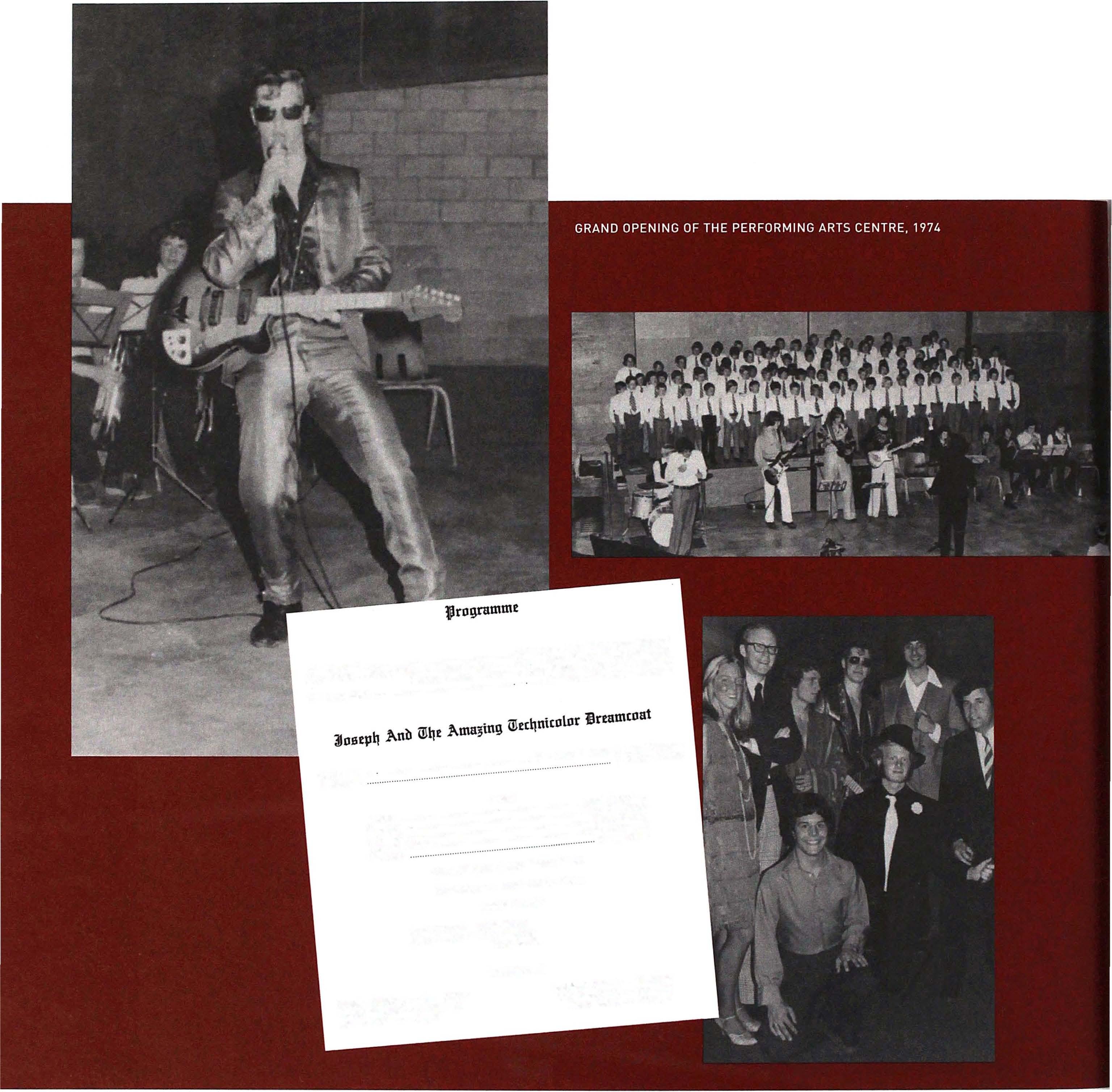 SChool Band
Selec'ions trom 'Pain' Your Wagon'
SChool Band
Selec'ions trom 'Pain' Your Wagon'
Piano
Duel _ Harry Klllas & Jackle Parker Pieces trom Bizet's 'Jeux D'Entan's'
Playing
Hou,., Badmin,on, Soap Bubbler, The Doll, The Ball
The Glee Club
Evaline,
Liltle Innocen' Lamb Composer Tim Rice 8. Andrew Lloyd Webber Conduc,or C. Bruce pullan CAST Joseph Brad JohnS,on Pharaoh Jack Craddock po,lphar ..... David Romer Wile ot Poliphar . .. JuUe Richmond Narra,or Harry Killa. CHORUS (The Junior SchoOl ChOir) Choirmaster _ Frederick G. carter ROCK GROUP Brad St8wart Chris watts John Dexter Gordon MacKey Tony Jewitt ORCHESTRA Gordon Kruberg saxophone Fraser MacKay saxophone Jackle Parker Organ Stephen Chung Trumpet oon Armstrong Trumpet Chrls Boxall Trumpet 120
FAREWELLS

As in previous decades, the 1970S saw some staff members retire. The Colchesters had arrived at St. George's in 1947- In the early days, Garry took over the two libraries and with great versatility moved her collections between a number of different dark and dreary basements. At the Senior School she was at last able to spread her wings in a custom-built facility that she had helped design.
As well as being a librarian, she was an imaginative Georgian editor who fully recognized the potential of new technologies to change the way we communicate. In the 1966-67 Georgian she wrote about taking advantage of "opportunities for the cheap and efficient reproduction of photographs and other illustrations [that] now allows us to relinquish what had become a confining frame for the proliferation of our activities."

Edmund Colchester had served as senior master, assisted with the architectural work and planning of the Senior School in the early 1960s, and had run the Dragon Sea Cadets for the better part of a decade.
For the intellectual and artistic cognoscenti, the Colchesters would be warmly remembered for hosting many evenings where the faithful discussed books, provided critical comment about each other's prepared papers, listened to an eclectic selection of music, and planned the cultural activities that took the Arts Club out and about in the city.
Tommy Roxburgh was the much-respected coach of the first XV throughout the 1950S and the 1960s, and coached the team for the 1956 tour of Australia. He also taught English literature, which was not a specialty attracting a coterie of aesthetes but one of the most popular courses in the senior curriculum. He had a wonderful way with words and could quote something for each and every occasion. As Tommy aged it became more difficult to get him to speak in public, but there were occasions when he could be cajoled into the flights of verbal fancy that endeared him to so many Georgians. One such occasion was a House Supper where he made the following toast to the ladies:
In my youth-about the turn ofthe century-underfor distant skies in the Land of the Heather and the Haggis, "Every day was Ladies Day with me. "I used to chase the girls with a wild abandon. "Up the meadows and over the lea, there was the chase ofthe lassies and me. "Inlater lift the pursuitcontinued, but it was ofnecessity downhill. And now, enfeebled in mind and body, I can no longer remember whyI
121
IThe Colchesters bow out gracefully after 23 enjoyable years at Saints.
was chasing them. Doubtlessfor some worthy purpose
I am no wordsmith, I am no soothsayer (notfor me thefluted phrases and the purple passages). I'm an ordinary man and as such bespeak your Christian charityfor the ninthBeatitude: Blessed are they that expect nothingfor they shall not be disappointed.

A COUP TO CLOSE THE DECADE
As early as the late 1960s both the neighbourhood and the city had had enough of the school's boarding houses. A newspaper article from the time communicates the ill will felt by many:
St. George's private school at 4175 vvest Twenty-ninth was told Thursday to improveits relationswith neighbours orfoce loss ofzoning privileges. The zoning board of appeal allowed the school to continue using nearby homes to board boys, in contravention ofthe single-fomily zoning in the area, untiljune 30, 1969. An extension will be considered at that time, but the board made it clear this would depend on the school improving its relations with nearby homeowners.
The DunbarHomeowners'Association opposed continuance ofthe boarding homes ongrounds the school's property is deteriorating and isloweringsurrounding property values. School officials said the school would be in serious financial difficulty ifit lost revenue from the boarding homes.
"While you've done a goodjobfor your students, you've neglected public relations with your neighbours and with the city, " said zoning board chairman Tom McDonald "It's now up to the school to do a goodjob and win the support ofits neighbours, " he added, noting that since the matter came up last month, some schoolbuildingshave been repainted
How the school managed to hold out for another 10 years in the face of such oppositioncan only be guessed at. Indeed, when news reached Alan Brown's desk that the Convent of the Sacred Heart was to be sold it really was an answer to a prayer-and a good example of the benefits to be derived from the Catholic connections established in the school's early days. The board quickly struck a committee that proposed terms of acquisition to the convent's Vancouver representatives, Sister Lannigan and Sister Page. The offer from St. George's was not the highest, but long association and mutual goals soon resulted in an agreement
122
acceptable to both parties, and the deal was signed in 1978.
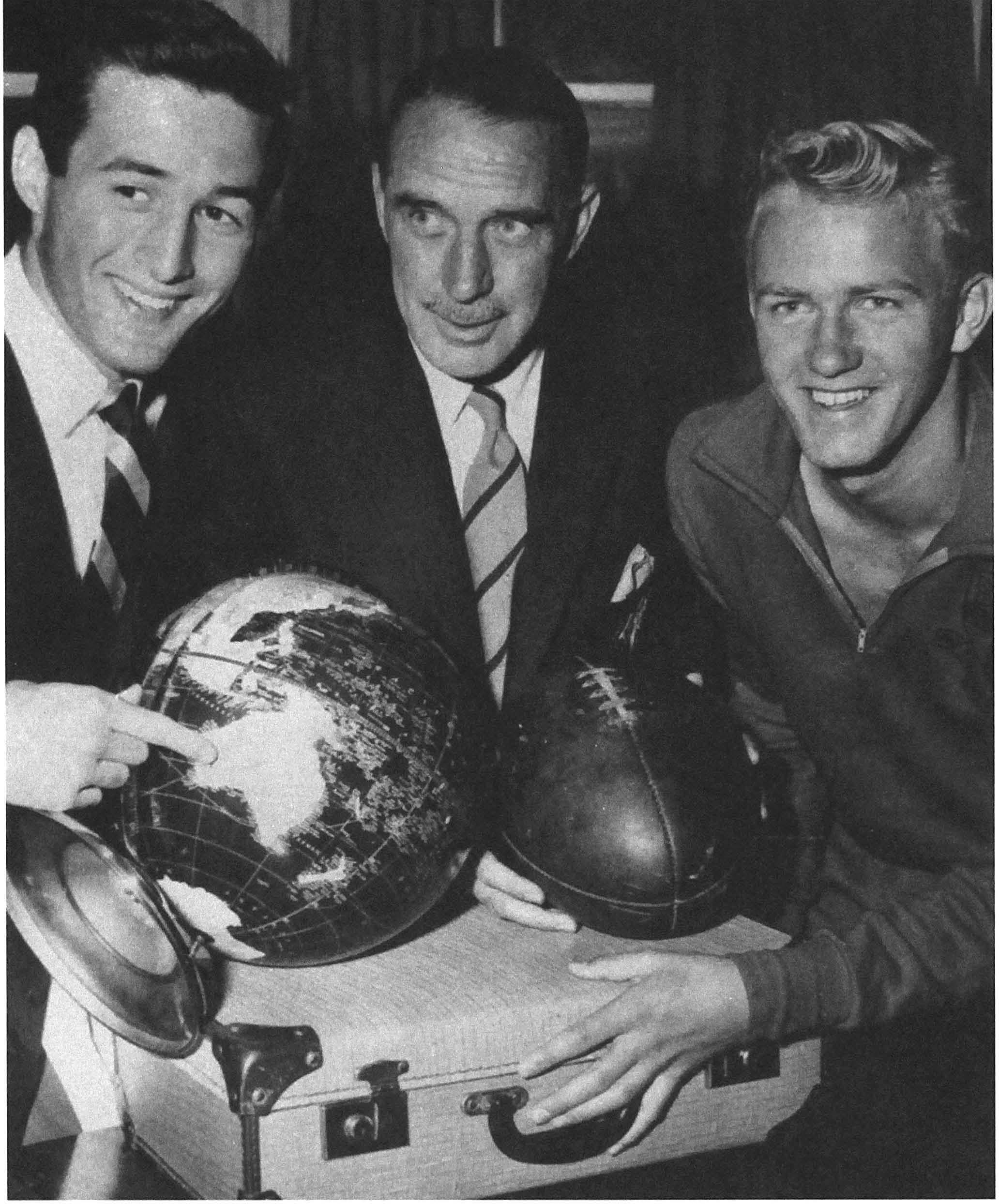
At a cost of $2,050,000, the convent building and its 9.5 acres of land was a steal, even though Alan Brown tried to convince anyone who would listen that the good sisters had driven a hard bargain. The modifications required to bring the building up to code would cost a further $750,000. Work was initiated in the fall of 1979 to install a comprehensive sprinkler and heating system, to construct four earthquake-proof walls, and to modify the upper floors to accommodate the boarding house. Simultaneously, plans were made to demolish the old school buildings and sell Block 60. With the acquisition of the convent property the school finally had the land and the buildings to ensure its future. At last John Harker could rest in peace!

123
I
Tommy plans the Oz adventure in 1956. many years before his retirement in the 19705.
1980-1989
The 1980s: Going Gothic with a New Junior School and Library
1980 Block 60 sold
Old school demolished
Students, staff, and boarders move into the refurbished convent
1981 St. George's Golden Jubilee Year
1982 April, Canadian Constitution repatriated from England

Minh Thai wins first world Rubik's cube championships in 22,95 seconds
1984 One-time student Jon Kimura Parker ('77) wins the Leeds piano concerto competition
December, Senior School moves into portables
Tony PJ retires
1985 Senior School reopens after major renovations
1986 Kevin Robinson wins the Milrose Games Mile
Expo 86
1988 1989
John Blackmore retires
Teaching staff and board members attend Harrison Hot Springs retreat
Alan Brown retires
Gordon Atkinson retires (for first time)
John Parry takes over as Junior School principal
June 4, Massacre in Tiananmen Square
October, San Francisco earthquake November, Berlin Wall falls
December, gunman kills 17 female engineering students in Montreal
I The "Cell Block" falls under the wrecker's ball, circa 1980,



126
6Going Gothic with a New Junior School and Library
THE 1980s BEGAN WITH ALAN BROWN'S SECOND DECADE in office and ended with his retirement. The decade saw the sale of Block 60, the move to the refurbished convent, and the demolition of the old school buildings. In middecade the low profile of the original Senior School building was altered as a new library, gymnasium, and swimming pool rose to dominate the modest structures of the 1960s. Internationally, the Soviet Union disintegrated. The fall of the Berlin Wall and the execution of Romania's Nicolae Ceausescu symbolized the political forces that were to reshape the world of the 1990S. An earthquake in San Francisco forced a serious review of the structural integrity of the cherished convent.
At St. George's, finding the fastest solution to the Rubik's cube had become an obsession on both campuses, with boys in grade 8 visiting the headmaster's office to discuss the finer points of manipulation and wager with him over who could do the puzzle faster, while staff and parents fulminated for an appointment outside.
When Alan Brown wasn't taking on all corners with the Rubik's cube he was working on his computer. Before the end of the decade he had programs in place to track the school's accounts and Craig Zacharias, our computer specialist, had developed a program to generate marks and reports.
There were staff retreats involving the board, some on the property, others in exotic places like Harrison Hot Springs. These meetings initiated an approach to decision making at all levels that was more transparent and democratic. Eventually these deliberations would produce a Mission Statement that has served to guide much subsequent decision making.

Ringing the old school out for the last time on the evening of March 7. 1980,
Left to right: Bill Norris ['641. Barry Nielsen ['64! standing at back. Mark Steven [. 68! and Oerek Simpkins [. 64! with their hands on the bell.
127
BELOW, LEFT
Robin Baker smokes it up with the world's biggest stogie.
BELOW, RIGHT

The 1989 Georgian captures the theme of .. school photographs" with the famous Hasselblad camera of Oougal Fraser.

THE GEORGIAN
Robin Baker steered the Georgian ship through eight editions before handing it over to Daryl Wakeham for the 1989 edition. Characteristically modest and unassuming Baker persevered with the yearbook until there was a suitable symbolic point at which to let go. In 1981 he had moved the yearbook from softcover to hardback productions with the plush coffee-table book look now taken for granted. Colour was introduced for the end sheets, then slowly, and expensively, for much of the book. With "The Wheels" edition in 1984, Baker introduced the thematic approach. It has been a constant ever since, allowing each editorial team to exuberantly explore wherever a particular theme leads.
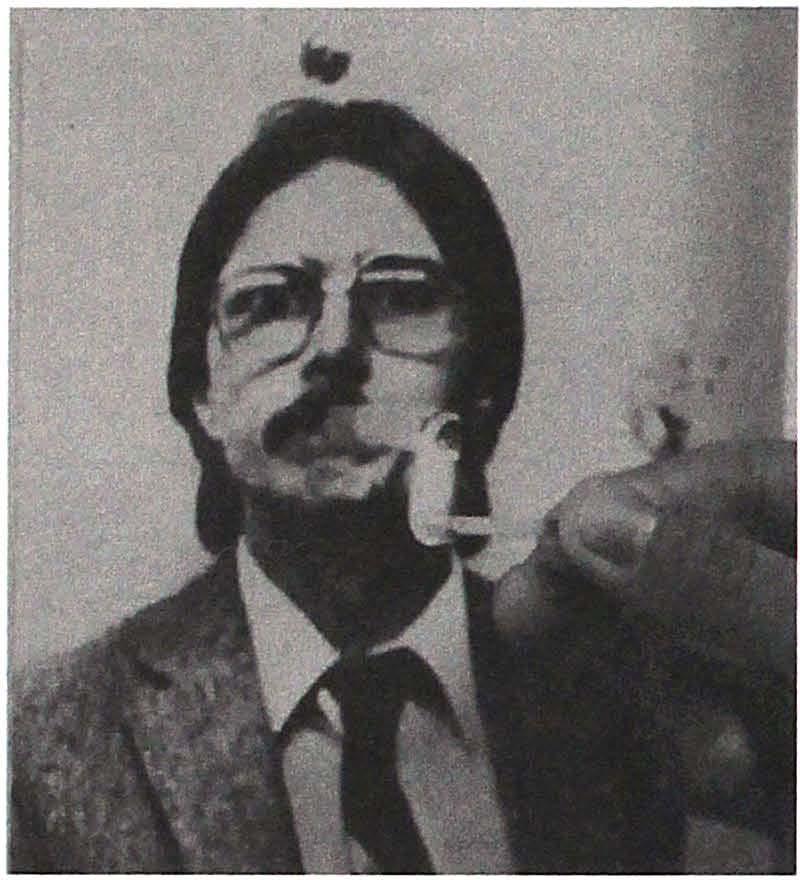
128
DRAMA AND MUSIC

Drama continued to be a burgeoning force on both campuses. Directors Royston Brunst and Dougal Fraser at the Senior School mounted major productions in the same year, offering both musicals and serious drama in collaboration with York House and Crofton House.
The musicals, with their large mixed choruses and orchestras, inevitably called forth the involvement and expertise of the music department. Soloists and choruses had to be trained, and instrumentalists had to be turned into effective pit orchestras.
There were also grade 8, 9, and 10 productions. Garath Hill gave us The Thwarting a/Baron Bolligrew, which featured the then-cherubic Jeremy Sayers in the title role.
At the Junior School Clive Austin gave us a magical Dliver in 1981-82, and Carnival the following year. George Ryan followed with a string of productions for which he wrote the narrative, the lyrics, and the songs and also directed the casts of thousands.
In 1987 Kevin Armstrong took over from Fred Gass as head of the music department. He made no claims to being a great instrumentalist himself but gave his bands a strong sense of the importance of self-discipline, which enabled them to become increasingly successful in competition at festivals around the Lower Mainland. The Senior Concert Band toured California in 1983-84 and Europe in 1989, giving concerts in Germany, Switzerland, and Austria.

CLOCKWISE. FROM LEFT Baron Bolligrew [Jeremy Sayersl and The Duke ICam McLarenl discuss a fowling piece.
Dougall Molson as a youthful Fagin. 1982.
Chuck Chand tries his hand at busking In the Kornmarkt in Lucerne.

129
EPIC SENTIMENTS IN 50 WORDS
The Greatest Canadian
He created our wealth
Explored our vast interior
Brought over our immigrants
Warmed our cold winters
Built our many dams
Raised a wonderful family
Eventually, he came to symbolize the best of Canada
And in the end, made the ultimate sacrifice for Canada
Thank you.-Mr. Beaver, the greatest Canadian -Mike Paulus, grade 11 1# 1)

The Journey of Dinner
Tender, green grass was cut short by meandering lips, turning her fat rump into a walking mountain. Slaughtered, butchered, packaged, loaded, driven, unloaded, bought, sold, and unpackaged it hits the barbeque-next stop: my plate. It's then to mouth, over gums, down throat to stomach wherein it becomes dinner, -Oan Owen, grade 11 1#2)
A Really Scary Story

It's dark and gloomy in the shop on the corner. Its windows are barred and the lights are dim, I slowly creep towards the little shop of horrors, The handle is stained with paint. My sweaty hands open the door, GOBLlNSI ALlENSI SPIOERSI MUTANTSI love the comic book shop.
-Jason Chen, grade 11 1# 3)
NEW ARTS TRADITIONS
Philip Rigg died in 1975 at age 17 after a long and courageous struggle with cancer. He was a talented artist, athlete, and scholar. His family and friends established foundation scholarships in his memory that have been used over the years to promote the arts. During the 1980s Nancy Oliver and her music and drama colleagues made a grand occasion of the Rigg Awards, staging an art exhibition, a dinner for the scholars-over which some member of the Rigg family preSided-and a concert for the senior grades and invited guests that featured work by the year's scholars.
In 1988 Arts Week was introduced and has remained one of the most exciting events of the year, eagerly anticipated as much by the staff as by the boys. Performances and workshops during assembly, at lunchtime, and sometimes after school by invited filmmakers, rock stars, street poets, and wacky collectors from New York garrets have been an endless source of delight. Certain activities have become constants. One of these is the contest of the mini-sagas: 50-word "epics" written by staff and students. The week culminates with the three winners in each grade reading their contributions in front of the school.

OTHER DIVERSIONS
Variety Night, a student-organized event that started in 1979, continued on through various metamorphoses into the present. Originally it involved York House and Crofton House in an evening of skits, stand-up comics, and rock bands; it evolved as the decade discovered new and exciting ways to be entertained. There was a competitive element with prizes, and profits went to charity. In defiance of Orwell's grim predictions, Variety Night in 1984 was a particularly lighthearted affair abounding with talent:
This year'sfestivitiesincluded our ownStageBand, with two well practised numbers, followed by a hilarious bee-keeping sketch by Chris Marshall and Craig Nichol following a very polished piano solo by Teresa Shaw.Paul Westwick gave us a wonderful sketch entitled the"Masochism Tango." Not only did he receive a standing ovation and two encores, but later he teamed up with our own Mr. Bacon for a number which took ajab at officialdom.fndridson returned briefly as a car salesman and then we were treated to a professionally executed presentation ofbreak dancing and street dancing by a group ofgrade 9 boys.FinallyJud Martel andAlex Tsakumis teamed up for a great satire ofour headmaster's idiosyncrasies in "He Goofed Up."

Under the guidance of that extraordinary man, Bob Bacon, the Physics Olympics Club met annually to construct machines to perform insane and unimaginable tasks for competition at UBe. Andrew Farrall captures the pioneering spirit of the 1986 team:
This year's competition occurred after a weekoffrantic popsicle stick gluing, bike bashing, and lunchtime dry runs prepared by Mr. Bacon.Our two teams spent the first day oftheir spring break competing against 50 other schools at suspending rocks in beakers ofwater, sliding blocks ofwood down inclined planes, stretching piano wires, and hammering computer buttons in response to physics tn'via questions. Unfortunately we seemed to be outclassed in these events as well as those involving our prebuilt masterpieces: our popslde stick crane showed early strain supporting heavy weights, and our slow-moving bicycle with its steamroller wheel well, it had to be seen to be believed. However, our B team placed a respectable third in the "light beam" event, and ourA team commanded afirst place infinding an unknown electrical resistance (despite cries of"Don't turn the power on, I'm still holding the wires").
FROM TOP Obedient to the laws of physics. Bob Bacon takes a ducking at the Country Fair.
Paul Westwick-an unlikely talent-presents the evening's tour de force.
FACING PAGE
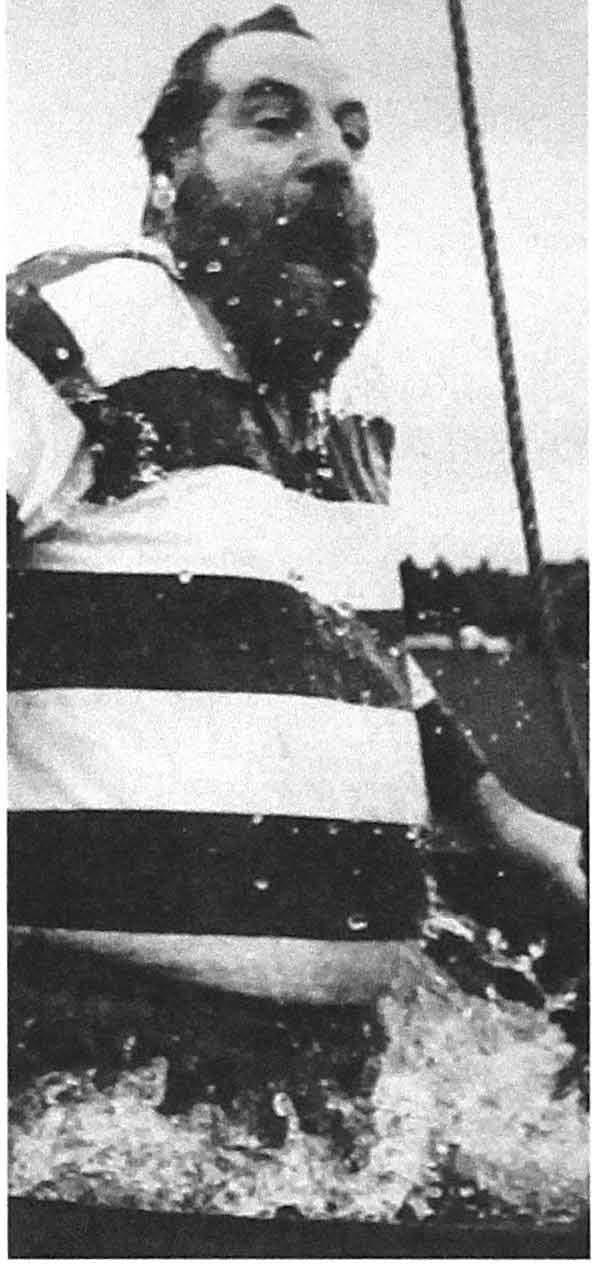

The 1989 Rigg Scholars for the Visual Arts
From left to right: Wade Mitchell. Peter Tessier Ihonourable mentionl. Patrick Simpkins. Jason Camp
131
VARIATIONS ON HOUSE SUPPERS

In the mid-198os House Suppers took a new direction with the introduction of an emcee to coordinate what had always been a hastily contrived, last-minute affair. David Sufrin filled the role with great good humour and a gift for dramatic entrances:


After the annual mauling ofthe "Viva-La,"the prefects' skit, "Faculty Feud,"was completely hilarious with GavinReynolds as a near perfectMr. Baumann...Henry Reeve parodied the assembly's usual litany ofannouncements... the "Good OldDays"explored the self-indulgence ofsuffiring with aPythonesque touch...Dik Miller and CedHo took us to the localIn-Tourist office to plan a trip toRussia a rousingrock revival proved the staffhave talents that go wellbeyond teaching... The last word, however, must speak ofthe man who organized and hosted this year's entertainment (read' who stole the show). From the standing ovation which greeted hisPee-J;#e Hennanesque entrance on a bicycle, his energy and humour neverflagged
QUIZ SHOW SUCCESSES
The Reachfor the Top teams continued to do well, winning the provincial championship in 1984 and 1985. The 1984 team went to Regina for the national competition and fought their way into the semifinals where, according to Aaron Blumenfeld, they "played what was perhaps the most exciting game of the tournament.Bolstered by a 4o-point identification of Grant Devine ('I was born in Regina' ... Bang!), we led all the way, that is until New Brunswick beat us on a Bible question with five seconds left on the clock." The following year the team went to Moncton for the national competition, only to be knocked out by Nova Scotia in the first round.
132
Another TV quiz game, Genies en herbe, was introduced in 1982 with French immersion students in mind. The winners of provincial competitions would compete for the western title and then the winner of that contest would face a champion from the east and compete for the national title. Competition was stiffest nationally because so many teams from the east were francophone. The Saints teams won the provincial competition every year from 1982 to the end of the decade, and in addition took the western title in 1982, 1984, and 1986. The 1986 team even managed to win one game in the tough national competition against francophone opponents, finishing in seventh place. According to Coach Eric Stewart, Tom Boytinck surprised everyone in that series: "In a 40-point identification question, the first few words of the clue had been given when he buzzed out of nervousness. Forced to come up with an answer, he muttered in desperation, 'Francis Ford Coppola,' and to his and everyone's surprise that was the answer."
ABOVE
Reach for the Top team members relax with their coaches. 1984.

From left to right Mr. Cam McLaren, Mark Cameron, Aaron Blumenfeld, Robert Shaw. Adam Melzak. Mrs. Janet Webster.
FACING PAGE, ABOVE
Paul Baumann and his House Supper look-alike, Gavin Reynolds.
FACING PAGE, LEFT
David Sufrin arrives with skateboard and crash helmet to open the House Supper.

133
ABOVE Pringle House in 1980.

FACING PAGE, ABOVE Members of Pringle House, 1980.

From left to right: Wayne Canary, Steven Brand, Ameet Parikh, Steve Cooper.
FACING PAGE, BELOW Nurse Norma reflects on life after the ··Great Move.'·
THE "GREAT MOVE"
The refurbishing of the convent that began in the fall of 1979 was completed in March 1980, but only after the school put considerable pressure on the contractors, who responded in magnificent fashion. One hour before the scheduled move, the fire marshal and the building inspectors were sufficiently satisfied to give the school a temporary interim occupancy permit. With obvious pride, Alan Brown tells the story of the good humour, hard work, and initiative that he witnessed during the "Great Move":
John Blackmore had his senior boys in grade 7 assist in shifting the wonderful old convent desksfrom thegym, where they had been stored, to the new classrooms... OnFriday the seventh, whilst allthe OldBoys were enjoying their dinner in the doomedJunior Schoolgym, the residents ofthat building moved out. With the assistance ofover 200 Senior School volunteers, the building was virtually stripped and by nightfallthegrade 4S to 8s were settled in their new surroundings.There were no carpets in their corridors, no hot water in their showers, the lights were dangling bare bulbs as often as not, but they were in, warm, excited, and happy ...
At 9:00 a.m.onMonday, the entire Senior School, descended on theJunior School and carried every movable item, including alldesks, chairs, books, common room contents-everything-down to the convent.Such was the swiftness ofthis operation that by 9.']0 on that morning theJunior School was actually in class and
134
under instruction, so thatfor them, grades 2 to 7, the total amount ofschool time missed because ofthis transition, was 30 minutes.

The boarders were of course moving into a new home at the same time, some from staff housing in basements and attics, others from the dormitories of the main boarding house. Alan Brown relates how the boarders began to put together their new IKEA furniture: "Many of the boys worked until midnight before the job was finished often assembling the furniture of other students involved in activities on Vancouver Island or the Lower Mainland."
The move was undoubtedly a big one for the boarders, who were leaving behind small satellite communities to which they had all belonged. Steve Cooper ('80) describes the joys of living at Pringle House:

Blessed with such a variety ofpersonalities PringleHousefinished the year infine fonn.Any house would be proud to host the likes ofWayne Canary, house stockbroker and philosopher; Steven Brand, house romantic and musician; andAmeet Parikh, house discofon and a great help in the kitchen. But despite this variety, we did have common interests-namelySteve's love lift, our dislike ofdisco, MA.SH at 6.'00, and thefine art ofmaking afost buck. Our thanks go toMrs. Brunstfor putting up with us, donatingfood, and helping the new boys keep their sanity.
The new San in the convent soon became a very convenient refuge, as Nurse Norma Parker reported for the Georgian that year. "Certainly life is never dull around here when your living quarters are walled off by the Senior Common Room (or 'wrestling ring'), the Junior Common Room (or 'three-ring circus'), and the illustrious junior showers, an area which quite defies description The 8:00 a.m. sick call continues to bring dozens of the 'nearly dying' to our doors."
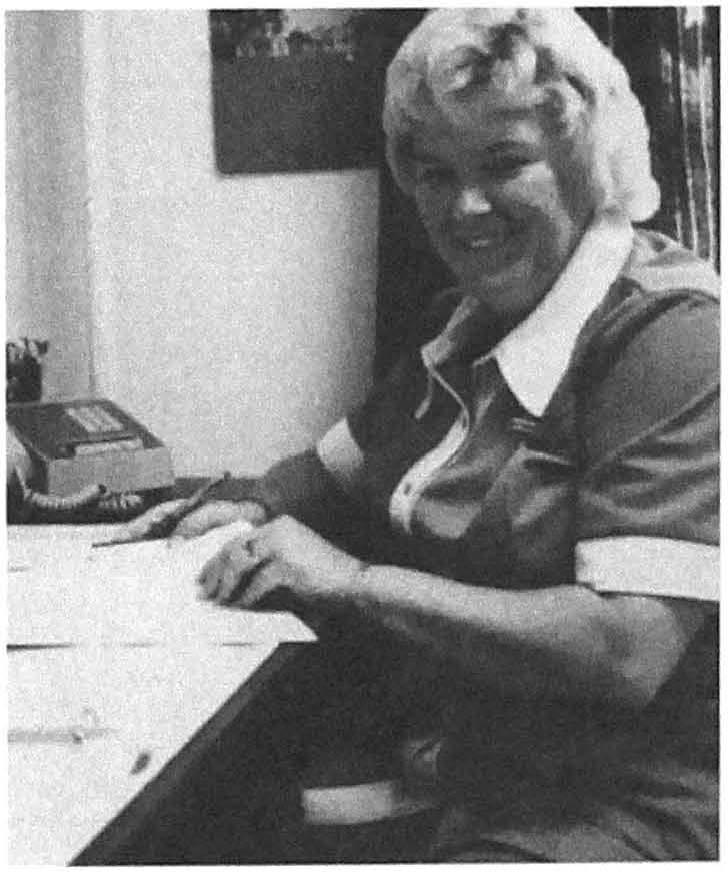
135


 I Moving and even, perhaps, singing in the rain.
I Moving and even, perhaps, singing in the rain.
LAST SUPPER


On March 7, 1980, the move to the convent became the occasion for an Old Boys "last supper" in the old gym. The school band played "Thanks for the Memories" as everyone arrived and took their places for a sumptuous meal of prime rib washed down with porter and red wine. The main attraction of the evening, after an entertaining impromptu speech from Douglas Harker, was the Memories Auction. As the gracious old building would be falling under the wrecker's ball the next week, everything had to go. The school sign fetched $350, the main front door went for $400, and one of John Harker's canes raised $50. There was an air of unreality about the proceedings as the revellers staggered out into the damp March air loaded down with their trophies.

The bulldozers soon rolled in and quickly made rubble of the heterogeneous assortment of buildings that had been St George's school for nearly five generations of students. The sale of Block 60 followed shortly after and realized very nearly as much as the purchase price of the convent property.

FIRST MAKEOVER OF THE SENIOR SCHOOL
The convent proved to be a most attractive, even an awe-inspiring building. Its soaring spaces dwarfed the little people who now thronged its halls and classrooms. The teachers delighted in the new-found freedoms afforded by generous office spaces and classrooms. The magnificent halls, wainscotting, noble staircases, and atmosphere of baronial splendour were evident to even the most casual visitor. By comparison, the premises on Topside had begun to feel cramped and inadequate, as new and exciting programs continued to be crammed into the curriculum.
A major fundraising program was initiated in 1982 in response to the perceived inadequacies; architects and contractor were hired with the aim of giving the school major new facilities, including a library, swimming pool, second gymnasium, cafeteria, and laboratories.
On December 13, 1984, the Senior School moved lock, stock, and barrel out of the building that had been the "new" school only 20 years previously. A temporary home had been constructed from portables on the tennis courts. Despite minor inconveniences, teachers and students quickly settled in, making do with remarkable goodwill as the construction crews moved in their heavy machinery and erected fences to keep out the curious. Alan Brown describes these temporary arrangements:
The building, made up of42'x24' trailers connected atjloor and ceiling height in such a way as to make corridors out ofthe spaces between these units,fits precisely onto ourfive tennis courts, with an average ofsixfeet to spare around allsides. There are rough analogues here to almost all ofthefocilities in the old school- three labs, two art rooms, a library, audiovisual room, grade 12 room, masters' common room, and the eqUivalent number ofclassrooms. There are some deficits, however. vve have no changing rooms now, and boys are changing in the corridors, the classrooms, the washrooms, or wherever they canfind a space. Where boys used to have afullbook locker and haIJa games locker, they now have one haIJlockerfor allsuch needs.
The new facilities were officially declared open in May 1986. In the same month that the citizens of Vancouver got their Expo, St. George's got an almost brand-new Senior School.
FACING PAGE, ABOVE
The last supper in the old school gym: one of the more sedate gatherings on an emotional night.
From left to right: Douglas Harker, John Blackmore, Patrick Moore ('651. Derek Simpkins ['641. Alan Brown ['541. Bill Clarke [.491. Bill Murdoch,
FACING PAGE, BELOW
The old school, loved by so many, succumbs to progress,

139
ABOVE
The Honourable Henry Bell-Irving, former Lieutenant-Governor of BC. wields the scissors and declares the new building open.

From left to right: David Rolfe Iboard chairmanl. Alan Brown Iheadmasterl. the Honourable Henry Bell-Irving, Bishop Gower, Douglas Harker.
FACING PAGE

Tim Turner's smile and camera capture the world.
ENVIRONMENTAL AND OUTDOOR EDUCATION DEVELOPMENTS
During the early 1980s there was a growing awareness of environmental issues at St. George's. The school hosted conferences where eminent workers in the field addressed audiences of young people gathered from around the city. Inventories were made of the way the school consumed energy and managed its energy resources. Various organizations concerned with the environment came into being at the time, culminating in the Green Machine of today-a student group that recycles all the school's office and classroom waste paper.
The many outdoor pursuits available at Saints began to place a greater emphasis on appreciating and preserving the province's magnificent heritage of inland waters, forests, lakes, and mountains. Concerns about preservation soon seeped into curricula, with both the humanities and the sciences grasping the nettle of forestry, water, mining, and energy issues that have become the abiding concerns of the new millennium.
The catalyst for much of this change was a charismatic geographer, Tim Turner, a man with a mission. He was instrumental in getting the Auxiliary to finance the purchase of the school's first kayak fleet and in relocating the grade 10 outdoors program from Strathcona to Howe Sound. After leaving the school in 1985, he established his own successful outdoor school on Keats Island.
140

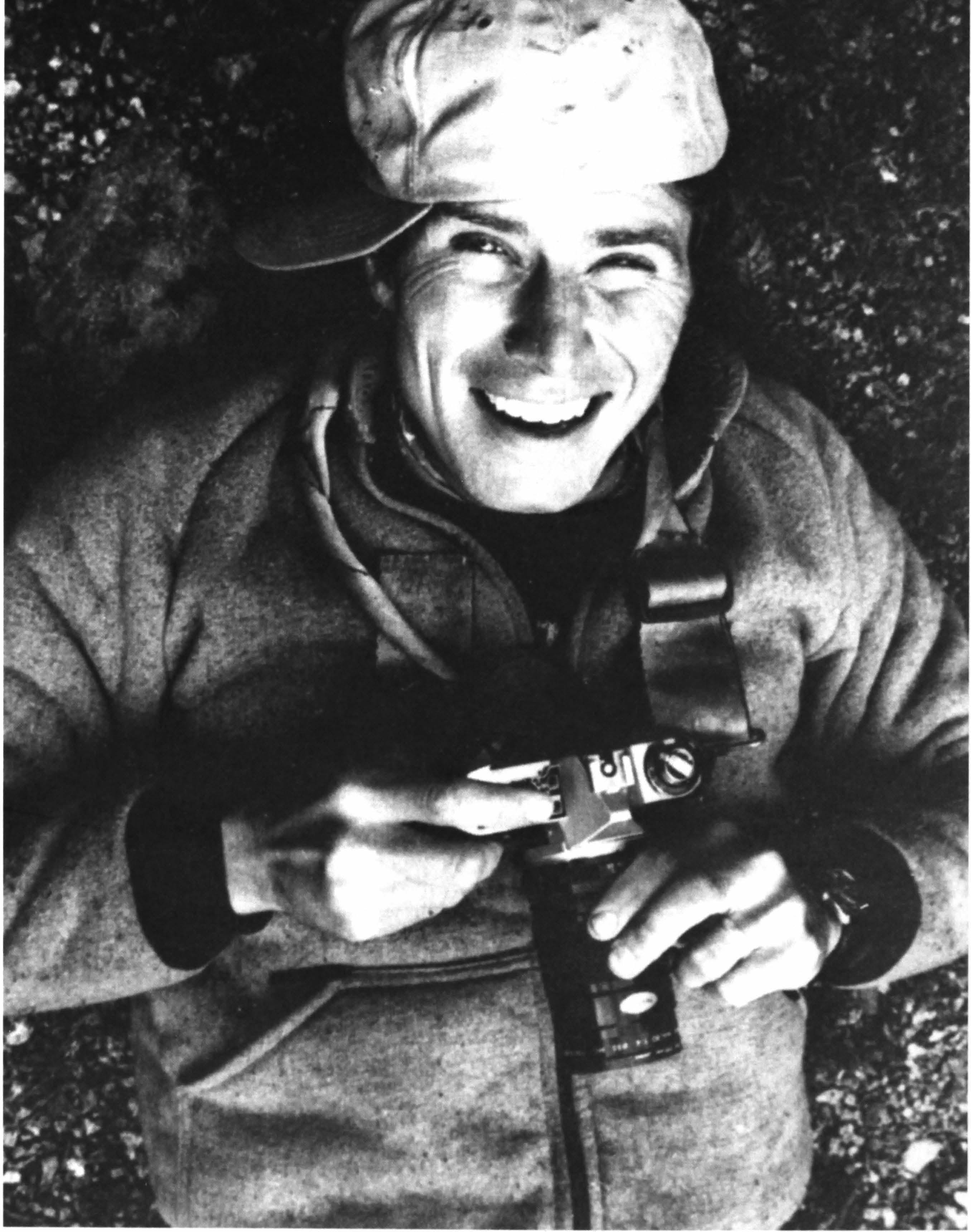
141
ABOVE
The first XI in action in 1984, the same year they placed second in the BC High School championships.
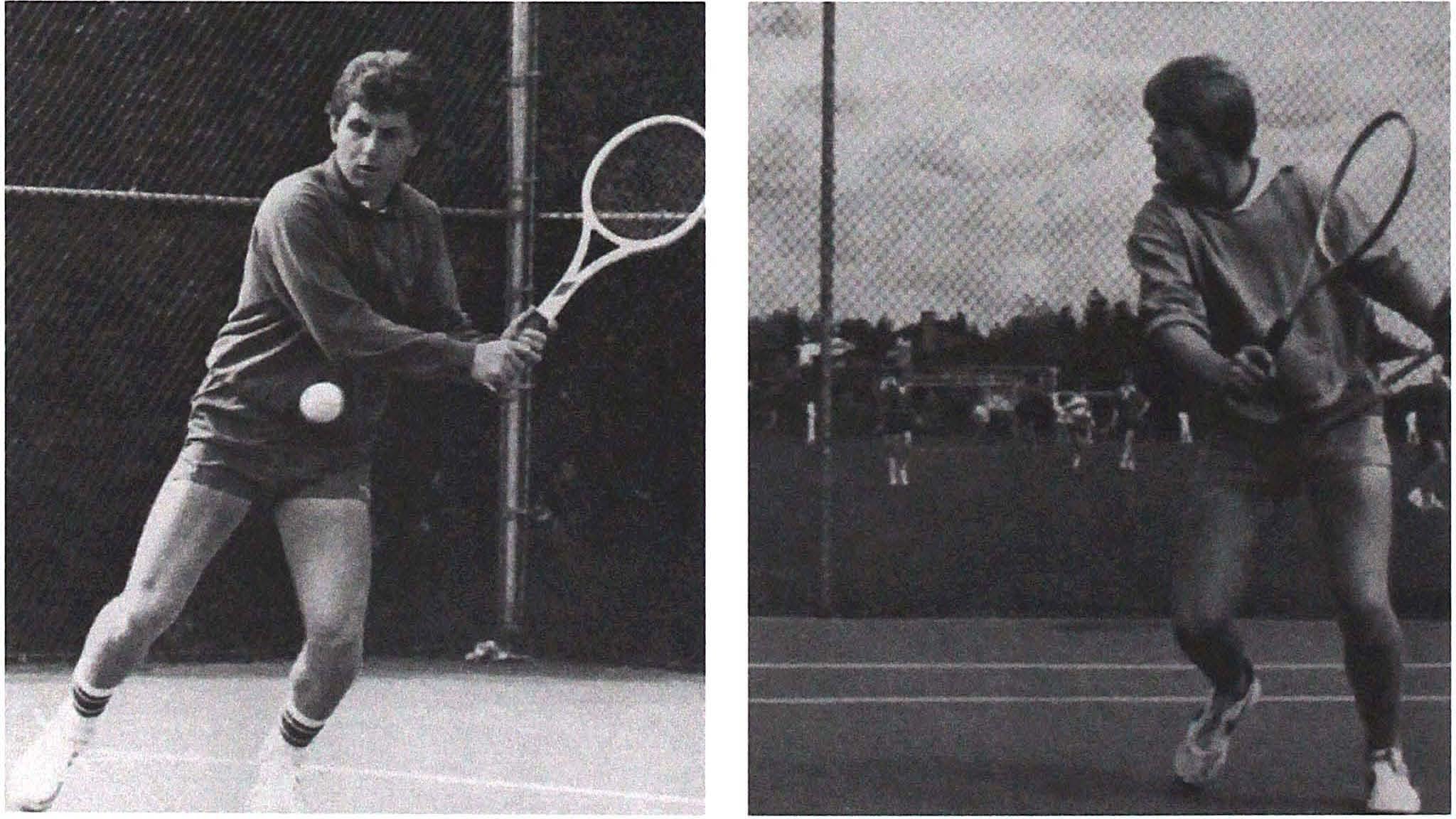

RIGHT
Zdeno Rusnak [left) and Gareth Jones [right).

142
MORE SUCCESSES IN SPORTS

In the 1980s the badminton team competed in the BC High School (BCHS) championships and placed in the top three in every year but one. They won gold four times, silver twice, and bronze twice. The Molson brothers, Dougall ('87) and Mike ('86), Dean Shepard ('86), Erik Nilsson ('85), and Darryl Yung ('90) were the stars. They were all top-ranked in BC and Darryl and Dougall went on to take the Canadian U16 title.
The large and successful field hockey program begun by Michael Smith in the 1970S continued to enjoy considerable success. In the absence of established public school programs, the teams played at the club level, enjoying stiff competition in local and provincial tournaments. When Smith left the school in the mid-1980s, a search was initiated to find a worthy successor. The judicious phrasing of the ad resulted in a lucky catchChris Healy, a French-speaking Scotsman and international hockey player with just enough Latin to survive teaching a first-year Latin course. Since the 1970S the program has produced a succession of players who have represented both BC and Canada, including Mark Roydhouse ('76), Jeremy Dodds ('76), Steve Ingvaldson ('81), and Chris Ingvaldson ('87).

The tennis teams in 1984 and 1985 placed second and third in the BCHS championships under the mentorship of Ralph Skinner. In 1984 Gareth Jones and Phil Du Moulin won the men's doubles trophy and Zdeno Rusnak the sportsmanship trophy. In the following year Jones, this time partnered with Jon Paul Walden, again won the doubles title. Ed Siemens took the best singles title. It should be remembered that in BC competition the team also included ladies from Crofton House.

143
ILEfT Andrew Stephens delivers a googly.
BELOW
Oarryl Yung on the court in 1989.
RIGHT
Kevin Robinson's strides to another comfortable victory in the 800-metre.
FACING PAGE, CLOCKWISE FROM TOP Chris Lawrence breaks the tape in the 1500-metre.
Paddy Hamilton powers into the home stretch.
Pat Palmer hot out of the blocks.
A RUGBY HIATUS


Interested followers of the fortunes of the rugby team over the decades may well ask what happened in the 1980s, as there are no recorded successes in the BCHS championships In fact, there was a 20 year hiatus that resulted from the decision to stay with the same season as the Vancouver Island schools the traditional opponents of St. George s This effectively eliminated the team from the BCHS tournament as they did not compete with the public schools during their season [Saints reappears in the annals of BCHS rugby in 1993 when the two seasons meshed once more and the team finIshed seventh in the provIncial tournamentl.
The 1981 82 team. captained by John Catli!f won all but one game, "losing only to SMUS by the width of Paddy Hamilton s heel." Catliff was an amazingly gifted ball player, and one of the school's finest fly halfs. He was renowned for his extremely accurate kicking and aggressive running and defending:
His use of the kick ahead and gather tactic was stunning and he scored several tries with this ploy His defence was vigorous too; one remembers a stinging tackle on the fleet-footed Brentwood captain. As a leader John showed poise and balanced
judgment. He led his team with an easy grace which belied the effort he made as an individual player.
John Catlif! went on to collect his colours for both rugby and soccer at Harvard. He played profes sional soccer for the Vancouver 86ers [Whitecaps!. earned 43 caps on the national soccer team, is the second highest goal scorer in the history of the Canadian Soccer League, and has been inducted into the Canadian Soccer Hall of Fame
The team captained by Catliff subsequently went on tour and beat the formidable George
A MIDDLE-DISTANCE HERO
In mid decade it was the middle distance runners who dominated the track Kevin Robinson, whose legs were reputed to start under his armpits was invincible in the 400-metre, 800-metre, and 1500metre events In the 1986 BCHS track and field championships he took the gold in the 800-metre and anchored the school's relay team to a gold in the 4x400 metre relay event. Robinson s greatest claim to fame was his first-place finish in the Milrose Games Mile on "the boards" at Madison Square Gardens Alan Brown took the unprecedented step of giving the school a half-day holiday in celebration, and a brass plaque hangs in the school to commemorate both the win and the holiday
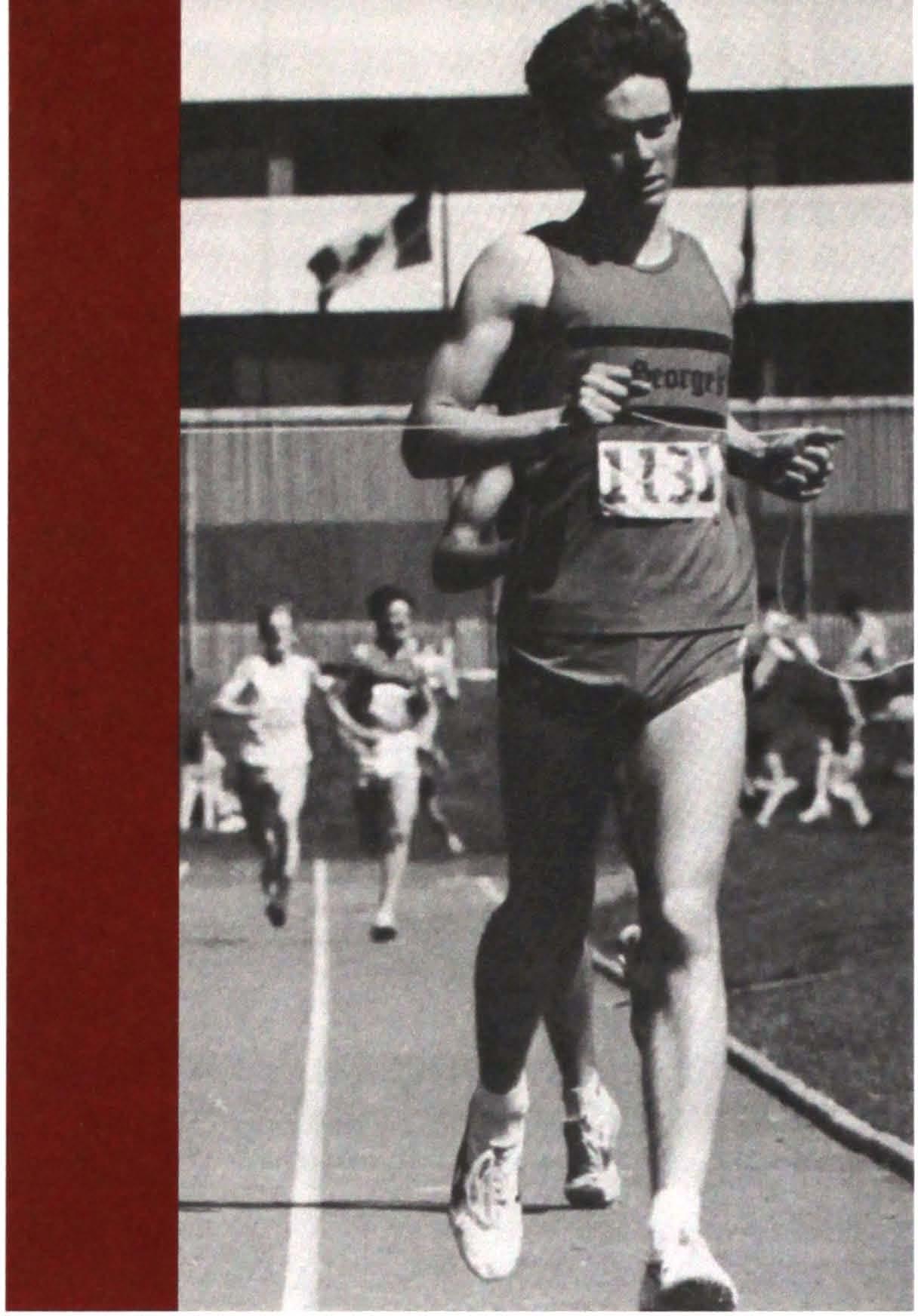
Watson's XV with a score of 15 to 3. It was the first time a Canadian side had beaten them either at home or on tour:
The front row dominated the sets, our line out jumpers won more than their share of the ball, and the back row harried the loose ball. The backs tackled everything that moved and created the superb opportunity for Ben Cooper to snatch a loose ball and scurry 50 yards for the "try of the tour."
In the photograph below. John Catliff (10) takes a pass from scrum half Nigel Kirkwood [91.

144




145





147
IA crew waits for sunrise In Coal Harbour.
In the 1980 BCHS track and field championships the school placed second in the boys' division and fifth overall . This stellar performance would not be repeated again until the Nigel Toy era 20 years later.

The success had much to do with sprinters Pat Palmer, Paddy Hamilton, Reid Parker, The decade produced a number of fine individual crosscountry runners in Cam Mclntosh ('83), Ben Cooper ('82), Chris Lawrence ('84), and Doug Olsen ('91). Mclntosh led his team to a sixth-place finish in the BCHS cross-country championships in
Throughout the 1980s the school continued to field excellent cricket teams but had to go on tour to find challenging opposition. For the first six years no team would have been complete without one of the Stephens brothers: David ('81), John ('83), and Andrew ('86). As Garath Hill reports: "The year 1983 will be remembered as the year of the Irish! John Stephens captained the school's first XI, his brother Andrew captained the UI5S, and David captained the Canadian Colts team on a tour of Holland-a veritable Triple Crown." All three brothers would eventually play for the Canadian Colts XI.
and Jon Pirie. 1983, and Lawrence led his team to a fifth-place finish a year later Lawrence also took the individual bronze medal in the BCHS cross-country championships in 1984, after leading by several hundred yards for most of the race. (His placing was not bettered until Justin Marpole-Bird took the gold in this event in 2005.) All of these runners also made Significant contributions in the middle-distance events of the track and field season.
In the 1980 BCHS track and field championships the school placed second in the boys' division and fifth overall. This stellar performance would not be repeated again until the Nigel Toy era 20 years later. The success had much to do with sprinters Pat Palmer, Paddy Hamilton, Reid Parker, and Jon Pirie. Palmer took the gold in the lOo-metre and 200-metre and was named the meet's Most Outstanding Athlete. The sprinters took the silver in the 4XlOo-metre relay, and the jumpers took silver in the triple jump (Jon Pirie) and bronze in the long jump (Pat Palmer). In the year following Pat Palmer's achievement, Paddy Hamilton took silver in both the lOo-metre and 200-metre.
After a break of several years, rowing returned to the Saints sports program under the direction of David Darling in 1986. By the second year of operation the team was putting regular eights and fours into competition and discovering that they still had some way to go before taking on the big guys from Shawnigan Lake and Brentwood.


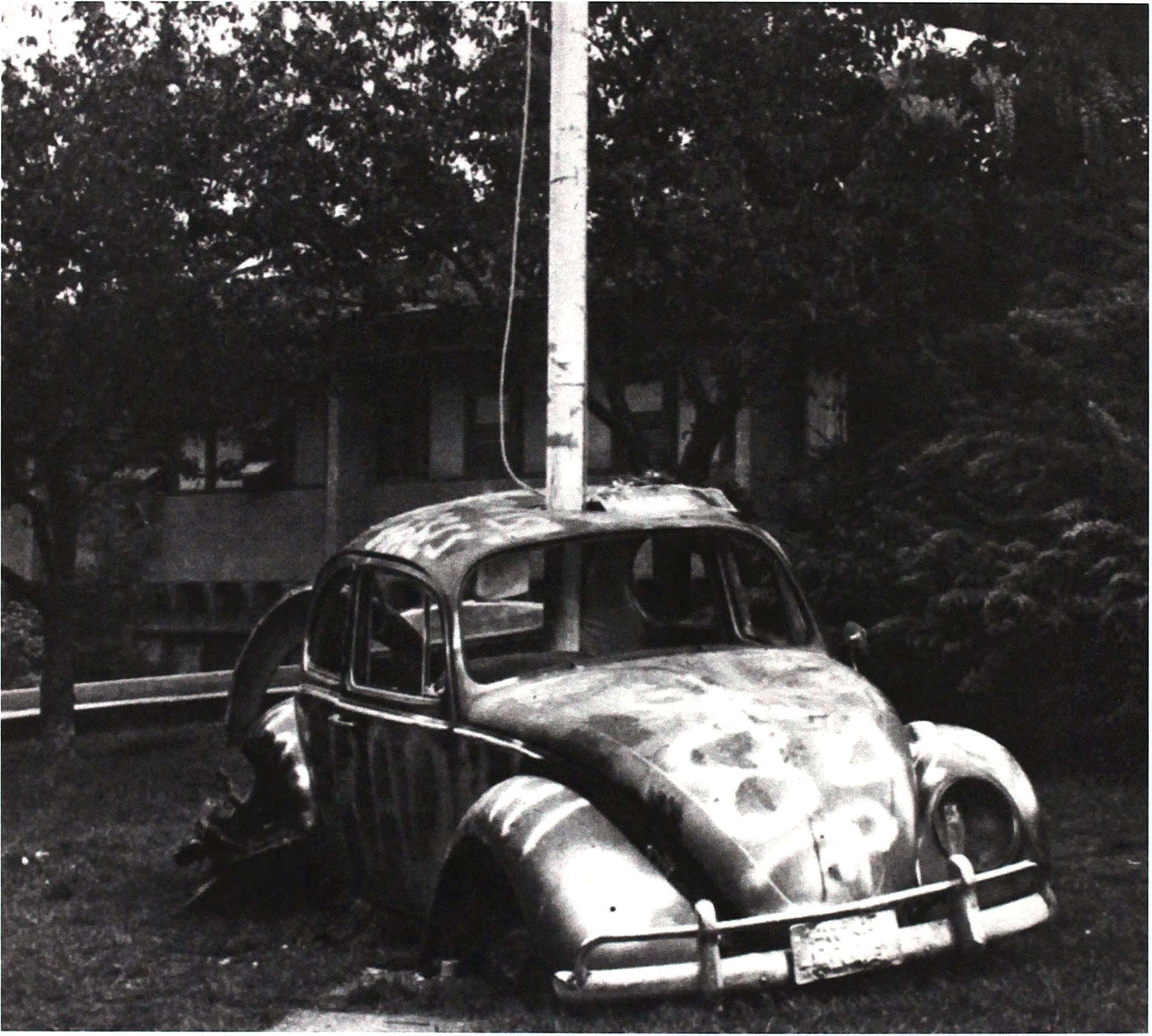
l49
IThe Impaling of a W.J bug as a grad prank in front of the Senior School In 1984.
GRAD PRANKS


Pranks of various kinds were certainly in the nature of things during the long reign of Alan Brown. The class of 1984 will be remembered for towing a VW bug on site, cutting it in half, and welding it back together again around the flagpole.
In another car-related prank, the headmaster was the target. Alan Brown was the proud owner of a new Chevy Caprice, which the boys advertised in the Buy and Sell for $2,000 and the request that would-be-buyers call and "ask for AI."
After a torrent of calls, Alan soon fell in with the prank and passed himself off as a car salesman of the particularly tough, hard-bargaining genus.
In one particularly ambitious prank, committed with the collusion of minor officials, the headmaster's office was emptied of furniture during the early hours and converted into a farmyard. Walking briskly in as he was wont to do, Alan Brown was greeted with a veritable forest of shrubs, hanging plants and creepers, and a rooster and chickens, busily scratching away in the six inches of dirt trucked in to lend authenticity to the scene. He remembers the incident kindly, as the malefactors were quick to own up and clear away their messes with exemplary speed and courtesy.
It was the class of 1985 that staged a prank that went sour. The night before the first day of the new academic year the boys created a tent city on the fields in the late evening. Towards midnight a group departed to seek other diversions on a nearby golf course. They released the golf carts from their chains with the aid of a hacksaw and thereafter used them as dodgem cars on the greens. It was an inglorious chapter in the annals of the school with much embarrassment all round. The boys made abject apologies and appropriate restitution but not before the local paper got hold of the story and published it with the headline "Rich Boys Trash Working Men's Golf Course."
One young man in particular will remember the event for the rest of his life. He was relieving himself in the bushes when the police arrived in response to a call from a local resident. In his haste to leave the scene he trapped an important part of his anatomy in his zip. It required a visit to the hospital before the painful project of unzipping could be safely accomplished.
FAREWELLS

The 1980s saw the departure of several long-serving members of staff notable for their many contributions to the life of the school. David Overton, Cameron McLaren, and Thor Young all succumbed to fatal illnesses before the end of the decade. Norman Chandler and Mr. PJ retired in mid-decade; and three longserving leaders, Cordon Atkinson, John Blackmore, and Alan Brown, bowed out as the decade closed.
Cam McLaren, who was hired to teach French, will be remembered as a great teacher who had the greatest difficulty returning students' written work. He had a gentle sense of humour enriched by a lyrical Scottish accent. A wordsmith from the same foundry as Tommy Roxburgh, he will also be remembered by students for his annual House Supper appearances with Carath Hill. Cam's love of language drew him to coaching the Reachfor the Top team and to acting, where he loved to play British eccentrics. Playing The Duke in the school's production of The Thwarting ofBaron Bolfigrew, Cam mooned Jeremy Sayers-a fact Sayers will happily enlarge upon, on request.
 I Cameron McLaren.
I Cameron McLaren.
151
I BELOW Thor Young.


Thor Young was hired to teach German. An Old Boy nurtured by Johnny Harker, he knew everything about the school. Thor was a member of the 1956 Australian rugby touring side. Unfortunately, after an early injury he didn't see much subsequent action but did later enjoy a rugby coaching career. He was a fine musician who played the recorder and the violin, the latter in the string orchestra that performed under the baton of Gordon Atkinson for many years. Throughout his career at the school he was a strong supporter of the Georgians and served a term as president.
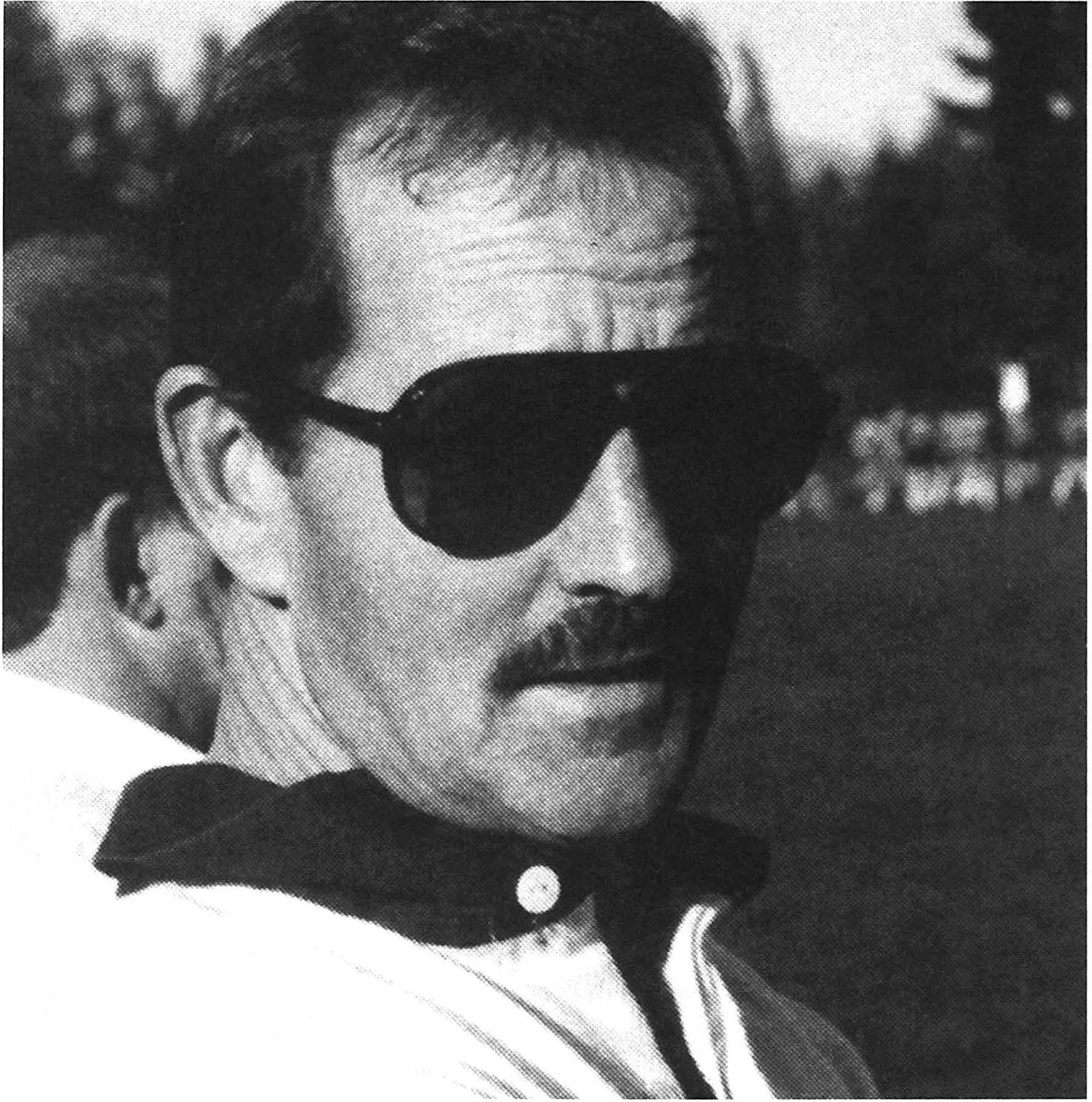
Norman Chandler was a Junior School teacher of long standing. He made the daily journey up the hill on 16th Avenue on an ancient British bicycle, rain or shine. On his retirement the school presented him with a brand new lightweight bike. Norman, in the great Saints tradition of the School Concert, wrote plays for performance on the Junior School stage, under the direction of John Blackmore.
Blackmore was raised in India and served in the war as a fighter pilot before arriving at Saints in the 1960s. He was made head of the Junior School in 1964, and retired in 1988 after 24 years in office. He introduced the Dragon Pin awards shortly after taking office. He was a keen sportsman with a passion for cricket, a redoubtable auctioneer, a director of student theatre, and a lover of dogs. He ran the famous St. George's dog shows of the 1960s and will be remembered by all for his inseparable companion, the noble beagle Trumper. Trumper's internal organs never functioned quite as a dog's should and thus he bore a particularly apt name.
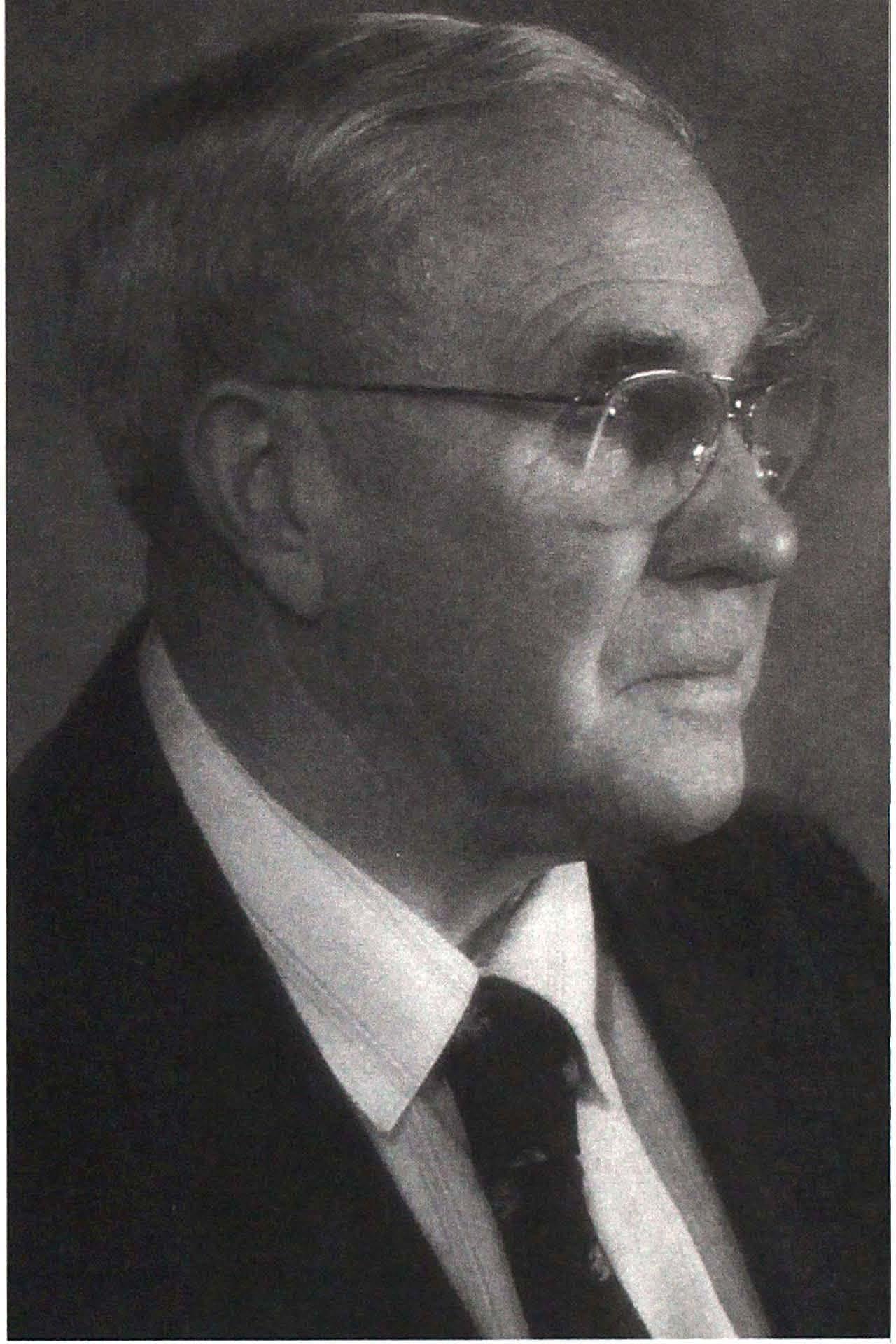


153
I
ABOVE
Norman Chandler Ileftl and John Blackmore Iright!.


154
SUCCESSION
The decade came to a close with a new head in charge at the Junior School. John Blackmore's successor, John Parry, brought a wealth of experience from the public school system. His task, however, was not an easy one. John Blackmore had lived and worked in the Saints community for well over two decades. He was steeped in its history and politics, and he had reached a point in his career when he was accustomed to welcoming not only siblings of past students to the school but the sons of Old Boys. His was going to be a hard act to follow. However, the same could be said of the successor being sought for Alan Brown, headmaster and CEO of the growing business and educational enterprise that St. George's had become. The stage was set for a somewhat confused and difficult succession in the 1990S.

155
IEarly morning mist rises to reveal the Alan Brown Library.
1990-1999

The 1990S: Decade of Transformation
1995 November, Senior School reopens after McLean Hall completed
Soccer team wins bronze in the BC High School championships
1990 1991 1993
Mikhail Gorbachev elected president of Soviet Union
August, Iraq invades Kuwait
Board votes against coeducation
January, First Gulf War begins with launch of Desert Storm
January, Gordon Atkinson returns from retirement and becomes headmaster
Reach for the Top team wins national championship
November, new boarding house opens Jean Chretien elected prime minister of Canada
1994 Junior School upgrades completed Rugby first XV wins BC High School championships
Nelson Mandela elected president of South Africa
1998 1999
John Lawrence becomes acting head during search for new headmaster
Hong Kong reverts to China
Gordon Atkinson retires (for second time)
Nigel Toy becomes seventh headmaster of St. George's
J.K. Rowling's Harry Potter and the Philosopher's Stone published
Y2K upgrades made to computer software across the globe
Two boys shoot 12 students and a teacher at Columbine High School in Colorado
A ..resurrected" Gordon Atkinson returns in 1991 to lead the school as its sixth headmaster. This photograph is from a portrait given to St. George's by the graduating class of 1997.
1996 1997



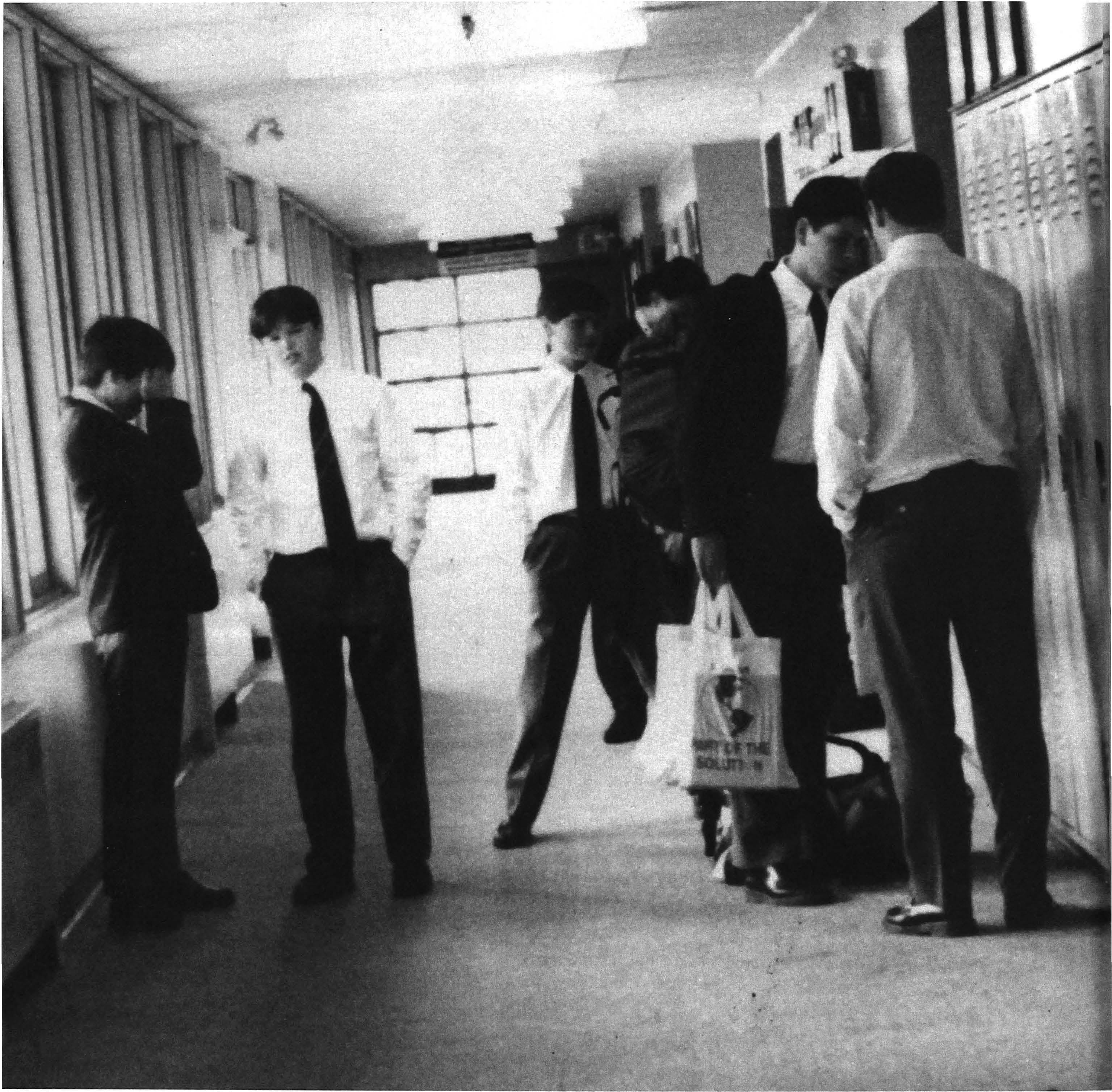

7Decade of Transformation
FROM 19 65 TO 1980 GRADUATING CLASSES AT SAINTS numbered approximately 76 students. In 1999 the graduating class numbered 123 students, an increase of more than 60 percent. At the end of the decade the only member of the Canadian Association of Independent Schools (CAIS) with a larger student population was Upper Canada College.

This rapid growth did not occur without inspiring detractors and supporters, both equally ardent. The perennial concern about bigger schools is that they are of necessity less intimate and may treat students as numbers rather than as individuals. The debate goes on, of course. Wherever members of the Saints community gather, either formally or informally, there are sure to be debaters on both sides of the question and the participants will be unlikely to reach consensus on whether school expansion was a good or a bad thing.
In 1989 John Parry, who had served for one year as head of the Junior School, succeeded Alan Brown and moved into the headmaster's office at the Senior School. He appointed Steve Hutchison as his successor and Tony Mercer as "director" of the Senior School. This new position was created to replace that of deputy headmaster, made vacant after Gordon Atkinson retired in 1989 because of heart problems.
During his brief tenure, John Parry raised the spectre of coeducation once more. After three evenings of fiery, divisive debate in crowded auditoriums, a motion to make St. George's a coeducational institution failed to secure the necessary majority at the board level. Early in 1991 John Parry resigned as head and Gordon Atkinson returned as caretaker head. After being given a clean bill of health, Atkinson accepted the board's offer to become St. George's sixth headmaster, a position he held until September 1996, when a recurrence of earlier heart problems forced him into a second retirement.
IHall conversation in the early morning at the Senior School.
159


160
John Lawrence then became acting headmaster for the year during which a successor was sought. A new head was finally identified in the southern seas and persuaded to return to Canada after an absence of 14 years. Nigel Toy thus became the fourth person to lead the school during this decade of change and transformation.
TECHNOLOGICAL, ADMINISTRATIVE, AND PROGRAM DEVELOPMENTS
In the 1990S technology dramatically changed the offices and classrooms at Saints. New telephone systems were installed on both campuses and were soon found to be a mixed blessing with their burden of voice mail, menus, and pre-recorded messages. Computers, along with their attendant technicians, multiplied like mushrooms overnight. Older staff members struggled to master this new technology, often with mounting frustration. Everyone was faced with a complicated new world of electronic communication: word-processed assignments (sometimes plagiarized); e-mail correspondence (sometimes a threeway affair involving teacher, school, and parent); and the Internet with its vast resources. All of these conspired to change the nature of communication and knowledge, along with the what-and-how of teaching.
A larger school was also found to demand different administrative structures. New decision-making committees came into being to advise the headmaster and a much expanded counselling department was created. There were experiments with the Office of the Director, briefly replaced by a triumvirate in the latter half of the decade. And with a growing graduating class, there was a new emphasis on the importance of leadership from all members of the grade rather than from a small elect.
Yet another development was the Summer at St. George's program, started in 1990 by Ray Stevenson working on a part-time basis. Over the decade the program slowly expanded until it needed a full-time administrator, and by the summer of 1999 the gross earnings reached $1,100,000. In addition to the income derived, the school gained immeasurably from the public relations exercise involved in having several thousand students visit the school.
ABOVE, LEFT
John Parry rolls the camera in for a close-up.
ABOVE, RIGHT
John Lawrence and Gordon Atkinson seek inspiration from soccer's crystal ball.

FACiNG PAGE


"The Doe'" Tony Mercer !centre!' poses with other walking wounded of 1985: Ray Stevenson Ileftl and Eric Stewart !right!.

ABOVE
The Senior Concert Band finds breathing space in its new rehearsal area.

RIGHT

The long and the short of it-Mrs. ··0·· poses with one of the Rascalz.

FACING PAGE
Asher Penn steals the show as a womanizing old man.

THE ARTS CONTINUE TO THRIVE



The Georgian editorial teams of the decade were mentored by Daryl Wakeham, Christine Wessler, and Jeremy Sayers. With names such as "Dreams," "Passionate Poem," "Shadows," and "Kinesis," these weighty tomes celebrated the life of a particularly vibrant community. The pages blaze with colour, but the smiling faces, the humour, the imagination, and the creativity of happy people are even more striking.
Marko Rnic led the music department from 1990 after taking over from Kevin Armstrong. Funding from the Auxiliary provided quality instruments of the expensive heavy artillery variety (tubas and bassoons), which became standard components of all of the bands. Feeder programs at the grade 6 and 7 level were, by the end of the decade, an integral part of the Junior School's regular music program. By grade 8, band directors could assume a high level of proficiency right from the beginning of a student's senior years. With the building program in 1994-95, the department gained much needed rehearsal space, music practice rooms, and a specialist lab with electronic media capabilities.

A highlight of a busy and successful decade was the performance in the Orpheum of a specially commissioned piece by James Curnow for the 65th anniversary of the school. The Senior Concert Band, now more than wo-strong, gave a full program in front of a delighted audience of parents and friends.
In drama two major productions a year became standard. Dougal Fraser and his former student Luke Fredeman each directed their own plays. Backstage, technical direction received an incalculable lift in 1995 with the arrival of Ed Mortimer. Although hired to teach chemistry, Ed soon demonstrated a passion and expertise for technical aspects of theatre that led to courses where students could build sets, operate light and sound equipment, and provide backstage management. Ed Mortimer and his crew became known for finding an elegant solution for every problem.
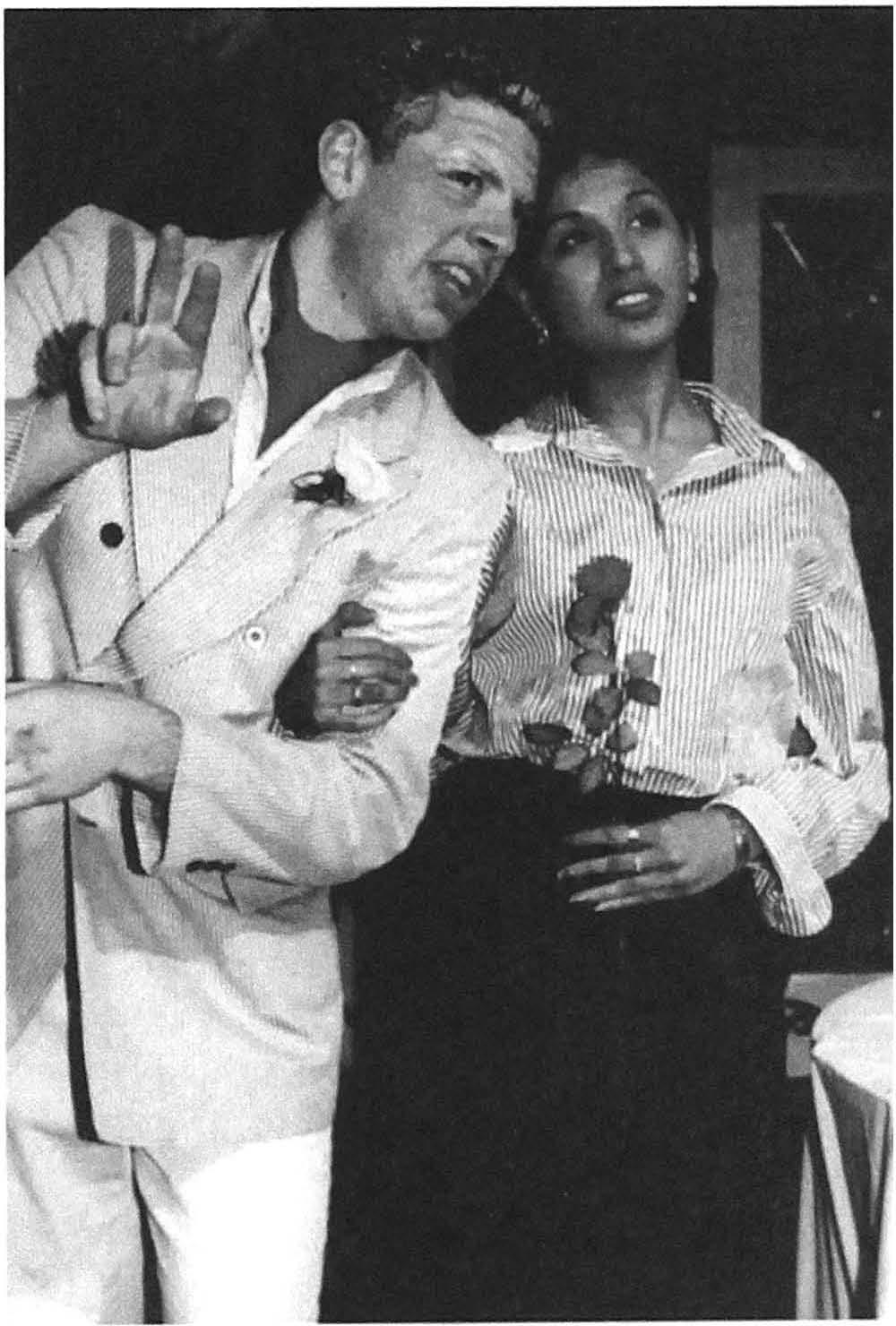
Newcomers to the arts scene in the 1990S were Tunes for our Times and Opus. Tunes was a grad-organized event featuring an eclectic program of music with an emphasis on solo or small group performance. There were often surprises, with students coming out of the woodwork to give breathtaking performances before small but appreciative audiences. Opus, by contrast, was a literary magazine featuring quality writing by different grades and in a number of different genres. Both established themselves as permanent additions to the world of the arts before the decade was out.
Arts Week, by now the highlight of the year, continued to attract an amazing cross-section of talent, some of it featuring Old Boys now making a living in the arts. In 1999 a huge crowd of students watched the Rascalz, a rock group with a difference, brought in by the ever-with-it Mrs. "0."
ENTERTAINMENTS AND DIVERSIONS


The decade kicked off with the arrival of the Rolling Stones' "Steel Wheels" tour in Vancouver. As the Georgian explained, the Stones "drew in the tie-and-jacketed Mr. Sufrin, the leather-skirted Mrs. Mori, the ever-hip Mr. and Mrs. Oliver, Mr. Wakeham, and about one-tenth of our students to BC Place to hear the Glimmer Twins." It was a night to remember.
In an upheaval unrelated to the Rolling Stones, Variety Night almost didn't go on in 1996: ''After much discussion and constructive criticism, the slate of performances was finally approved by the Ministry of Truth, and the night was a go. Tickets were sold bearing the likeness of Mr. Skinner. The buyers marvelled, 'Was this the face which launched a thousand ships, and burnt the topless towers of Ilium?'"
Later in the decade Variety Night metamorphosed into Contemporary Music Night, with a more solid focus on the music played by a number of different bands organized by students. The new format met the requirements of the "Ministry of Truth" and Contemporary Music Night continues to draw in a great crowd of fans to this day.
The Ankle Cup survived for a few more years in the 1990S, with some young members of staff raised with hockey in their blood and even some ringers to give the boys something to think about:
TheAnkle Cup was one ofthe most anticipated in recent years, indicated by the many work-outs and lunchtime psyche sessions, mentally and physically preparing the grade 12Sfor battle. Secure in their strategy they sent out their "Finesse" line to start the game. Next came the "Goon" line who would have demolished their opponents had they been able to skate. Rounding out the team were the "snipers" and the hardworking "Pluggers. " The stajJhad quite afew ringers, as students were hip checked and hurled around the ring The "Elders" led by Mr. Tosh Ujimoto, prevailed with a 5-4 victory which may have had something to do with the lightning reflexes ofgoalie, Mr. SeanMuldoon, or the needfor a better strategyfrom our own coaches.

School ski days were instituted in the 1990S. During one occasion at least, a sighting of Ralph Skinner on wooden skis was reported- but perhaps this is a myth. These excursions started with Cypress Bowl, which proved too tame for some and prompted a move northwards to Whistler. Then as now, a ski day involved transporting the entire school by bus, an operation organized with military thoroughness by Stephen Ziff and his team.
Staffers take a break from their onerous ski day duties. Left to right. Steffen Tweedle. Wallace MacKay. Dwight Hillis. Philip Webster. Hubert Wohlgemuth. Neil Piller 1·85!.

165

PALACES, PLAYING FIELDS, AND MAKEOVERS


The reaction of the community to the San Francisco earthquake in 1989 was one of panic and paranoia, with parents of public and independent school students demanding that immediate steps be taken to bring existing older buildings up to contemporary seismic standards. In the biggest fundraising program in the history of the school, money was raised to upgrade the convent, build a new boarding house, upgrade the Senior School (twice), build a second gym on the Junior School campus, and construct a grad centre. When the dust settled, nearly $13 million had been invested in the longterm future of the school.


The first step in this massive makeover began in 1992, when all but the primary grades moved out of the convent and into portables on the quadrangle. Inside, classrooms and offices were enlarged and the building given a seismic upgrade. Outside, two massive covered walkways were constructed at the western and southern entrances to protect against falling masonry in the event of a quake. The engineers had discovered that the great granite walls of the building were merely a fa�ade and would be the first to fall in the event of a sizable tremor. In the northwestern corner construction began on the new boarding facility, while further east trees were removed, much to the distress of the neighbours, and work began on constructing the longawaited playing field.
Within a year the members of the Junior School were reunited in familiar surroundings, albeit with a library and dining hall that had undergone dramatic change. There was a welcome new spaciousness.
I
The ever-optimistic Mr. Isaias Garcia [above] and students move into temporary quarters.
The boarders were on the move in November 1993. They were moving into a custom-built facility offering the very best of everything-a veritable palace: Movingfrom the dilapidated oldfridge ofthe convent into the "Hotel St. George's" was a real treat.At last we had heat, running drinkable water, and an interior colour scheme that didn't give us a headache. Gone were the communal showers; gone were the days of"boarding house bashing':· gone were the days ofboarding as a kind ofpunishment ... or so we thought. With the move, we discovered a little trouble in paradise: the extra-length mattresses unfortunately didn't have matching extra-length beds. The three inches ofmattress hanging out was amusing atfirst, and we also had an excellent excuse for not making the bed. This minor stumble aside though, we had definitely improved our position; the lap o/luxury was most welcome.
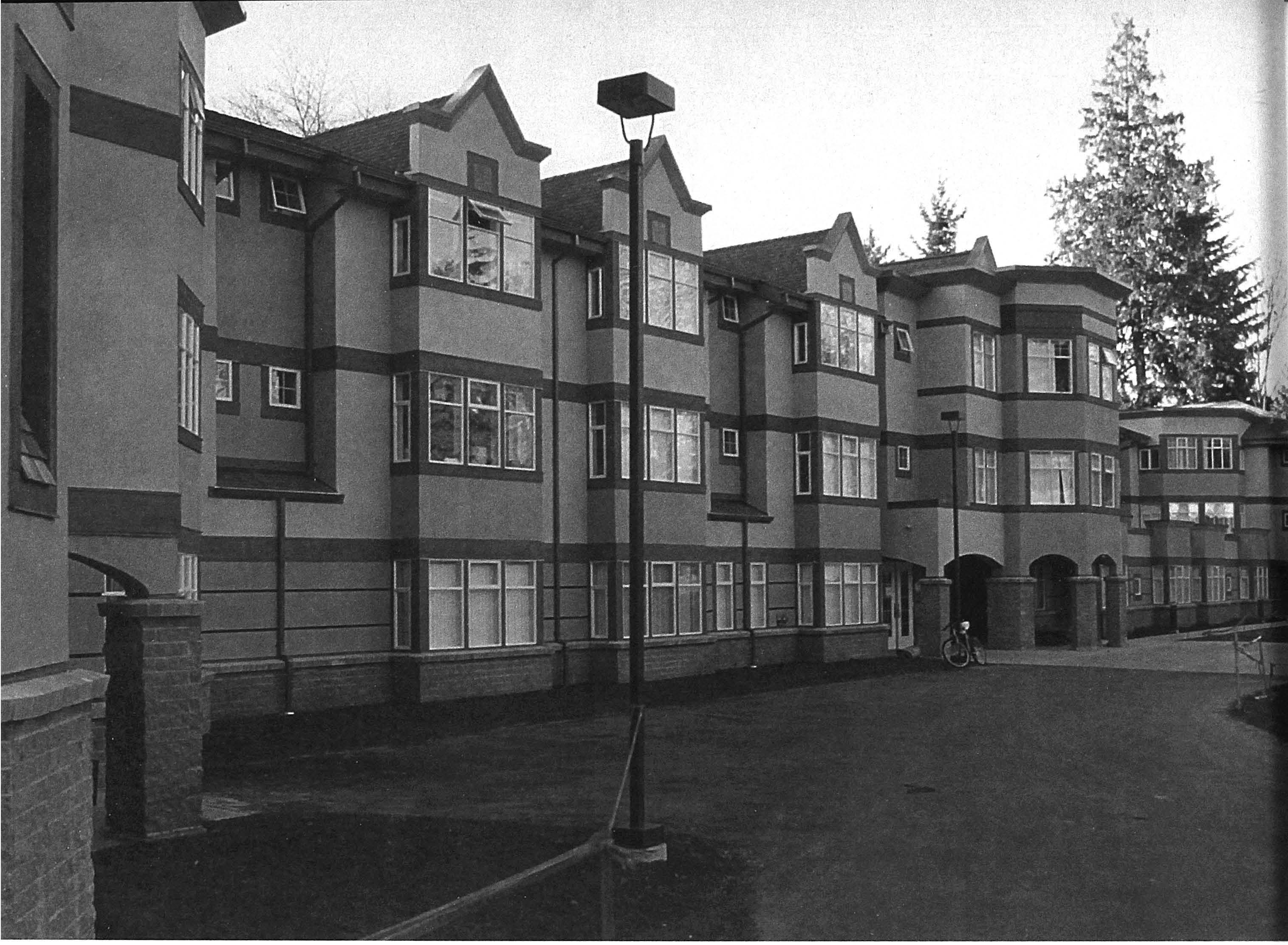

168
The portables were eventually dismantled and towed away, some to the Senior School tennis courts to be reassembled as yet another temporary home for displaced students. This time they were needed for a second massive makeover of the Senior School, last revisited by construction crews in 1985. The Harker Quadrangle and Cliff Hall, creations of the previous phase of reconstruction, were to go in favour of an extended library and a new, larger, and more appropriate dining hall.
The northwest wing of the school was almost completely rebuilt to provide enhanced living space for art, music, and science. But the jewel in the crown created by all this enormous activity was McLean Hall, the gift of the McLean family, which proved to be the most versatile and most used facility on both campuses. Today it is a dining hall, lecture theatre, and stage; it is a meeting place for students, parents, grandparents, and neighbours; it is a tea room and a reception area for weddings, funerals, and gala performances-you name it and you will find that McLean Hall has hosted it, at least once in its lO-year history!

FACING PAGE


"Hotel St. George's," the new boarding establishment.
BELOW
McLean Hall decked out in frills and fripperies,

 I
The Harker Quadrangle on a balmy summer"s day
I
The Harker Quadrangle on a balmy summer"s day
170

171
RIGHT

The 1997 debating team proudly displays a season's hardware.

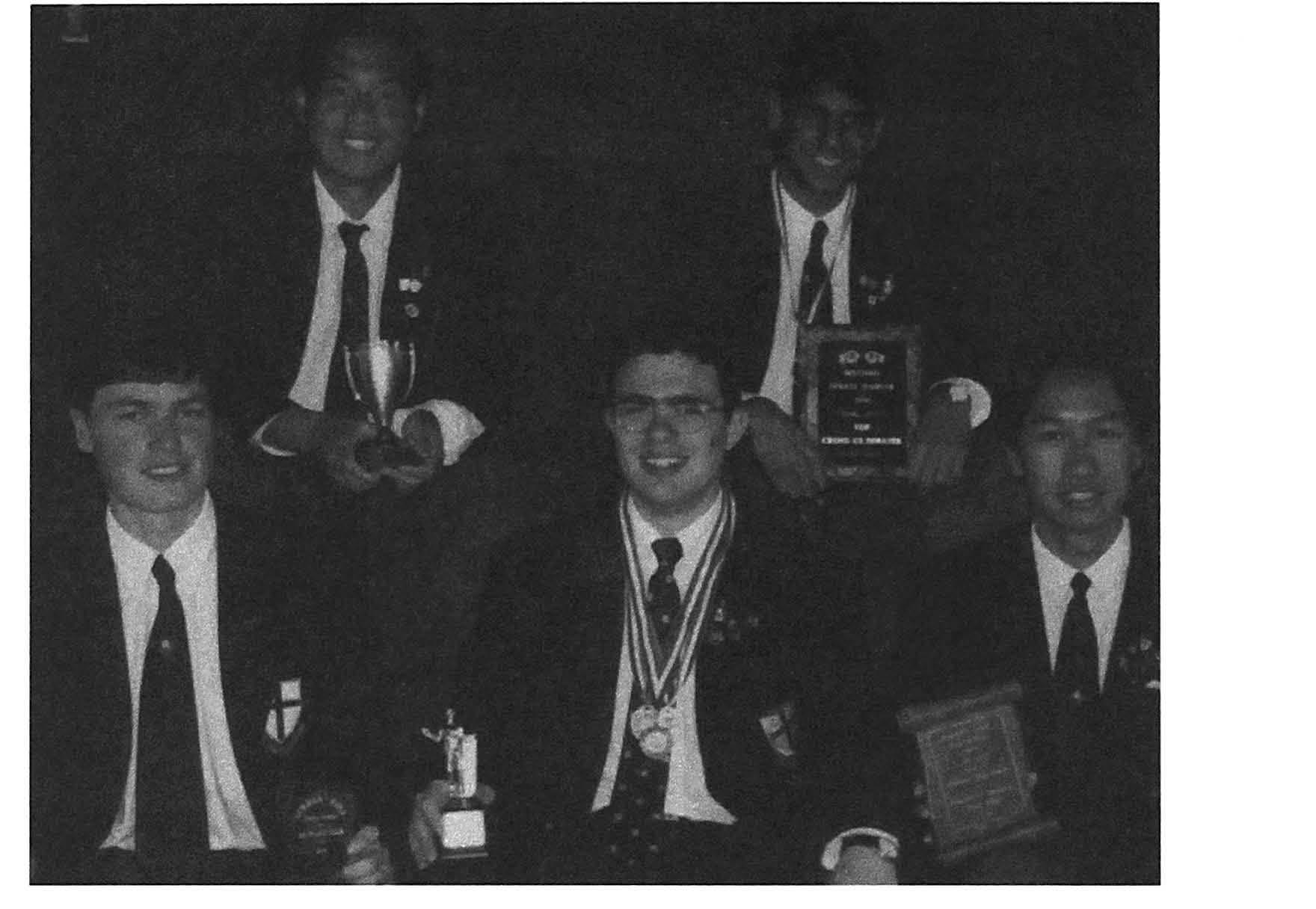
From left to right: Brendan Brammall, Lucas Britanico, Joshua Karton, Sameer Meralli, Lester Lau.
BELOW
Reach for the Top team, 1991.
From left to right: Mr. Eric Stewart, Neil Allan, Ben Ellison, Nick Ray, Paul Carpenter, Reza Akhtar.
172
A MISCELLANY OF CLUBS

The 1990S saw continued interest in clubs of all kinds. Debating developed a bilingual arm in the 1990S while maintaining consistently strong teams in the more traditional English arm. The school hosted the national debating championships in 1991, and the provincial bilingual debating championships in 1997. This last proved to be a particularly good year. Josh Karton was the top individual debater, placing second in the Western Canadian championships and captaining the Canadian debating team in the world championships in Bermuda. In the World Public Speaking Contest in England he placed second. This stellar year was concluded when he and his coach, Mrs. Webster, were chosen as coach and assistant coach for the Canadian team at the world championships for the following year.

In 1991 the Reachfor the Top team took the national title for the second time in the school's history, winning a tough final bout against Ontario with a score of 400 to 360.
The United Nations Club was established by Ralph Skinner, who had already made significant contributions to both tennis and debating. Over the decade Ralph's new empire grew considerably, with as many as five different tea�s, each representing different countries. Each team completed lengthy research on a country in order to speak knowledgeably about its domestic and foreign polices, then travelled to competitions in New York, Chicago, Harvard, and even as far afield as the Hague to take part in UN-style debates with other clubs.
The decade also saw the birth of the Robotics Club under the aegis of physics teacher, Andrew Kay. In many ways it complemented the Physics Olympics, with its appeal to the technologically minded student. In 1999 a team of Saints boysjoined forces with the techno students of Crofton House to build a robot that could curl, of all things! The ungainly contraption was shipped off to Scarborough Ontario, where it completed its assigned tasks to earn a fourth place in national competition.
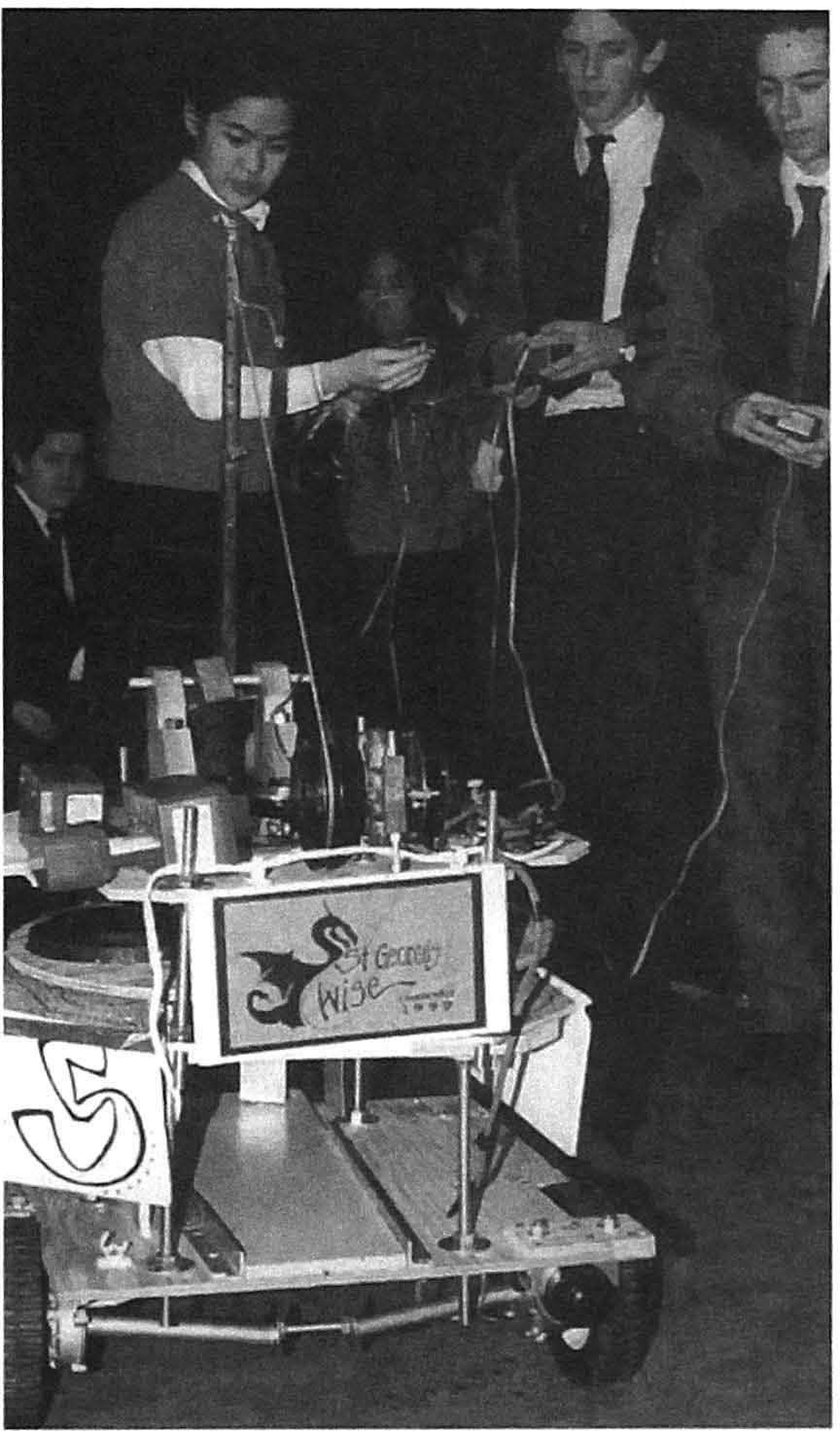
173
ABOVE RoboCurl struts its stuff before an admiring assembly audience.
BELOW Kai Chuk Ileft] and Justin Chang Iright] at the National High Schools Model United Nations.
ABOVE
Neil Piller ['851 packs a hamper.
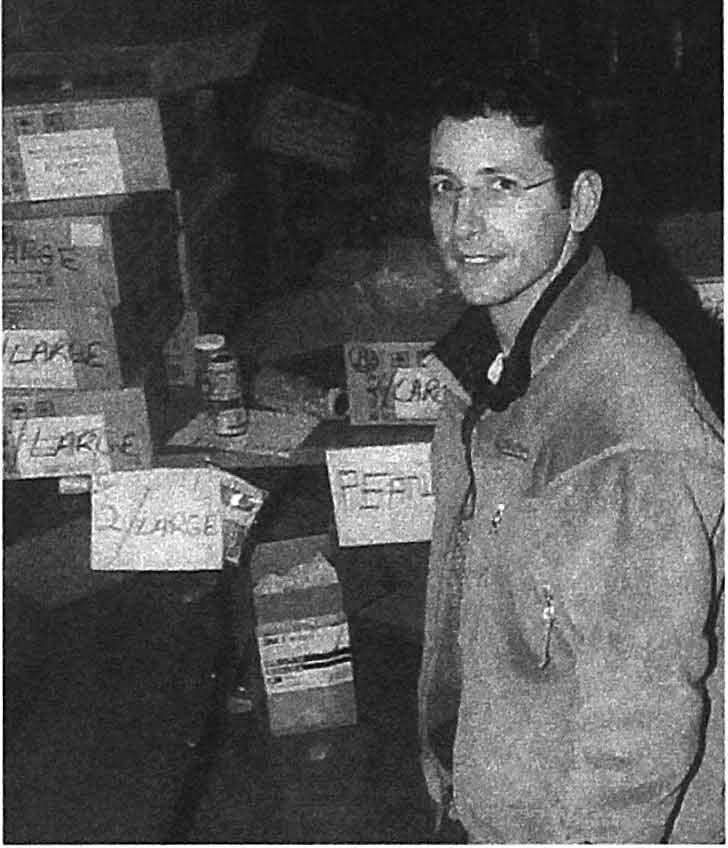
FACING PAGE

Grand Tricycle Race contestants in 1991.
Serving others, always part of the school's philosophy, became an official club activity in the 1990S with the introduction of the Public Service Club, which complemented the activities of the student-organized UNICEF and Kiwanis clubs, With the aid of the computer and some inspired thinking, it became possible to track the contributions of the growing number of students who competed to receive a coveted public service tie-recognition of 25 hours of service. The entire school community engaged in a variety of fundraising initiatives (see below) and accepted "responsibility for the betterment of society," as expressed in the St. George's Mission Statement.
HELPING OTHERS
Whether filling hampers for the needy, running in triathlons, or pedaling in tricycle races, members of the St. George's community found many ways to help others in the 1990s.
The Hamper Drive that started modestly as a Rover and Venturer activity in the 1970s grew into a mammoth undertaking during the 1990s. Vast amounts of food were collected through corporate donation and stockpiled around the school; likewise, thousands of cans were collected by
students. Each hamper included gifts for every member of the family bought with cash donations or money raised by student fundraising activities.
Parents, students, and Old Boys put the hampers together in everincreasing numbers, drawn together by the camaraderie and goodwill of a day that kicked off with a community breakfast. Convoys of cars and trucks loaded with hampers ventured into the Downtown Eastside. On occasion ice, snow, howling winds, and monsoon
rains impeded progress, but every delivery was made in the end. By the close of the decade the school was delivering close to 400 hampers and had become one of the major donors of hampers in the city.
In 1991 a Junior School triathlon was held to raise funds for Ethiopian famine relief. Teams chose signature looks and the participants swam, cycled, and ran [as seen belowl for pledges.

In 1994 a walkathon of truly epic proportions put 1,000 walkers from St. George's, Crofton House, and York House to work and raised $27,000. With a contribution from the Canadian Development Agency, walkathon organizers were eventually able to send a cheque to the Save the Children Fund for $100,000. On a somewhat smaller scale, students
found many innovative ways to raise funds for a variety of causes:
A paramount penny drives a treacherous trike race, a piercing paper airp/ane contest, and a behemoth banana-eating contest. The impoverished recipients of the contests' earnings would have been astonished to see pictures of the contestants: their financial support came not from the pocket of an overpaid lawyer whose contribution was made only to assuage a guilty conscience, but rather born of costumed boys, struggling uphill on fairy tricycles which they may once have peda/ed when they were knee-high to a grasshopper.
174

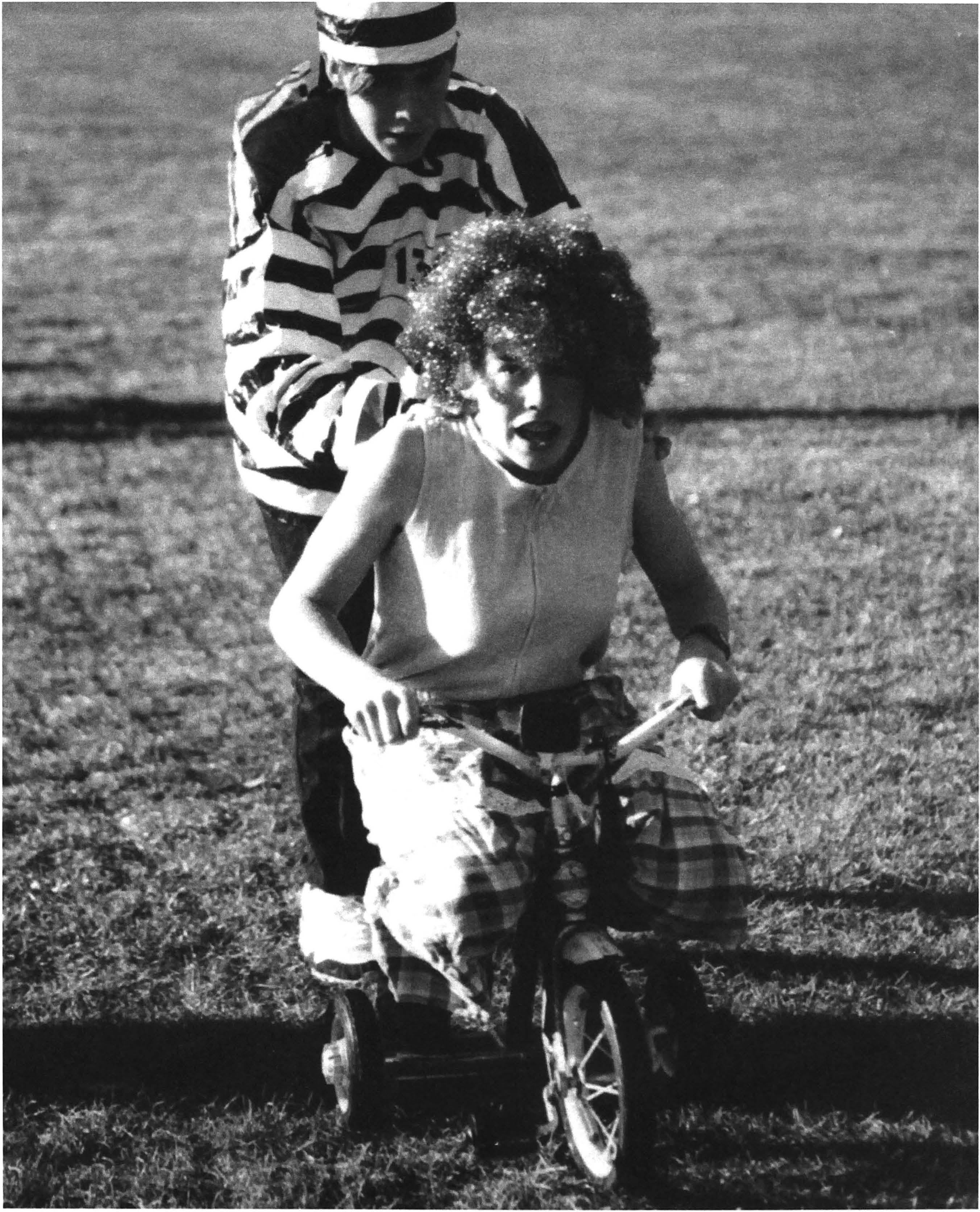
175
RIGHT

A kayaking group discovers the early morning splendour of Howe Sound.
FACING PAGE, ABOVE

Ultimate star Sean Boyle in action, 2004.
FACING PAGE, BELOW
Chris Peerless with the ball in the AAA championships at GM Place, 1996.
THE SEA-TO-SKY PROGRAM
The grade 10 program shifted away from Strathcona Park Lodge in the 1990S and focused on activities in and around Howe Sound. The obj ective was to familiarize students with an area close to the school that could provide physical challenges and make them aware of complex environmental issues:
Difftrent groups pursued difftrent adventures: snow-covered mountains in the Tetrahedron and Sky Pilot regions were shared by intrepid snowshoers and backcountry skiers; the waters ofHowe Sound were paddled by kayakers and canoeists; the glorious rockformations ofSquamish were challenged by eager rock climbers. In the process they also developed many qualities which they will cherishfor a long time, Somefound the week challenging and gruelling, while othersfound it an awesome adventure-allhad discovered unsuspected things about themselves.

THE SENIOR SPORTS SCENE

There were some newcomers to the sporting world at St. George's in the 1990S. One was Ultimate, a sport that involves throwing something rather than kicking it or thumping it. Ultimate, coached by Stephen Ziff, was first offered as a recreational games choice in spring 1993. The first competitive team, which included players from Saints, Crofton House School, and York House School, competed in exhibition tournamentsand the BC Disc Sports Society (BCDSS) high school provincial championship tournament in spring 1994. In 2004 the senior Ultimate team, made up of Saints and York House players and coached by Ziff and Geoff Urton ('95), won their first BCDSS provincial championship. This achievement was repeated in 2005.

Basketball came into its own in the early 1990S when Saints was still small enough to compete as a AA school. The first significant win after a long and hitherto unsuccessful rivalry, was against Vancouver College. Other significant achievements were a third-place finish in the provincials of 1992 at the AA level, and our entry into the BCHS championships as a AAA school in 1996. Huge numbers of supporters were disappointed to see the team eliminated in the first round, but the school's presence in the tournament at all indicated that Saints had arrived in the world of basketball and was a force to be reckoned with, a fact duly recorded in press coverage of the event.
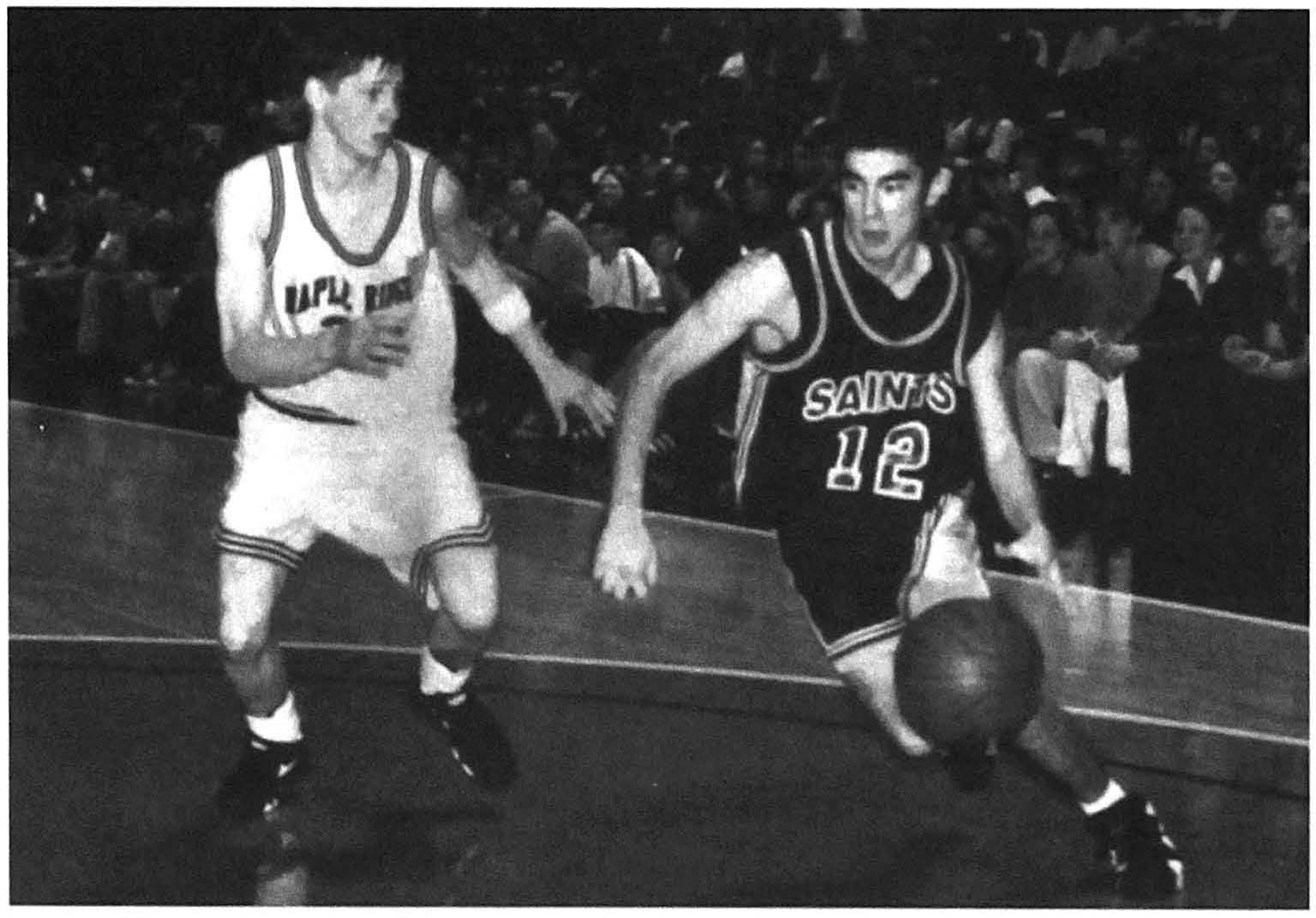
177
RIGHT


Our all-star line-up prepares to do battle in their sparkling new designer uniforms.

BELOW

The lightweight coxed four in action at St. Catharines, Ontario, 1998.

Ice hockey teams at Saints have always had difficulty lining up enough competition. With the collapse of the Vancouver city league in the early 1990S the team discovered new competitors in the western US. The team won the President's Cup in Denver, Colorado, in 1996, and was victorious again in the 1998-99 season in Los Angeles. Coach Hillis waxed lyrical about the LA experience:
And with dazzling ease the team outskated, outscored, and outmaneuvered the opposition, with the Canadianflag tied behind them above the bench. For it was the team's own battlefor NorthAmerica, with Canadian pride fuelling the inspirational performance! Because we were branded as a British ColumbianAll-Star Team, and a team full of ringers, it came as a shock to the sandy-haired surfers, whose idea of a penalty is aflagrantfoul, that the team was in fact drawn from 30 people.
In the 1990S rowing soon re-established itself as a premier school sport. Beat the Beast, the annual ergometer contest, grew in popularity, attracting an increasing number of strong competitors in every category. Neil Armour, John McCormack, and Kiran van Rijn were consistentlyhighly placed individuals in this contest of supermen. The Saints eights were successful in beating Vancouver College crews in their annual race in False Creek in 1990 and 1998. At the nationals in St. Catharines, Ontario, the crew won silver in the junior heavy four in 1991 (taking particular delight in beating a Brentwood crew), and in 1998 the junior lightweight coxed four took gold-a fitting culmination to a decade of sustained progress.



After nearly 20 years in the wilderness, the Saints rugby team was once again in the running for a BCHS championship title in

A SCHOOL-BASED BASKETBALL TOURNAMENT
The Dragon Classic basketball tournament started in the 19805 and grew into a major event during the 19905. By the end of the decade the event included 16 teams from across Canada and some American visitors as well. In 1998 the Junior School team placed second in the Dragon Classic and second in the national CAIS championships. proof that the school was becoming a powerful force in Junior basketball. The team is shown here with Coach Rob McCall.

179
ABOVE, LEfT

Mike Wong breaststrokes to victory.
ABOVE, RIGHT
The U 15s demonstrate how it used to be playing winter term soccer in 1996.
BELOW
Jason Strelzow, provincial record-holder, takes a breather.
the 1990S due to a change in season. In 1994 rugby at Saints moved from the fall term to the summer term. In their second summer season after the change, the team made the BC finals and took home the championship trophy:
The semifinal game matched us against Carson Graham who had beaten us once in pre-season play. Soliddefence with tenacious tackling marked our play in thefirst halfand ultimately wore down Carson, allowing our potent attack to score two tries. Thefinal result was a very emotional and well-deserved 23-10 win. The championship game stretched the team's character to the utmost, but ultimately it was their strength and total effort that won the contest.
Up until the 1993-94 season, soccer at the senior level had always been the Cinderella of the sports program. Forced to play in the winter term because of long-standing arrangements involving the rugby program, the team was excluded from participating in the Vancouver league and obliged to play during the BC monsoons, knee-deep in mud, slush, and water.

All that changed when rugby moved into the summer term. Soccer thus became a fall sport and could take advantage of fields in glorious condition, no more competition with the rugby program for players, and the opportunity to play in the city league. In the 1995 season the team qualified for a berth in the BC AAN.s high school championships for the second year running and took the bronze medal. The 1990S were indeed a watershed year for soccer, with the team's participation in the national CAIS championships, where they took a second-place finish after losing to Upper Canada College in a shootout.
The swim team under head coach Mrs. Nienabar (formerly Mrs. Lucas), turned in strong performances throughout the 1990S. The fall season of 1998 was particularly notable. The team won the silver medal for the BCHS aquatics title after Jason Strelzow, Joey Wu, Byron Lo, and Tim Hindmarch-Watson took gold in the senior "N.' medley relay race and three other events. Jason Strelzow also set a new provincial record in the men's lOo-metre freestyle.
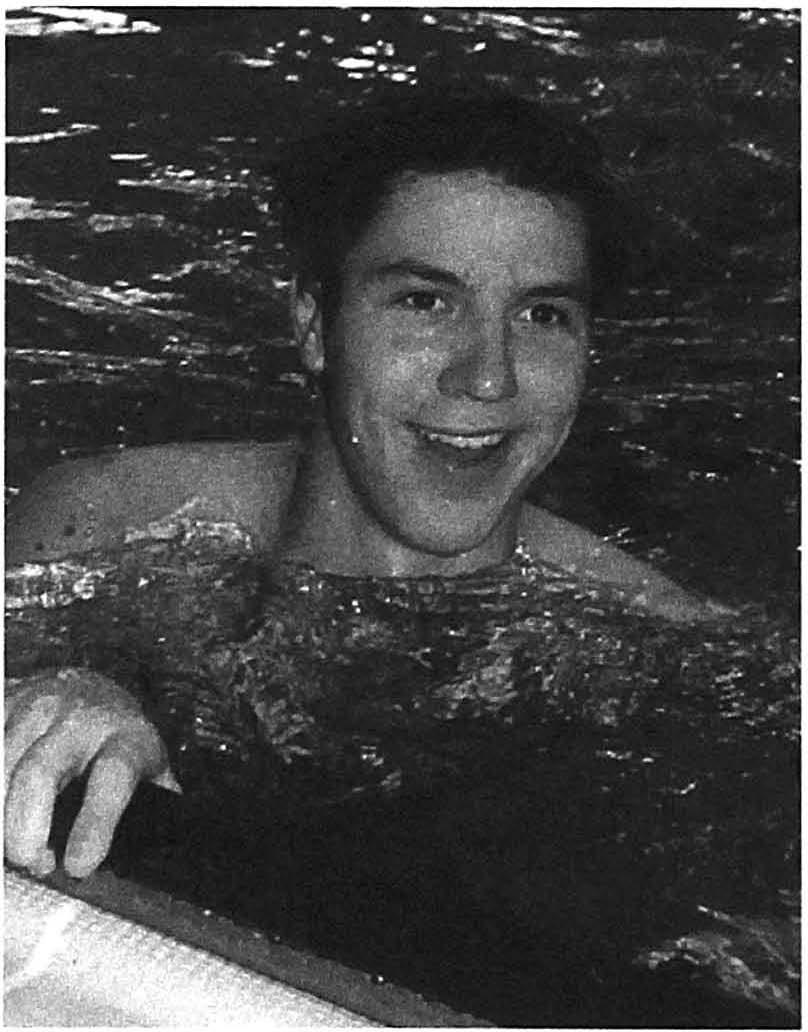
180

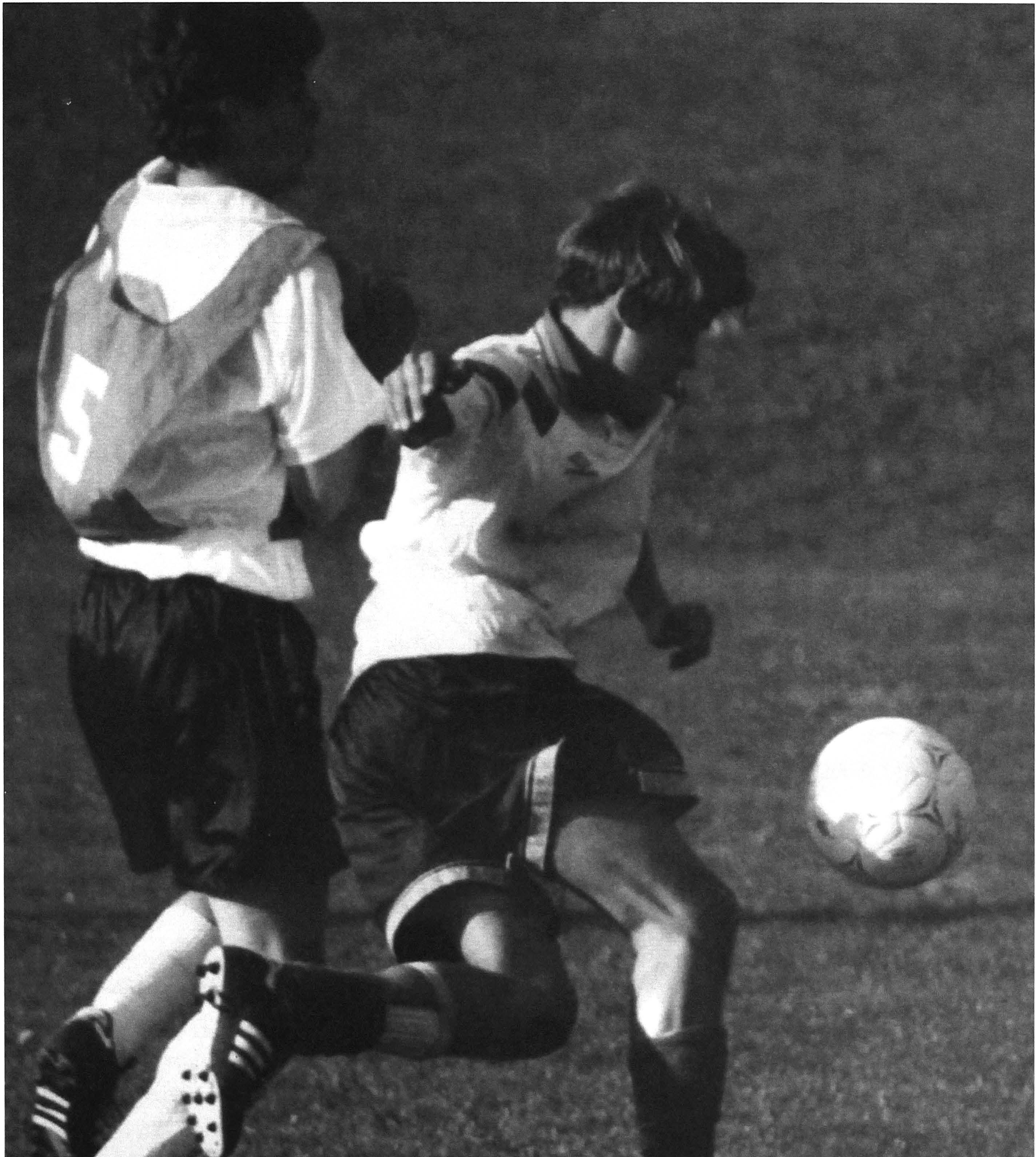 I BELOW
Justin Student moves in to take a winning shot on goal.
I BELOW
Justin Student moves in to take a winning shot on goal.
THE JUNIOR SPORTS SCENE
In the 1990S the Junior School built a sporting powerhouse on the strong foundations established in earlier decades. At the independent BC schools level they were virtually unstoppable in rugby, football, swimming, cross-country, basketball (see page 179), ice hockey, and track and field. With the continuing growth of the school population in the late 1990S the junior teams became even stronger, taking championship honours in cross-country and track and field at the provincial level, and in basketball and soccer at the national CAIS level.


"Ouch," that was a tough one.
Mud, mud, glorious mud

FACING PAGE

Great support for a great team.
 CLOCKWISE, FROM TOP Two Saints runner battle it out.
CLOCKWISE, FROM TOP Two Saints runner battle it out.
182









PREVIOUS PAGE Happiness is the start of the senior cross-country run-maybe not the finish.
BELOW

Clive Austin rallies the ·'troops.'·
FAREWELLS
The decade had its share of departures, including Gordon Atkinson, Clive Austin, Bob Bacon, Isaias Garcias, and Angela Nutter.
Clive Austin started his career at Saints in 1967, leaving in 1996 to take up the headship of West Point Grey Academy. During his 29 years at St. George's, Clive wore many hats. At the Junior School he directed plays, ran the games program, and was the deputy head. In his final years he worked on the Senior School campus setting up an admissions department. He will be remembered for his inexhaustible reserves of energy, and the evident relish he brought to taking on a multitude of tasks at the same time.
Bob Bacon died in 1998 after a long and painful struggle with cancer. Of all the characters who have worked at the school, Bob Bacon truly captures the spirit of author Robertson Davies' observation that "private schools score over state-run schools" in their ability to "accommodate a few cultured madmen on the staff without having to offer explanations."

186
I RIGHT

In a 1999 article in the Dragon, this "madman" was described in detail:


Most ofus will remember thatfirst meeting with Bob. Beautiful ladies usually received one ofthose truly amazing winks pregnant with invitation,followed by a bearish hug,followed by a tango in which there were only twofiet on thefloor! vve males were subjected to a careful scrutiny. lfBob suspected any pretense, humbug, or remote sense ofsuperiority, then he would mobilize the Baconian crap detector, that sacrilegious, irreverent sense ofhumour ofhis that had the victim thinking the bearded giant insane without realizing his only purpose was to establish a level playingfield on which no one pulled rank.
The man known simply and affectionately as "Isaias" was spotted, according to Douglas Harker, by his brother John in a road gang and taken on at St. George's, presumably on the evidence he displayed there of sustained hard labour undertaken with good humour. Isaias tells the story rather differently. He had emigrated to Canada from the Azores and settled in Quebec, where he acquired some French. When he travelled west to Vancouver he had no English, but he did have the address of a landlady with a reputation for helping out new immigrants. Sure enough she told him about an ad she had seen for a position at St. George's. Armed with his landlady's directions, Isaias soon arrived on the doorstep. After an interview he and a second applicant were put to work cleaning out a room. Isaias got the job and the rest is history.
Bob Bacon-a physics man of sartorial elegance.
Angela Nutter started her career as Senior School librarian in 1971, taking over from the long-serving Garry Colchester. She was better known, however, as a Junior School librarian and homeroom teacher. Angie had a wonderful sense of humour and a great laugh that embraced the universe. She was an inspired teacher with a great love of language, wordplay, and books.
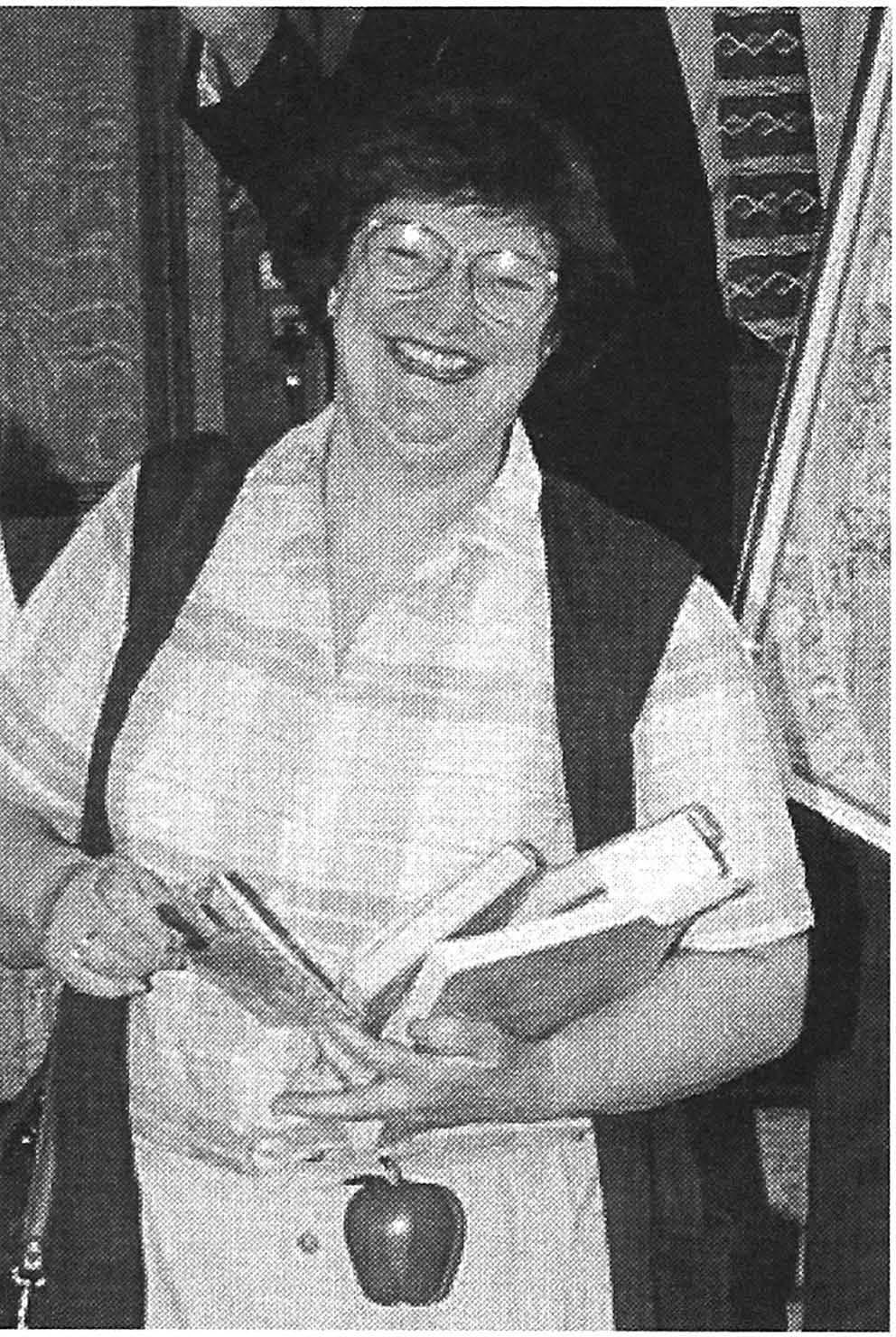

Gordon Atkinson took a full-time position at Saints in 1963. From 1971 until 1989 he served as Alan Brown's deputy, serving in a multitude of different roles as the school matured and expanded. When he returned in 1991, after an early retirement following a heart attack, it was as a caretaker head. The departure of Headmaster John Parry after only four terms in office had left the school rudderless and adrift. Gordon quickly restored a sense of calm and within the year the board confirmed his appointment as the school's sixth headmaster. For the next five years Gordon oversaw the process of steady expansion that has carried St. George's into the new century. A second heart attack forced him into retirement in 1996. In a long, busy, and fruitful career he managed to complete both a master's degree and a doctorate, conduct choirs and a string orchestra, and discharge the duties of choirmaster and organist at St. James Church in downtown Vancouver. In retirement he designed a home around a much-loved grand piano.

I RIGHT
Mr. and Mrs. Isaias Garcia.
BELOW
Angela Nutter.
188
AN ACADEMIC POWERHOUSE
With the massive influx of immigrants into the province from Hong Kong the composition of the student body began to change in the 1980s. The process continued into the 1990S as fresh waves of immigrants from around the world settled in Vancouver and sought to have their sons educated at St. George's. The growing multicultural mix of the student body led to the creation of In 1998 when the Fraser more diversity in the games program, providing opportunities for all Institute began rankingstudents to shine in the sport of their choice.
Increasing numbers of students began competing for Ministry of Education scholarships, taking the appropriate provincial exams and manfully accepting the burden of extra work. Worth up to $1,000 towards university fees, these scholarships were sought more for the honour of the achievement than for their cash value. Excellent results were achieved in all subjects. In mathematics, the department survived the departure of Mr. PJ in the 1980s and went on to prosper, albeit by different methods, under Craig Newel!, David Sufrin, Angela ColIins, and many others.
There was a significant increase in both the number of courses offered and the number of participants in the Advanced Placement program, which provides students with first-year university level
secondary schools based on grade 12

provincial exam results, St. George's placed in the top three and has remained there ever since.

courses in a variety of subjects. AP courses were of particular interest to that growing segment of the student body interested in a post-secondary education in the US.
In 1998 when the Fraser Institute began ranking secondary schools based on grade 12 provincial exam results, St. George's placed in the top three and has remained there ever since. With the intense interest in the province at large in these rankings, however incomplete they may be as indicators of a school's worth, they have proved to be an unexpected boon for admissions. Nothing breeds success like success-especially in our examination-oriented society.
By the end of the decade, the school had settled down under the watchful eye of Nigel Toy. There was the prospect of further expansion, yes, but with the sense that the school now had the necessary infrastructure to handle the challenges of organization imposed by larger numbers. On all fronts-the academic, the athletic, and the artistic-the school was preparing itself for an Olympian Age.
An artist's

2000-2005
The 21St Century: An Olympian Age
1999 American Beauty opens
2000 Greg Devenish becomes the sixth principal of the Junior School

The second Grandparents' Day
2001 The Destination Imagination team places second in global finals in Knoxville, Tennessee
September 11, World Trade Center destroyed
The Fellowship of the Ring opens
I
rendering of the Millennium Project, circa 2001.
2002 Track and field team wins BC High School championships
Cross-country team takes silver medal in BC High School championships
The grade 10 Discovery Program begins The Two Towers opens
2003 50th anniversary of the Auxiliary and the Country Fair

Adam Goldenberg and Teddy Harrison travel to Peru on the Canadian debating team with head coach Janet Webster
March 19, Second Gulf War begins
The Return of the King opens
2004 2005

June, St. George's School ranks first in the province in both academics and athletics
June, St. George's School again ranks first in the province in both academics and athletics


192
An Olympian Age
IT IS FITTING THAT THE LAST FIVE YEARS of the school's 75-year history have unfolded in a new century and a new millennium. It is as if the era inspired the school community to achieve as much in five years as it would usually manage in ten. Along with the boys' myriad academic, artistic, and athletic achievements, there have been spectacular successes in fundraising and construction.
At the Junior School, Greg Devenish has been at the helm since the decade opened. At the Senior School, Nigel Toy has begun to enjoy the benefits of changes he initiated in the 1990S.
ASSEMBLIES AND PRIZE DAYS

A unique event at St. George's is the assembly, an evolutionary product of the parades instituted in the 1930S. At the Senior School these meetings of students and staff used to take place in the Woodward Auditorium, built to seat 400. The assembly was moved, with reluctance, to the Dixon Gym when the administration had to admit that it was no longer possible to cram more than 600 boys and 50 staff into 400 seats.
Today, a casual visitor can learn much about the school from a Dixon Gym assembly. A student work crew quickly and efficiently arranges seating for 750; technicians set up sound and light systems; teachers busily sort medals, trophies, and ribbons for presentation; and costumed students excitedly make their usual last-minute preparations for a skit to promote some school event.
In the subsequent unfolding, lasting no more than half an hour, the disciplined, good-natured atmosphere may take one by surprise. Students cross the stage in a steady stream to collect awards in half a dozen different categories; presentations involving students or visitors take place, often with audiovisual effects; there is humour, laughter and, when it's all over, an orderly departure with the efficient removal of chairs, benches, and equipment. The esprit de corps is palpable; it is a school assembly, a time when community is created and celebrated.
IUnder Headmaster Nigel Toy's inspiring leadership. the school moves forward to attain new standards of excellence.
8
193
Prize Day in the Big Top.I

Another unique St. George's event is Prize Day, which started in 1965 as an open-air affair and eventually became a "Big Top" event in order to protect the ever-increasing numbers of parents and friends in attendance from the vicissitudes of BC's weather. The scene lingers in the mind long after the occasiona well-dressed crowd of students, family members, and friends mingle over refreshments and evoke the atmosphere of Ascot or Glyndebourne. Fraser Loney's pristine turf is underfoot, a glass of cool white wine is in hand, the sun is overhead, and in the distance the snow-capped ridges shimmer in the heat. The stuff of memories!
THE REWARDS OF LEADERSHIP
Over the years various attempts have been made to give members of the graduating class a place of their own. After the student centre of the early 1970S quickly metamorphosed into an art centre, the Southam Lounge was used by the growing graduating classes of the late 1990S, but it proved to be less than satisfactory. On occasion visitors would inadvertently wander into the lounge, thinking that they had stumbled upon a locker room or a rumpus room. Thanks to a gift from the Carthy Foundation, the grads today now find themselves, much to the envy of the rest of the school, including the staff, in their splendid new grad centre. At weekends the centre doubles as a pavilion and it has become an alternate meeting place for a growing number of functions when McLean Hall is unavailable.

ABOVE 194
BELOW

Tristan B.G. Armstrong 1'031. son of Wendy and Peter R.B. Armstrong 1'72). attends Grandparents' Oay with his grandmother Frankie and his grandfather Geoffrey C. Robinson 1'381. son of Cappie Robinson.


Graduating students continue to take part in a mu 1 titude of leadership activities. Advisor captains assist teachers with homeroom activities and accompany younger grades to outdoor camps. Large numbers of the class are involved in promoting events like Tunes for our Times, Contemporary Music Night, House Supper skits, assembly promotions and presentations, and last but by no means least, school dances.
The institution of the Headmaster's Leadership Awards has made possible the public recognition of a wide diversity of student contributions. And the new Office of Student Services has done much to guide the graduating class in its leadership duties and help graduating students make appropriate choices for post-secondary education.
In 2001 St. George's looked to another type of community leader when it held its second Grandparents' Day. The lunch served in the Dixon Gym brought together 500 grandparents and their grandchildren from both campuses. It was a particularly happy occasion, one that welcomed a proud older generation, eager to know more about the school and its activities.
195
GROWTH AND LOSS


By 2005 the school population had reached 1,120, with rolls on the senior and junior campuses of 750 and 370, respectively. The school continues to provide facilities for a growing population and to update and improve the existing plant. Spending in the 1990S exceeded $12 million; by the end of the first five years of the 21st century it is likely to exceed $16 million.
An army of volunteers coordinated by the Office of Advancement continues to solicit gifts from the community These donations have made possible an impressive list of new construction projects. At the Junior School campus these include a music room, a dining hall and chapel renovation, a new "envelope" for the boarding house, and a headmaster's residence. At the Senior School camp�s these include a track and tennis courts, a general-purpose building to serve maintenance and outdoor education, and a fourth makeover of the original 1965 buildings to provide an atrium complex, classrooms, and a renovated auditorium.
Amidst all this forward-looking growth and activity, St. George's also had to deal with loss. In the academic year 2001-02 the world recoiled in horror from the attack on the World Trade Center in New York. In the same year the Senior School lost three members of staff-two to cancer and one to a massive brain hemorrhage (see pages 213 and 214). Two other members of staff, Janet Webster and Simon Oliver, struggled successfully with cancer and eventually returned to teach on a full-time basis. Just as John Harker's school survived staff losses in the early years of the war, the 21st-century school has survived its losses with the help of strong staff support and imaginative problem solving, making the impact on student learning minimal.
AN ARTS INNOVATION
Arts Week 2000 was marked by an innovative artist-in-residence program. Canadian painter Ted Harrison set up his easel and brushes and spent the week working before admiring audiences on both campuses. One of his most devoted admirers was young Teddy Harrison, then a grade 9 student and later to become one of the school's finest debaters. Teddy wrote of what he learned from spending time with his namesake:
It was amazing to see how the distinctive Ted Harrison style was produced. Those of us who visited several times could see how the paintings progressed,Jrom the original outlining to smalldetails. While paintingMr. Harrison was happy to answer the many and varied questions asked by interested students. He regaled us all with everythingJrom art tips to a seemingly endless supply of anecdotes. He gave advice on our work, and insight into how he develops his. His stories oflife in Britain, Africa, SoutheastAsia, and Yukon were varied and entertaining So entertaining that students missed out class to listen in.
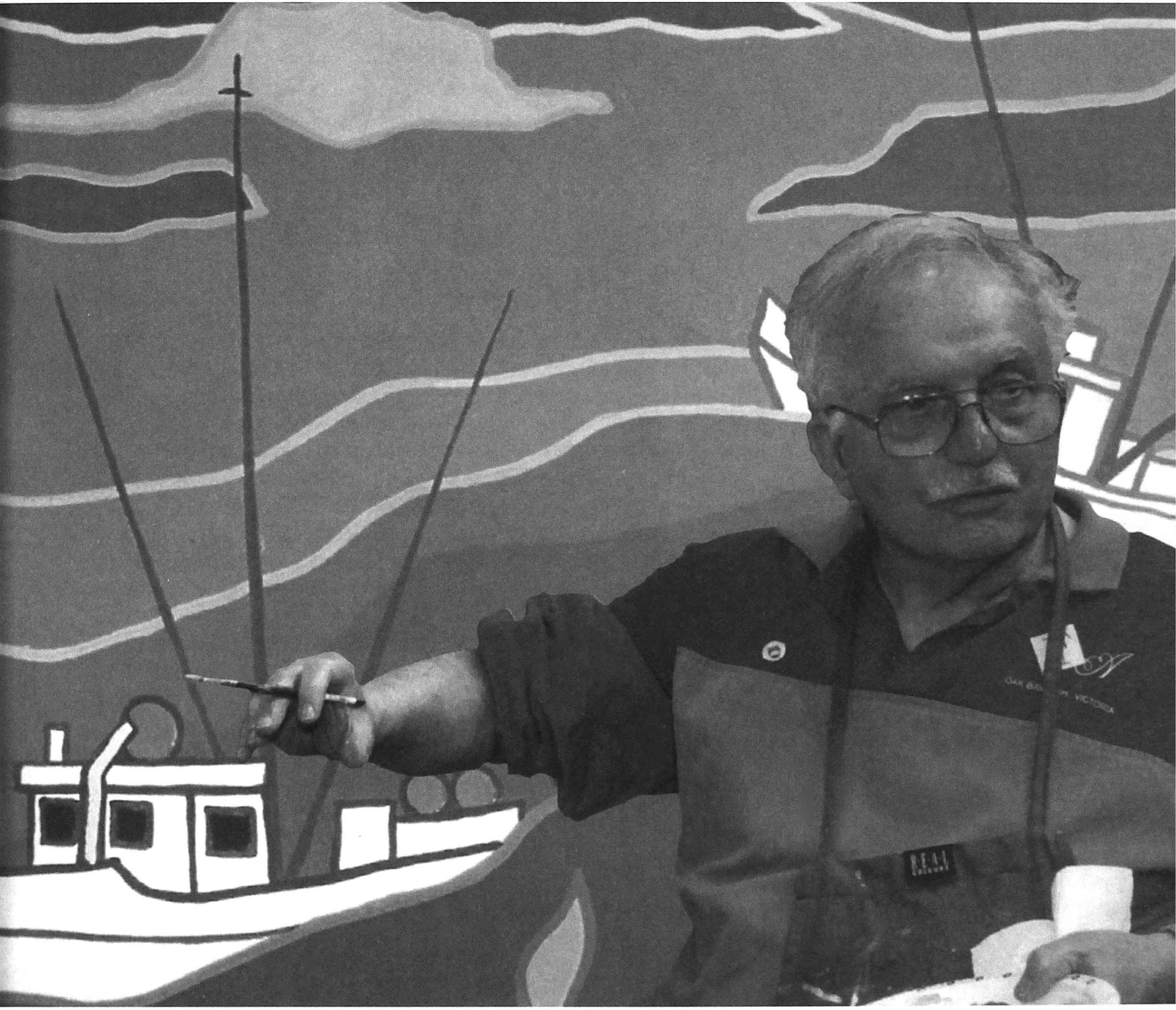

197
I led Harrison stands before a mural painted during Arts Week.
ABOVE
BD Meng-one of nature's funnymen.
FACING PAGE


Coach Janet Webster with debating stars Adam Goldenberg !centre] and Stephen Hsia [left],
BELOW
The 01 team triumphant.
Left to right: Harpal Sandhu, Tim Hsia, Scott Walter, Oarrell Cursons, BD Meng, Casey Cheng, Leonard Juatco, Matthew Baumann.
CLUB ACTIVITIES EXPAND
Club activities remain amazingly strong and club members have, in recent years, travelled in Canada and North America to compete with the very best. Two clubs deserve special mention: the Destination Imagination (01) Club and the Debating Club.
The DI program helps students learn to tap into their own creativity, solve problems, and work together in teams. Teams choose a challenge and spend several months perfecting their solution for tournament day. Technical knowledge and expertise are required along with dramatic and improvisational skills.
The 2000-01 team won a provincial competition that qualified them for the global championships, then travelled to Knoxville, Tennessee, where they placed second. The team's winning performance was set during the Han dynasty in China and was called "Crouching Magistrate, Hidden Identity."

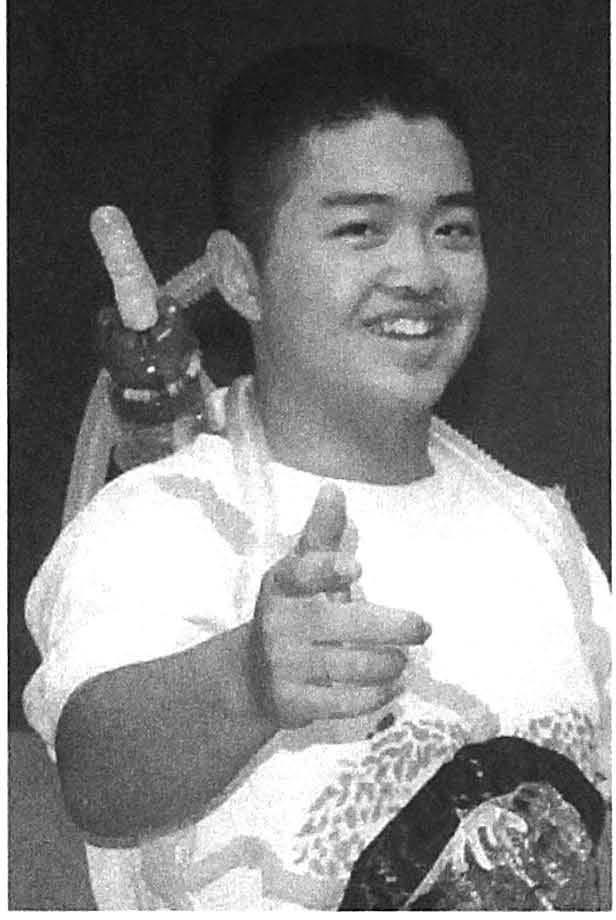
[It} involved a beleaguered magistrate facing punishment at the hands ofa draconian Emperor. It was a hilarious rendition ofBig Bird in China, which not only shocked both judges and opponents, but also showcased the talents ofindividual team members. In a second component ofthe competition the team was taken to a room and challenged to build a "leaning tower" out of ordinarymaterials like newspaper, coat hangers, spaghetti sticks, and duct tape, gaining points based on the tower's height.

Without a doubt, the last five years have been a golden era for debating at St. George's. In 1999 Teddy Harrison and Adam Goldenberg were quickly recognized as students with enormous debating potential. In August 2003 they were both to find themselves on the Canadian debating team travelling to Peru for the world championships, along with team coach Janet Webster. Leading up to their national team debut, Harrison and Goldenberg won every tournament they entered, including the Newman-FISA independent schools invitational tournament, the regional championships, the Law Foundation Cup provincial championships, and the University of British Columbia high school tournament. So it was no surprise when they helped the national team win the Pan-American championships held in New York in September 2003. But the Saints debating team was not a two-man squad that year:

Also performing extremely well were senior bilingual debaters, in particular StephenHsia andNaderKhamneipur, whose excellent showing at the provincial tournament wasfollowed in short order by Stephen's placing second at the National Student Debating Seminar. In the junior categories, Saints enjoyed great success as well. At the selective Regional Tournament Mike Paulus (grade 9) placed second as an individual, beating his older brother, Ben, into third place; Marko Horvat (grade 8) won the awardfor best novice debater and NicholasAinsworth and Nicholas Shon (grade 8) came third as a team.

199

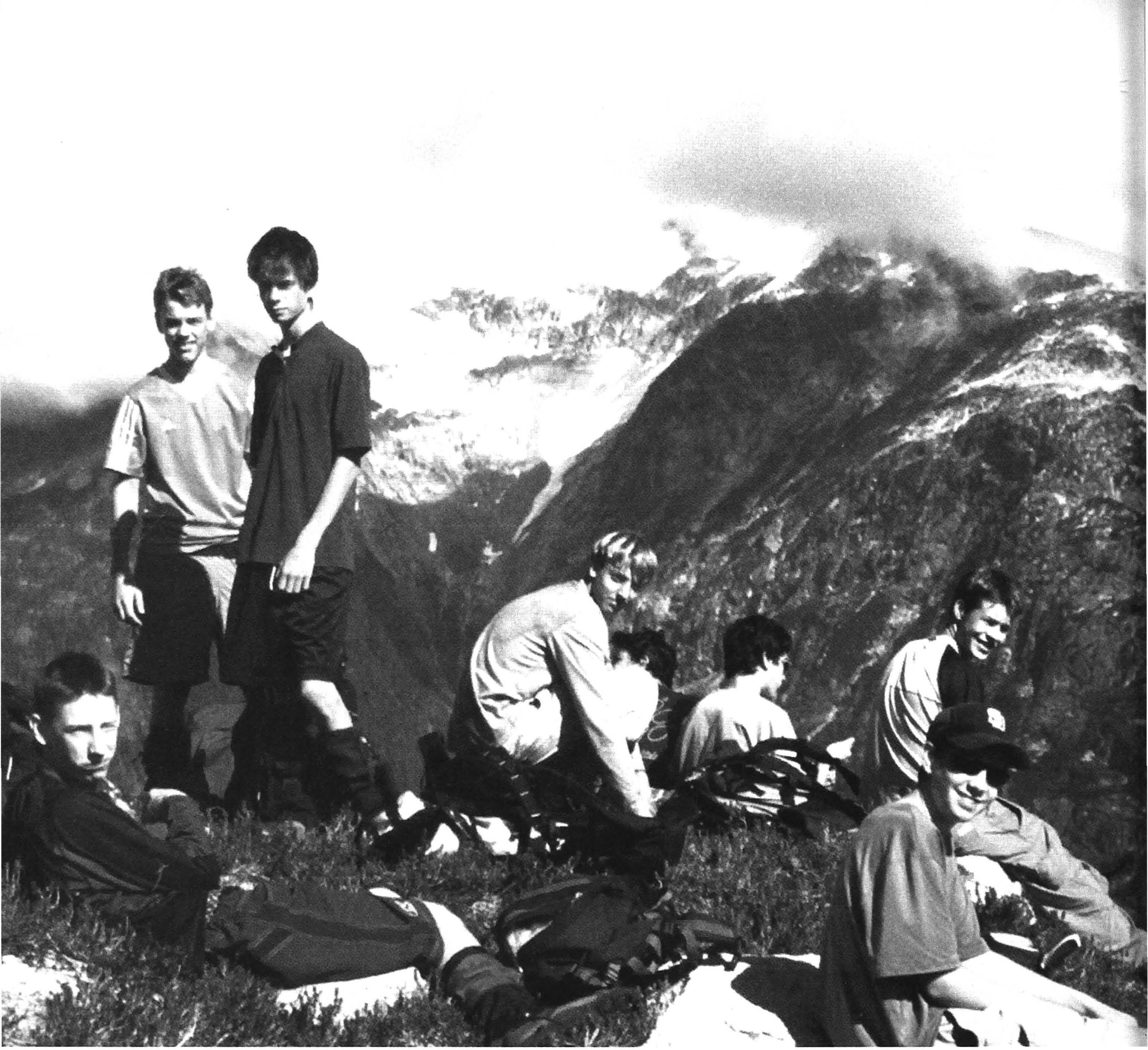
200
WIDENING HORIZONS IN THE OUTDOORS
After a few years in Howe Sound in the 1990S, the grade 10 Sea-to-Sky Program widened its horizons to include more of the province, with cyclists tackling the Kettle Valley, kayakers exploring the Gulf Islands, and backcountry skiers and snowboarders challenging the ridges high above Duffy Lake and the Cheakamus River.
Today all grades enjoy these kinds of experiences with the introduction of a fully integrated outdoor education program from grade 1 to 12. Neil Piller ('85) became the first coordinator of outdoor activities on both campuses in 2002, the same year the Discovery Program was launched.
Resembling the Trek Program offered by Prince of Wales Secondary in Vancouver, the Discovery Program successfully integrates the academic curriculum with an extremely broad range of outdoor activities (see page 202).
FACING PAGE

The Discovery 10 team members take a breather after yet another summit triumph, BELOW
Breathtaking scenery enjoyed by students on an expedition in Canada's north,

201
BEN PAULUS ('051 WRITES ABOUT THE DISCOVERY PROGRAM

Arctic Odyssey
We embarked on our actual journey in outdoor style.We chartered a Turbo Otter plane to fly the party and our gear out to McClusky Lake, at the headwater of the Wind River. The Otter also carried our canoes, strapped to each pontoon.It took two flights to get all of the gear and people out to the lake.Once there, we portaged to a nearby tributary stream which would take us down to the Little Wind River
The next few days were spent navigating down river through a series of small braided channels. The longer we paddled, the larger the river, until there was a fairly substantial flow of water. We experienced beauty and terror. One of our canoes flipped over sending its occupants into the water, and into a potentially dangerous situation.The group had been trained for this sort of emergency, and between us our unfortunate companions were soon hauled to safety on the river bank. Fortunately all the gear and the canoe were recovered, but it was a salutary warning for all of us!
These first days were hard; we often paddled between 50 and 80 kilometres each day. At times, we were almost numb from paddling in the cold water against a frigid and powerful wind off the sheet-ice of the Beaufort Sea [only a few hundred kilometres away).At other times we sat in our tents, afraid to go outside for fear of being eaten alive by mosquitoes We had contests to see who could kill the most in one hit on someone else's bug net.The record was 50. Mosquitoes, we discovered, can drive one mad in the Arcticl

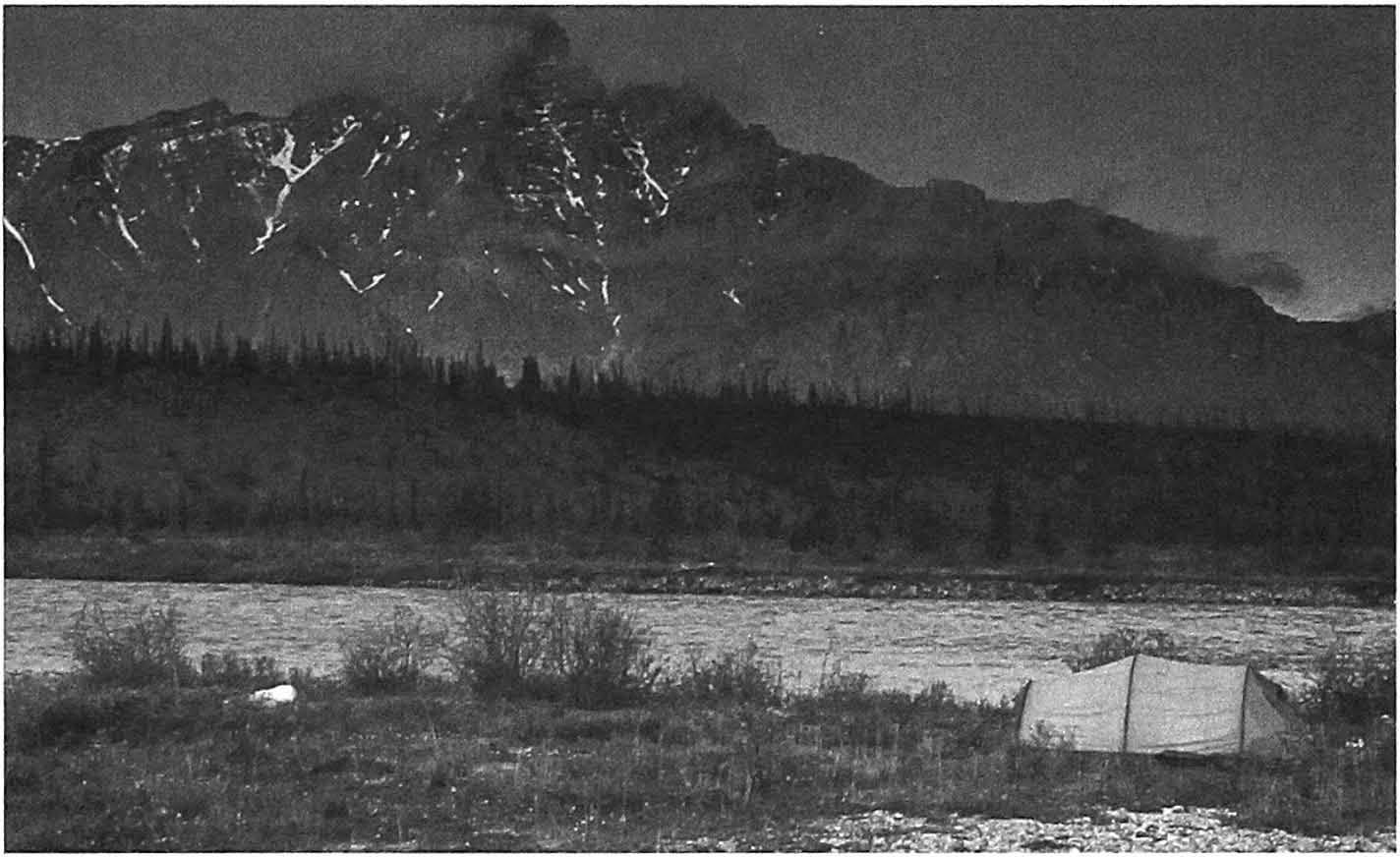

202

ABOVE, LEFT

Justin Marpole-Bird winning the BC cross-country championship race, 2005.

ABOVE, RIGHT
Justin Marpole-Bird powers into the finishing straight at the BCHS track and field championships. 2005
A SELECTION OF SPORTS SUCCESSES
Sports of every description have prospered in the last five years, with teams going on to BC High School (BCHS) championships as never before. Perhaps going on tour has had something to do with it. "Join a team at St. George's and see the world" could well be a useful recruiting pitch.
The fledging volleyball program won a silver medal in the first Canadian Association of Independent Schools tournament held in Okotoks, Alberta, in 2003. The school snowboard and ski team, in its third season, became BCHS champions in 2004 and repeated the achievement in 2005.
In 2005 school teams took gold medals in BC provincial championships in swimming, rugby, track and field, tennis, Ultimate, and ice hockey. The varsity basketball squad made it to the provincial championships for the sixth time in seven years; the grade lOS took the gold medal in BCHS competition and the grade 8s won silver. Therowersreturned from the annual regatta in St. Catharine's, Ontario, with the bronze medal in the team category-the highest placing ever for St. George's.
In 2002 the track and field team became the Boys' BCHS champions for the first time. The success owed much to super-athlete, Dan Mezheritsky, another decathlete cut from the same cloth as Barry "Muscles" Nielsen of the 1964 Dragons track and field team. The Georgian provided a vivid description of Dan's performance:

204
At the Provincial Decathlon Championships, DanMezheritsky took gold andEdNelles silver. In addition to these spectacular individual peiformances, the depthofthe team was evident in a numberoffinals' qualifications, including tw04xlOO teams, and two4x400 teams. DanMezheritsky added to his gold in the decathlon with golds in both relays, as well as the shot put, pole vault, and the 110 hurdles. He was named the MostInspirationalAthlete, and broke the previous recordoffive gold medals held by Mr. Primeau himself The other membersofthe4X 100 team wereAdamJolly, Oliver Ayling, andMarc 500. Marc and Dan also ran on the winning4x400 team withEd Nelles andRobert Gooch. ScottMacDonaldwas a silver medalist in the triplejump, whileMark took home a bronze in the400-metre.
In 2005 the track and field team bettered the 2002 performance by placing first in the overall category, despite not entering any of the events against female athletes. It was a remarkable achievement, the first in the 39-year history of the BCHS track and field championships.

Some of the success can be attributed to the performance of the middle-distance runners. The conditioning reqUired to achieve this success started years earlier with training camps at Whistler initiated by coach Laurier Primeau. In the first year of the program the team camped out under canvas and Laurier's wife-to-be did the cooking. It was a program that would have delighted the athletes of ancient Sparta. In 2002 this regimen allowed St. George's to take second place in the BCHS cross-country run, a best-ever performance. In 2005 the team placed fourth in the provincial championships, but in Justin Marpole-Bird, a grade 11 student, they had the gold medalist.
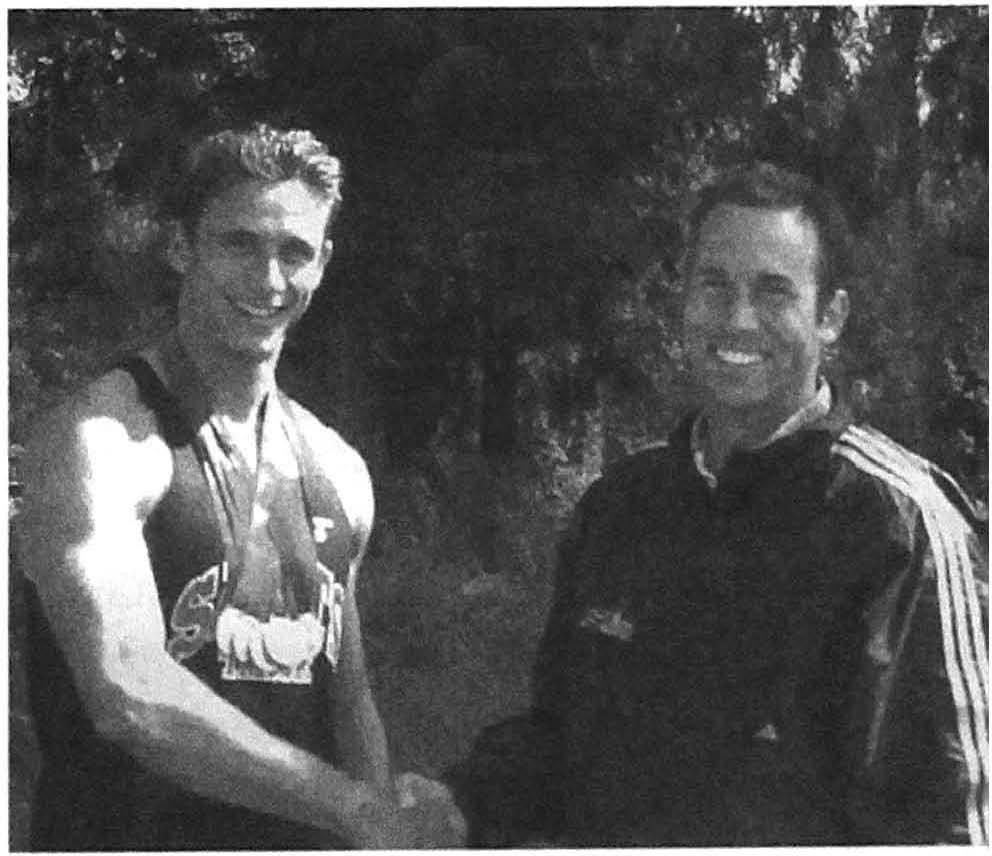
The outstanding athlete of the 2005 track and field team was also Justin Marpole-Bird, who took gold medals in the three middle-distance events: the 1500-metre, the 3000-metre, and the 2000-metre steeplechase-a first in the history of the championship. The 2000-metre steeplechase was the penultimate event of the day. Marpole-Bird, who had never run this particular gut-wrenching course before, agreed to do so when it became evident that the team could win the coveted overall award with a strong performance from him in the steeplechase. He provided that strong performance and carried his team into the record books.
In 2004 the rugby team won the BCHS championships for the first time since 1994. In the four games of the BC tournament the team did not concede one try.
205 BELOW
IThe "Mez·· receives congratulations from his superstar coach, Laurier Primeau.
ABOVE
Ben Grant making a break in the 2005 BCHS final against Shawnigan Lake School.
FACING PAGE

Thomas Cobb makes a break in the 2004 season.
The teamfirst playedKelowna, winning 60-3. LordByng was deflated in the quarterfinals 20-0. The team had a tough passage through the semifinals against traditional rival Semiahmoo, winning 22-3. In thefinals we were pitted against ShawniganLake. With many cuts and bruises, aches and pains, the boys played their hearts out and pumped out a score of31-9, a deserving win after 10 years out in the cold.
In 2005 the rugby team took the championship title for the second year in a row, defeating rival Shawnigan Lake School for the second time in a hard-fought final game. Early in the season they won the BC rugby seven-a-side championships, making for a triumphant double to gladden the heart of Headmaster Nigel Toy, a rugby fan from the impregnable fortress of rugby, New Zealand!

206

ACADEMICS

Given the sports successes of 2005, an outsider might assume that academics suffered as a consequence. In fact, the reverse is true. The academic results in 2005 were some of the best ever. Nearly 60 percent of the graduating class (84 out of 142 students) received provincial or district scholarship awards of $1,000.
Saints students also did incredibly well in their Advanced Placement courses: 131 students in grades 11 and 12 enrolled in these first-year university courses sponsored by the US College Board, and they wrote a total of 311 exams. Of these papers, 50 percent received a grade of 5, the highest achievable.
Both the year's provincial and AP exam results suggest that the school's achievement in athletics go hand in hand with achievement in other fields.
BOYS WILL BE BOYS
At St. George's as elsewhere, the raising of young males has always presented certain challenges. Meg Clyne, a past president of the Auxiliary, explains how generations of mothers in the pre-computer age rose to these challenges:
we soon learnt that being involved with theAuxiliary was the best way-the only way, really- to find out what was going on. Teenage boys were not known for their communicative skills, whereas in contrast, the "St. George's Grapevine" was a lightning rod ofinfonnation. It was actually the forerunner oftheInternet. Not many people know that, except for St. George's mothers. IiVant to know which parents are away for the weekend? (Translation: Where is the Saturday night party house for the grade 1OS?) IiVant to know which mother never gets home before 6 p.m.? (Translation: Where do the boys go for a beer or two after rugby practice?)
These and similar burning questions were always answered by the St. George's Grapevine, known to some as theRed Telephone. Our collective sons could never work out how sofew knew so much about so many.
So effective, infact, was this motherly precursor oftheInternet that we frequently knew what was going on even beforeAlanBrown did, which ofcourse was always the name ofthe game. ButI must admit that whatever we knew about the weekend goings-on at the homes ofmostly absentee parents, Alan was invariably up to snuffby 8 o'clockMonday morning.
208
In an effort to keep as "up to snuff" as his predecessor, one of Nigel Toy's first decisions as headmaster was to hire an administrative assistant, Pat Dyck. Pat, with a career spent teaching in the public school system, mostly at rural schools in the Fraser Valley, brought a fresh look to the perennial problems created by boys being boys. Pat recalls his initial reaction to the classified ad Nigel Toy placed in the Vancouver Sun:
"I instituted 'Baumann's Boot Camp' in which boys who misbehaved in games or P.E. were marched around the school parking lot in platoons, with someone calling out the step. It worked like a short Friday-after-school detention. When several boys asked if they could march again, I realized that this was seen less as a punishment and more as an entertainment by some boys."
Injuly Of1997. only a couple ofmonths into Headmaster Toy's new appointment, a small easy-to-missjob ad appeared in the classified section.judging by the ad's appearance, the posted position was not meant to be a prestigious one in that there were a minimal number oflines in very small type, with a heading not much larger: "Wanted' School DisciplineMaster,for St. Ceorge's SchoolforBoys. "An unusual titlefor the late 1990S (Iflit sure that corporal punishment had been banned in the independent system as well as the public) yet rumours persisted of stodgy, stern, and glowering schoolmasters regularly scourging their charges with six ofthe best.
Pat Dyck applied and secured this position of "Discipline Master," soon to be pleasantly surprised by the school he found himself in:

Despite having to deal with a dozen drunk and disorderly grade 12S on the veryfirst day ofclasses (some of whom had been taken away in handcuffi by the police the previous night, protesting that their rights had been trampled on, as they had been managed harshly-after being lippy-by Vancouver'sfinest), I was pleasantly surprised at how much goodwill there was among the community. The school in fact ran on it and really did not in any way reflect the stereotypical military-type structure that I bothflared and expected. The school wasfilled with humane, kind, and reasonable people. Myjob would end up dealing with the students that had difficulty cooperating, despite a kind and reasonable approach.
A teacher given to long reflection over the elusive goal of "good discipline" was Paul Baumann. Indeed, at the very last staff meeting of his career, when he was in a position to walk away from the problem forever, he was still looking for solutions. Boot camp was one among many of Paul's experiments.
209
of the school t8rm and Se George'sSchoglAuxili?yhada ,to know each other at a tea'hour -. of Mrs: AustinTayIor,Awaiting
ABOVE
Auxiliary members meet in the home of Mrs. Austin Taylor in 1956 to organize the third Country Fair under their president Mrs. Barry Atkins.
From left to right· Mrs. Charles Craig, Mrs. Austin Taylor, Mrs. Barry Atkins, Mrs. John Harker [wife of the school"s headmaster]

guests' arcivaI'qre •. (ltor) Mrs. Charles Craig,.-lI4rs. T.aylor; Mrs, Barry,:Atkins, auxiliary president.�li.hd;. Mrs. Joh:Q,H�ker, wife ot'the school's,headnidr� (Cunningh�m photo) .'"
FACING PAGE

Past presidents of the Auxiliary relax in a comfortable niche of McLean Hall in 2003 during the organization's 50th-anniversary tea.
First row {left to rightl: Helen Shim Boyle, Rosemary MacDougall, Audrey Findley, Margaret Kellett, Meg Clyne, Audrey Litherland, Elaine Sproule, Don Stephenson,
Second row {left to right/: Lorraine Bowden, Barbara Bodel. Susan Dickson, Leslie McGee, Di Mitchell, Jane Gooch, Carolyn Maude, Margie Knox, Elizabeth Demner, Joanne Dubord, Deborah McKeen,
In a last desperate attempt to bring back a more visibleform of punishment in the school, I instituted "Baumann's Boot Camp" in which boys who misbehaved in games or PE. were marched around the school parking lot in platoons, with someone calling out the step. It worked like a short Friday-after-
school detention. When several boys asked if they could march again, I realized that this was seen less as a punishment and more as an entertainment by some boys. Nevertheless it was visible to boys and parents as they drove away on Friday afternoons. Fathers smiled and gave me the thumbs up. Had I found a punishment that was acceptable? Would this save punishment from the dung heap ojSaints history? Perhaps punishment as aform of entertainment at St. George's had been born!
THE AUXILIARY TURNS 50
In 2003 the Auxiliary celebrated its 50th anniversary. Although the first members had come together in 1950, the Auxiliary did not become a registered society until 1953, the year of the first Country Fair. This annual fundraising event proved to be an excellent indicator of the Auxiliary's growth. While the inaugural fair brought in less than $100, the modern-day St. George's Fair raised more than $300,000 in 1999, and a record total of nearly $373,000 in 2000. In her president's message at the 50th-anniversary tea, Helen Shim Boyle noted some important changes in the Auxiliary's affairs:
In '98 theAuxiliary EndowmentFund was established under the then-president, Mrs.}oanneDubord. It now exceeds $300,000 and is the third largest within the
210
school's foundation. In 2003, after 50 years with no paid secretarial support servicesfor its many activities, the Auxiliary sought help. This year, we have contracted with the school for bookkeeping services, and the school has hired a part-time administrative assistant. We are thefirst parents' auxiliary in the private schools' system in Canada to have a paid assistant. TheAuxiliary has grown into a considerable business and we would not be able to sustain our organization or to continue to evolve without the addition of these two vital aspects of our administrative structure.


"We soon learnt that being involved with the Auxiliary was the best way-the only way, really-to find out what was gOing on.
211
NURSE NORMA SPEAKS HER MIND
Norma Parker reported for her interview with Headmaster Alan Brown more than a little distraught after 10 nights on duty in intensive care, the last of which involved a long and unsuccessful struggle to save the lives of three brothers who had eaten rat poison. She arrived at the interview with a blackeye delivered by the emotionally overwrought father of the three boys and splashes of blood on her clothing from the violent hemorrhaging of the children. She sat outside AB's office with, in her own inimitable words, a horde of old bags selected, she suspected, more for their potential as cut-price labour than for their skill with the medication of sick and suffering small boys. She was quick to point out that the institution seemed to need, in her own forthright opinion, some youth, energy, and a strong pair of legs to get the chaos evident everywhere in the San into some sort of shape. These words seemed not to register with AB and she was soon waved summarily outside with the promise of a call in the next week or two, to let her know if she was to be the lucky candidate. She was awakened from a deep sleep some hours later by AB to tell her that he had reflected on her words and had decided on taking her advice. Would she like the job and for an extra $20 could she look after any first aid problems during weekend games?
Luckily for SI. George's, Norma (seen here on duty in the outdoors] accepted the offer and has been with the school ever since.

THE PEOPLE WHO REALLY RUN THE SCHOOL
It was in a prefects' skit at a House Supper one year that Isaias Garcia was first represented as the man who "really runs the school." Over 75 years the continuity of chief custodians has been nothing short of remarkable. Axel Mortensen handed over to Isaias after the two worked together for 10 years, then Isaias handed over to Larry Marieiro after he completed a similarly long apprenticeshipmaking for an unbroken tradition going back to 1937Nurse Norma Parker has become a legend during a 35-year association with the school.

Generations of boarders will recall with affection the hours spent chatting with Norma in the San, sharing a laugh and receiving the sort of medicine that does not come from a bottle. They and many others would be surprised to learn the circumstances surrounding
Norma's appointment (see the story on this page).
The list of people who "really run the school" must include Soon Low and Irene Vincente, who have been putting food into the stomachs of St. George's boys for over 20 years. Between them they

212
have 47 years of service! Low immigrated to Canada from Sarawak and Vincente from Portugal. Together they have weathered a "season of discontent" in the kitchen, but with unruffled good nature they have continued to pile high the trenchers of hungry boys and staff.
FAREWELLS
During the first five years of the 21st century many teachers who had been hired in the 1970S and early 1980s retired. Almost all of them served the school for more than 20 years: Tosh Ujimoto, Paul Baumann, Janet Webster, Simon Oliver, John Lawrence, Brian Lecky, and Craig Newell. Many of them would think of themselves as members of the baby boom generation, their parents near contemporaries of the men and women who returned from the war to lead St. George's in the late 1940S and 1950S.
Sadly, not all of the recent farewells have been retirements. Both Robin Baker and Craig Zacharias, men in good health and with no previous symptoms, were diagnosed with cancers in 1999-2000 and passed away after short, painful struggles with the disease.
Baker led the English department for many years, being a most effective Director of Studies and one of the school's longest serving Georgian editors. His talents as a writer, photographer, and musician made him an invaluable resource for both student and staff activities around the school. He left a legacy of carefully considered, nonjudgmental thinking that guided important policy-making decisions during the years in which the school restructured itself to meet the demands of a growing population.
Craig Zacharias was in charge of computing technology at a time of particularly rapid expansion. He was first and foremost a computer programmer and devised a marks and reporting program
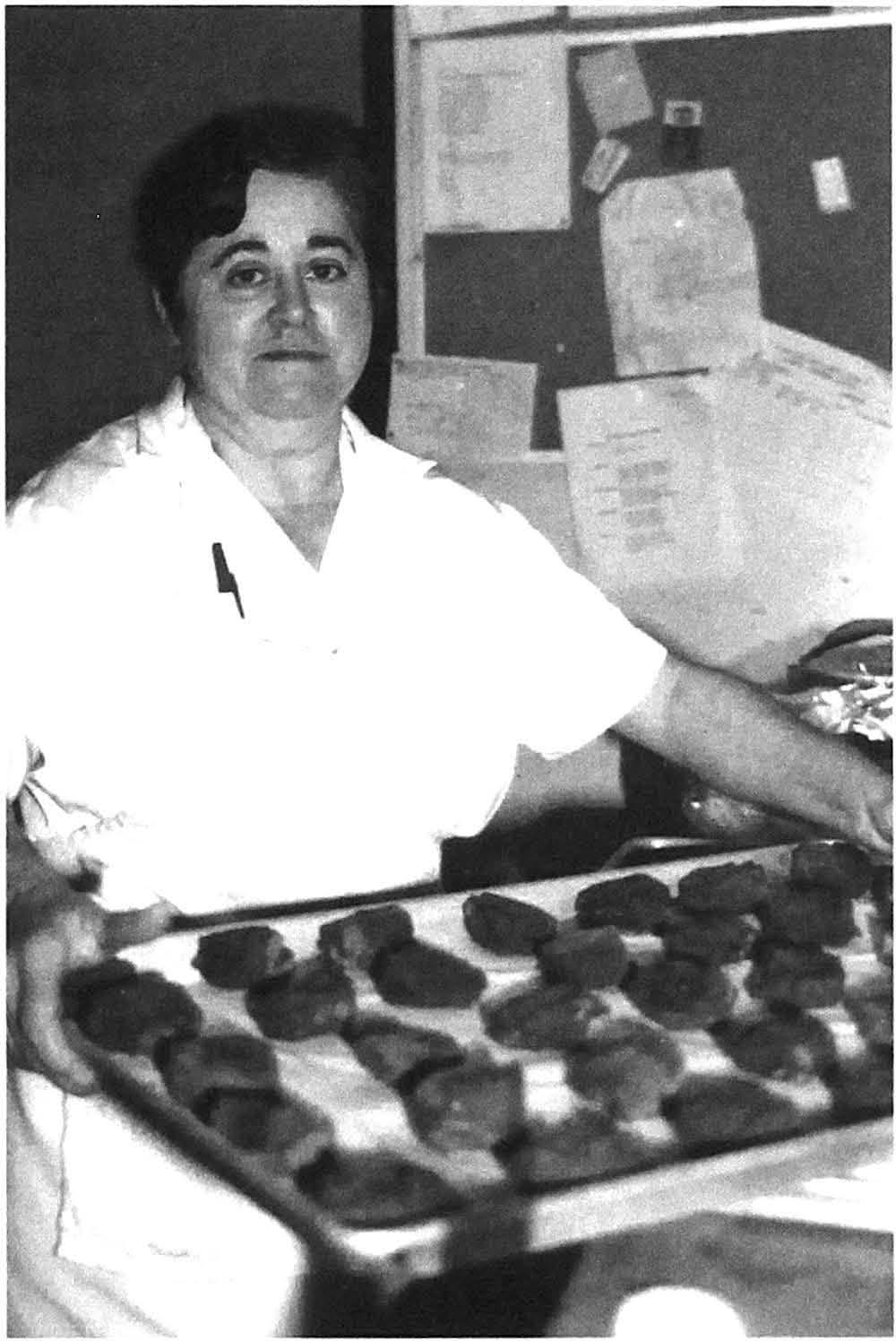
ABOVE
Two Jolly cooks. Irene Vincente [left) and Soon Low [rlghtl

fACING PAGE


The behlnd-the-scenes movers and shakers of Just about anything that happens on campus at Saints.
First row (left to right/Larry Manelro. Nazare Manelro. Carla Manelro. Tino Marieiro
Second row (left to nghtl: Alfred Palva. Ermenlo Rebiero. Jorge Rodngues.
213
LEFT TO RIGHT Robin Baker. Craig Zacharias. and Darrell Cursons.
that was in use for many years. Craig made important contributions to the construction of new computing facilities and the purchase of the machines and complex networks needed to meet the demands of the new technology required by students, teachers, and office workers alike. He left behind the legacy of a huge computing empire that extends to both campuses.
Darrell Cursons died unexpectedly in 2001 from a massive brain hemorrhage. In his short career at Saints he taught physics and ran the Junior School Reach Program and the Destination Imagination Club. One of his club members was Adam Goldenberg, who remembers him with much affection:
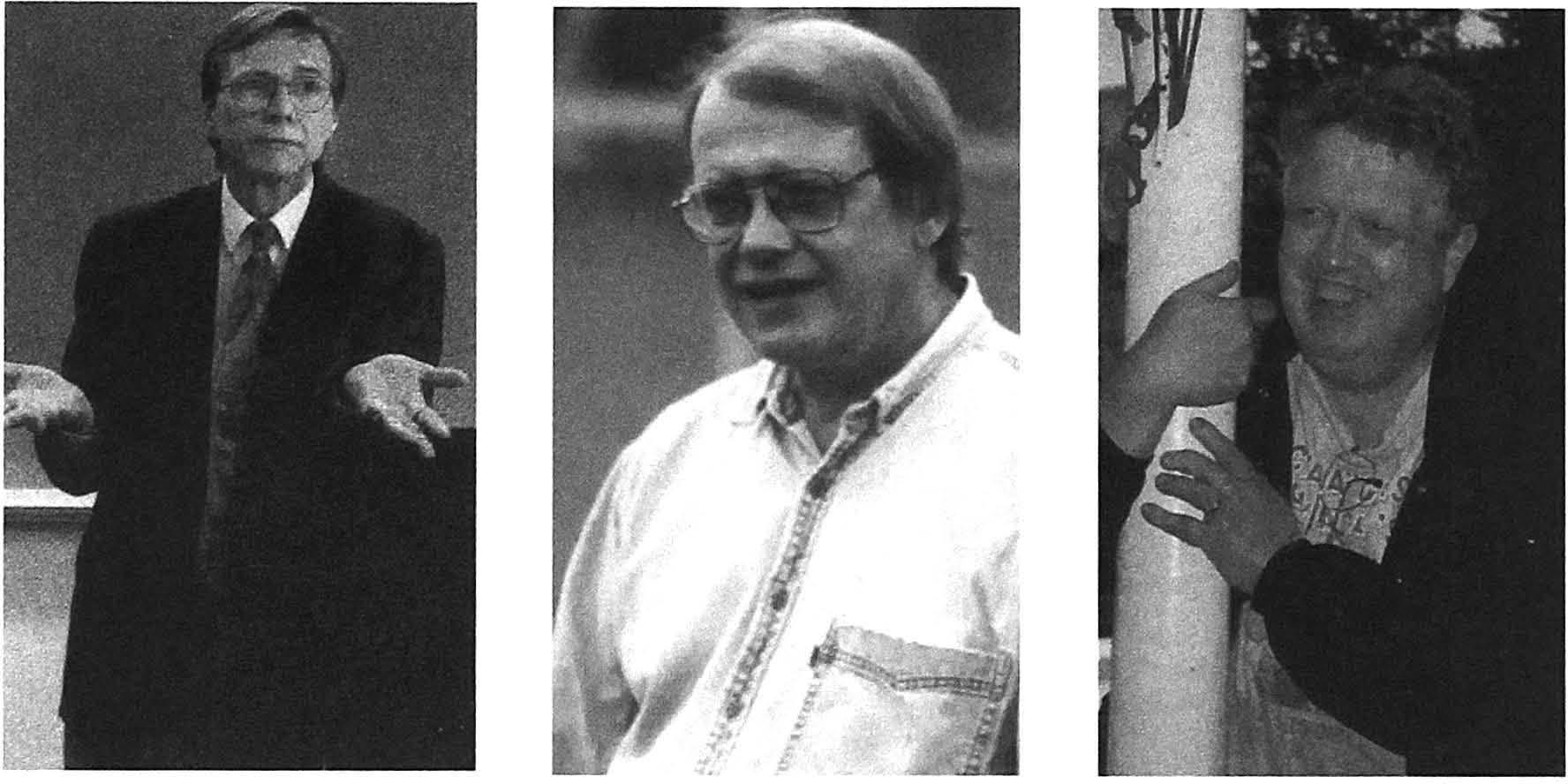
TheJunior SchoolReach Team met twice a week in his classroom, where we would compete to be thefirst to answer tn'via questions. He wouldn'tjust read the wn'tten quen'es, he would also teach us the topics which they concerned,frequently demonstrating hisflairfor tn'via by embellishing questions and providing miniature lessons in Geography, History, Science andArtHistory. 1 willneverforget the way he always seemed to know everything. 1 remain in awe ofhis knowledge. Mr. Cursons was a bn'lliant man and 1 willmiss him immensely.

I
214
THE GROUND BENEATH OUR FEET

For 75 years the student population of St. George's has been growing. In discussions with school neighbours over the last few years it has been agreed that limits to growth have been reached on both campuses. The time has finally come when fundraising and construction will be geared to a static school population-a blessing to planners and a relief to the neighbours.
The current building program at the Senior School will help to restore some of the sense of space and dignity that distinguished the 1960s campus, and the contemplated reworking of the southern aspect in the near future will complete the effort to give the campus the buildings and facilities of a great educational institution.
The 24 boys and their teachers who lived through that first school year in 1931-some survivors of the First World War, others soon to enlist in the Second World War-would hardly guess at the formidable professionalism of the current school with its many specialists, policy-making committees, support staffs, and machines of the computer age. Wartime shortages and exigencies made them masters of improvisation, and with a hammer and nails or pen and paper they were ready for anything.
The Spanish philosopher Jose Ortega y Gasset has this to say about tradition: "To excel the past we must not allow ourselves to lose contact with it; on the contrary we must feel it under our feet because we raised ourselves upon it." At St. George's the sense of the past is strong and there are many traditions that have remained from those earliest days. Peter Hilton and his friends were dismayed to lose their smoking privileges at the House Supper of 1974, but the times were changing; the House Supper remains, smoking does not.
Today we feel the past under our feet in the exuberant good nature of young men challenged to discover themselves, and in so doing to achieve a place in the world where they can find happiness and success-and make a difference. Despite 75 years in which the world has changed beyond recognition, we labour in the same vineyard for the same rewards as did the staff and students of 1931.
215
Appendix 1

Headmasters, Heads ofthejunior School, Chairmen, Georgian Presidents, Presidents oftheAuxiliary, and School Captains
HEADMASTERS
CHAIRMEN OF THE BOARD 1931-1933 Captain F.J. Danby-Hunter 1932-1948 Mr. John Harker 1933-1963 Mr. John Harker 1948-1949 Mr. Austin C. Taylor 1963-1971 Mr. Douglas E. Harker 1949-1960 Mr. H. Victor Whittall 1971-1989 Mr. Alan C.M. Brown 1960-1964 Mr. E. Russell Palfreyman 1989-1991 Mr. John R. Parry 1964-1970 Mr. Clarke Simpkins 1991-1996 Mr. Gordon W Atkinson 1970-1973 Mr. W Douglas H. Gardiner 1996-1997 Mr. John G. Lawrence 1973-1974 Mr. David WH. Tupper ('39) (interim) 1974-1976 Mr. Gordon A. Christopher 1997- Mr. Nigel R.L. Toy 1976-1978 Mr. Kenneth T. Stevenson 1978-1980 Mr. Philip W. Owen 1980-1982 Mr. Allan D. Laird
HEADS OF THE JUNIOR SCHOOL 1982-1984 Mr. L. Barry Sheppard 1947-1958 Captain B.o. Robinson 1984-1986 Mr. David R.L. Rolfe ( '49) 1858-1965 Mr. Jack Malcolm 1986-1988 Mr. Derek AG Simpkins ('64) 1965-1988 Mr. John E. Blackmore 1988-1990 Mr. Kenneth B. Hallat 1988-1989 Mr. John R. Parry 1990-1992 Mr. George W Hungerford 1989-1999 Mr. StephenL.M. Hutchison 1992-1994 Mr. lain R.V. Mackay 1999- Mr. Gregory C. Devenish 1994-1996 Mr. Andrew D. Grant 1996-1998 Mr. David C. Bentall 1998-2000 Mr. Brian G. Kenning 2000-2003 Mr. Robert J. Ellis ( '67 ) 2003- Mr. Peter R.B. Armstrong ('72)
216
PRESIDENTS OF THE ST. GEORGE'S OLD BOYS' ASSOCIATION ( THE GEORGIANS) 1936-1939
1986-1988 1988-1990 1990-1992 1992-1994 1994-1996 1996-1998 1998-2000 2000-2001 2001-2002 2002-2003 2003-2005

Mr. Robert W Hamilton ('72)
Mr. Peter R.B. Armstrong ('72) Mr. Ronald L. Cliff ('79) Mr. Robert S. Armstrong ('81) Mr. Jock W Craddock ('75) Mr. Christian S. Owen ('78) Mr. James R. Clay ('87) Mr. G. Ross Waters ('71) Mr. David G. Chambers ('69) Mr. Michael A. Watt ('83) Mr. Neil J.B. Menzies ('82)
Mr. Cooper Drabble ('36) 1978-1980 Mr. Derek A.C. Simpkins ('64) 1939-1941 Mr. Robert A.D. Francis ('37) 1980-1982 Mr. Mark R. Steven ('68) 1941-1945 Mr. B.O.W Dryvynsyde (Master) 1982-1984 Mr. Stephen C. Millen ('68) 1945-1946 Mr. B.G. "Nip" Parker (Master) 1984-1986 Mr. Blakeney M. Lewis ('74) 1946-1948 Mr. Stanley Burke ('40) 1948-1950 Mr. WiIliam E. WhittaIl ('40) 1950-1952 Mr. F Cameron Wilkinson ('44) 1952-1954 Mr. Archie L. St Louis ('44) 1954-1956 Mr. Alan G. Creer ('41) 1956-1958 Mr. Donald H.C. Paterson ('51) 1958-1959 Mr. David R.L. Rolfe ('49) 1959-1960 Mr. Michael C. Simpkins ('54) 1960-1961 Mr. G. William Wooster ('53) 1961-1962 Mr. John L. McCarthy ('52) 1962-1964 Mr. Ralph R. Brown ('53) 1964-1965 Mr. C. Thor Young ('54) 1966-1967 Mr. Douglas ). Fosbrooke ('54) 1967-1968 Mr. Timothy J. Douglas ('65) 1968-1974 Mr. John FF MacDougaIl ('44) 1974-1976 Mr. J.D. Barrie Stubbs ('56) 1976-1978 Mr. Christopher J.G. Barratt ('59)
217
PRESIDENTS OF THE ST. GEORGE'S AUXILIARY 1953-1954 Mrs. w.G. (Florence) Stephens 1954-1956 1956-1957 1957-1958 1958-1959 1959-1960 1960-1962 1962 1963 1963-1965 1965-1967 1967-1969 1969-1971 1971-1973 1973-1975 1975-1977 1977-1979 1979-1981 1981-1983 1983-1985 1985-1987 1987-1989 1989-1991 1991-1993 1993-1995 1995-1997 1997 1998 1998-1999 1999-2000 2000-2001 2001-2002
Mrs. E.R. (Marjorie) Palfreyman Mrs. E.E. (Edith) Chamberlain Mrs. c.P. (Barbara) Leckie Mrs. M. (Mildred) Caple Mrs. Barry (Althea) Atkins Mrs. Louis (Gwen) Scott-Moncrieff Mrs. G.E. (Stephanie) Bowes Mrs. J.R. (Margaret) Kellett Mrs. D.B. (Joan) McDonald Mrs. John (Vera) Conway Mrs. M. (Barbara) Sehmer Mrs. Rosemary MacDougall Mrs. Audrey Findley Mrs. Betty Knickerbocker Mrs. Audrey Litherland Mrs. Di Mitchell Mrs. Meg Clyne Mrs. Carolyn Maude Mrs. Leslie McGee Mrs. Lorraine Bowden Mrs. Barbara Bodel Mrs. Susan Dickson Mrs. Elaine Sproule Mrs. Deborah McKeen Mrs. Joanne Dubord Mrs. Elizabeth Demner Mr. Don Stephenson Mrs. Margie Knox Dr. Jane Gooch 2002-2003 Mrs. Helen Shim Boyle 2003-2004 Mrs. Tracie Watson 2004-2005 Mrs. Lesley Bentley

218
SCHOOL CAPTAINS
1931-1932 John WaIley 1968-1969 Michael P. Robinson 1932-1933 Frank M. Smith 1969 1970 Stephene. Millen 1933-1934 Basil R. Houghton 1970-1971 Donald P. Richardson 1934-1935 H. A. Paul Aldersey 1971-1972 Robert W Hamilton 1935-1936 David A. Sloan 1972-1973 Peter D. Fairey 1936-1937 Robert A.D. Francis 1973-1974 Cregory M. Burns 1937-1938 John W Clement 1974-1975 Peter J. Hilton 1938-1939 Ceoffreye. Robinson 1975-1976 Alistair C.M. Fyfe 1939-1940 William J. Maitland 1976-1977 David WJ. McAdam 1940-1941 William E. Whittall 1977-1978 Paul J. MitcheIl-Banks 1941-1942 Cordon R. Cilley 1978-1979 John K. Ketcham 1942-1943 Cuy C. Kirkpatrick 1979-1980 Simon R. Coval 1943-1944 J. Dennis Butters 1980-1981 Harold W Coodwyn 1944-1945 Archie L. St. Louis 1981-1982 Scott L. Sheppard 1945-1946 Peter M. Reeves 1982-1983 Peter B. Dirks 1946-1947 Stanley T. Clarke 1983-1984 Vincent M. Yen 1947-1948 Richard F St. J. Sendall 1984-1985 Douglas R. Tennant 1948-1949 Antony C. L. Bayliff 1985-1986 Angus M. Cunn 1949 1950 Hugh Bardon 1986-1987 BenjaminN. Hirschler 1950-1951 Arthur B. Lander 1987-1988 E.e. "Toffer" Winslow 1951 1952 John L. McCarthy 1988-1989 Prentice W Durbin 1952-1953 Cordon J.N. Money 1989-1990 Mark E. Fancourt-Smith 1953-1954 John M.e. Tynan 1990-1991 Jason D. McLean 1954-1955 Douglas P. Anton 1991-1992 Justin D. Young 1955-1956 Peter B. Irvine 1992-1993 S. Paul Ezzedin 1956-1957 John M. Ross 1993-1994 Jeffreye.H. Lau 1957-1958 John M. Ross 1994-1995 Alexander I. Munro 1958-1959 JohnN.P. Anton 1995-1996 Jusin B. Lim 1959-1960 J. Edward Chamberlin 1996-1997 Jonathan K.H. Law 1960-1961 J. Michael Vaux 1997-1998 Zulfikar A. Kanji 1961-1962 e. Stephen Rogers 1998-1999 Jonathan Cooper 1962-1963 Kenneth E. McVicar 1999-2000 Fabian Leitner 1963-1964 D. BarryNielsen 2000-2001 Imran Ratanshi 1964-1965 O. Bruce Allan 2001-2002 Cyrus Chee 1965-1966 Bryce C. Fleck 2002-2003 Scott M. Tindle 1966-1967 Richard W Sterling 2003 2004 Stephen M.Y. Hsia 1967-1968 Timothye. Yeomans 2004-2005 Bjorn R.Thomas

219
Roll ofHonour
Appendix 2

The following tribute was inscribed by NancyMcDonnell, wife of staff member PeterMcDonnell. The roll of honour was presented to St. George's School in 1947 and later appeared as a pull-out feature in the Georgian (see photograph on page 26). The stars indicate those men who died during the war.
1939-1945 FOR KING AND COUNTRY
Members of St. George's School who served with the Armed Forces in the Second World War.
Aldersey P. e. de G. Clark D. "'Greathed ]. Alexander B. Clarke R. Greaves D. AlIen R. �'Clothier J. Greig R. Anderson A. Clothier R. D.F.e. Halpin R. *Anderson L. Collier A. �'Hanna G. Baird R. ConsidineM. Harker D. Ment. Baker F. Cornwall P. Haskett W. Bald ]. *Cowan J. Hinton L. Bayliff T. Cowling A. Homan J. Bell D. Creer A. �'Hood R. Bentley R. CrichtonM. Horn P. Berry D. Dafoe W. Houghton B. Betteridge J. �'Des Brisay G. Howeson J. Bevington L. Drabblee. Huggett S. Birch L. Ellerbye. Hurrell R. "'Black W. Elliott R. Jones R. "'Bolin G. �'Else H. Jukes A. Bourne H. �'Else J. Ker R. Boving P. Evans-Atkinson E. KingM. Browning 0. Fleck A. D.F.e. Kirkpatrick G. Buerk R. Fleishman N. Kneen E. Burke S. Francis R. Hawkshawe. Burne H. Galloway A. Lowrie W. Butters D. Garrett L. Lungley A. Christmas E. Grant L. McDonald H.
220
McDonnelI P. M.e. Mackenzie G. Mackenzie W. MacLean V. "'Maitland W. D.fM. �'Martine. ;'MercerJ. MillerR. Moore D. Munro B. Nash K. Nation G. Nelson W. NewelIJ. NoyesJ. OliverE. ParkerB. Parker-Jervis A. Parker-Jervis N. Peake L. Penney G. PidgeonE. Pidgeonf Pollock A. PottingerE. "Probye. Randall }. "'Rasmllssen G. RattrayM. RicketsonB. Riddell G. Robertson K. RobinsonB. Robinson W. Robinson G.
RoseJ.J. RoseJ.O. "RoseR. "Ross S. Ment. Roxburgh T. Royston G. Sager A. D.fe. SandersonJ. "SandesR. ScottR. Shann K. SharpM. ShawE. "SleeR. Sloan D. Sloan J. Smithf "Smith G. Smith H. van SparksJ. Spencer D. SpryR. StainerJ. Steade. Stevens W. St. Louis A. StorerO. Street P. "'Strong G. "'StuartR.e. "'StuartR.v. "SweenyBen O.B.E. Sweenye. Sweeny S. M.e. TaylorJ.
Tindale G. "Tudhope W. D.fe. Tupper D. VaughnJ. WalIace D. WalIace P. WalIaceR. Walls D. Watson P. Weatherhead G. WestmacottR. Westmacott I. Whittall P. Whittall H.R. D.fe. Whittall W. WicksonJ. Williams L. "'WilsonM. Woodwarde. WynneR. YoungR.

221
Appendix 3

"Viva-La"jorRobin Baker
The "Viva-La" has been sung at every House Supper since the first in 1931. Each year teachers at St. George's take the song "Vive la Compagnie" and rewrite the lyrics to include as many student names as possible. During the singing of the "Viva-La" each student stands when his name is sung. In the early days it was possible to have the whole school standing by the end of the song. One special "Viva-La" that was written by students rather than teachers has yet to receive an airing at a House Supper. After the death of Robin Baker in 2002, the students of his Advanced Placement English class wrote lyrics to celebrate the year they had spent together. Today a brass plaque with the words of this "Viva-La" stands as testimony to a great teacher and to one of the school's most cherished traditions.
BAKER'S TWO DOZEN
The TAYLOR of words and the MAASter of verse, Vive la compagnie.
Us in neW ALTERnate thinkings JI WAould always immerse. Vive la compagnie.
Chorus
Vive la, vive la, vive l'amour, Vive la, vive la, vive l'esprit, Vive la, vive la, vive la reine, And vive la compagnie.
Like a BAUMANN you HSIAt and you WUnded with wit, Vive la compagnie.
GraciouS AND HUmble, a conTEJAous fire DEW lit. Vive la compagnie.
Chorus
You told us, "UANG and CHEEting are WONG SOpLEEs don't," Vive la compagnie.
LivinG UP TA MORR IS tough, but fail we won't. Vive la compagnie.
Chorus
With soME SSOLAR AScendance JUE SHEPPARD our fLOK, Vive la compagnie.
CHIUsing teaCHING not preaCHENG, in your footsteps we'll walk.
Vive la compagnie.
Chorus
Our memories of you we'll always keep near, And thoughts and similar stories. We'll always remember you year after year, And the great things you did at St. George's.
222
About the Author

John Lawrence immigrated to Canada in 1973 after teaching for seven years in Britain and three years in the Bahamas. During his 30-year career at Saints he taught chemistry, biology, and mathematics, and experienced the uncompromising routines of the math department under the redoubtable Mr. PJ. He was a keen cross-country runner until a knee injury terminated his running career. He also ran a cycling club, and enjoyed playing violin with the school orchestra.
In the early 1980S he took on the headship of the science department and became Director of Studies, posts that he held for nearly 15 years. Throughout this time he also taught a full complement of students, and for nearly a decade he ran a volunteer Advanced Placement chemistry class that met during lunch hour.
In the late 1980s he assisted with the grade 10 program at Strathcona Park Lodge and began a love affair with the outdoors that continues to this day. He subsequently assisted with school backcountry and ocean kayaking expeditions.

In the mid-1990S he became acting headmaster. When a new headmaster was hired John became associate principal and served in that role until he retired in December 2002.
In 2003 John and his wife, Katherine, took a backpacking trip around the world and reinvented themselves as travel writers/photographers. Their articles appear regularly in the Vancouver Sun.
I
22)
The author prepared for the worstl



 G. Lawrence
G. Lawrence





































 ABOVE
ABOVE



 I
Tony ··pr Parker-Jervls and Noel ··Bachee·· Parker-Jervls are Circled In red.
ABOVE John Harker.
I
Tony ··pr Parker-Jervls and Noel ··Bachee·· Parker-Jervls are Circled In red.
ABOVE John Harker.























 CLOCKWISE, FROM TOP LEFT Scouts stand to attention on Sports Day, 1935.
CLOCKWISE, FROM TOP LEFT Scouts stand to attention on Sports Day, 1935.










 RIGHT
RIGHT



























 Harry Else, RCA
Roberl Henry Rose, RCAF
Jlm Else, RCA
Sanford Gall Smllh, RCA
Willlam Frank Tudhope, RCAF
Slewarl Rulherford Ross, R Can, Scol
John Duncan Mercer, RCAF
Gordon Monlgomery Des Bnsay. RCN
Willlam John Mailland. RCAF
Richard Arlhur Bayson Slee. RCAF
Richard Charles Sandes. RCAF
Herberl Lawrence Anderson. RCAF
Richard Charles Sluart. RCAF
Reginald Vlclor Sluarl, RCAF
Leslle Charles Marlin. RCAF
Donald Francls "Robin" Hood. RCAF
Harry Else, RCA
Roberl Henry Rose, RCAF
Jlm Else, RCA
Sanford Gall Smllh, RCA
Willlam Frank Tudhope, RCAF
Slewarl Rulherford Ross, R Can, Scol
John Duncan Mercer, RCAF
Gordon Monlgomery Des Bnsay. RCN
Willlam John Mailland. RCAF
Richard Arlhur Bayson Slee. RCAF
Richard Charles Sandes. RCAF
Herberl Lawrence Anderson. RCAF
Richard Charles Sluart. RCAF
Reginald Vlclor Sluarl, RCAF
Leslle Charles Marlin. RCAF
Donald Francls "Robin" Hood. RCAF




























































 I
The Senior School, 1965.
I
The Senior School, 1965.



































 IABOVE
BJ Bj towers over Parade.
BELOW
Mrs. Westmacott and Jo Jo
IABOVE
BJ Bj towers over Parade.
BELOW
Mrs. Westmacott and Jo Jo





 Michael Robinson and his St. George's friends meet Prime Minister Trudeau, 1968.
Michael Robinson and his St. George's friends meet Prime Minister Trudeau, 1968.



















 I
George Gregory represents BC in national debate in Halifax, 1973.
I
George Gregory represents BC in national debate in Halifax, 1973.




























 SChool Band
Selec'ions trom 'Pain' Your Wagon'
SChool Band
Selec'ions trom 'Pain' Your Wagon'

































 I Moving and even, perhaps, singing in the rain.
I Moving and even, perhaps, singing in the rain.































 I Cameron McLaren.
I Cameron McLaren.







































 I
The Harker Quadrangle on a balmy summer"s day
I
The Harker Quadrangle on a balmy summer"s day





























 I BELOW
Justin Student moves in to take a winning shot on goal.
I BELOW
Justin Student moves in to take a winning shot on goal.




 CLOCKWISE, FROM TOP Two Saints runner battle it out.
CLOCKWISE, FROM TOP Two Saints runner battle it out.


















































































